Fasciculus temporum
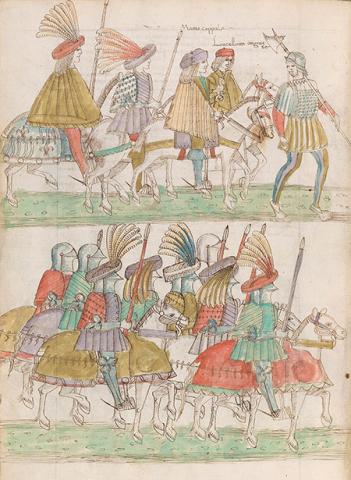
Written and illustrated in Naples, Italy, shortly after 1498, Fasciculus temporum is a compendium of four late medieval chronicles. The first, Fasciculus temporum, after which the manuscript takes its name, is a summary of world history compiled by the German monk Werner Rolevinck. His text and the thirty pen-and-wash drawings are based on the printed edition with woodcuts published by Erhard Ratdolt in Venice in 1481.
The second text, “Cronaca di Partenope,” is an anonymous history of Naples from the early Middle Ages to the start of the fifteenth century. This is followed, as in many Cronaca manuscripts, by the “Bagni di Pozzuoli,” an account of the medicinal Baths of Pozzuoli. The manuscript concludes with the “Cronaca della Napoli aragonese,” describing events in Naples from 1423 to 1498. This last chronicle was written by the son of Francisco Ferraiolo, who witnessed the triumphal entry into Naples of King Alfonso I in 1443. It is illustrated with 120 pen-and-ink drawings that are of considerable interest for their detailed portrayals of contemporaneous personages and historical events, as well as Neapolitan life, costume, and landscape.
This paper manuscript of 150 leaves was purchased by the Morgan at the Aldenham Library sale in London, at Sotheby’s on 24 March 1937, lot 250.
Werner Rolevinck
1425-1502
Fasciculus temporum
Naples, Italy, ca. 1498
MS M.801
Thumbnails
MS M.801, Front cover
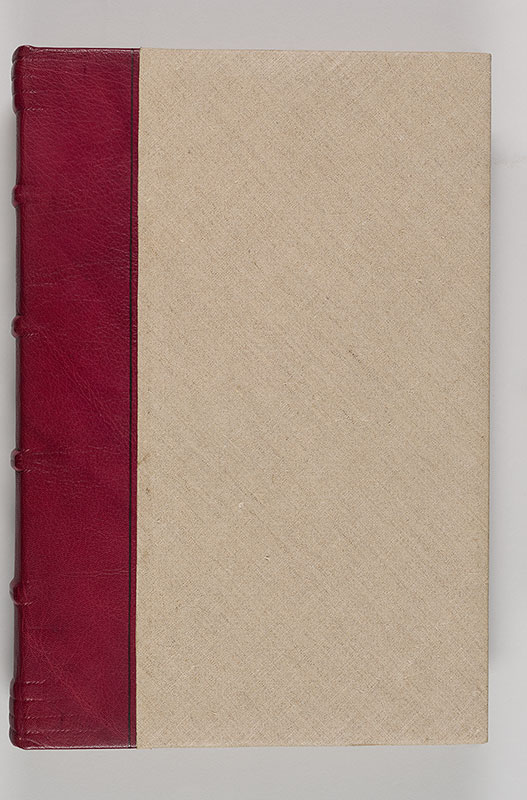
Fasciculus temporum
MS M.801, Front free endleaf 1, recto
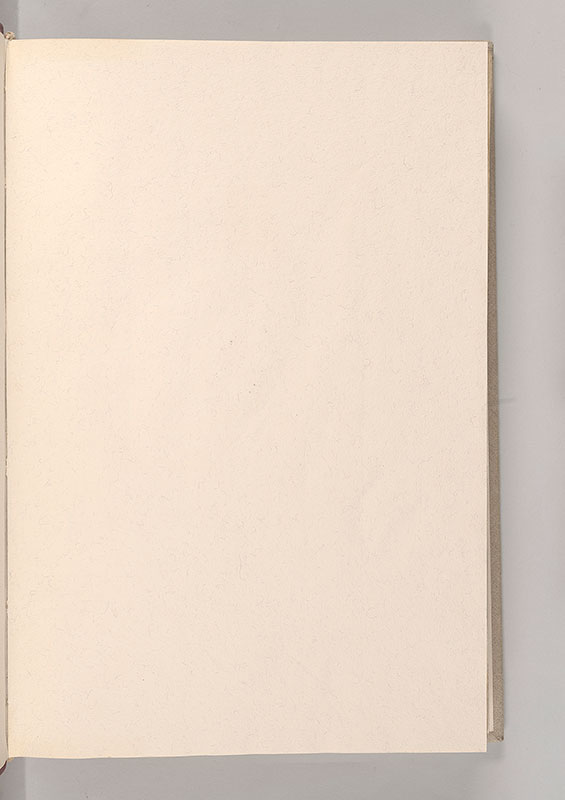
Fasciculus temporum
MS M.801, Front free endleaf 1, verso
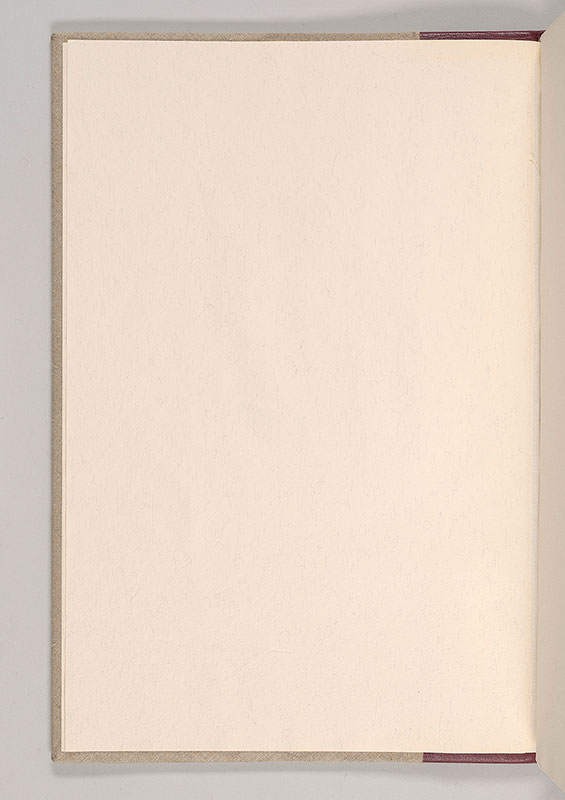
Fasciculus temporum
MS M.801, Front free endleaf 2, recto
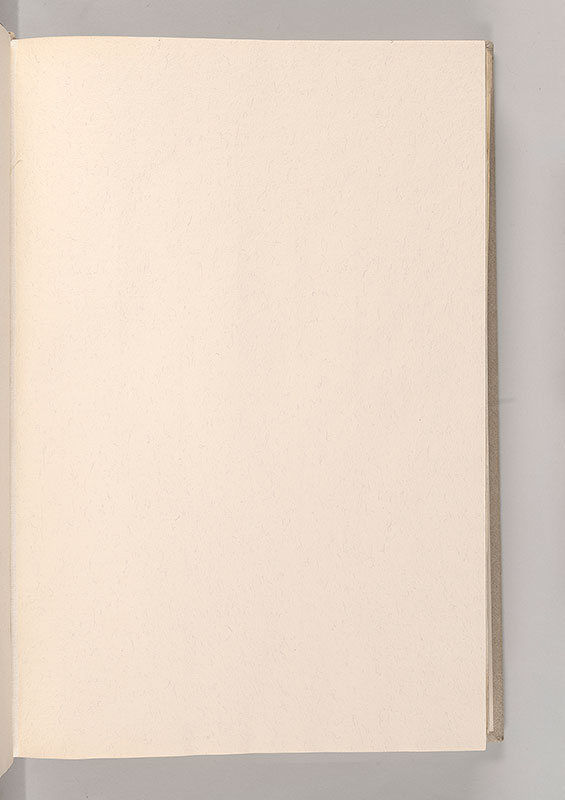
Fasciculus temporum
MS M.801, Front free endleaf 2, verso
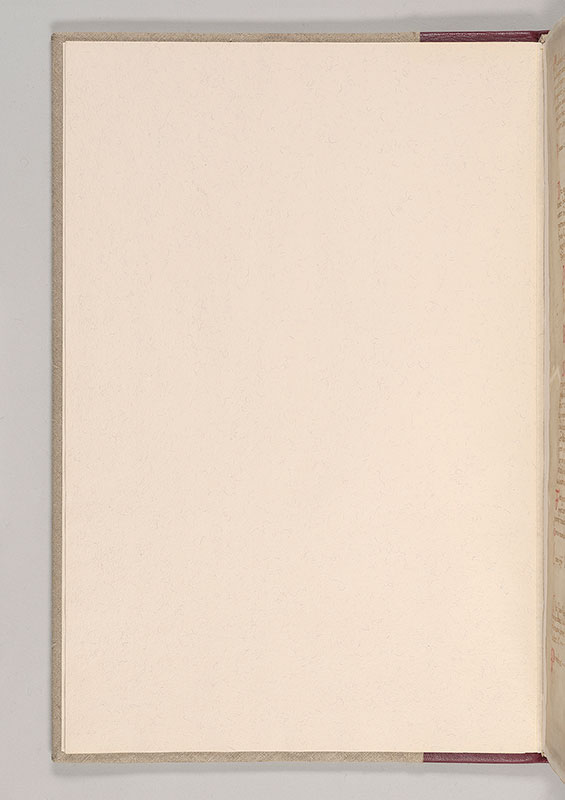
Fasciculus temporum
MS M.801, Front pastedown
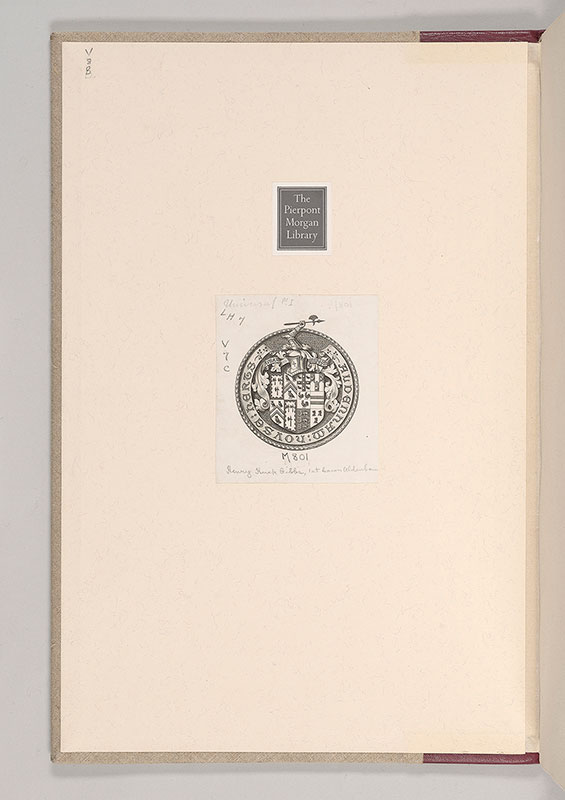
Fasciculus temporum
Fasciculus temporum, fol. 1r

Fasciculus temporum
MS M.801, fol. 1v
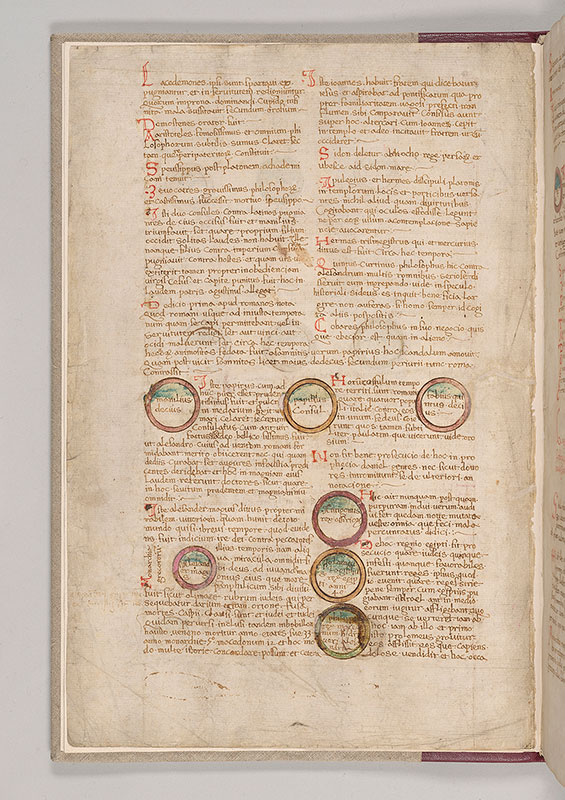
Fasciculus temporum
MS M.801, fol. 2r
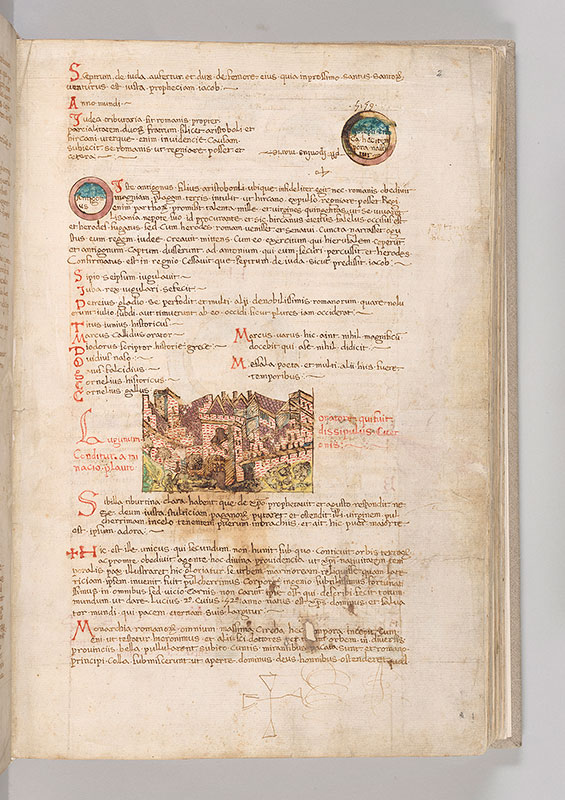
Fasciculus temporum
Walled city of Lyon with gate in tower; roofs of buildings visible within walls. Bird standing on hillock outside of the gate.
Drawing of cross in lower margin.
MS M.801, fol. 2v
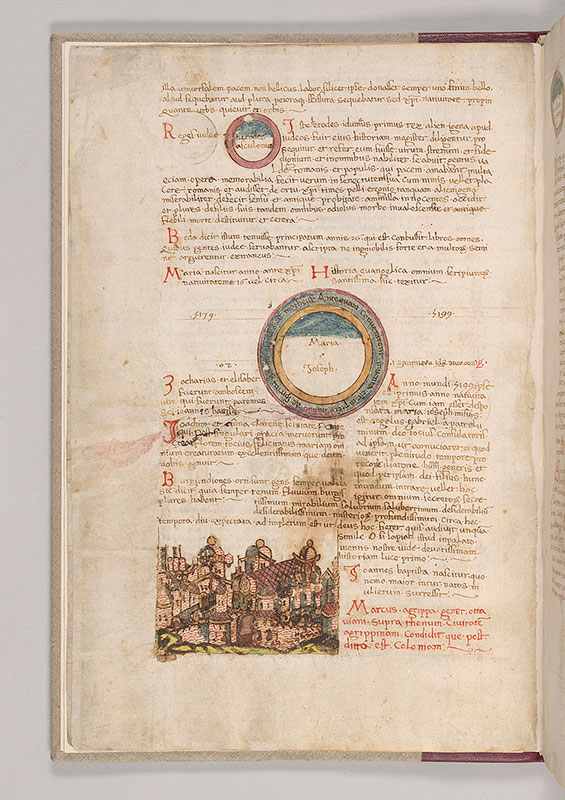
Fasciculus temporum
City with many domes enclosed by wall.
MS M.801, fol. 3r
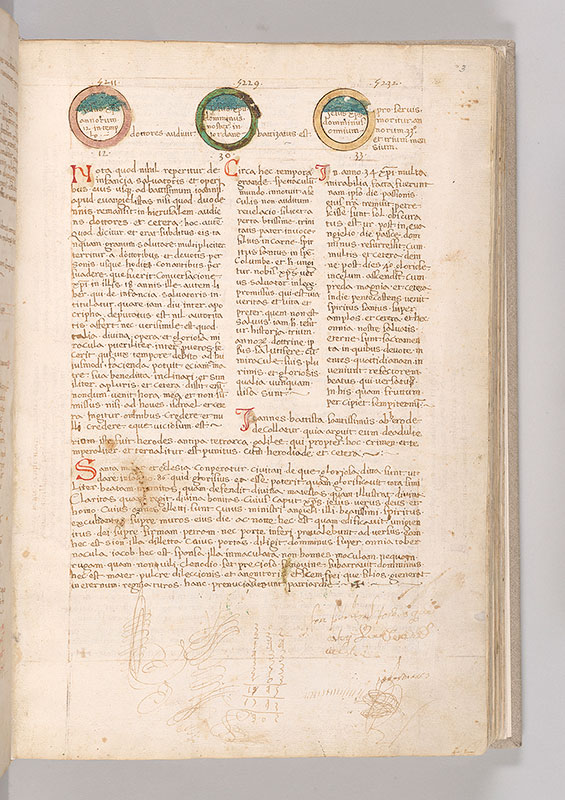
Fasciculus temporum
MS M.801, fol. 3v
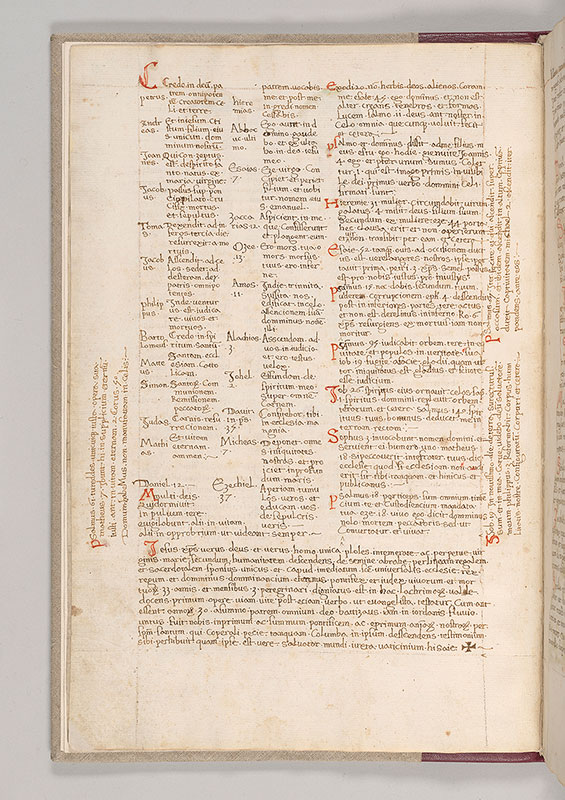
Fasciculus temporum
MS M.801, fol. 4r
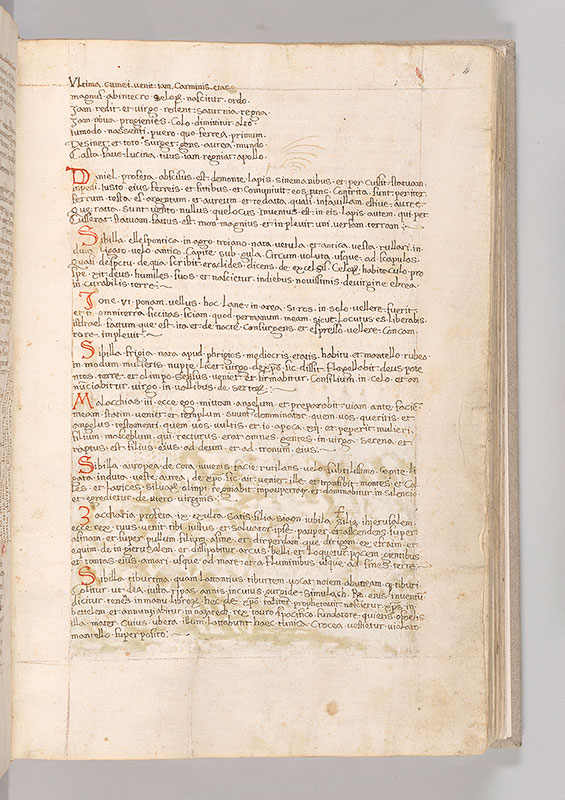
Fasciculus temporum
MS M.801, fol. 4v
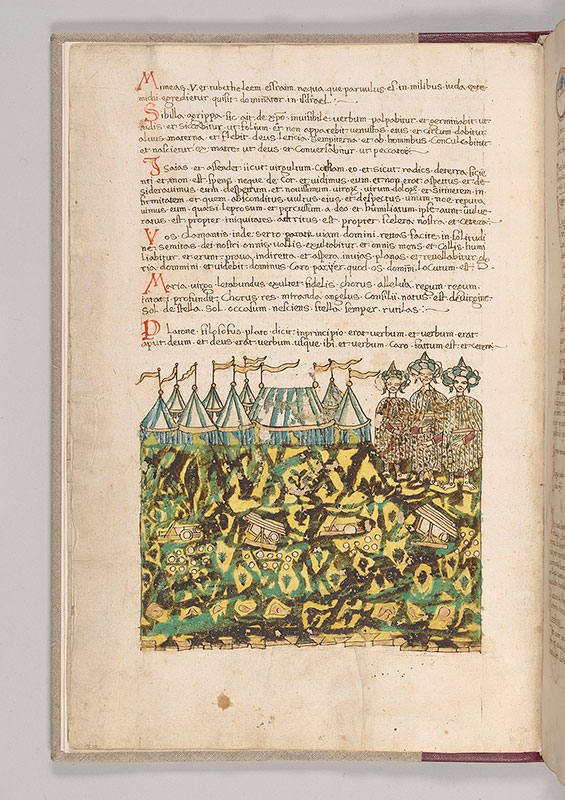
Fasciculus temporum
Several tents with banners, next to three eastern men, wearing turban-like hats, one indicating left toward war-machines (?) amid stones on ground.
MS M.801, fol. 5r
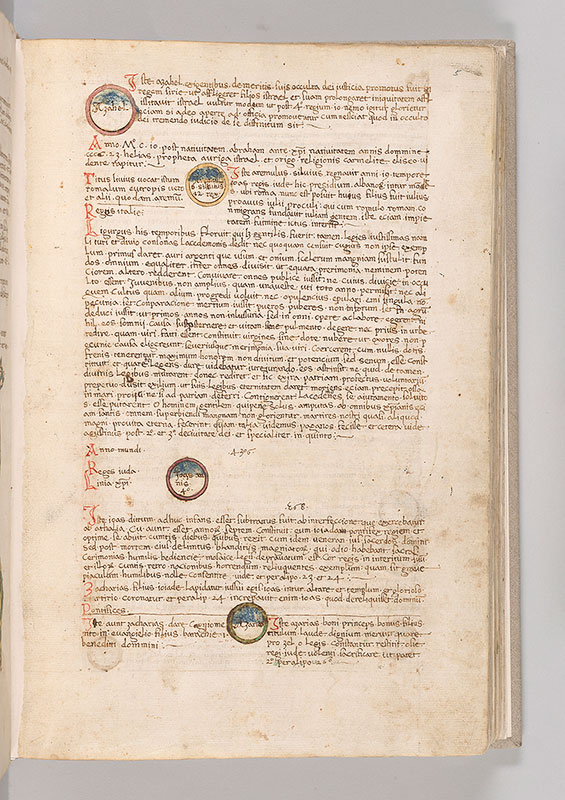
Fasciculus temporum
MS M.801, fol. 5v
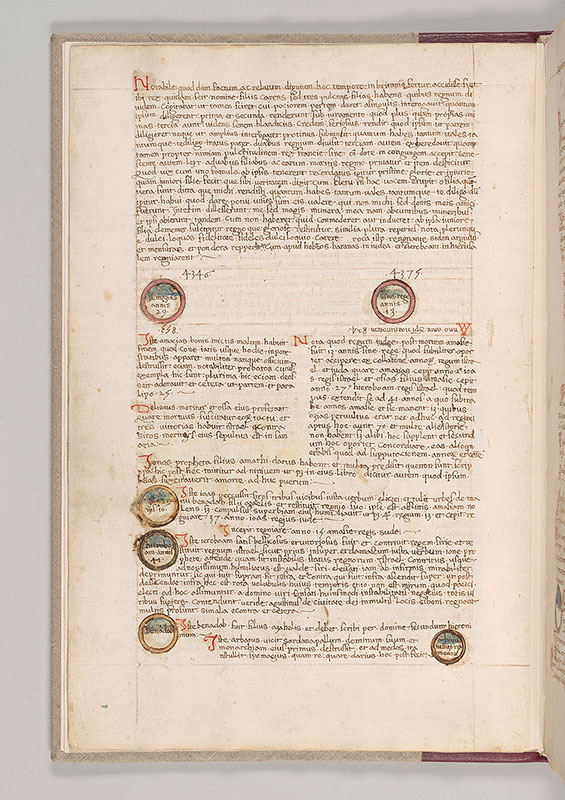
Fasciculus temporum
MS M.801, fol. 6r
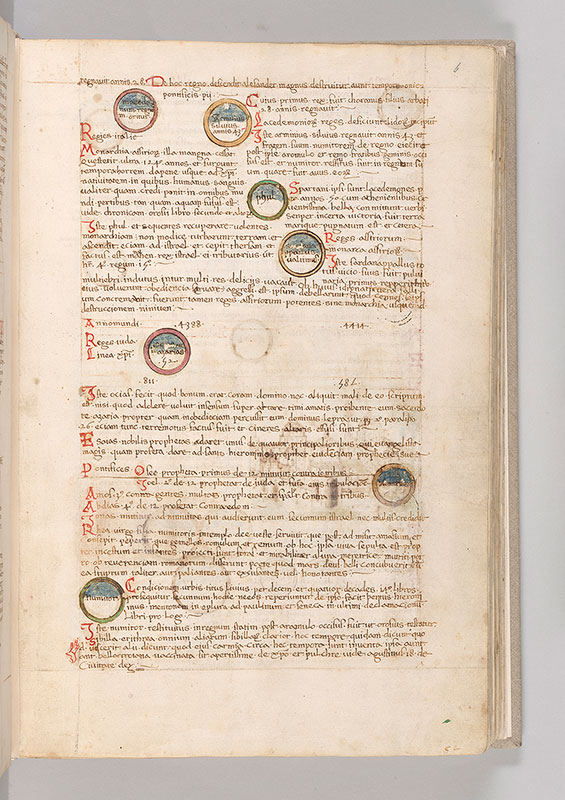
Fasciculus temporum
MS M.801, fol. 6v
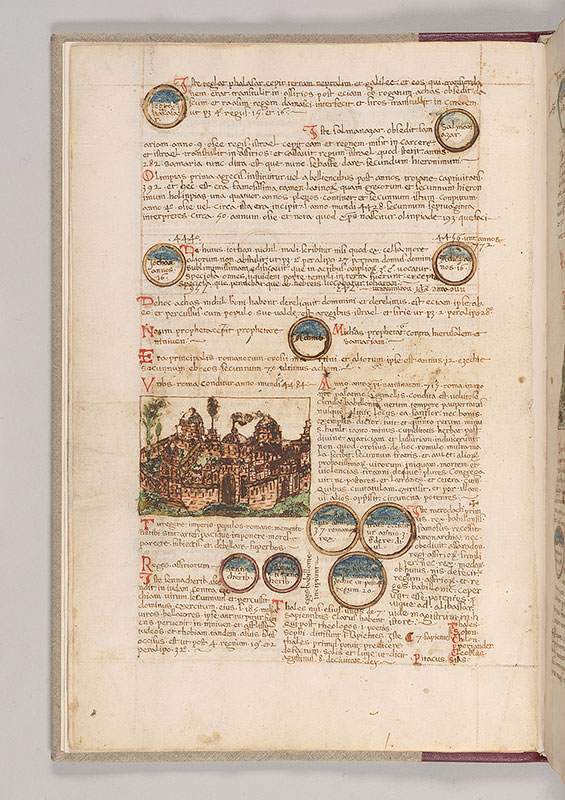
Fasciculus temporum
City of Rome with three domed buildings, one bannered, among others, all enclosed within crenellated wall.
MS M.801, fol. 7r
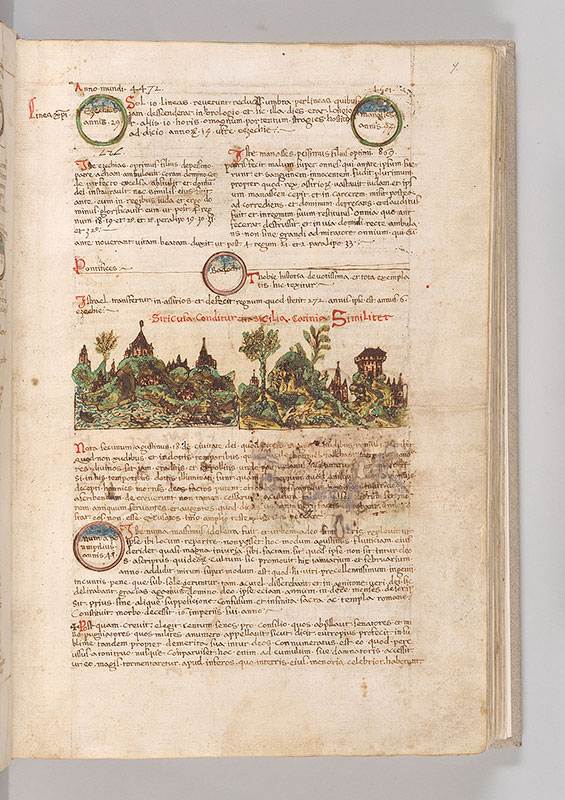
Fasciculus temporum
Left, city of Syracuse on and amid hills, partially on water with two boats and ship with many oars.
At right, city of Catania, with building, church, and tower on hill, trees and bushes.
MS M.801, fol. 7v
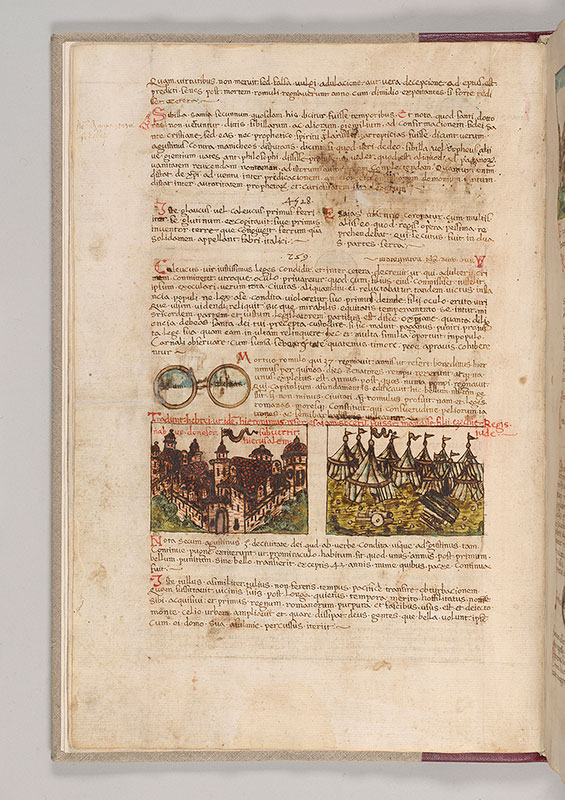
Fasciculus temporum
Left, city of Jerusalem with domed towers, one with banner, enclosed within crenellated wall.
Right, twelve tents with banners; cannon and war machine (?) in foreground amid stones or cannon balls.
MS M.801, fol. 8r
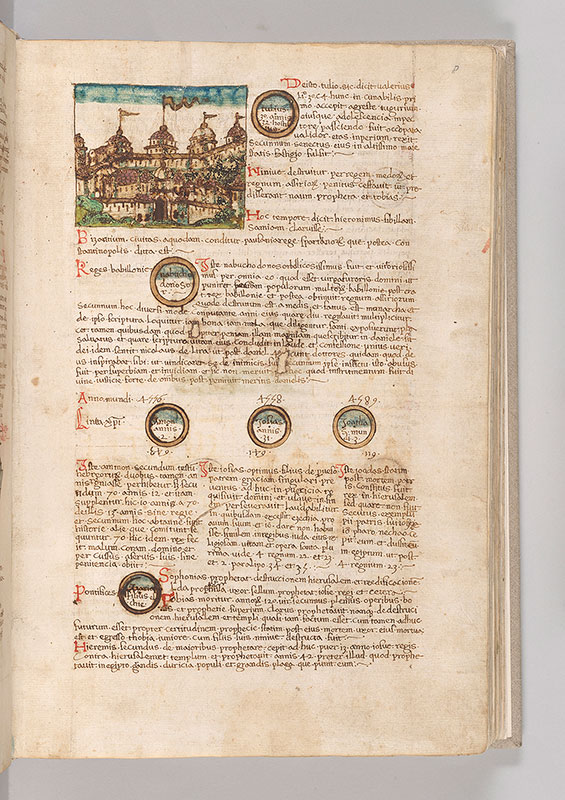
Fasciculus temporum
City of Constantinople with buildings, some domed, four with banners, enclosed within wall.
MS M.801, fol. 8v
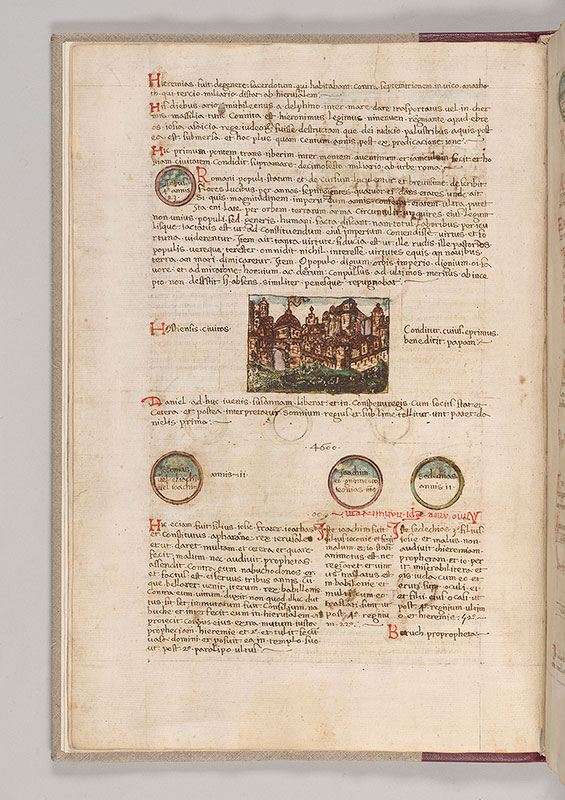
Fasciculus temporum
City of Ostia, towers and buildings, including domed building with banner, enclosed within wall.
MS M.801, fol. 9r
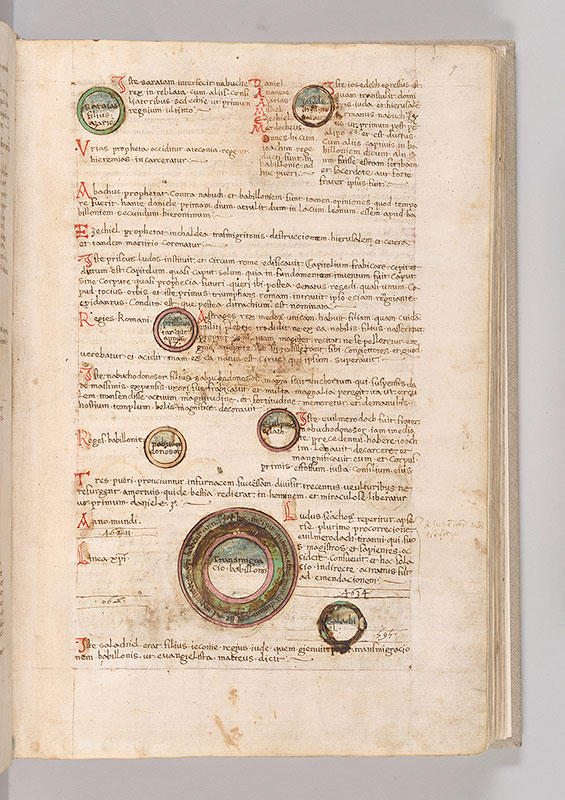
Fasciculus temporum
MS M.801, fol. 9v
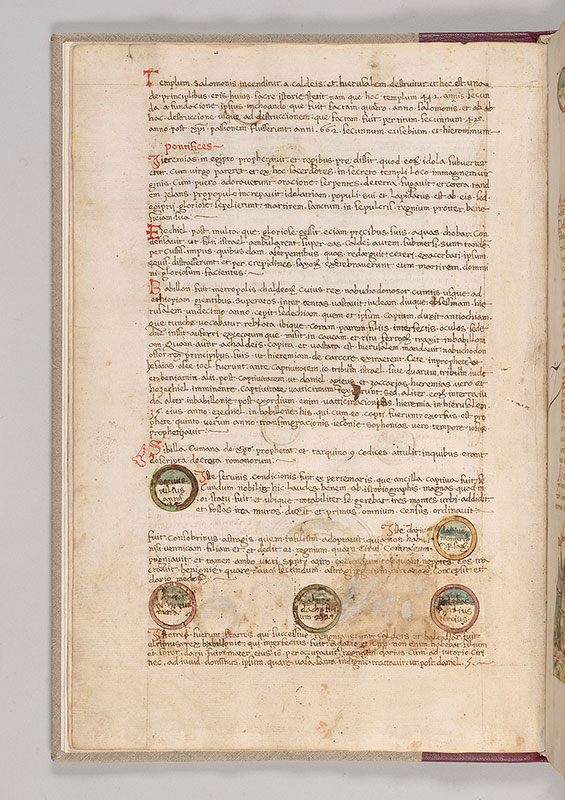
Fasciculus temporum
MS M.801, fol. 10r
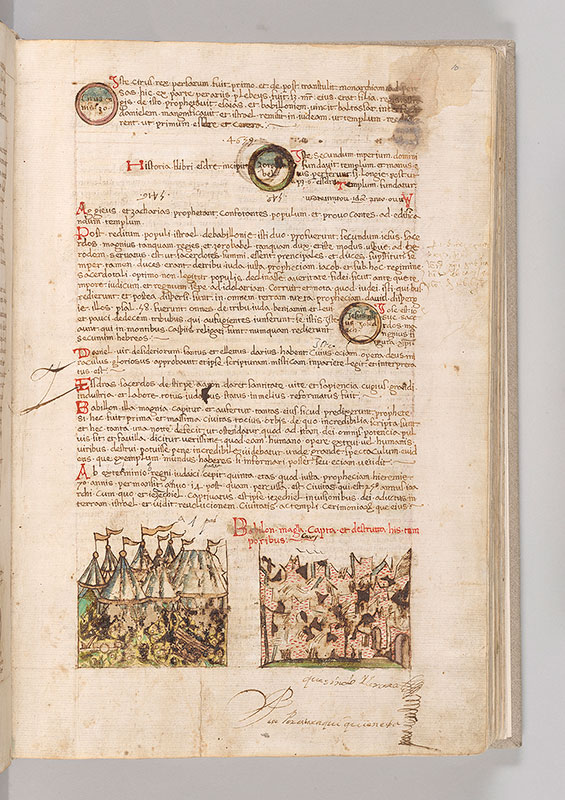
Fasciculus temporum
Left, camp as seven tents with banners before city of Babylon; war machines in foreground with stones. Right, destroyed city of Babylon.
MS M.801, fol. 10v
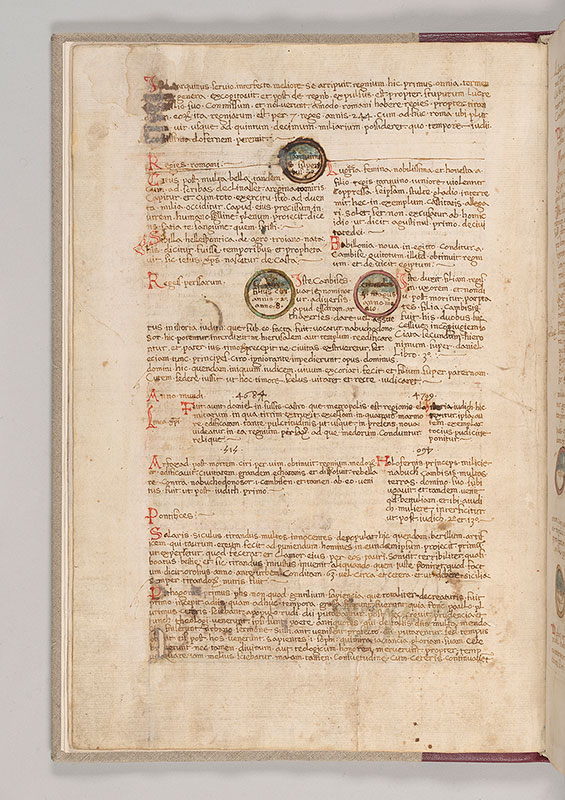
Fasciculus temporum
MS M.801, fol. 11r
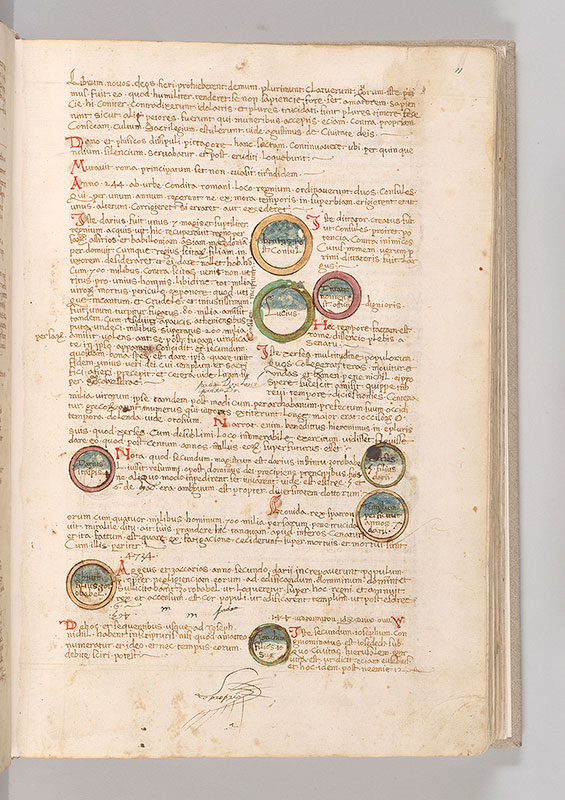
Fasciculus temporum
MS M.801, fol. 11v
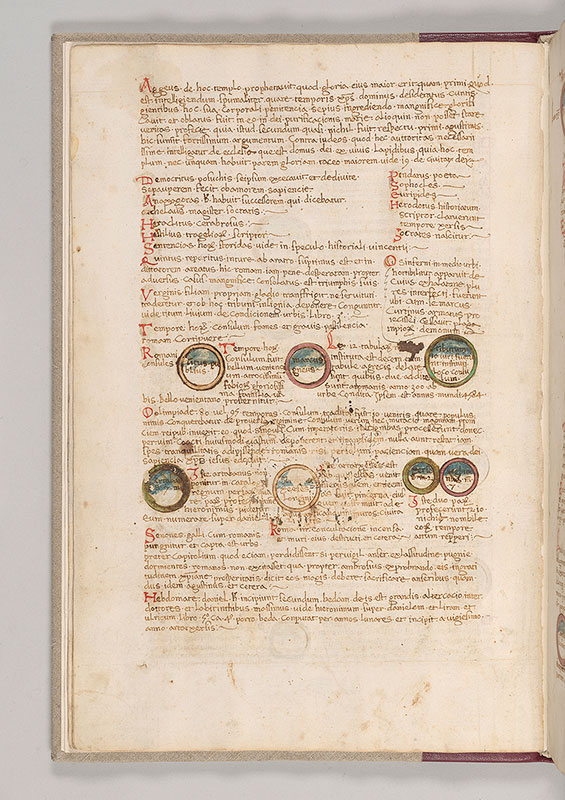
Fasciculus temporum
MS M.801, fol. 12r
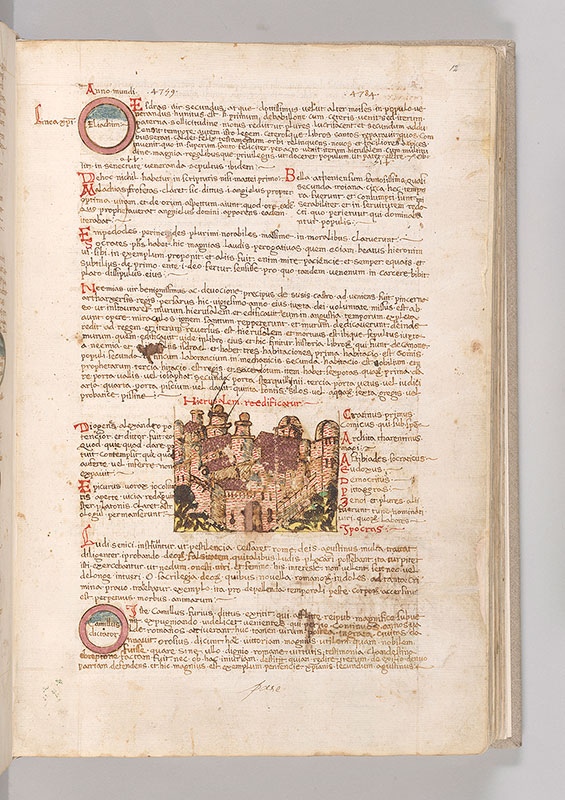
Fasciculus temporum
City of Jerusalem as buildings and domed towers within crenellated walls.
MS M.801, fol. 12v
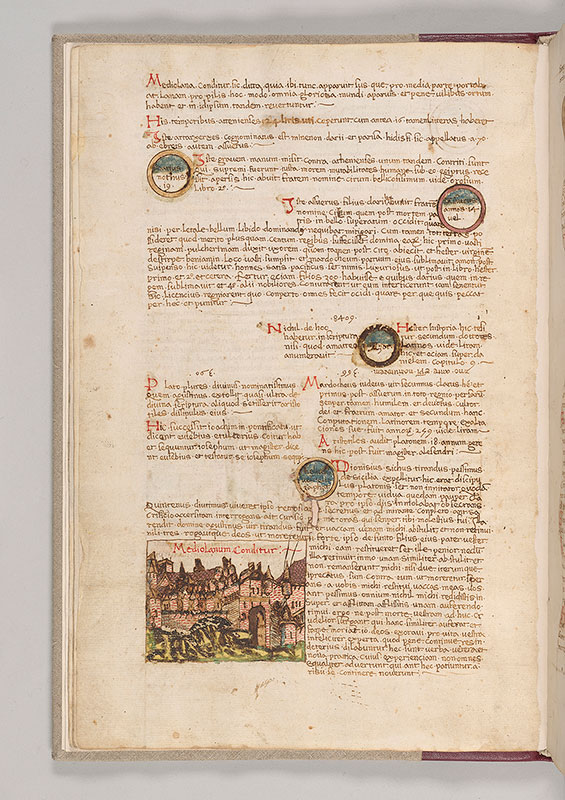
Fasciculus temporum
Milan as buildings enclosed within wall with portal, inscribed MEDIOLANUM CONDITUR.
MS M.801, fol. 13r
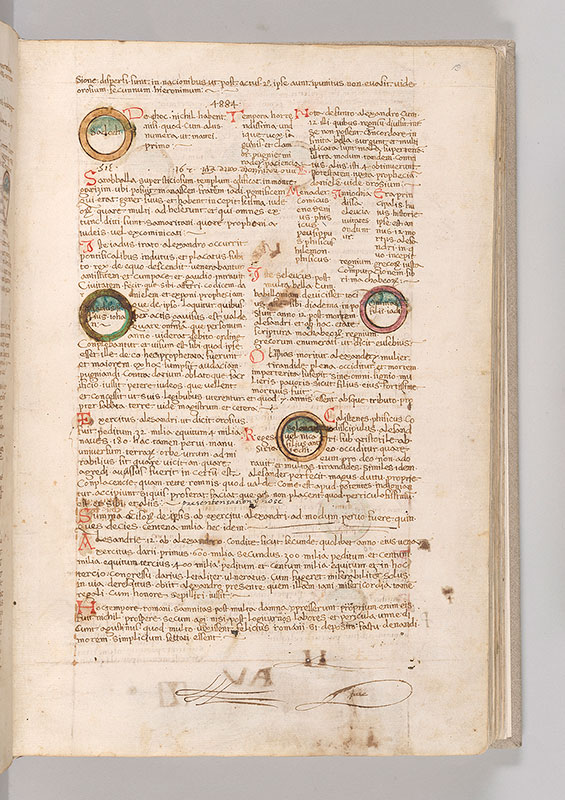
Fasciculus temporum
MS M.801, fol. 13v
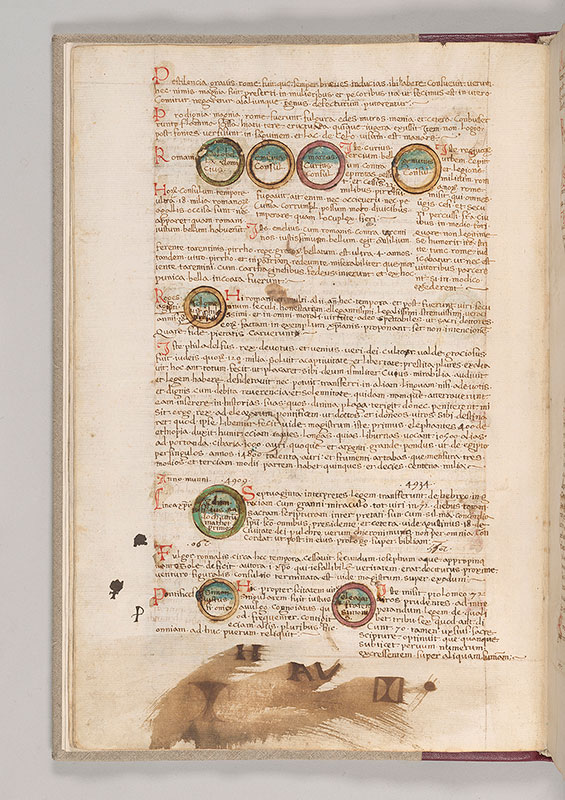
Fasciculus temporum
MS M.801, fol. 14r
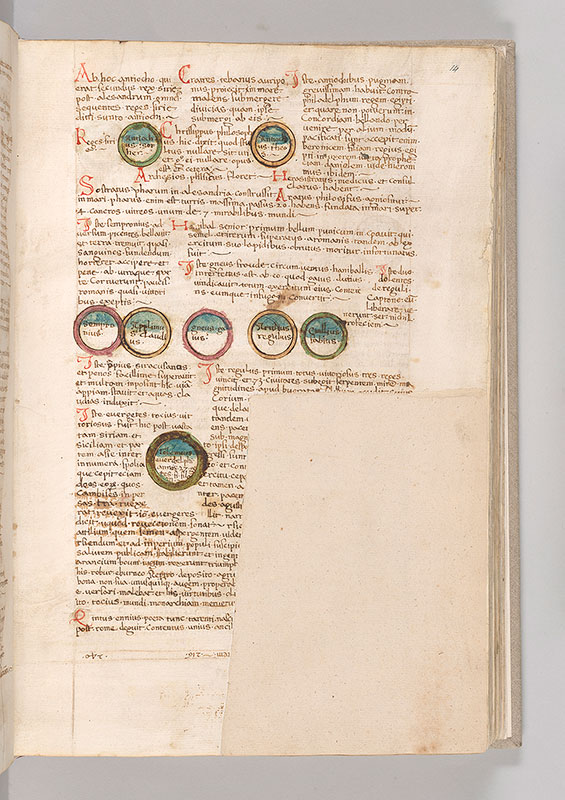
Fasciculus temporum
MS M.801, fol. 14v
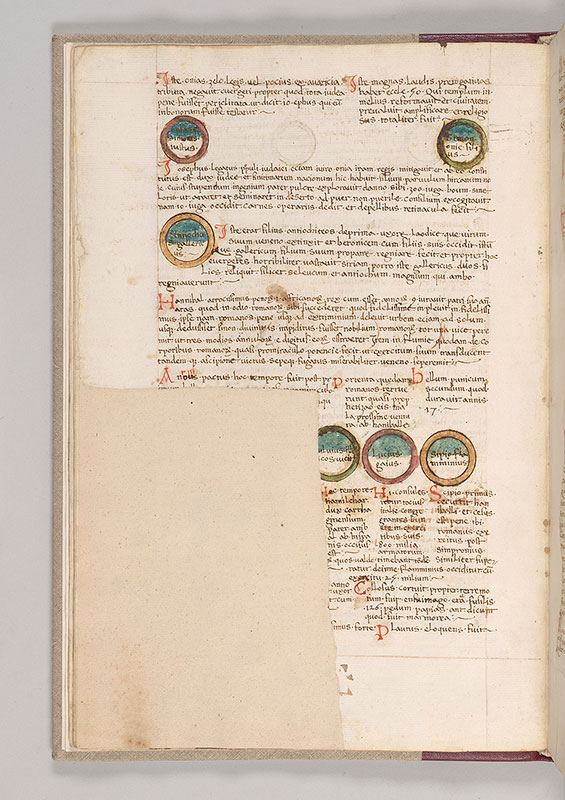
Fasciculus temporum
MS M.801, fol. 15r
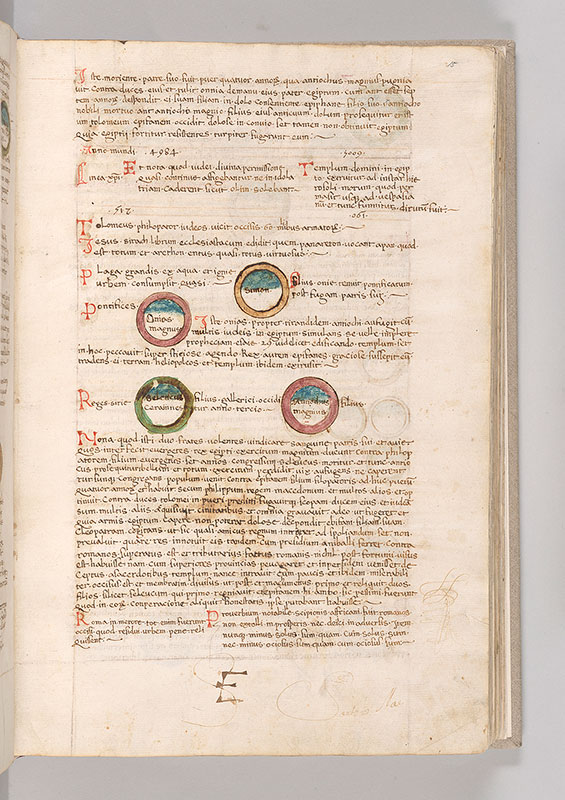
Fasciculus temporum
MS M.801, fol. 15v
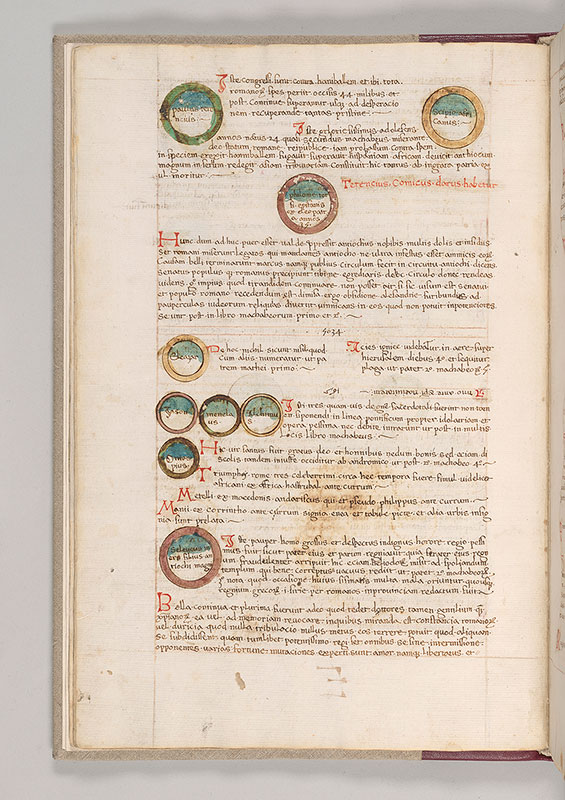
Fasciculus temporum
MS M.801, fol. 16r
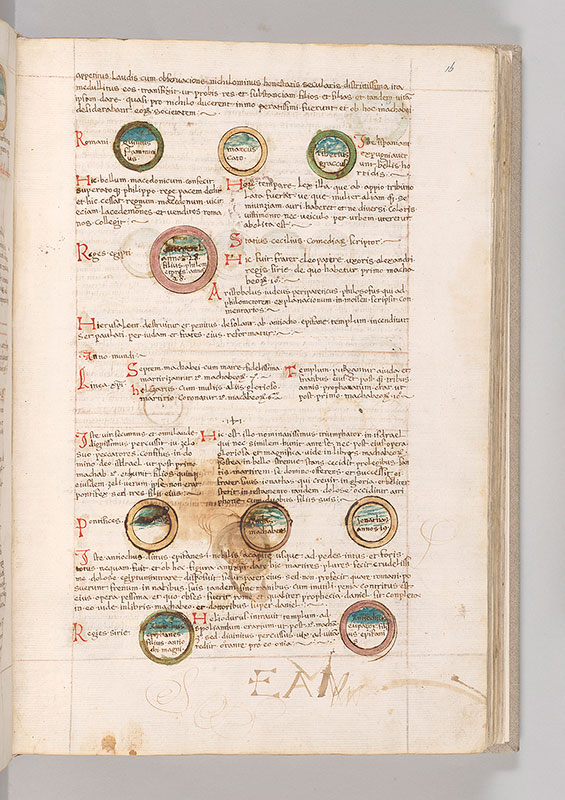
Fasciculus temporum
MS M.801, fol. 16v
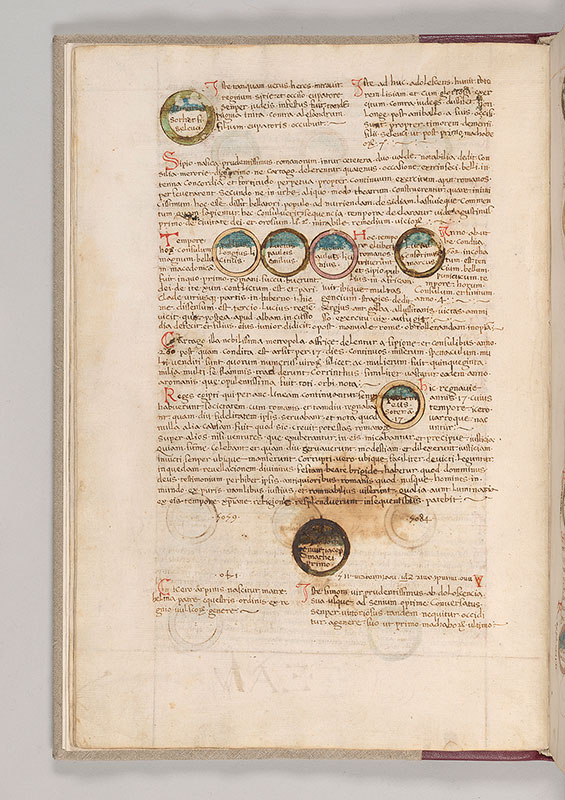
Fasciculus temporum
MS M.801, fol. 17r
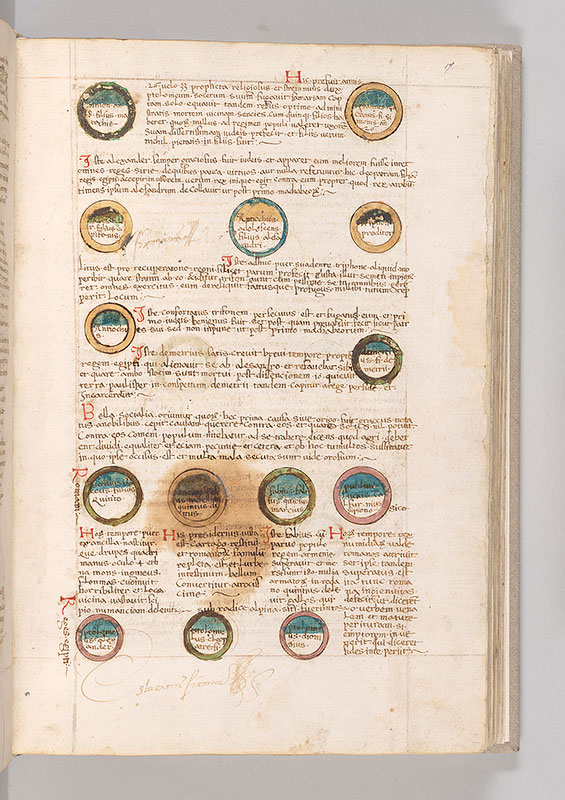
Fasciculus temporum
MS M.801, fol. 17v
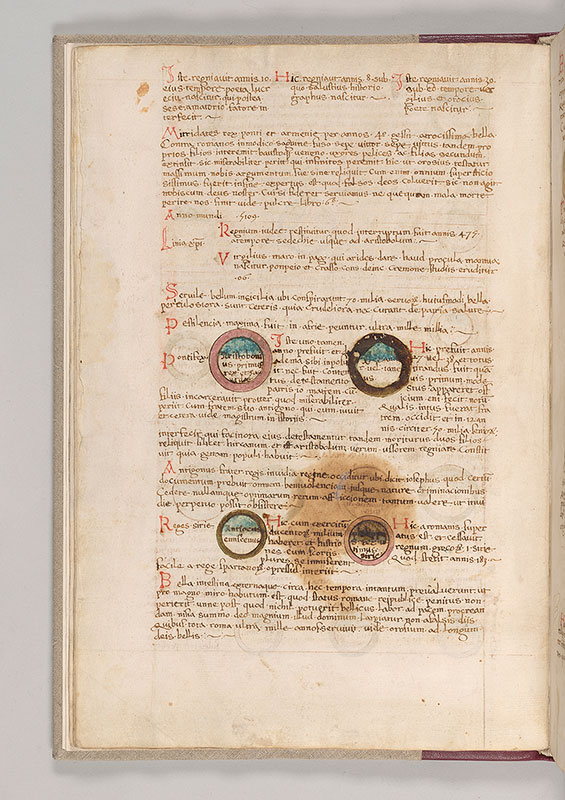
Fasciculus temporum
MS M.801, fol. 18r
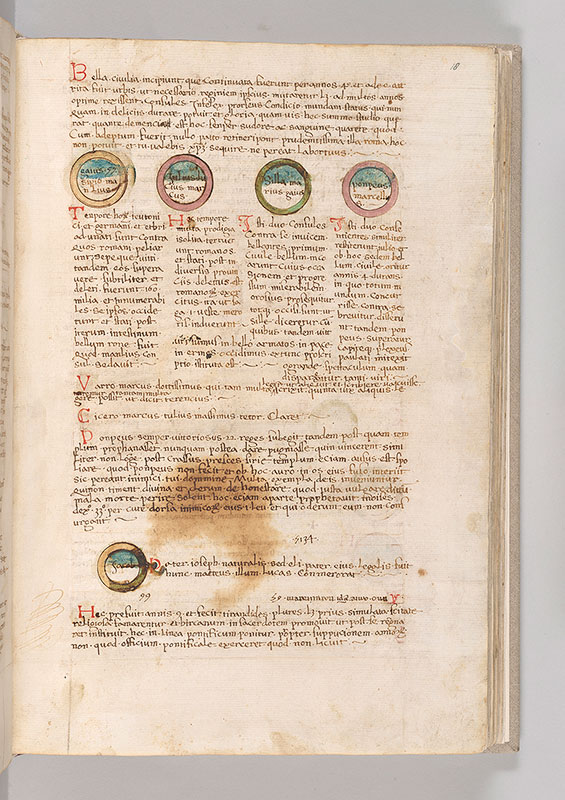
Fasciculus temporum
MS M.801, fol. 18v
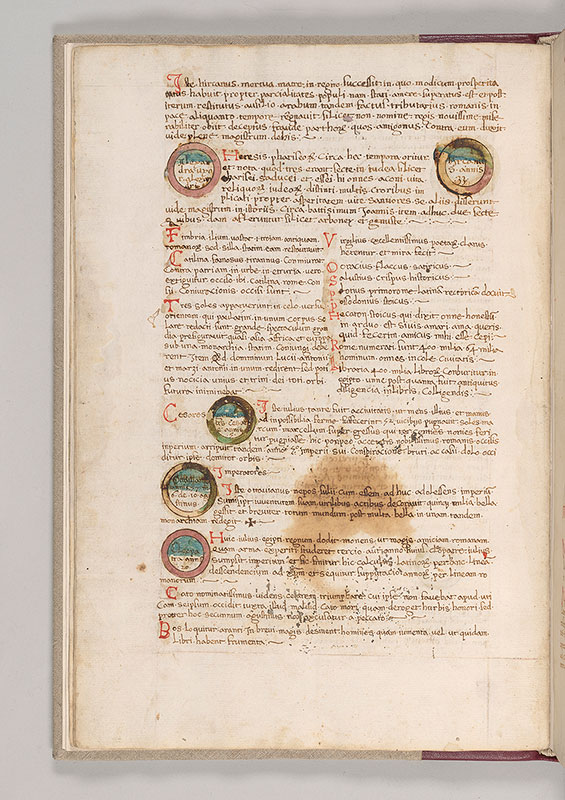
Fasciculus temporum
MS M.801, fol. 19r
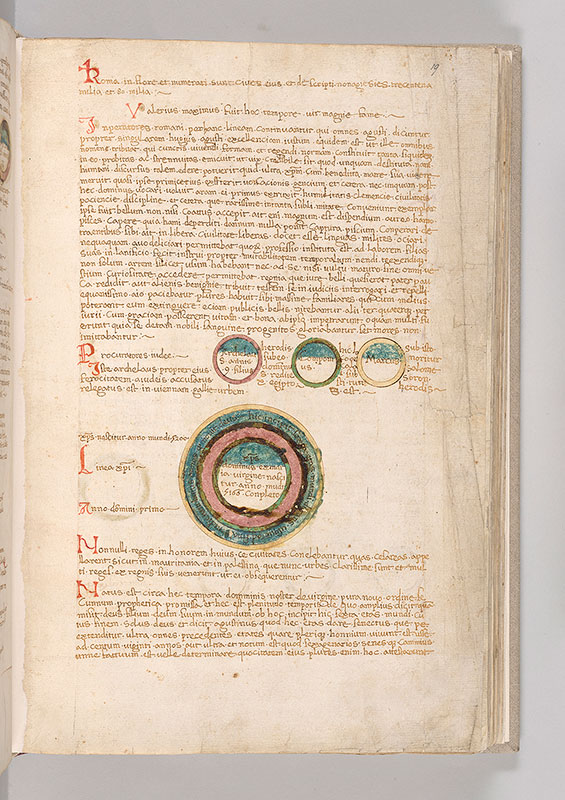
Fasciculus temporum
MS M.801, fol. 19v
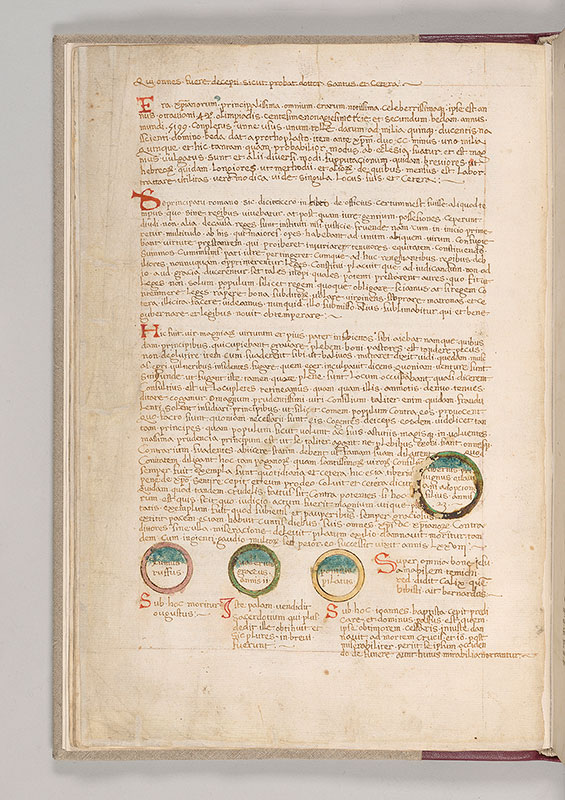
Fasciculus temporum
MS M.801, fol. 20r
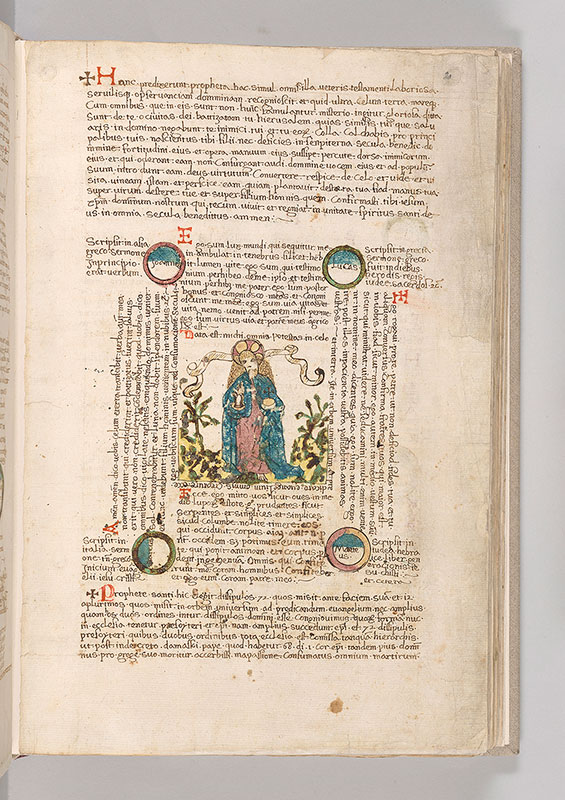
Fasciculus temporum
Christ, crossed nimbus, raising right hand in blessing (?), holding with draped left hand, cross surmounted globe, blank scroll behind head, standing, flanked by bushes. Miniature framed with inscription, DATA EST MICHI OMNIS POTESTAS IN CELO ET IN TERRA. ITE IN ORBEM UNIUERSUM ET PREDICATE EUANGELIUM OMNIS CREATURE ECCE EGO UOBISCUM SUM USQUE AD CONSUMACIONEM SECULI (partially, Matthew 28:20).
MS M.801, fol. 20v
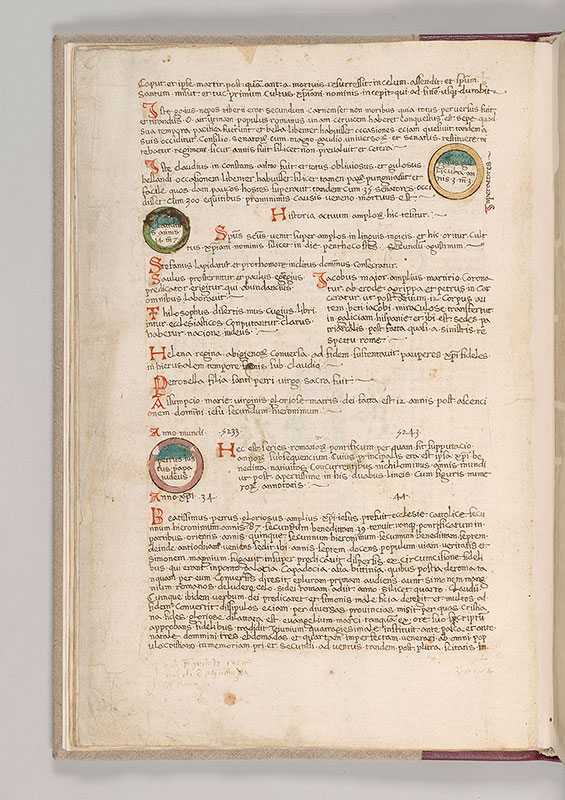
Fasciculus temporum
MS M.801, fol. 21r
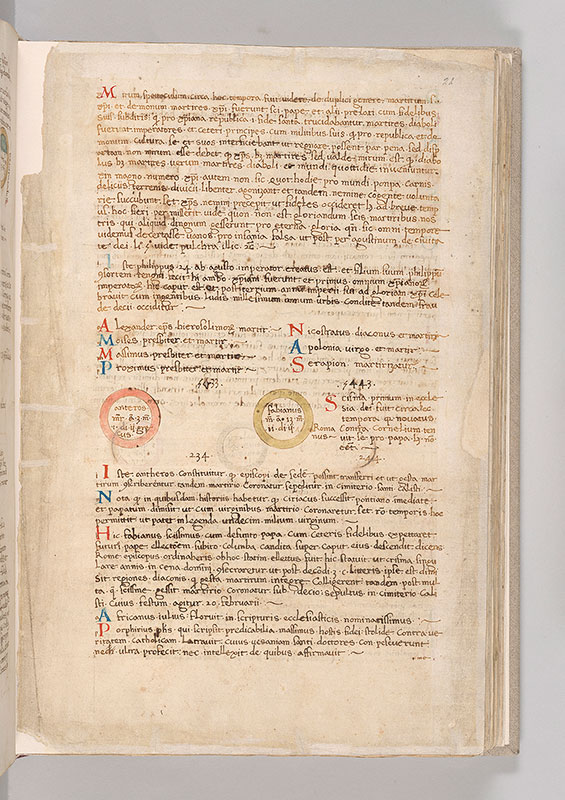
Fasciculus temporum
MS M.801, fol. 21v
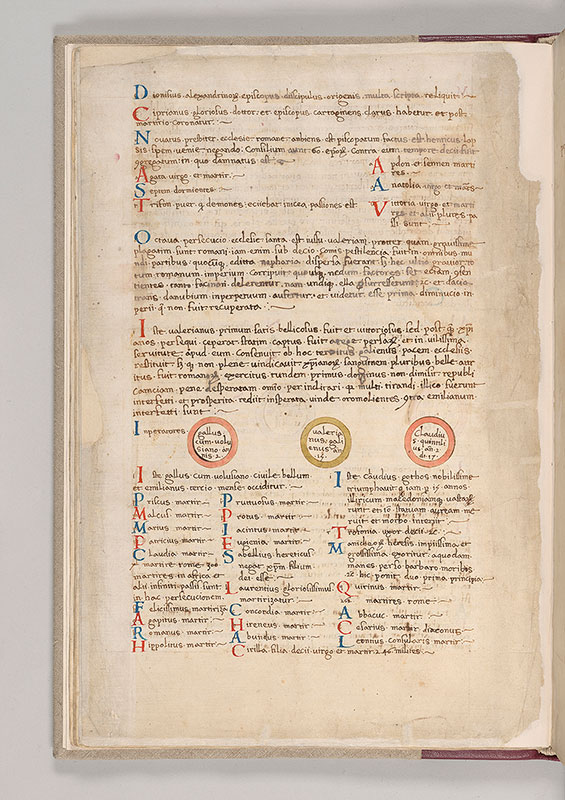
Fasciculus temporum
MS M.801, fol. 22r
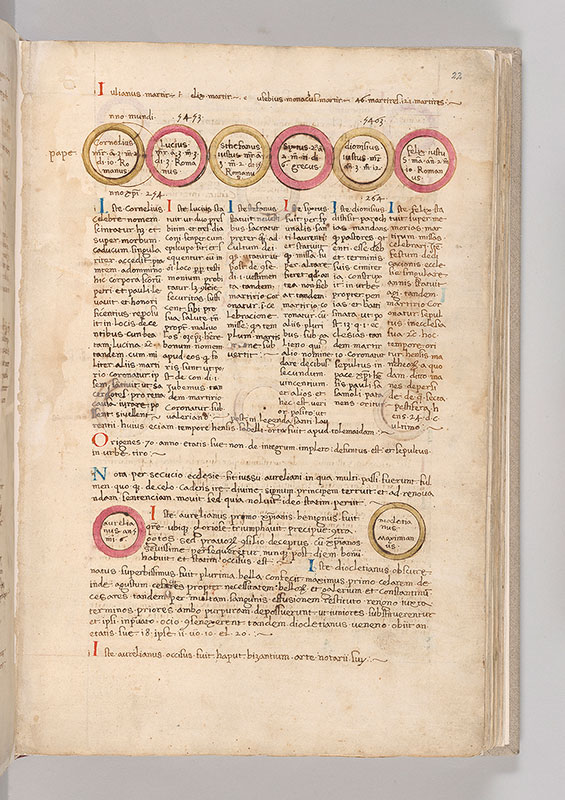
Fasciculus temporum
MS M.801, fol. 22v
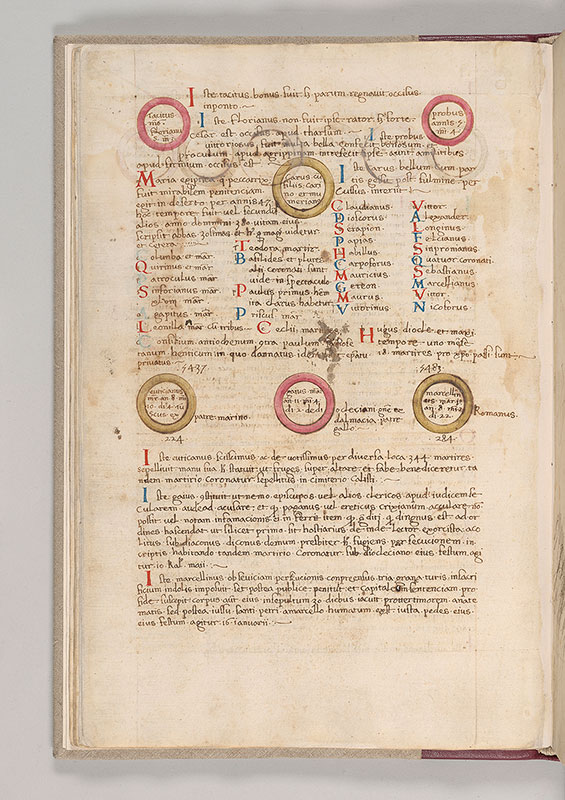
Fasciculus temporum
MS M.801, fol. 23r
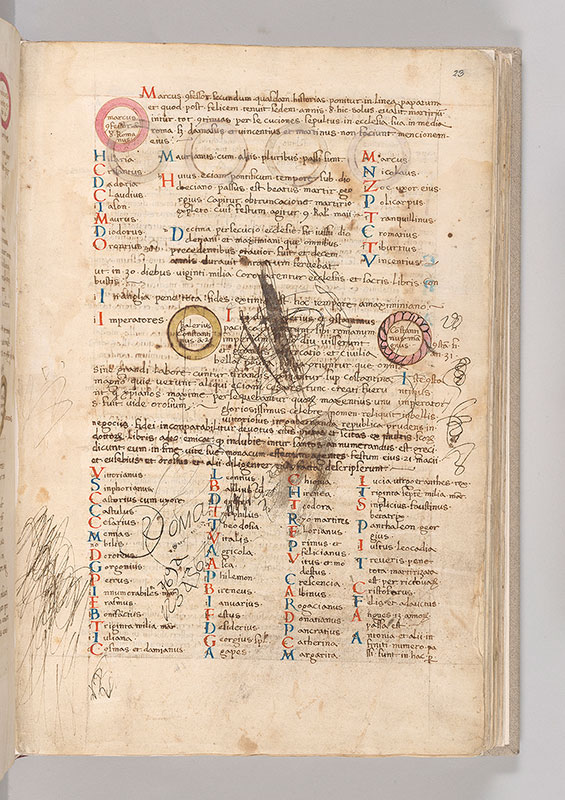
Fasciculus temporum
MS M.801, fol. 23v
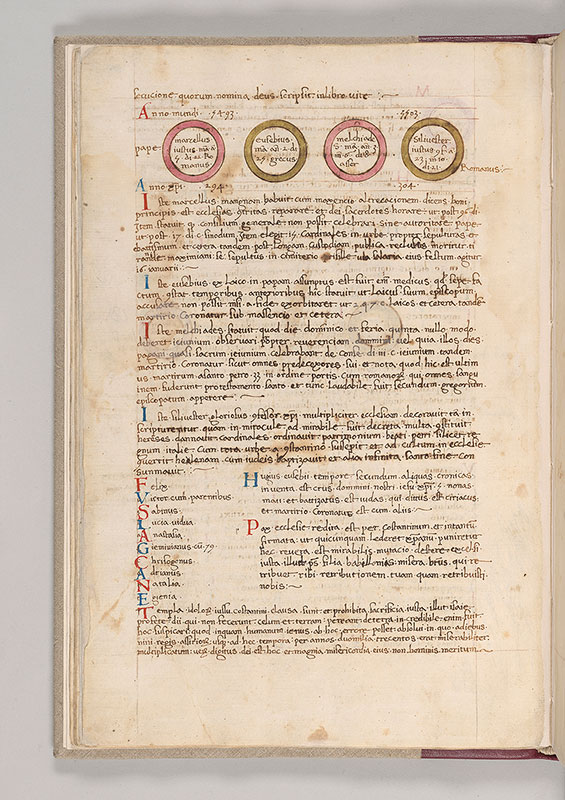
Fasciculus temporum
MS M.801, fol. 24r
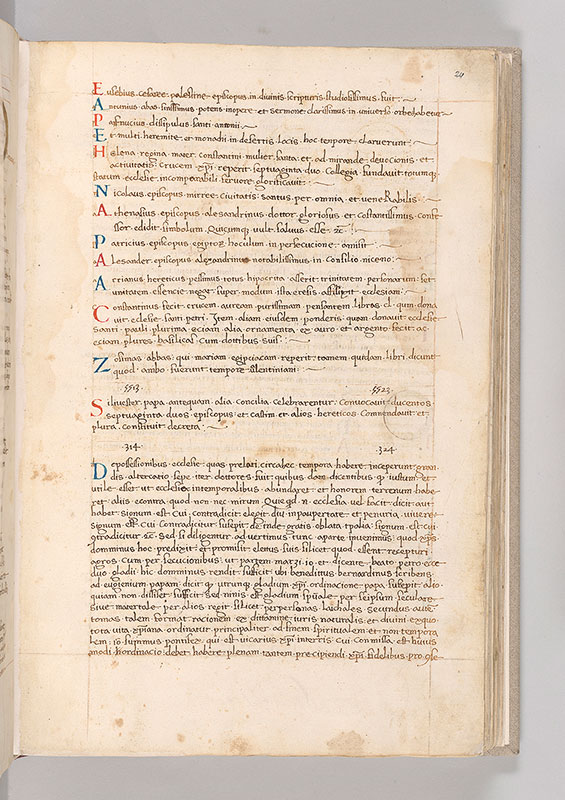
Fasciculus temporum
MS M.801, fol. 24v
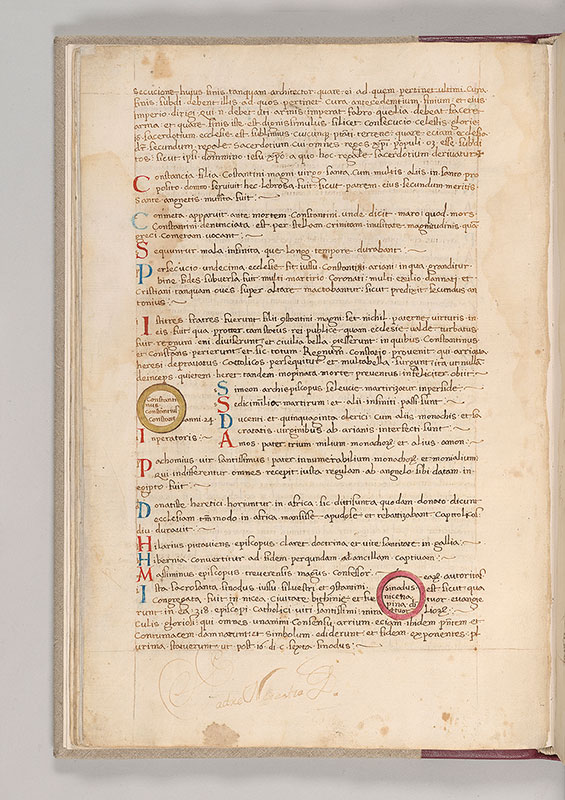
Fasciculus temporum
MS M.801, fol. 25r
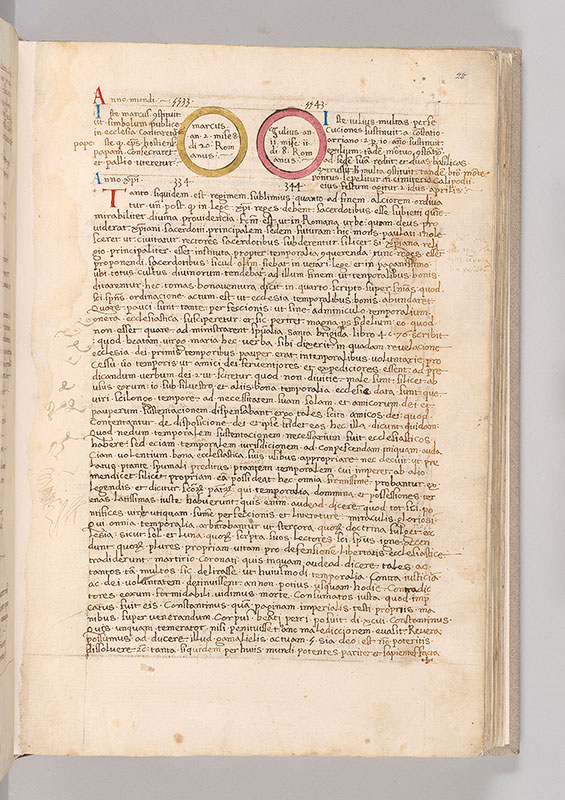
Fasciculus temporum
MS M.801, fol. 25v
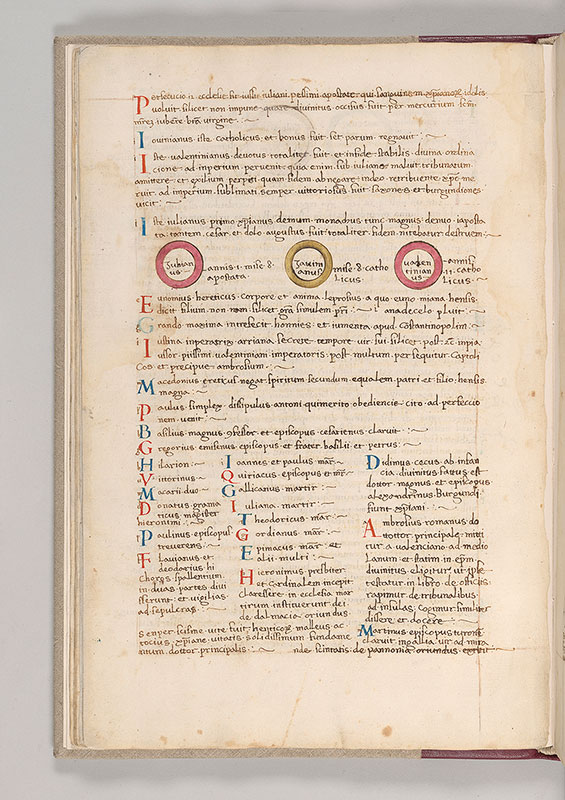
Fasciculus temporum
MS M.801, fol. 26r
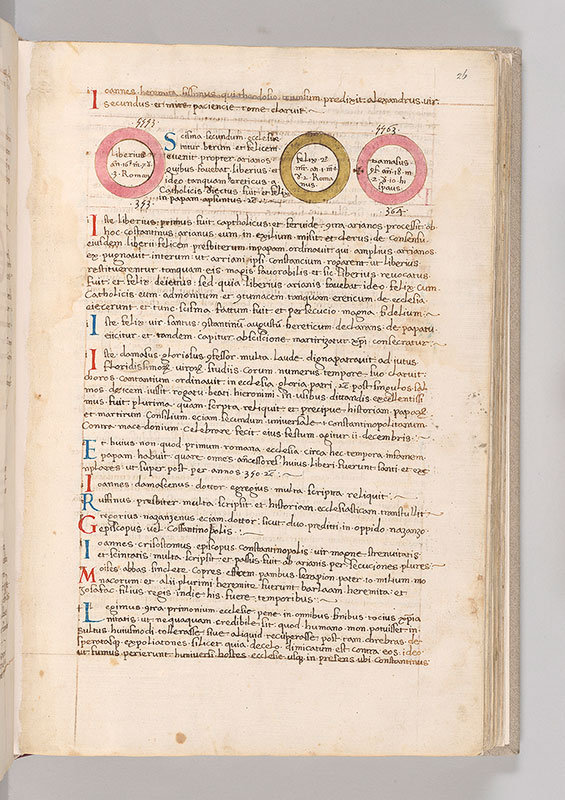
Fasciculus temporum
MS M.801, fol. 26v
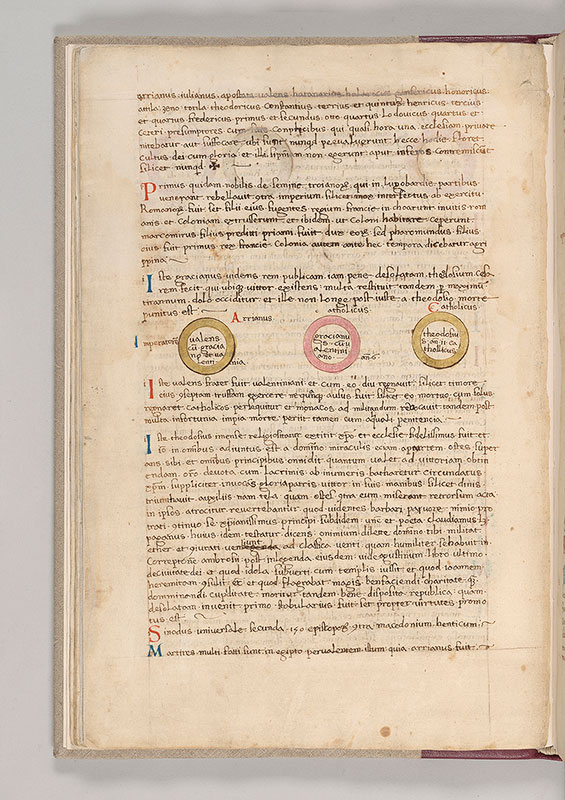
Fasciculus temporum
MS M.801, fol. 27r
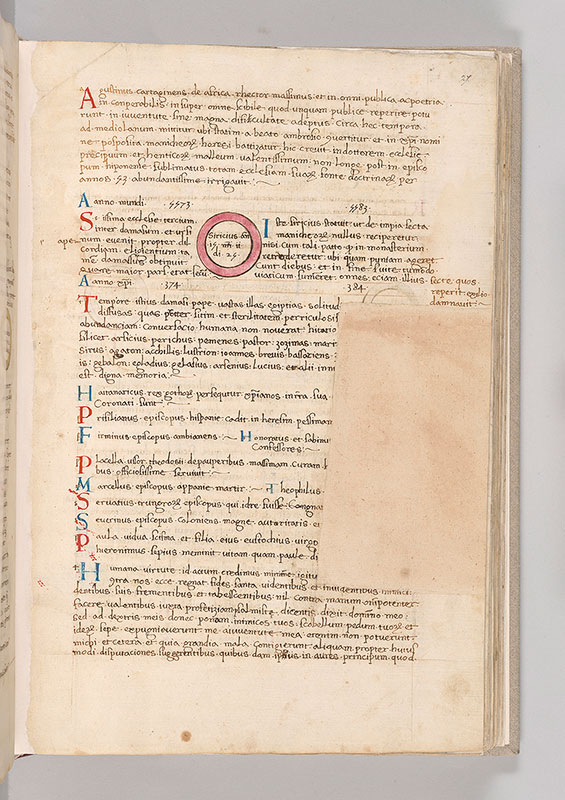
Fasciculus temporum
MS M.801, fol. 27v
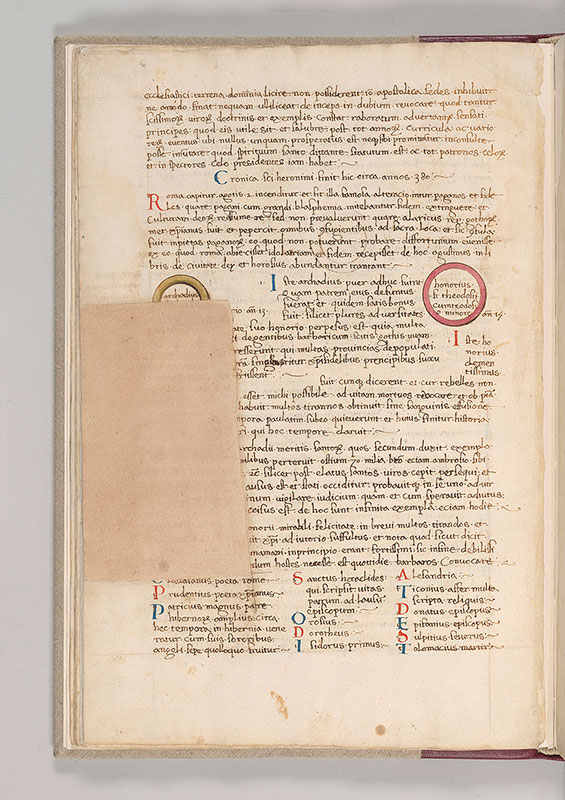
Fasciculus temporum
MS M.801, fol. 28r
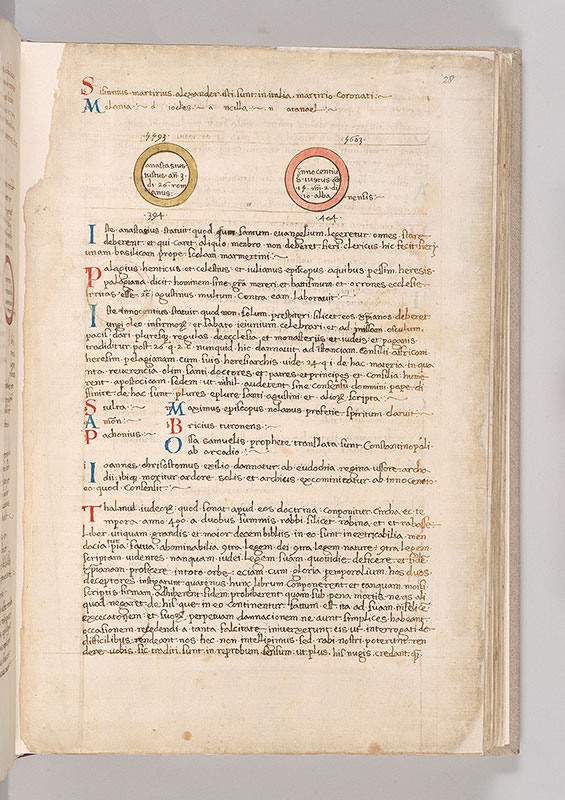
Fasciculus temporum
MS M.801, fol. 28v
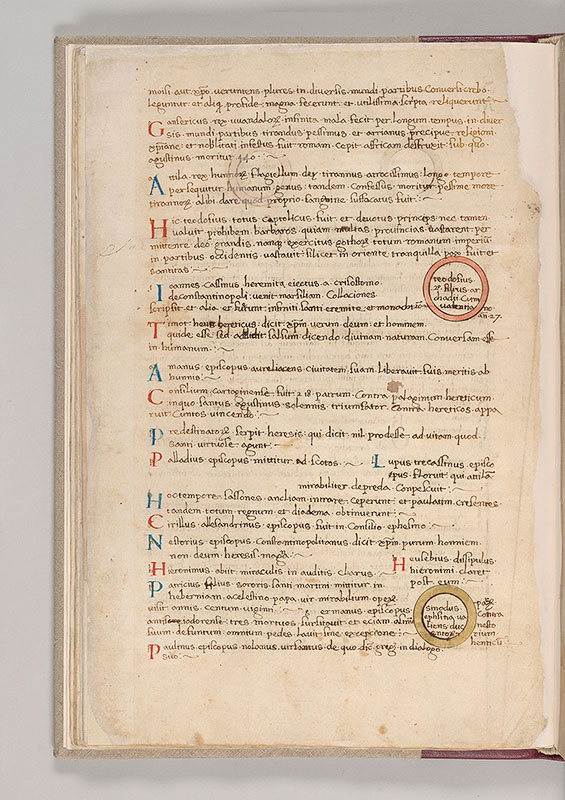
Fasciculus temporum
MS M.801, fol. 29r
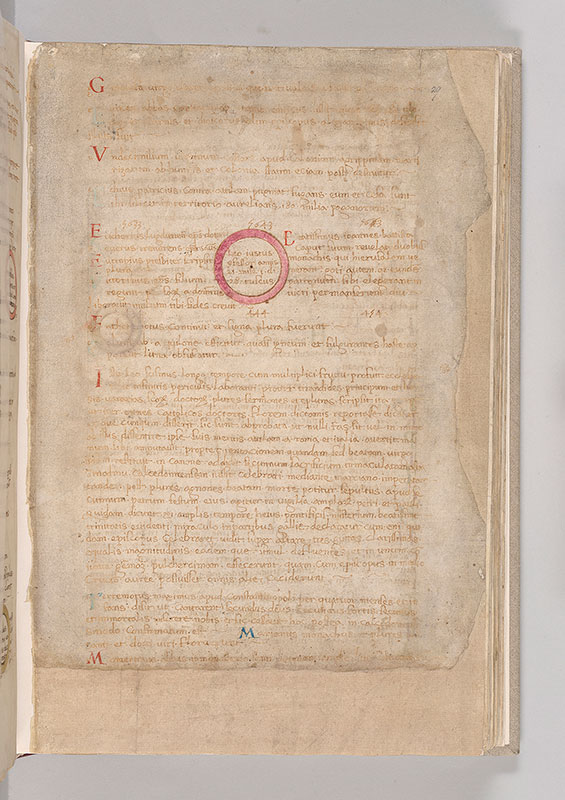
Fasciculus temporum
MS M.801, fol. 29v
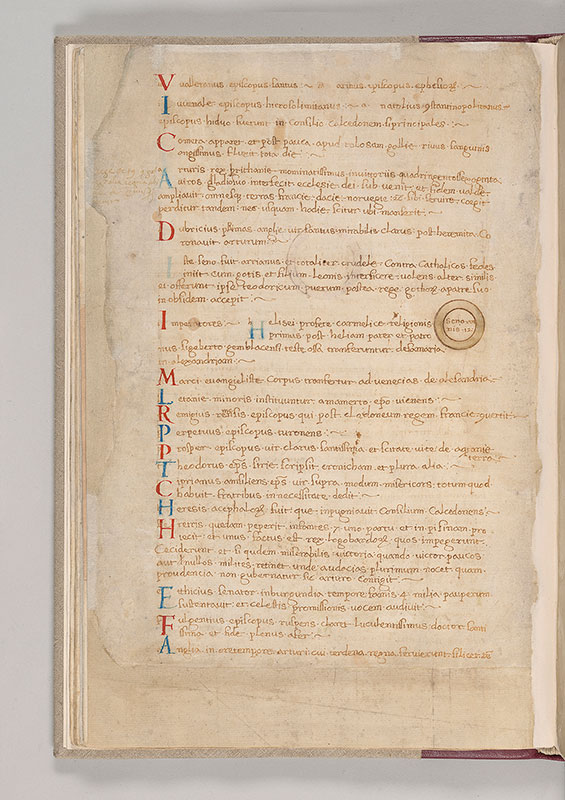
Fasciculus temporum
MS M.801, fol. 30r
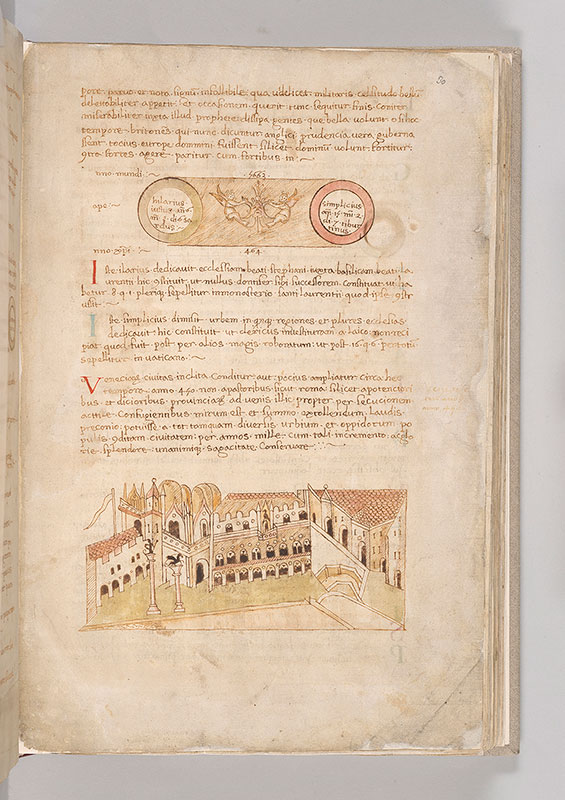
Fasciculus temporum
Venice, showing San Marco next to Doge's palace at right with bird, or statue of bird, atop arched opening on balcony; bridge at right; canal in foreground. Two columns at edge of piazza, one surmounted by Theodore the General, extending one hand to dragon, holding staff (?) with other hand; second column surmounted by winged lion, symbol of Evangelist Mark.
In upper half of page, mask or head, flanked by two winged putti, each grasping horns (?) on the mask.
MS M.801, fol. 30v

Fasciculus temporum
MS M.801, fol. 31r

Fasciculus temporum
At left, Sipontum, with buildings of city enclosed within crenellated wall with portal. At right, Mount Gargano, with tower, and possibly bell tower (campanile) next to church atop mound.
MS M.801, fol. 31v
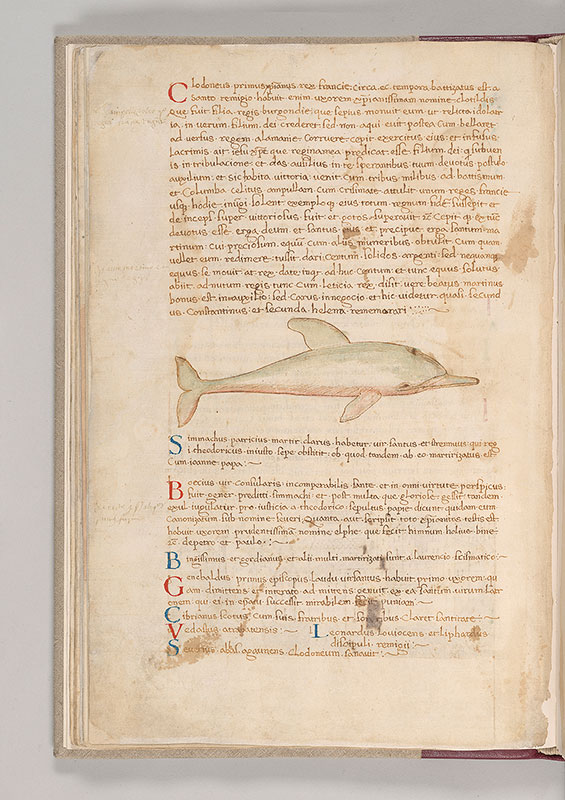
Fasciculus temporum
Dolphin facing right.
MS M.801, fol. 32r
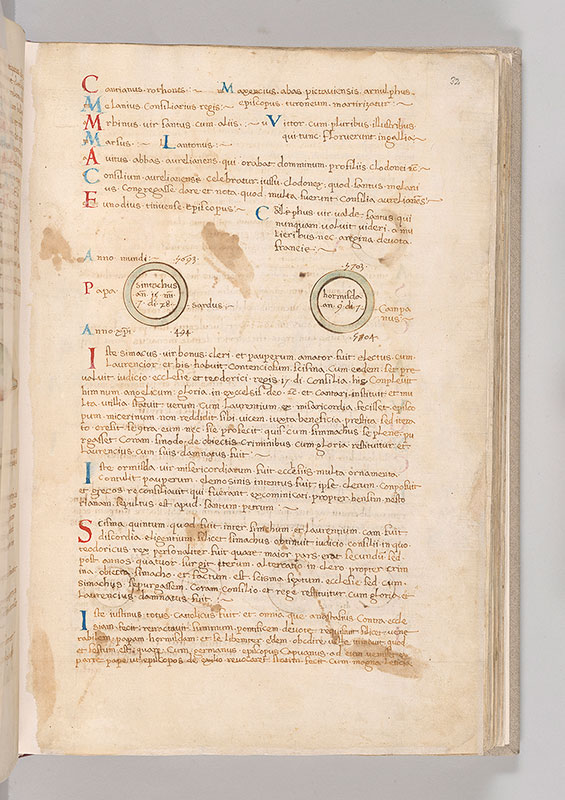
Fasciculus temporum
MS M.801, fol. 32v
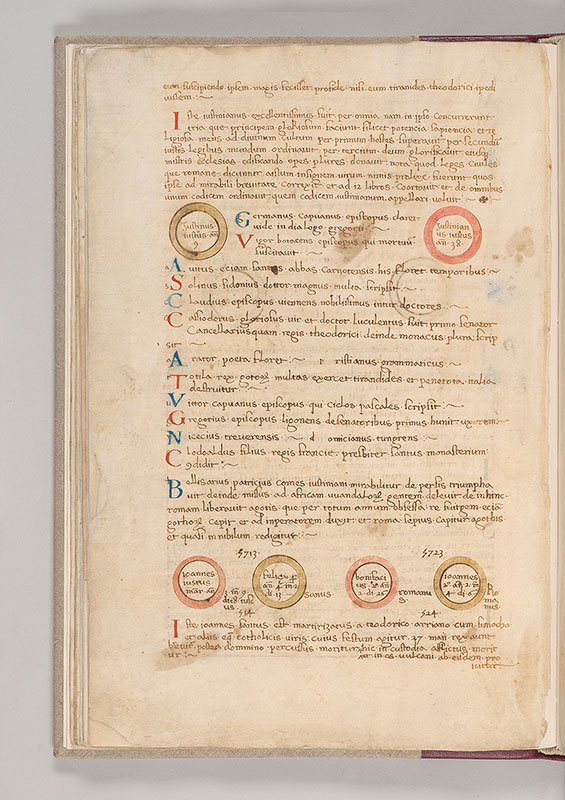
Fasciculus temporum
MS M.801, fol. 33r
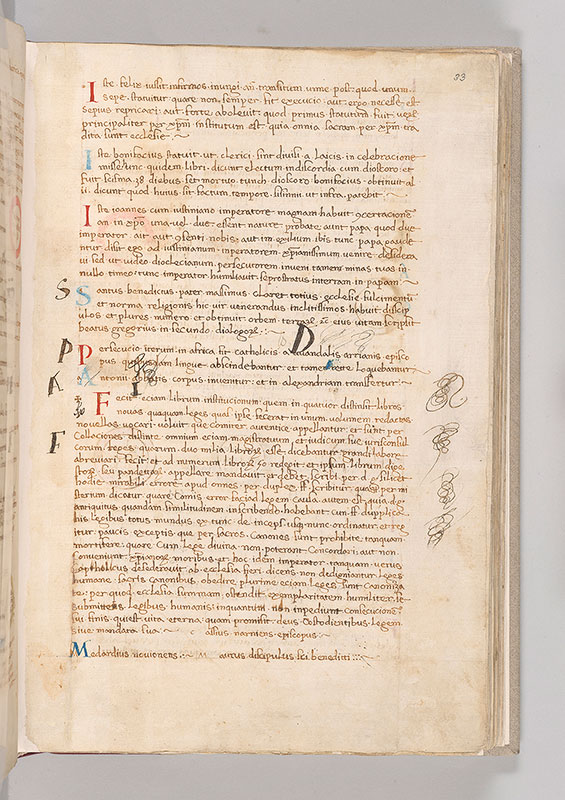
Fasciculus temporum
MS M.801, fol. 33v
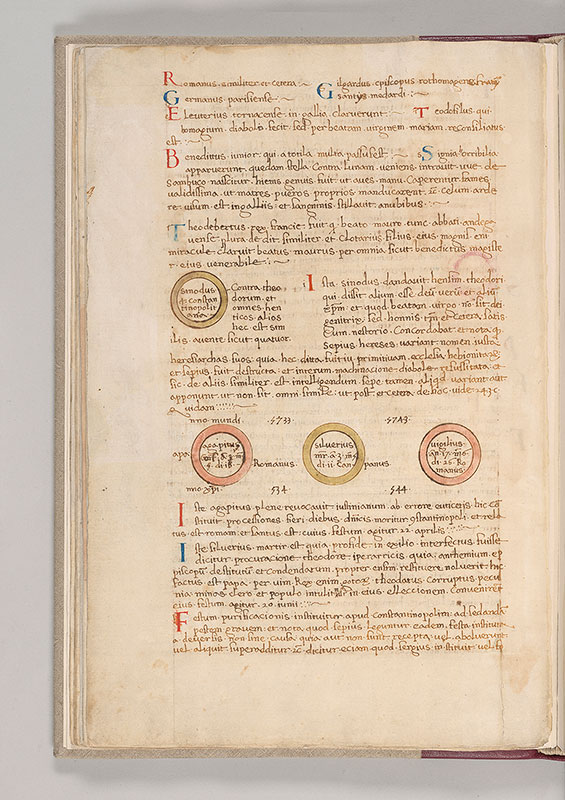
Fasciculus temporum
MS M.801, fol. 34r
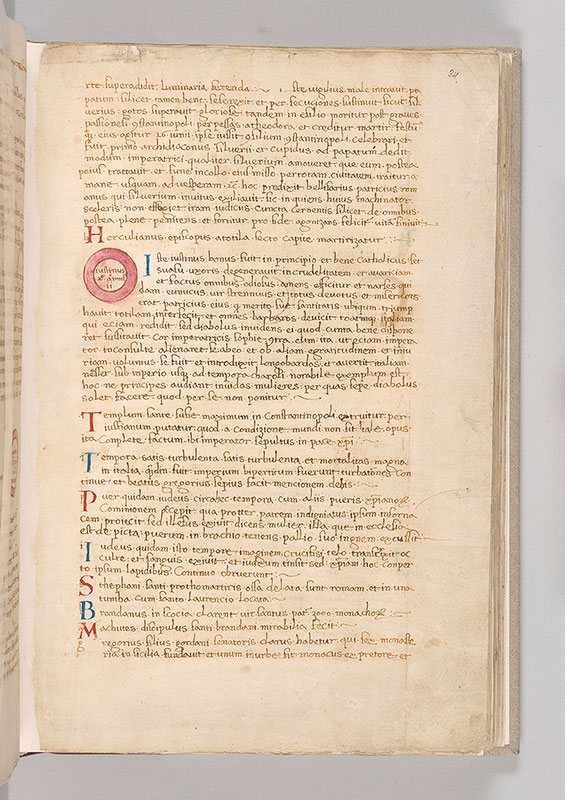
Fasciculus temporum
MS M.801, fol. 34v
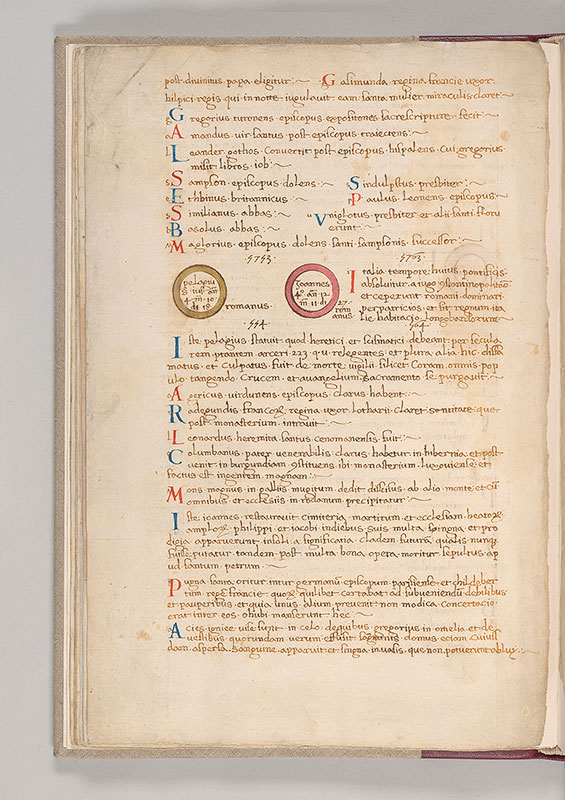
Fasciculus temporum
MS M.801, fol. 35r
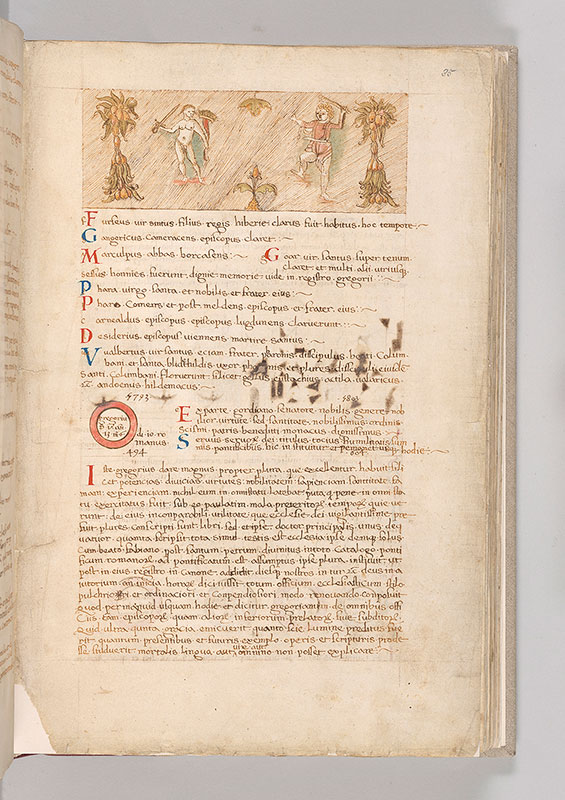
Fasciculus temporum
Nude man, raising sword with right hand, grasping with left hand drapery (?) possibly attached to crown, confronting man raising club with left hand, knife at waist.
MS M.801, fol. 35v
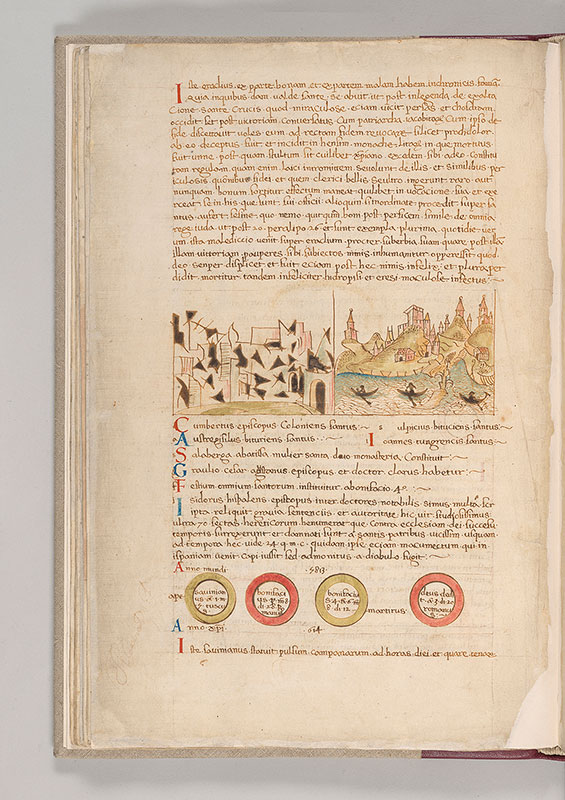
Fasciculus temporum
At left, destroyed city of Jerusalem; at right, city of buildings on several hills beside water in which are three boats, each rowed by one man.
MS M.801, fol. 36r
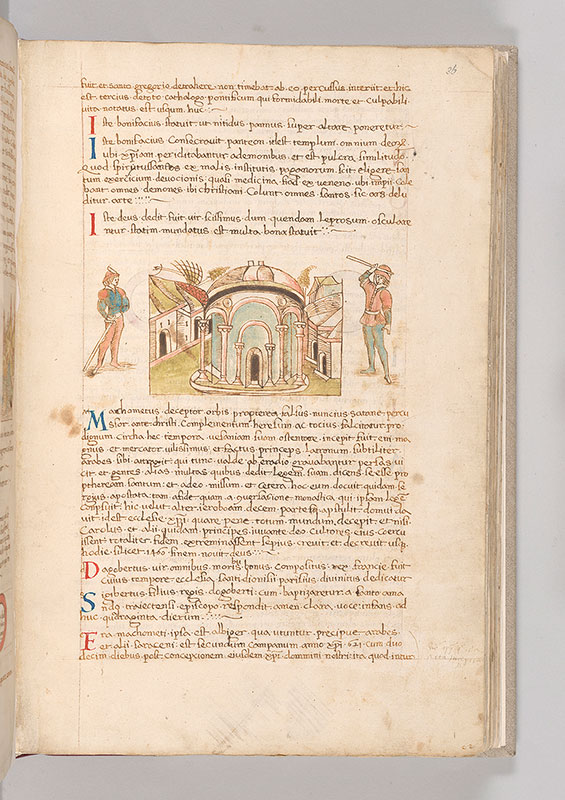
Fasciculus temporum
Pantheon of Rome, as domed building with facade of three arches, and portal below arch, flanked by buildings. All flanked by two men wearing hats, one holding sword with both hands, the other raising rod with right hand.
MS M.801, fol. 36v
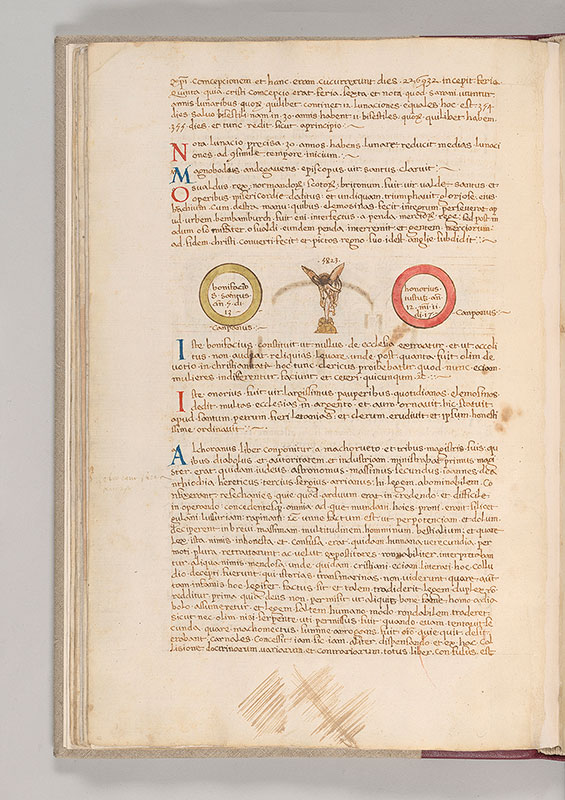
Fasciculus temporum
Eros as winged putto, drawing back right arm, extending bow with left hand, possibly wearing quiver with strap over right shoulder.
MS M.801, fol. 37r
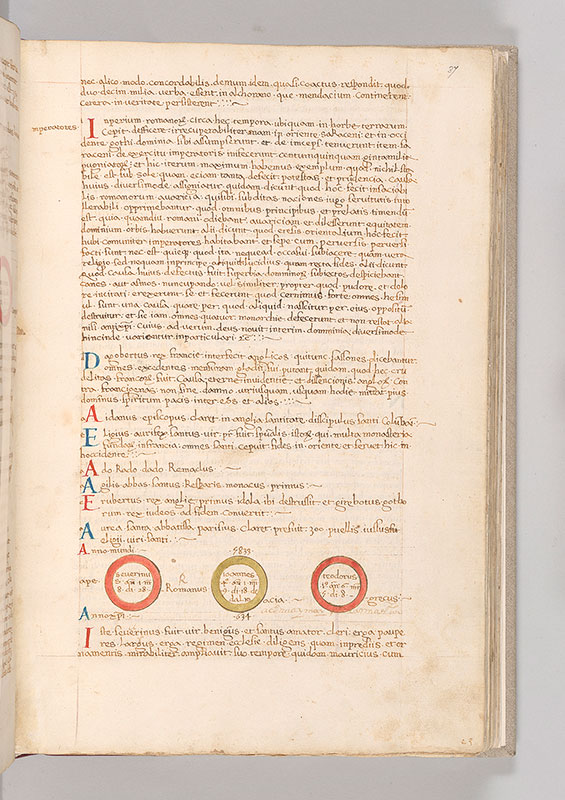
Fasciculus temporum
MS M.801, fol. 37v
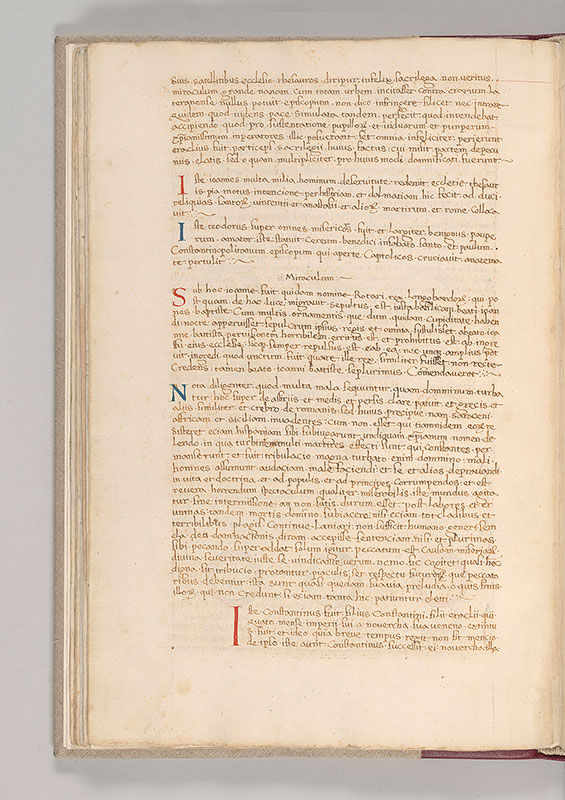
Fasciculus temporum
MS M.801, fol. 38r
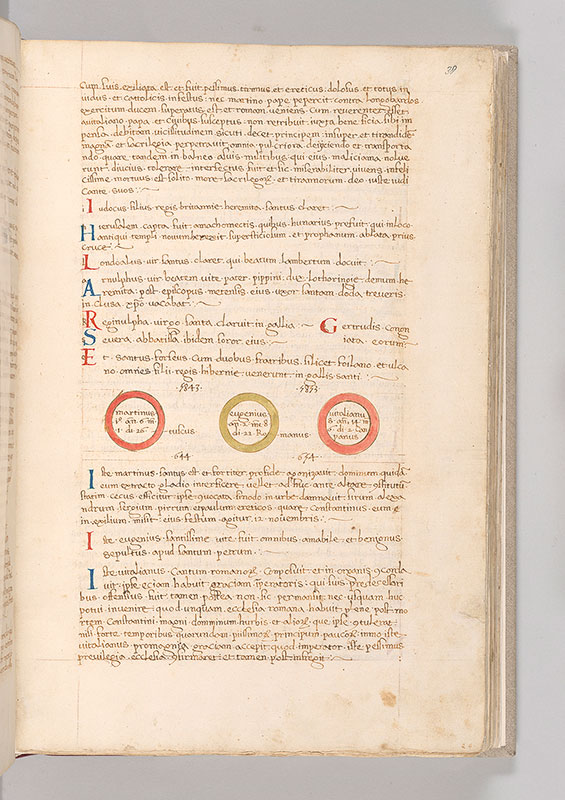
Fasciculus temporum
MS M.801, fol. 38v
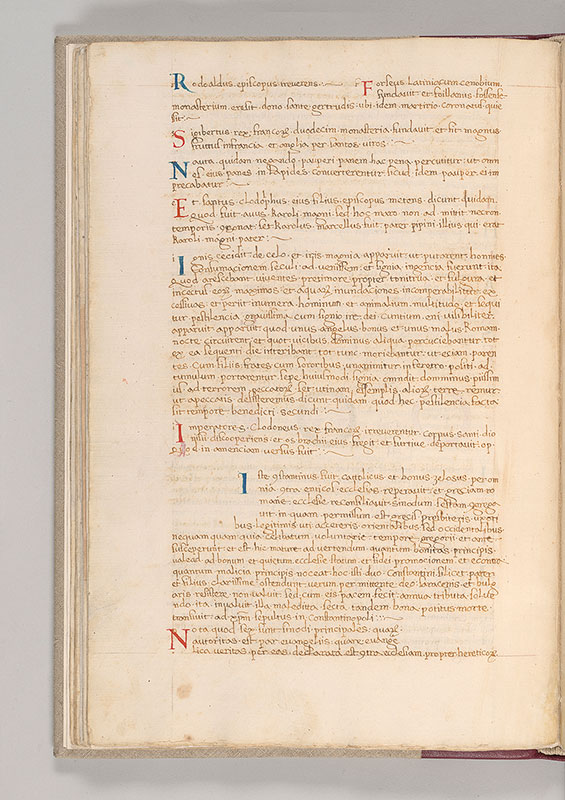
Fasciculus temporum
MS M.801, fol. 39r
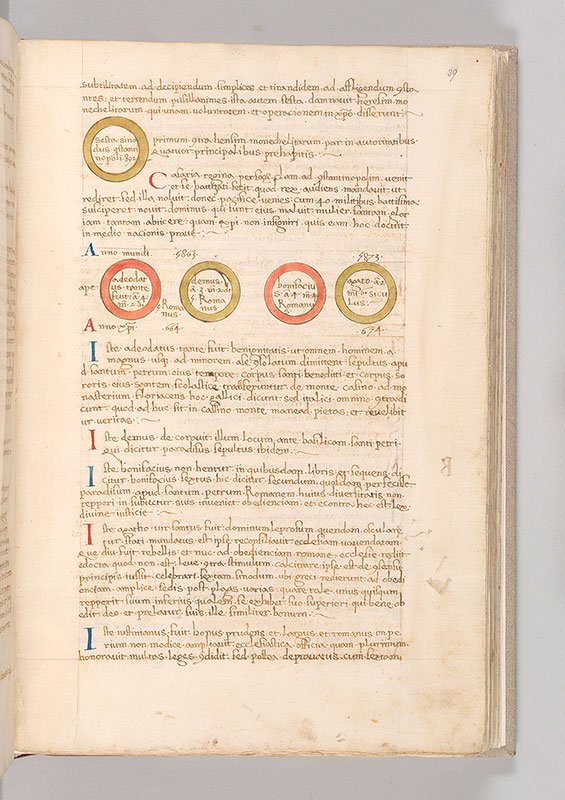
Fasciculus temporum
MS M.801, fol. 39v
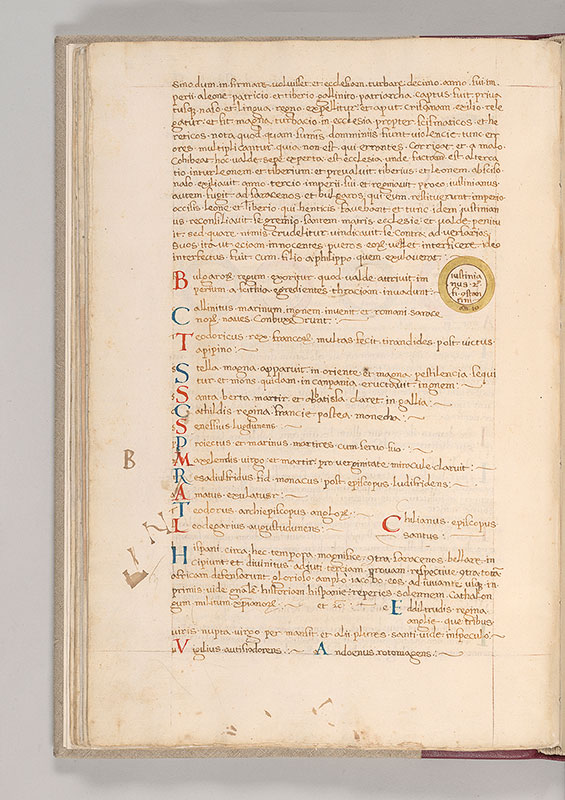
Fasciculus temporum
MS M.801, fol. 40r
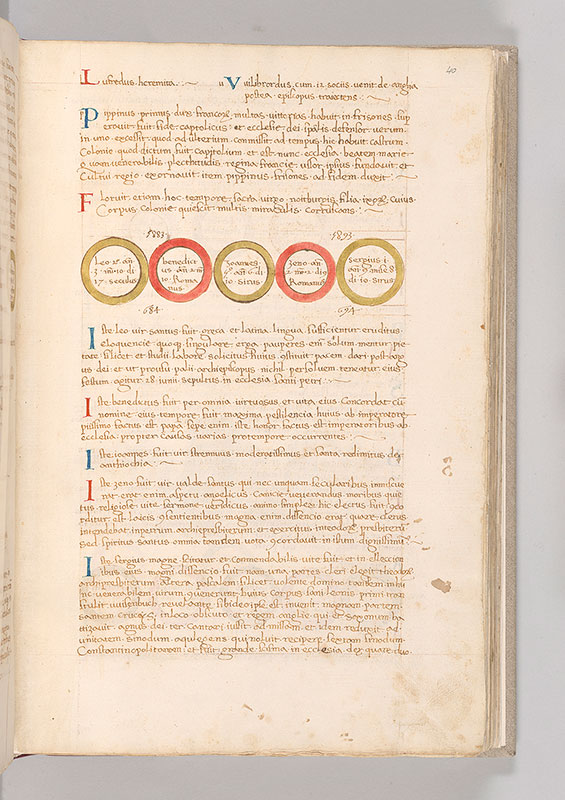
Fasciculus temporum
MS M.801, fol. 40v
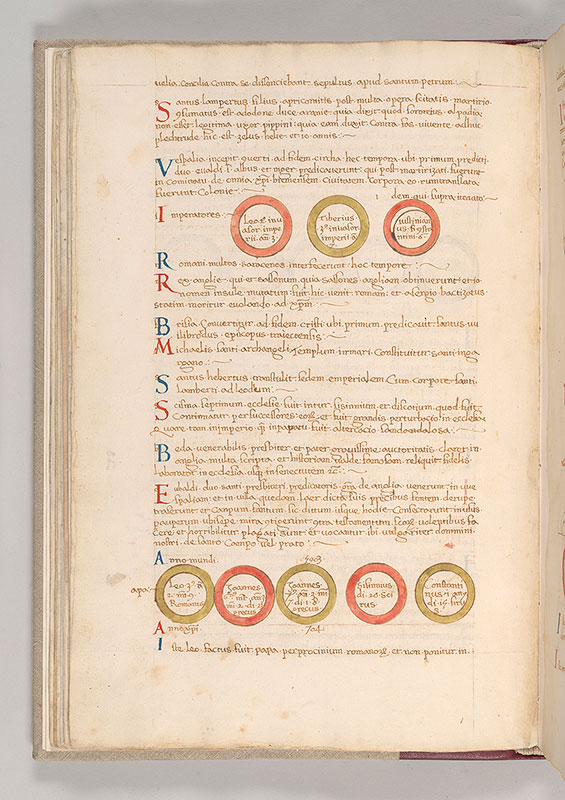
Fasciculus temporum
MS M.801, fol. 41r
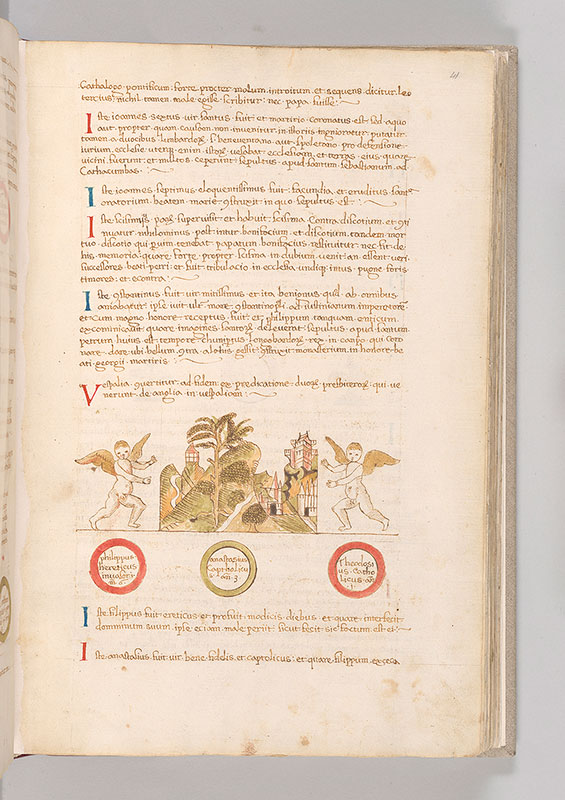
Fasciculus temporum
Westphalia as city with buildings in hilly landscape, all flanked by two putti.
MS M.801, fol. 41v
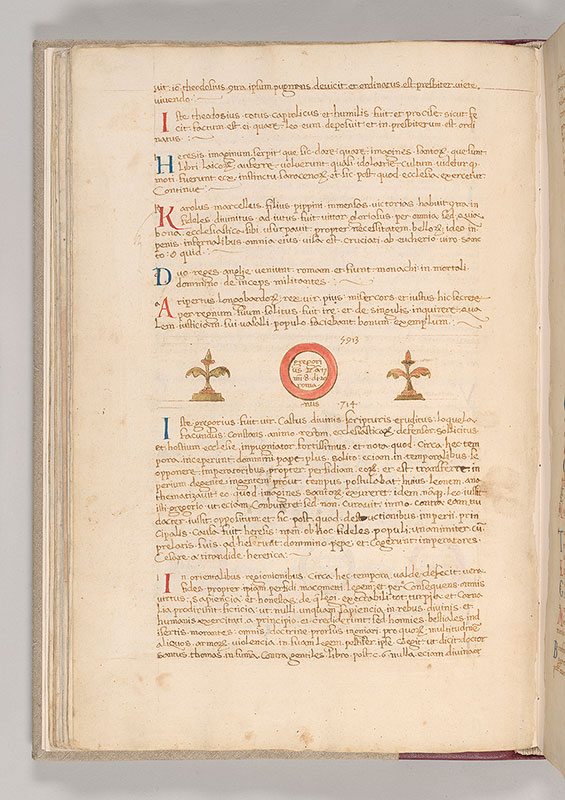
Fasciculus temporum
MS M.801, fol. 42r
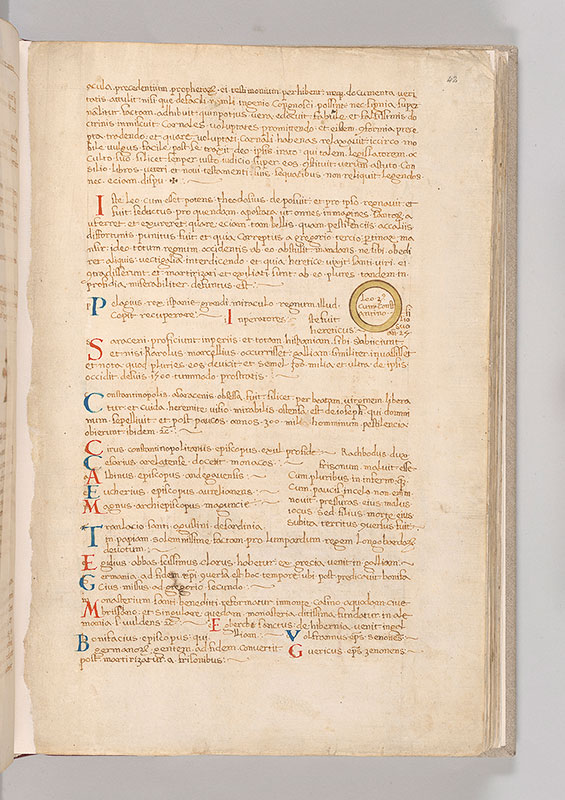
Fasciculus temporum
MS M.801, fol. 42v
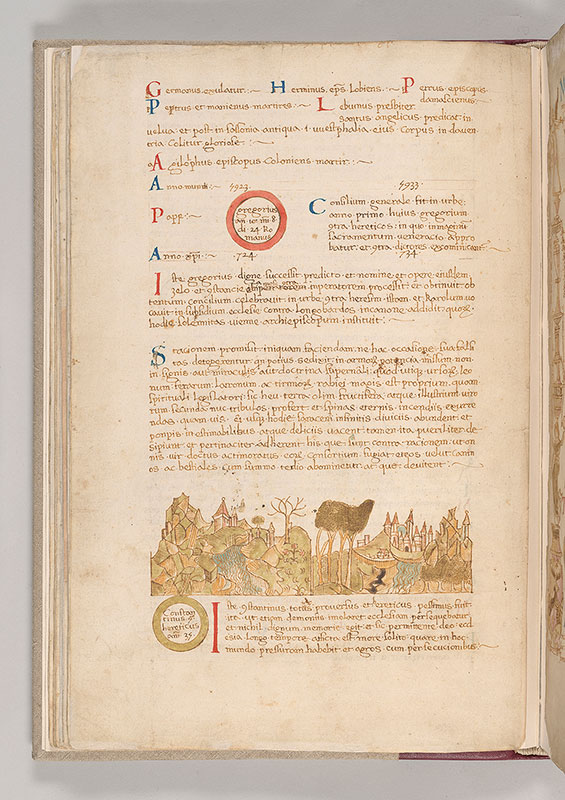
Fasciculus temporum
At left, city with few buildings and barren tree; at right city with leafy trees, many buildings.
MS M.801, fol. 43r
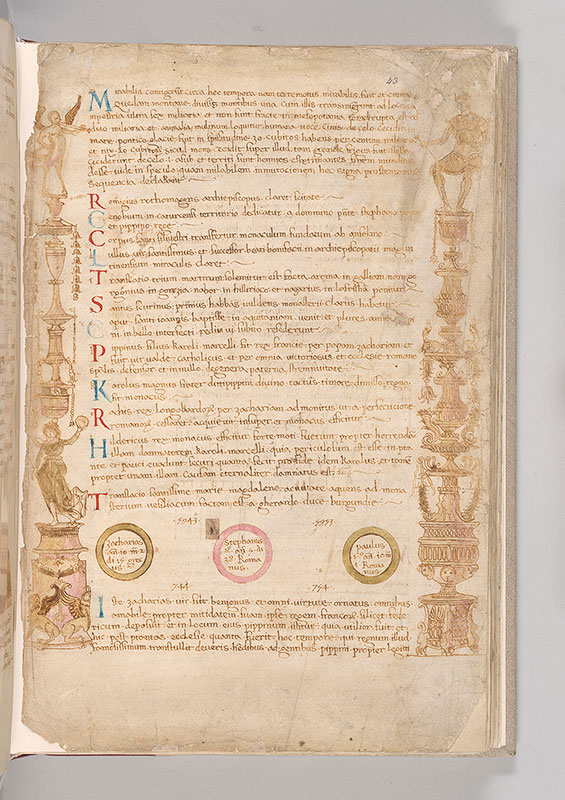
Fasciculus temporum
In left margin, hybrid winged man playing trumpet, standing on vase atop other vases or urns, from which garlands hang. At bottom, woman as atlante, raising round object with left hand, standing on pediment decorated with winged lions, possibly griffins.
In right margin, soldier, wearing crown or wreath and armor, holding scepter with right hand, crouching on vase atop other vases or urns decorated with garlands, fantastic animals, cornucopia; one vessel decorated with three heads or masks.
MS M.801, fol. 43v
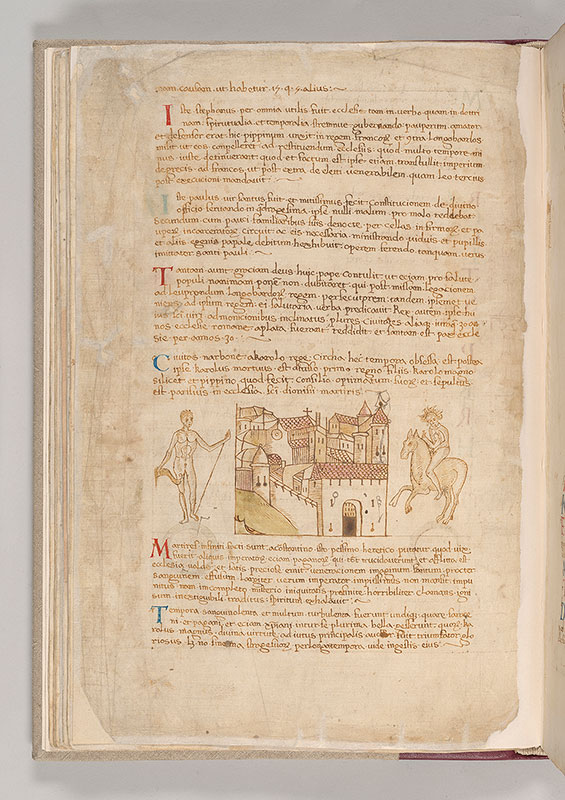
Fasciculus temporum
Narbonne as buildings, including church (?), surmounted by cross, enclosed within wall, with large tower with portal. All flanked by two nude men, one standing holding scroll with right hand and staff with left hand; the other, with wild hair, wearing spurs, astride horse.
MS M.801, fol. 44r

Fasciculus temporum
At left, destroyed city, pieces on ground next to cannon balls, tops of towers falling. Center, army camp of seven striped tents surmounted by banners; in foreground cannon balls, war machine and cannon. At right, intact city among hills.
MS M.801, fol. 44v
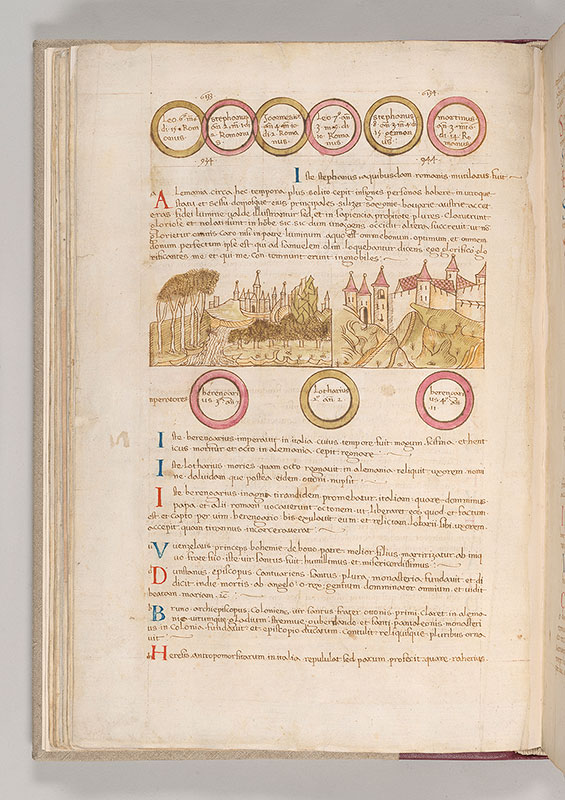
Fasciculus temporum
At left, city with many towers, next to stream; at right, city enclosed by walls.
MS M.801, fol. 45r
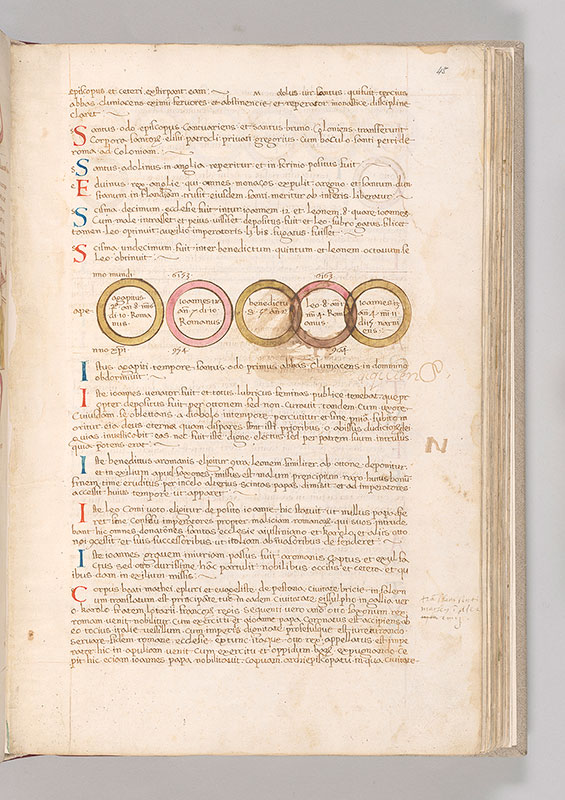
Fasciculus temporum
MS M.801, fol. 45v
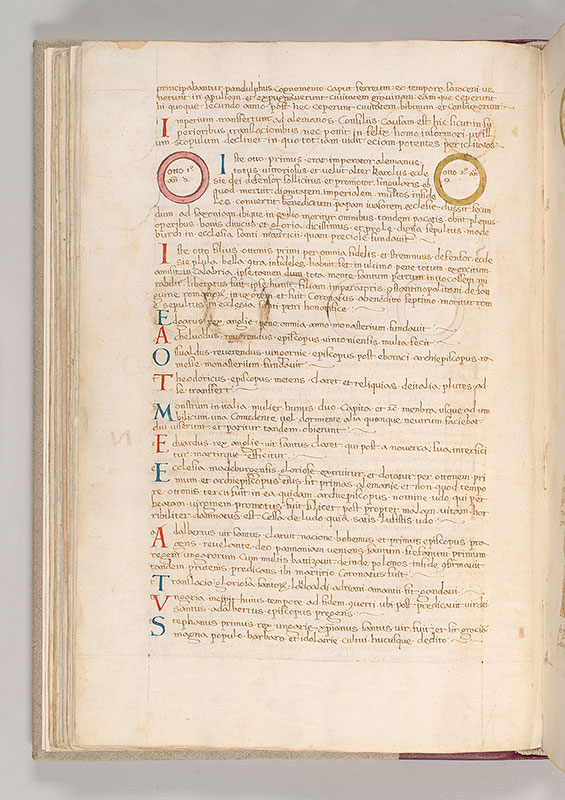
Fasciculus temporum
MS M.801, fol. 46r
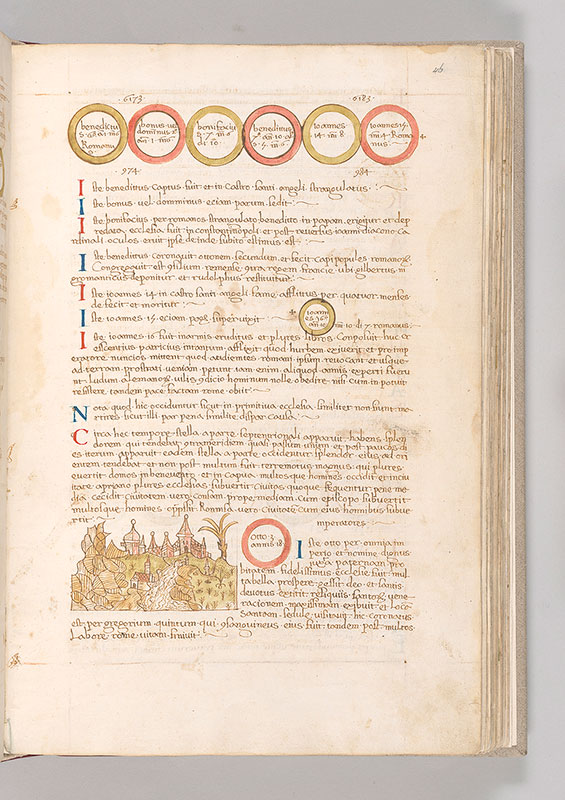
Fasciculus temporum
City of Hungary (?), with buildings enclosed within wall, including one with dome; church beside stream outside of the walls. Palm tree (?) at right.
MS M.801, fol. 46v
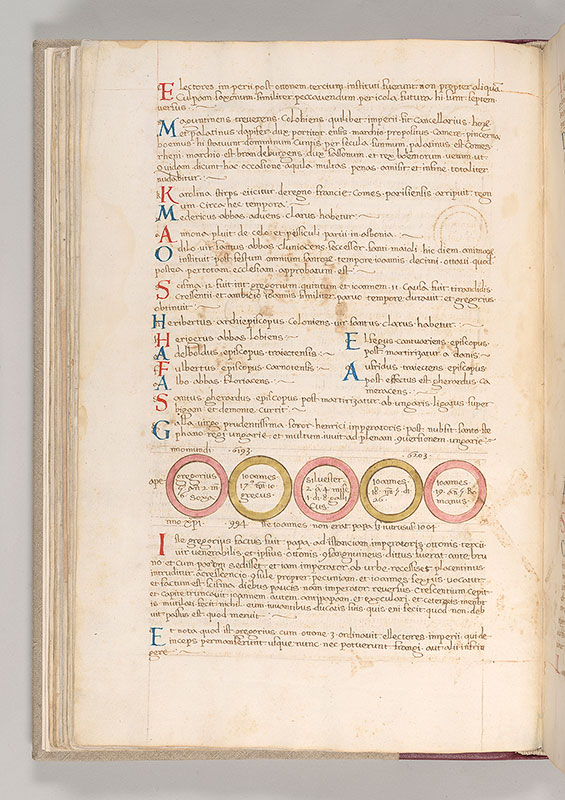
Fasciculus temporum
MS M.801, fol. 47r
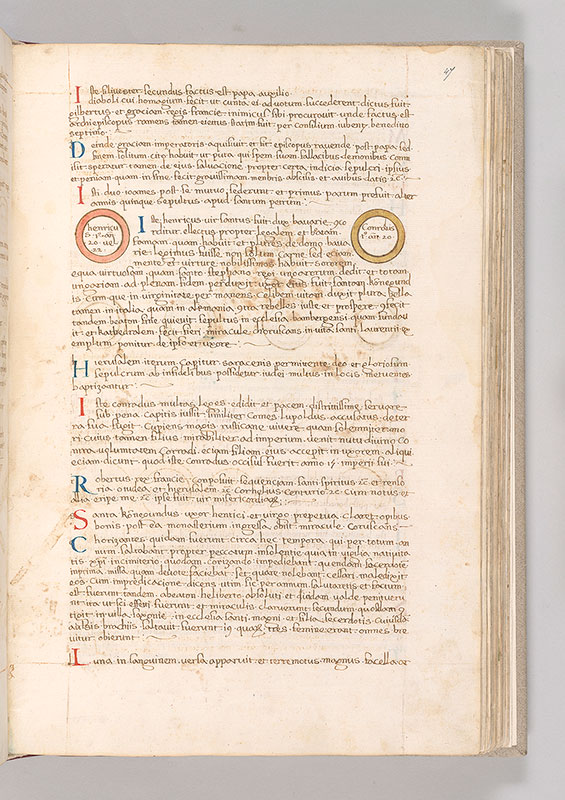
Fasciculus temporum
MS M.801, fol. 47v
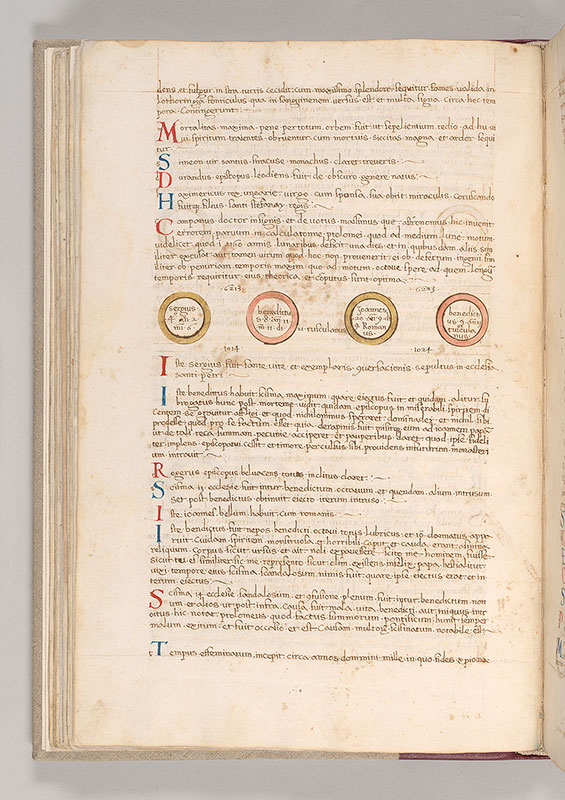
Fasciculus temporum
MS M.801, fol. 48r
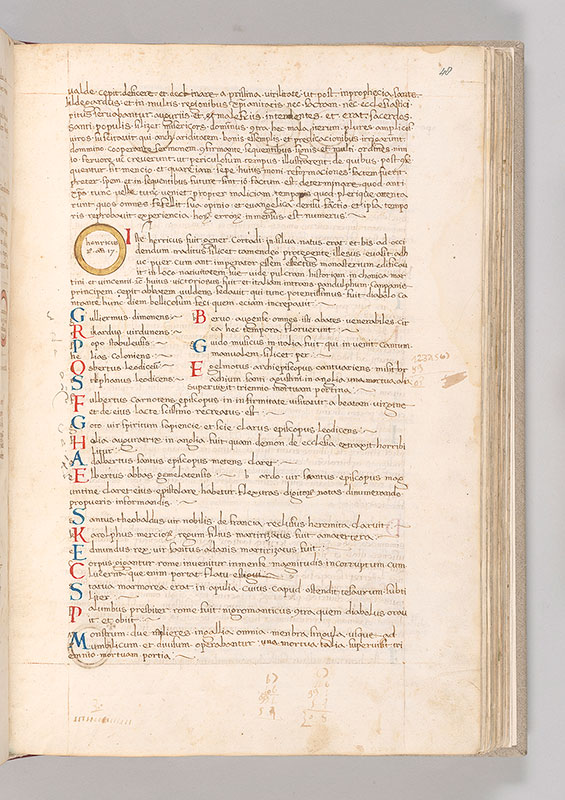
Fasciculus temporum
MS M.801, fol. 48v
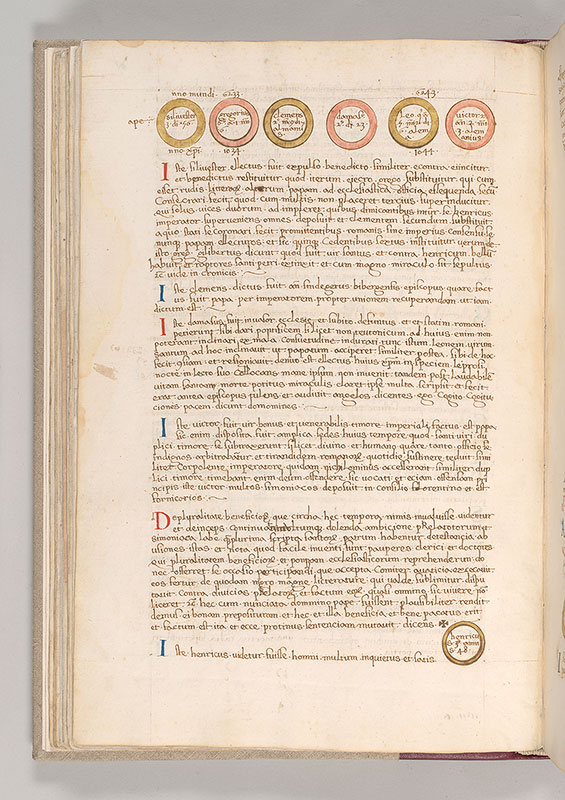
Fasciculus temporum
MS M.801, fol. 49r
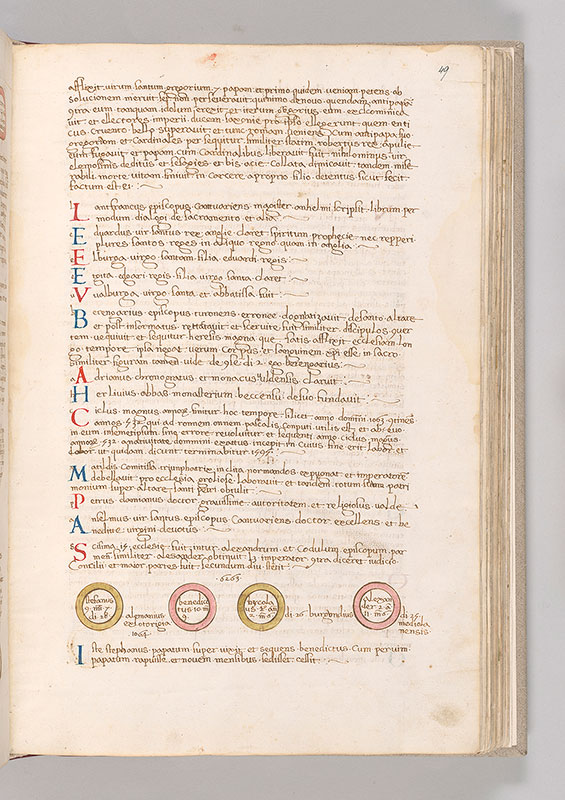
Fasciculus temporum
MS M.801, fol. 49v
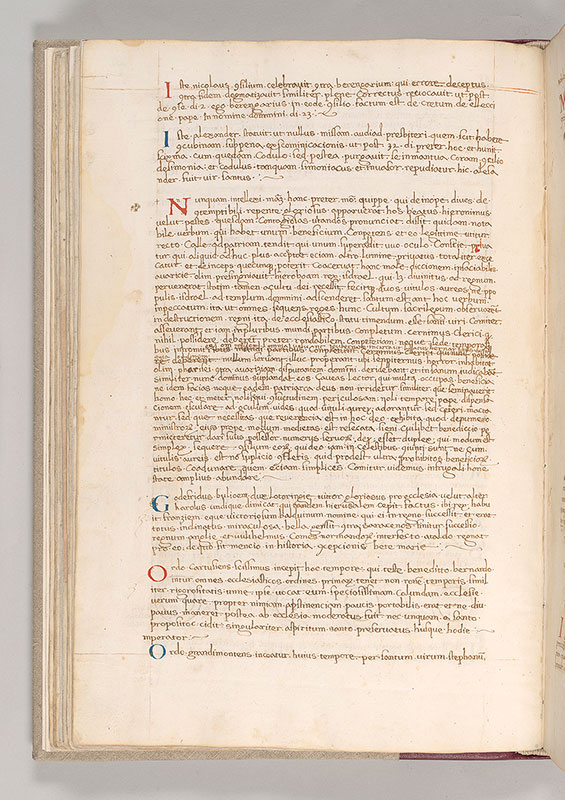
Fasciculus temporum
MS M.801, fol. 50r
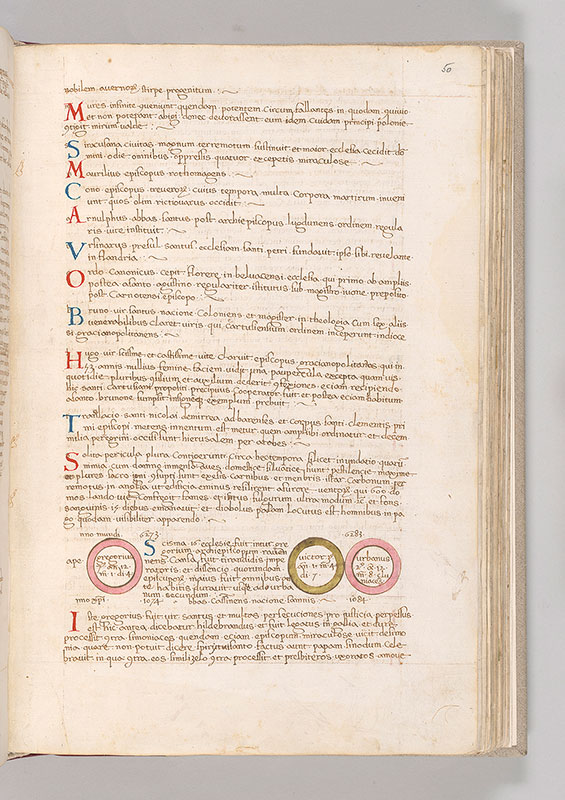
Fasciculus temporum
MS M.801, fol. 50v
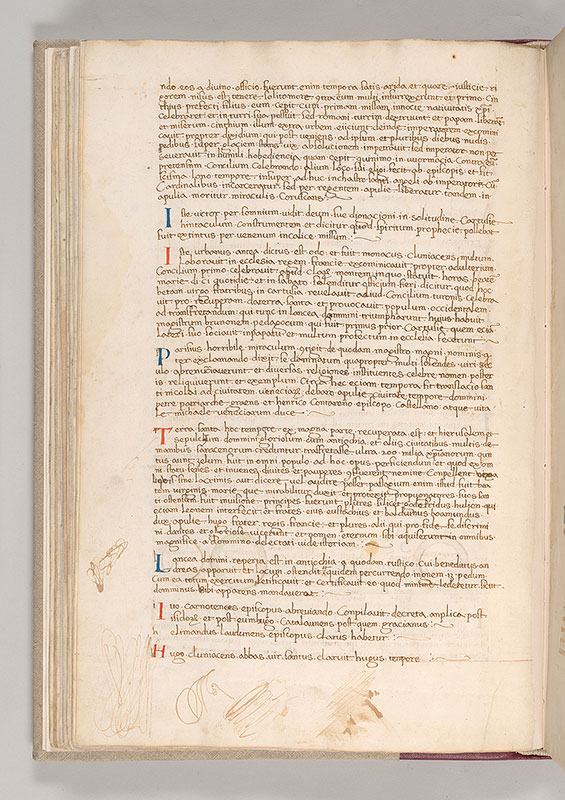
Fasciculus temporum
MS M.801, fol. 51r
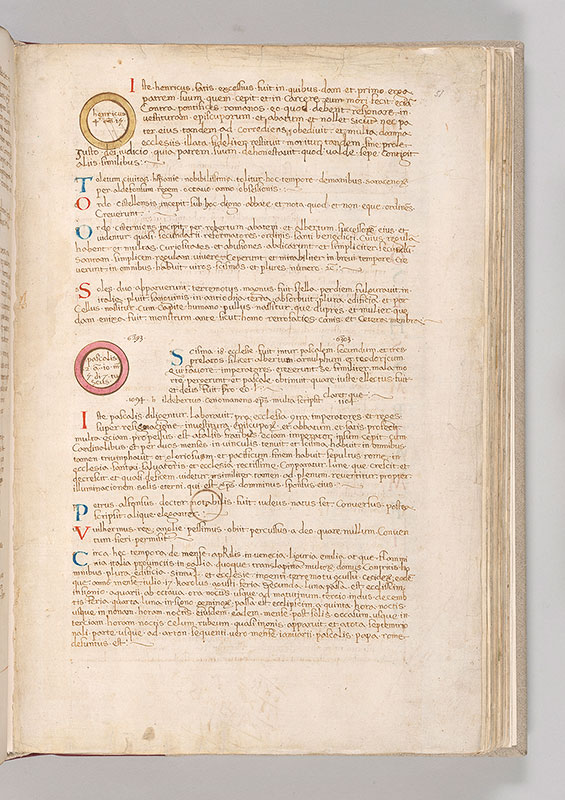
Fasciculus temporum
MS M.801, fol. 51v
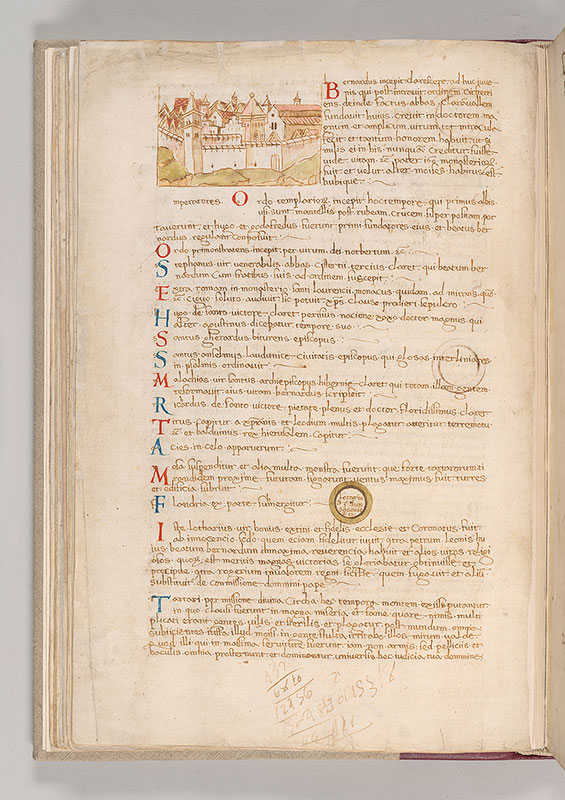
Fasciculus temporum
City or monastery enclosed within crenellated walls with portal.
Cronaca di Partenope, MS M.801, fol. 52r
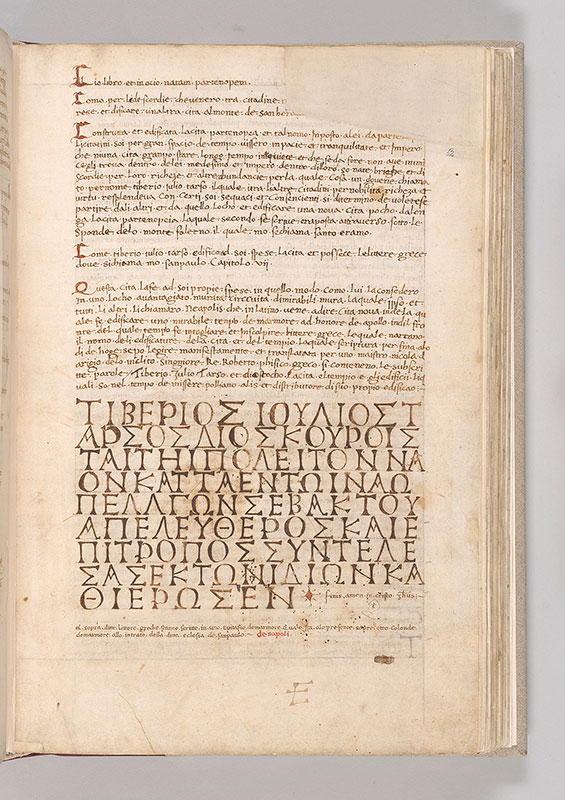
Fasciculus temporum
MS M.801, fol. 52v
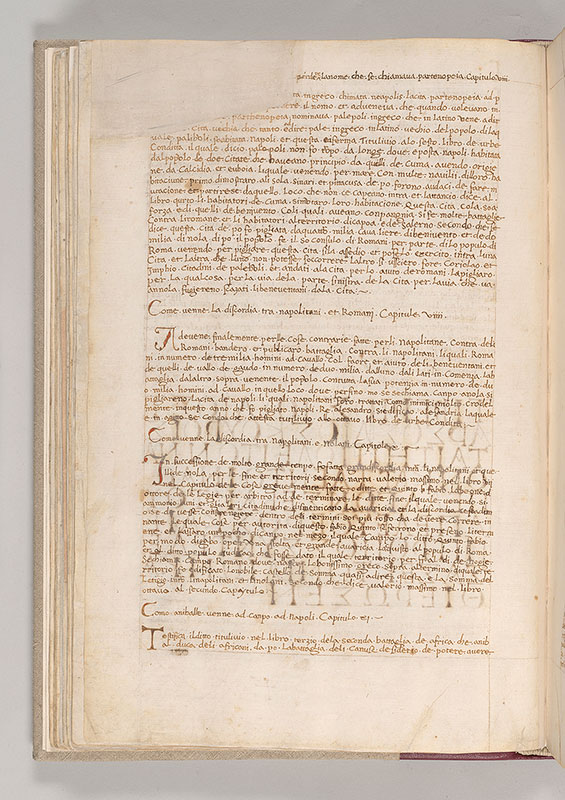
Fasciculus temporum
MS M.801, fol. 53r
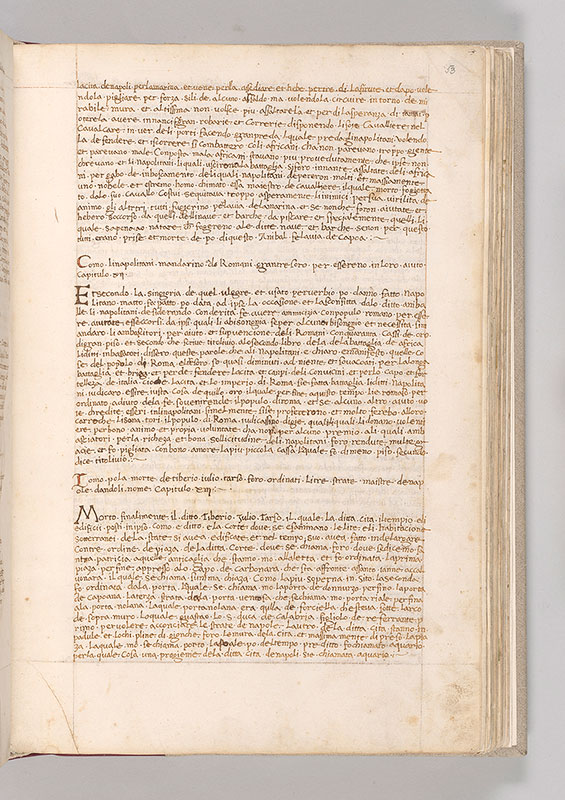
Fasciculus temporum
MS M.801, fol. 53v
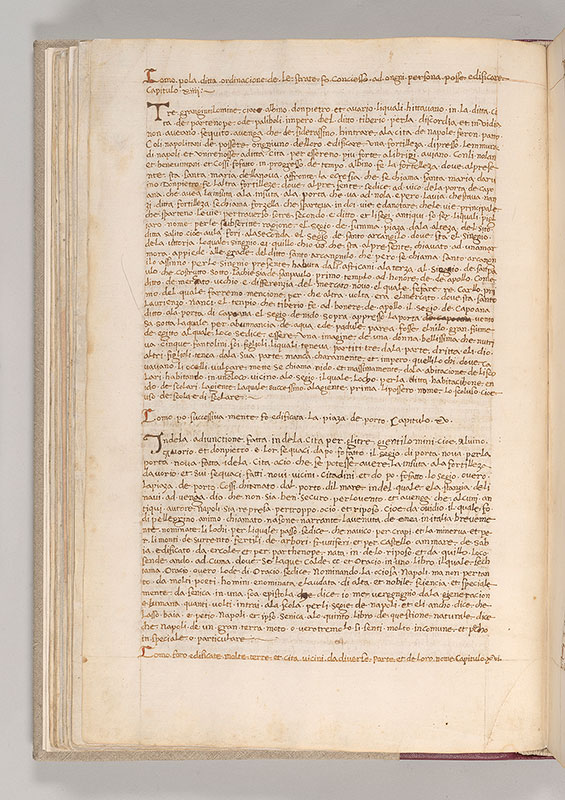
Fasciculus temporum
MS M.801, fol. 54r
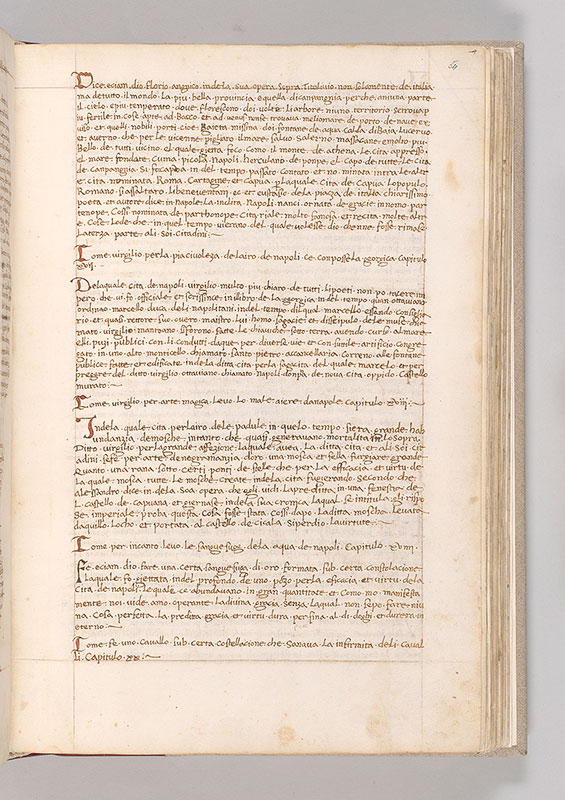
Fasciculus temporum
MS M.801, fol. 54v
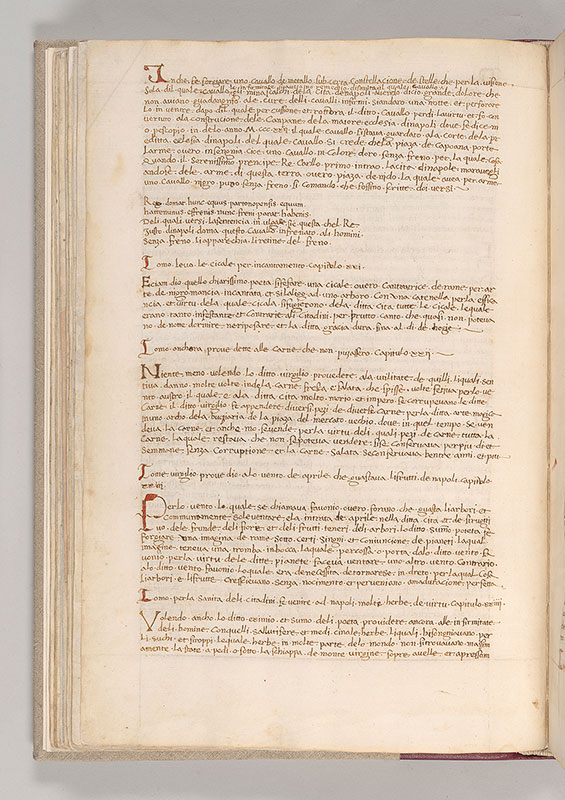
Fasciculus temporum
MS M.801, fol. 55r
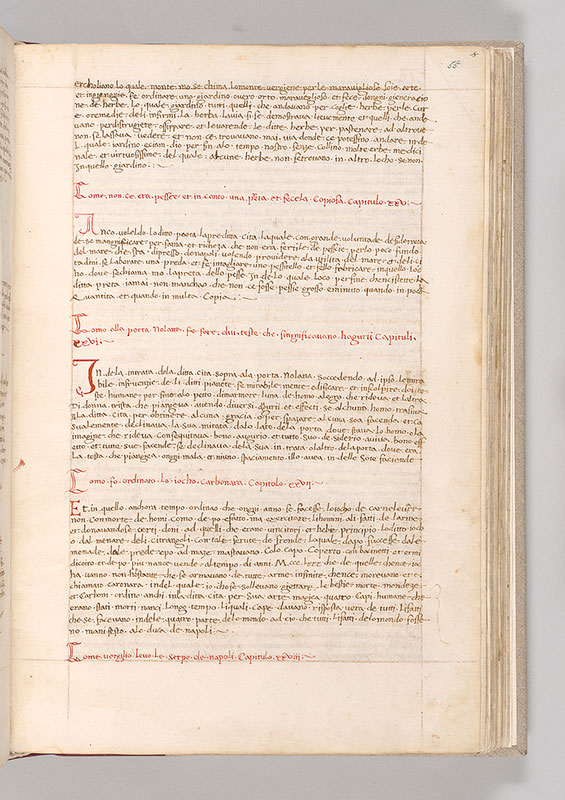
Fasciculus temporum
MS M.801, fol. 55v
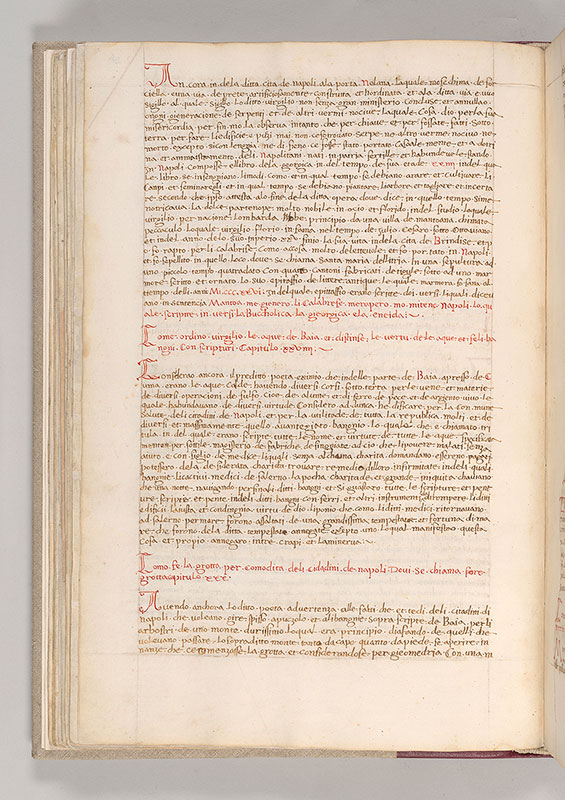
Fasciculus temporum
MS M.801, fol. 56r
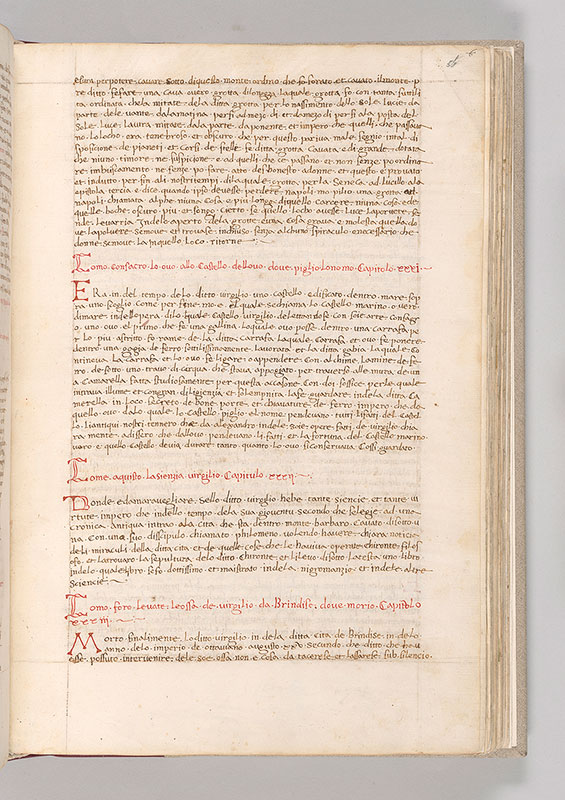
Fasciculus temporum
MS M.801, fol. 56v
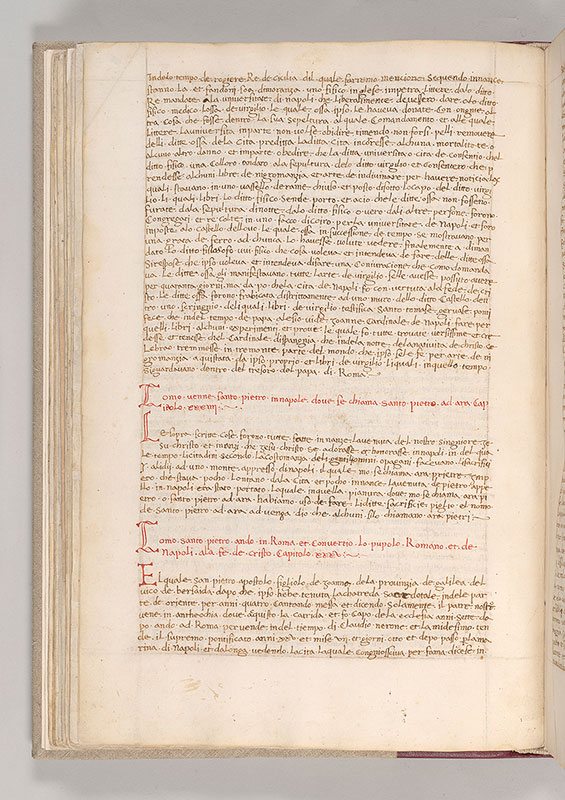
Fasciculus temporum
MS M.801, fol. 57r
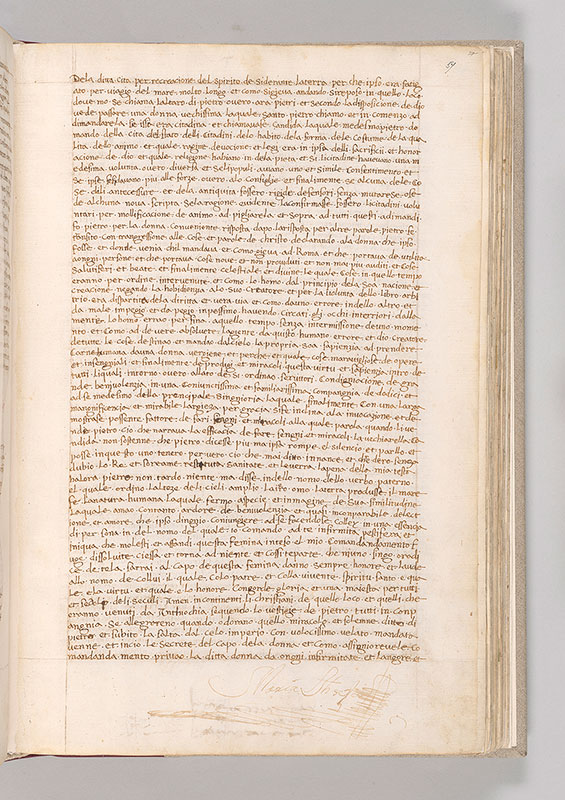
Fasciculus temporum
MS M.801, fol. 57v
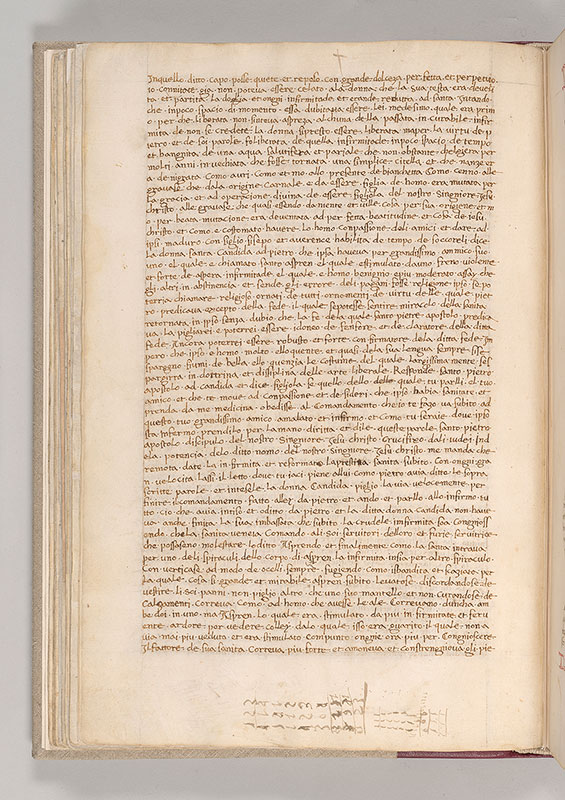
Fasciculus temporum
MS M.801, fol. 58r
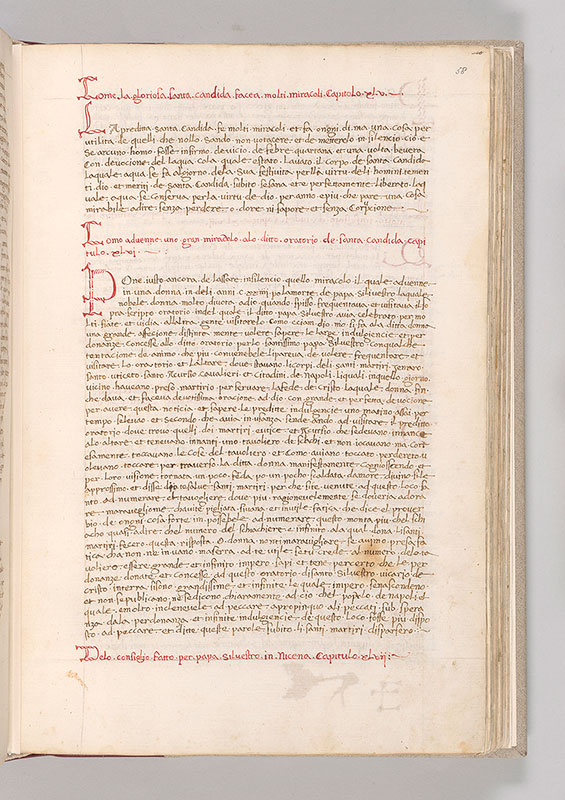
Fasciculus temporum
MS M.801, fol. 58v
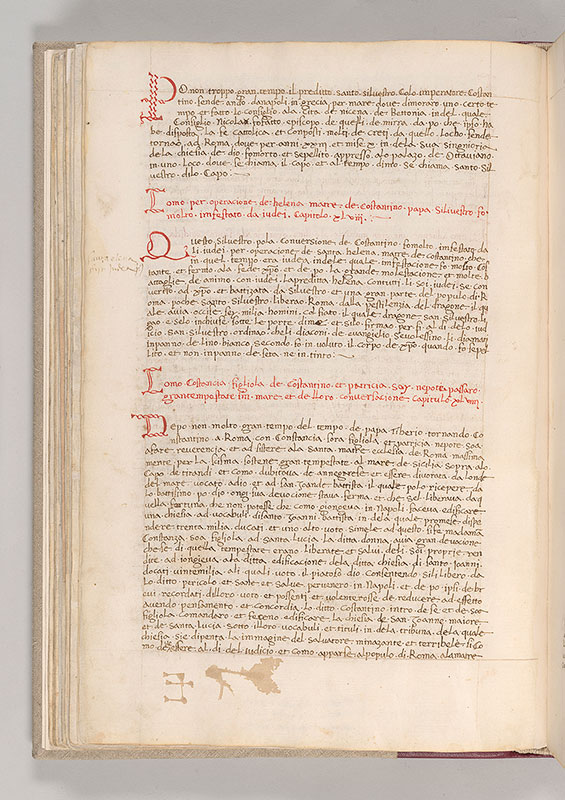
Fasciculus temporum
MS M.801, fol. 59r
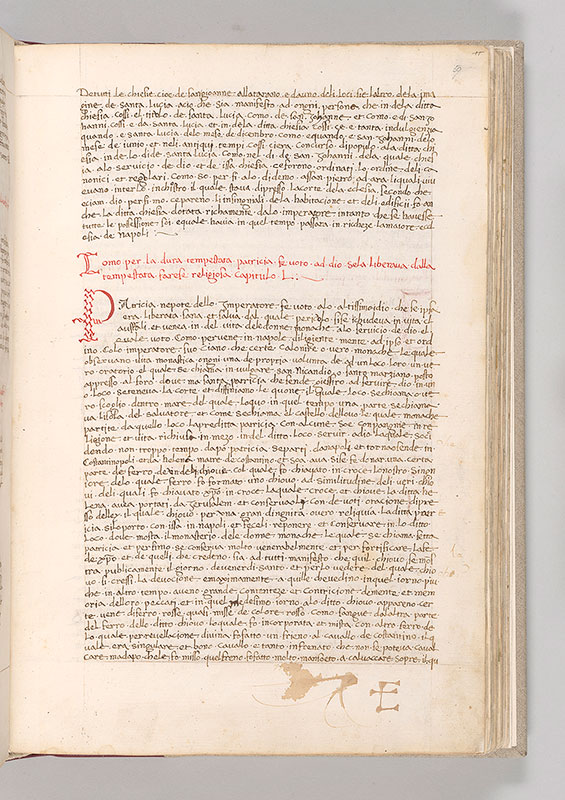
Fasciculus temporum
MS M.801, fol. 59v
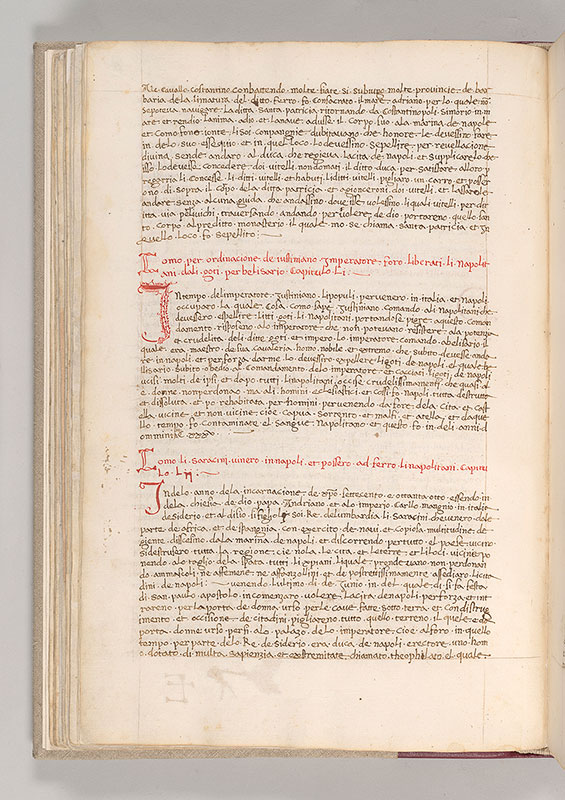
Fasciculus temporum
MS M.801, fol. 60r.
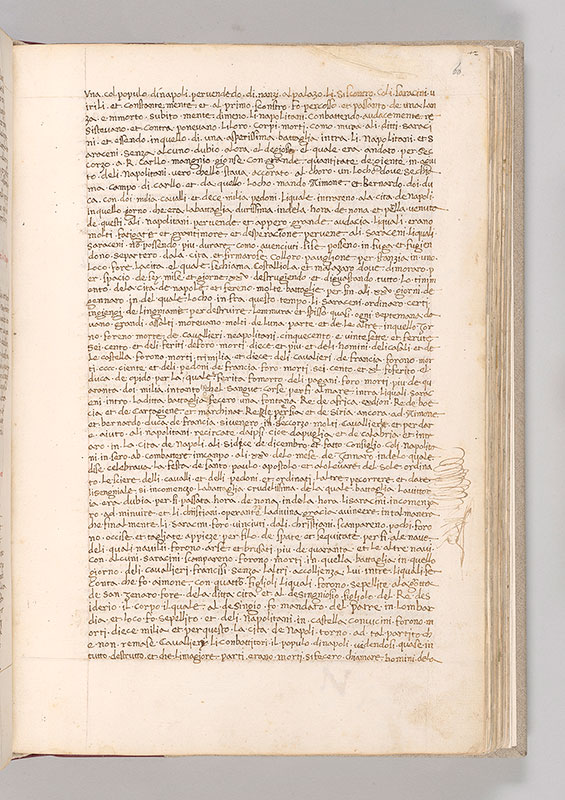
Fasciculus temporum
MS M.801, fol. 60v
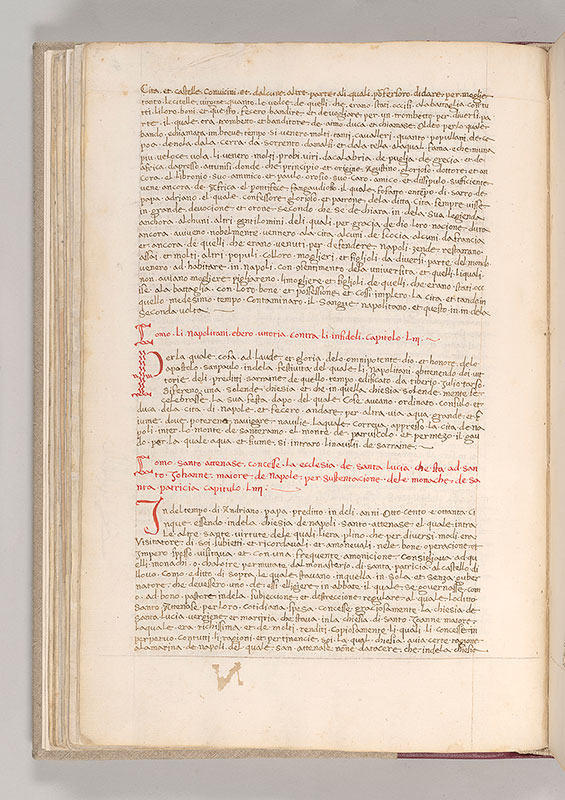
Fasciculus temporum
MS M.801, fol. 61r
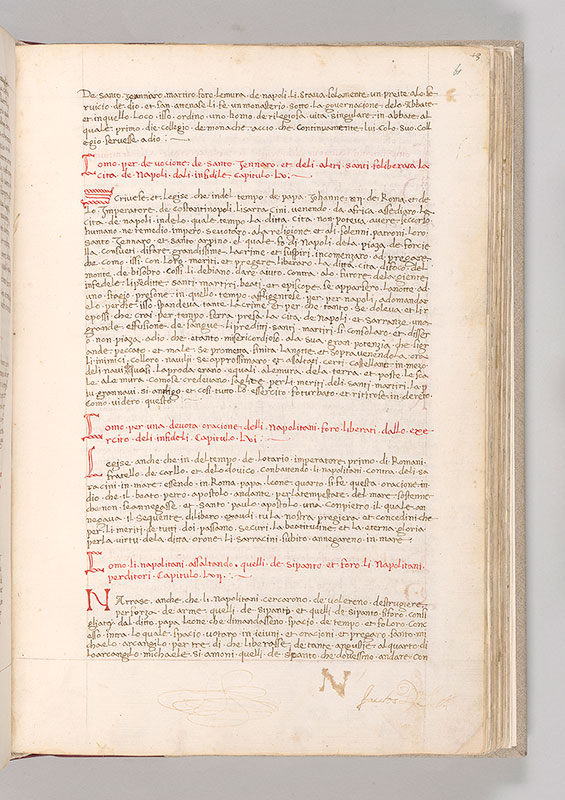
Fasciculus temporum
MS M.801, fol. 61v
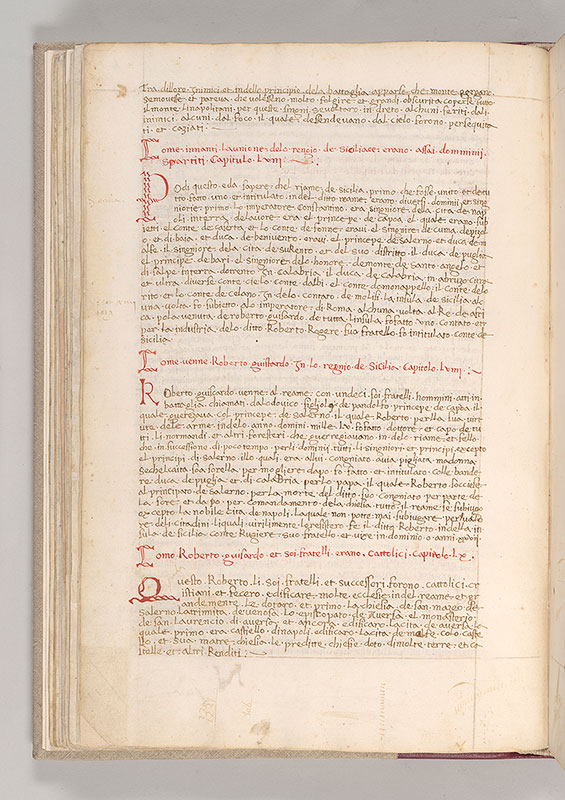
Fasciculus temporum
MS M.801, fol. 62r
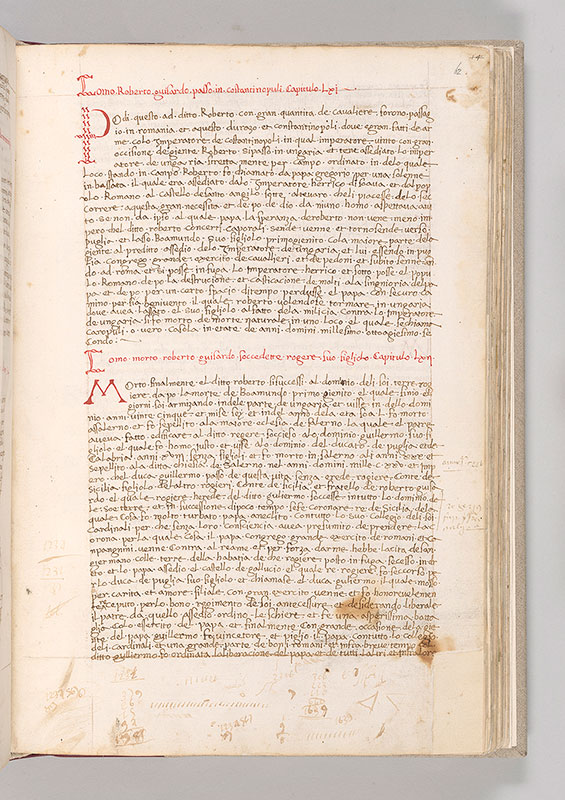
Fasciculus temporum
MS M.801, fol. 62v
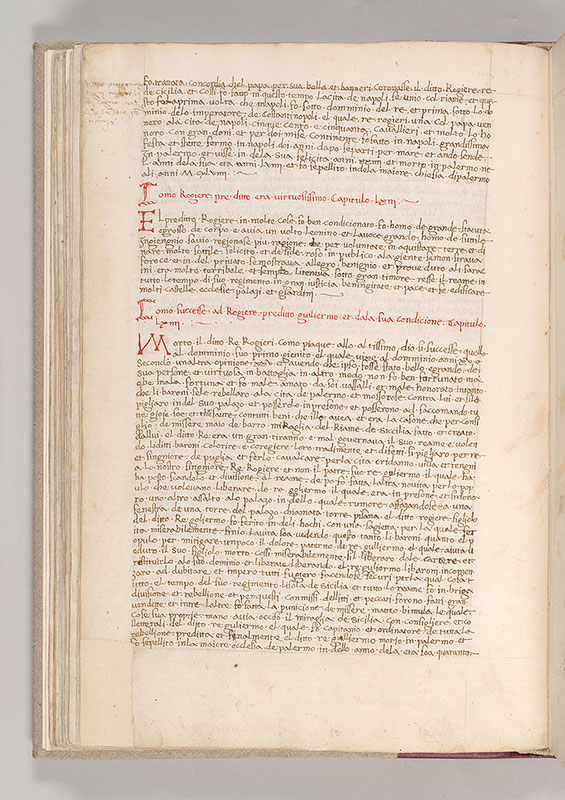
Fasciculus temporum
MS M.801, fol. 63r
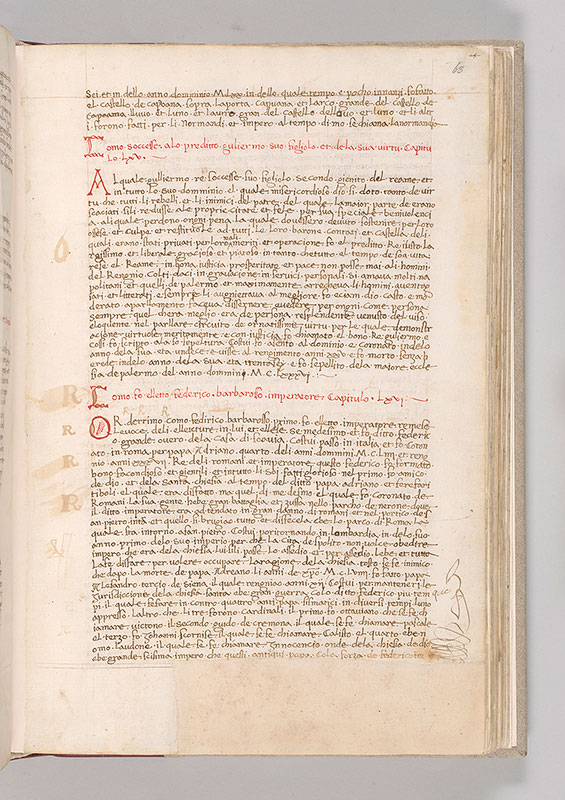
Fasciculus temporum
MS M.801, fol. 63v
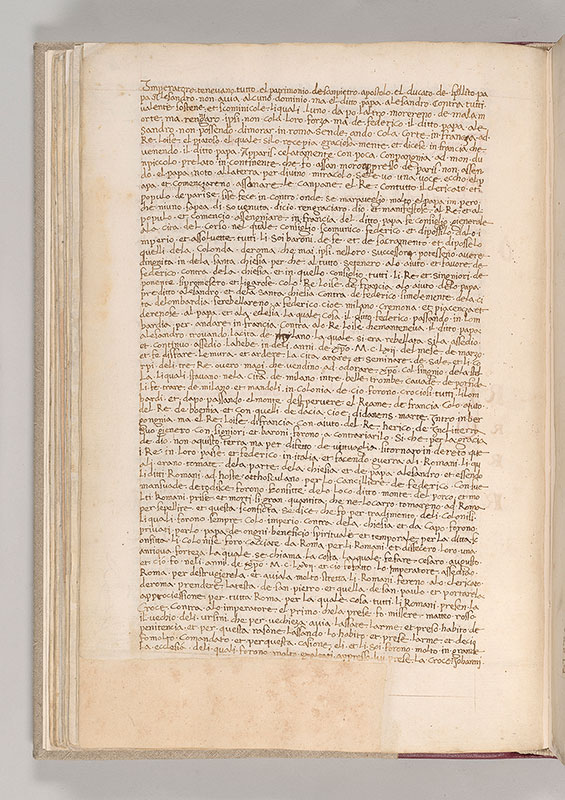
Fasciculus temporum
MS M.801, fol. 64r
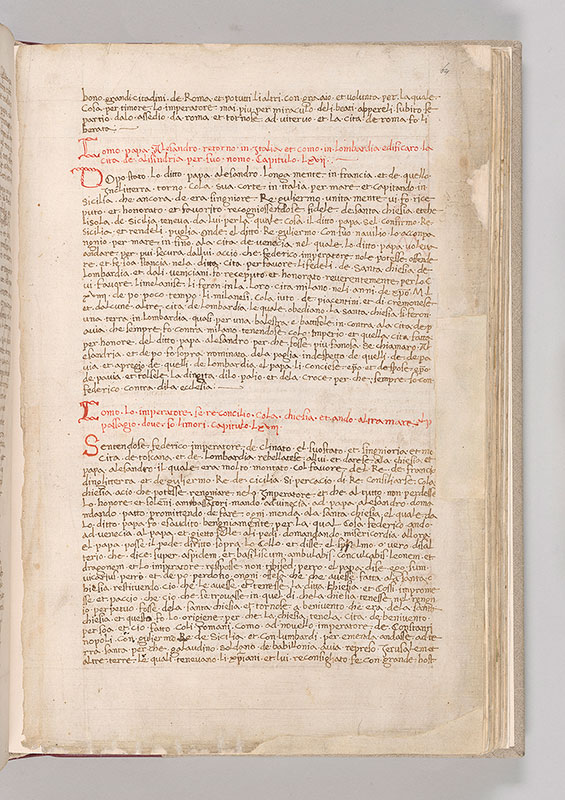
Fasciculus temporum
MS M.801, fol. 64v
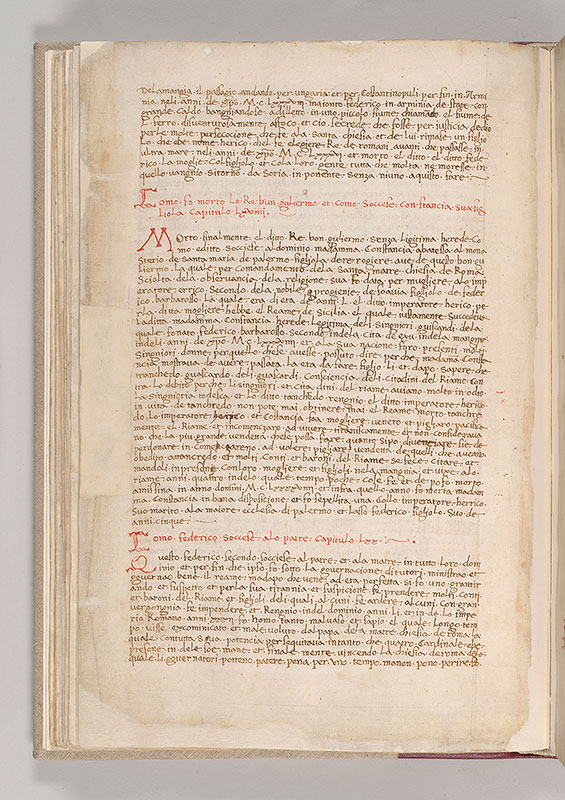
Fasciculus temporum
MS M.801, fol. 65r
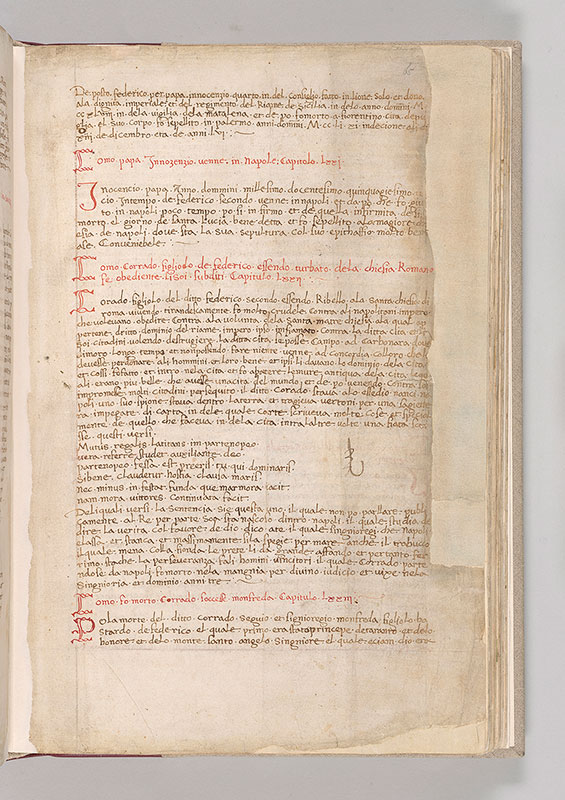
Fasciculus temporum
MS M.801, fol. 65v
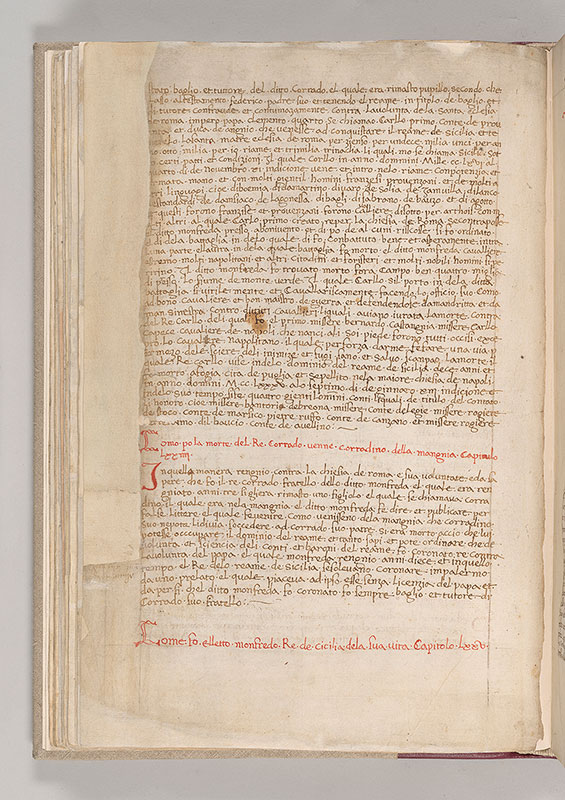
Fasciculus temporum
MS M.801, fol. 66r
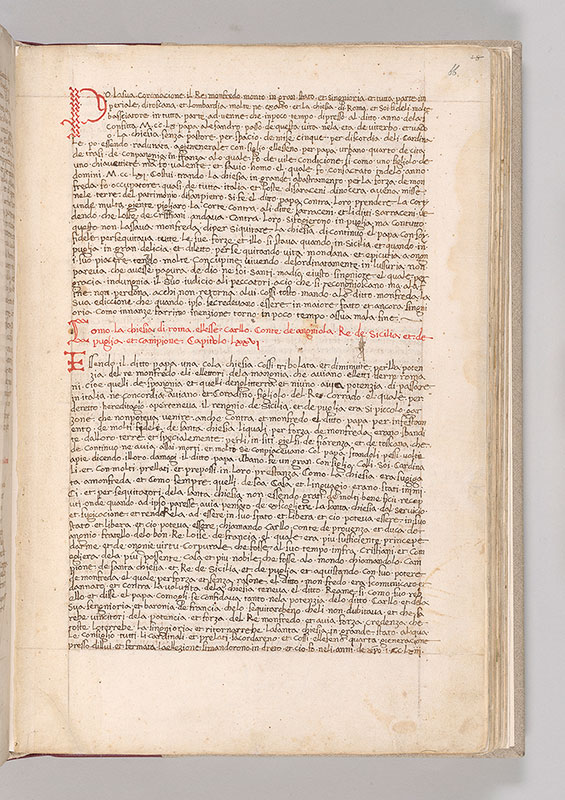
Fasciculus temporum
MS M.801, fol. 66v
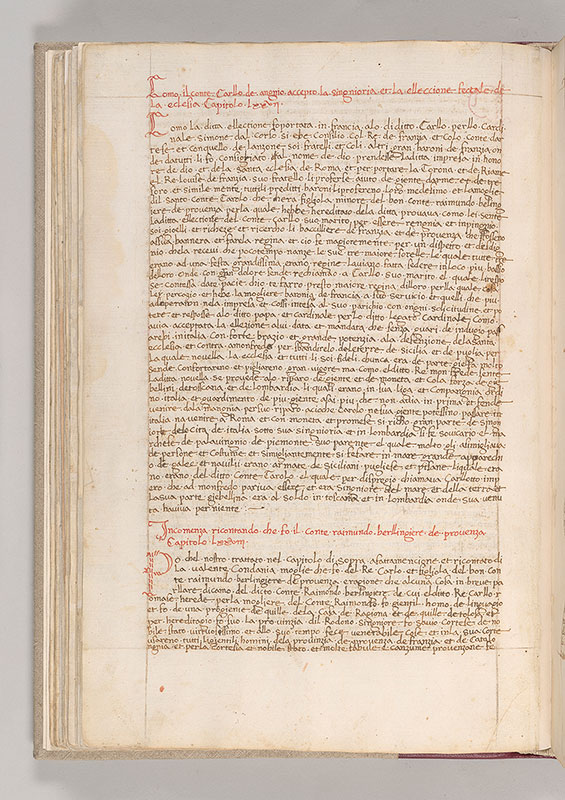
Fasciculus temporum
MS M.801, fol. 67r
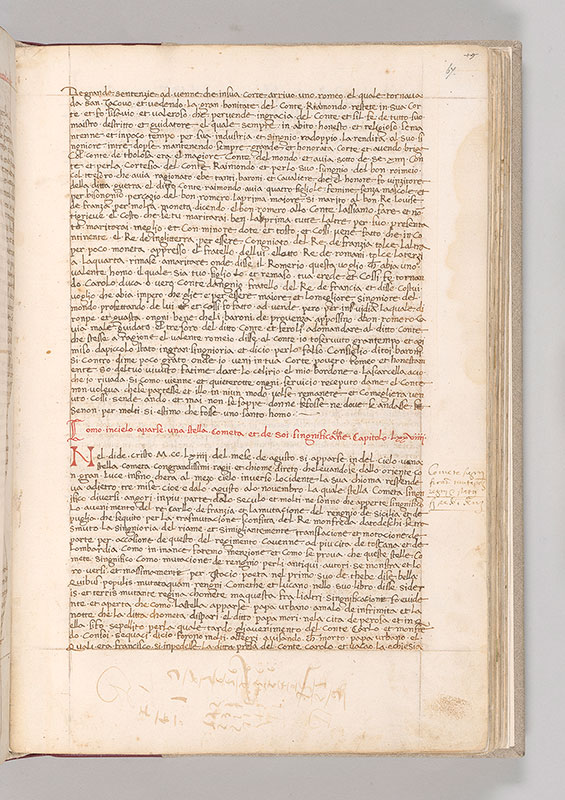
Fasciculus temporum
MS M.801, fol. 67v
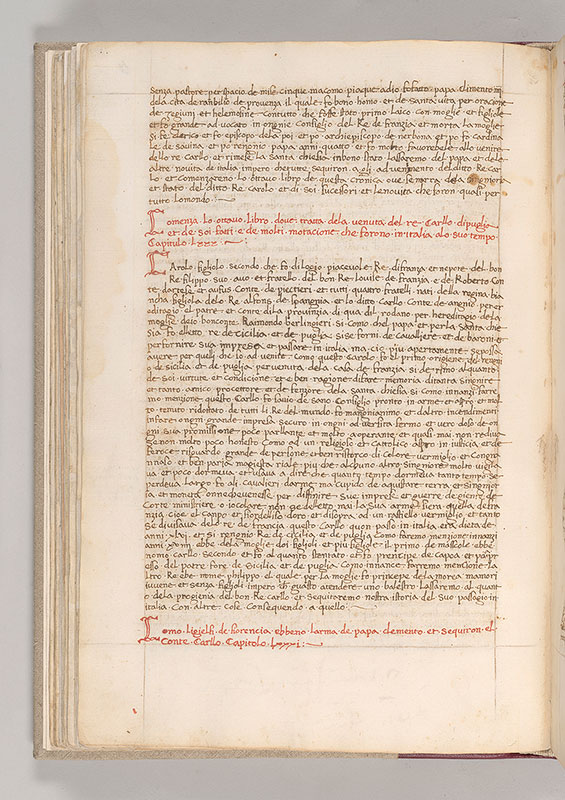
Fasciculus temporum
MS M.801, fol. 68r
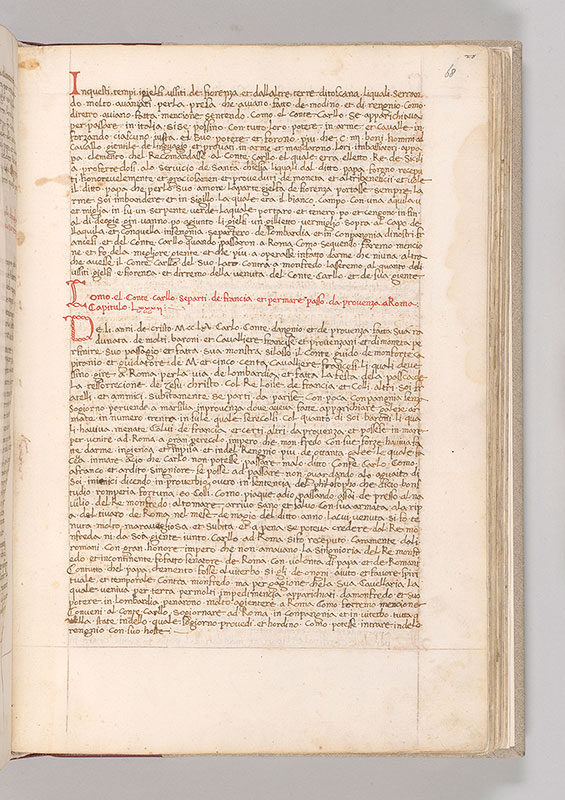
Fasciculus temporum
MS M.801, fol. 68v
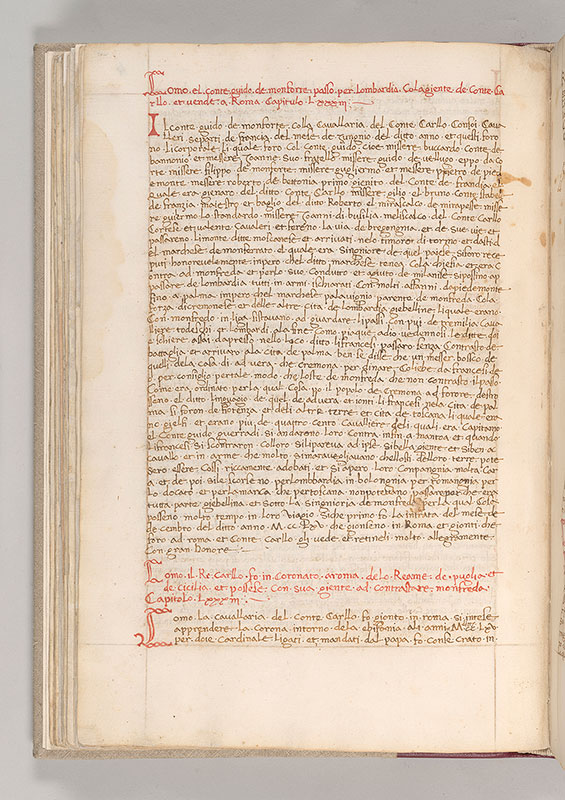
Fasciculus temporum
MS M.801, fol. 69r
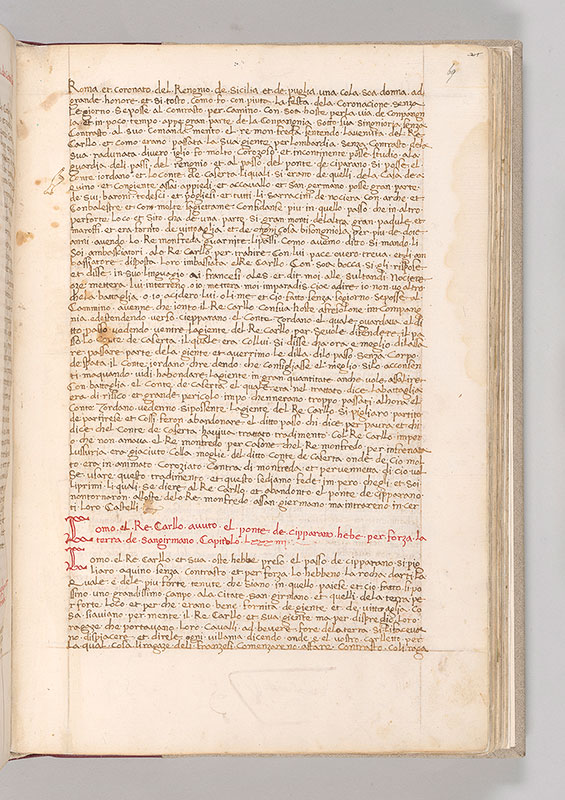
Fasciculus temporum
MS M.801, fol. 69v
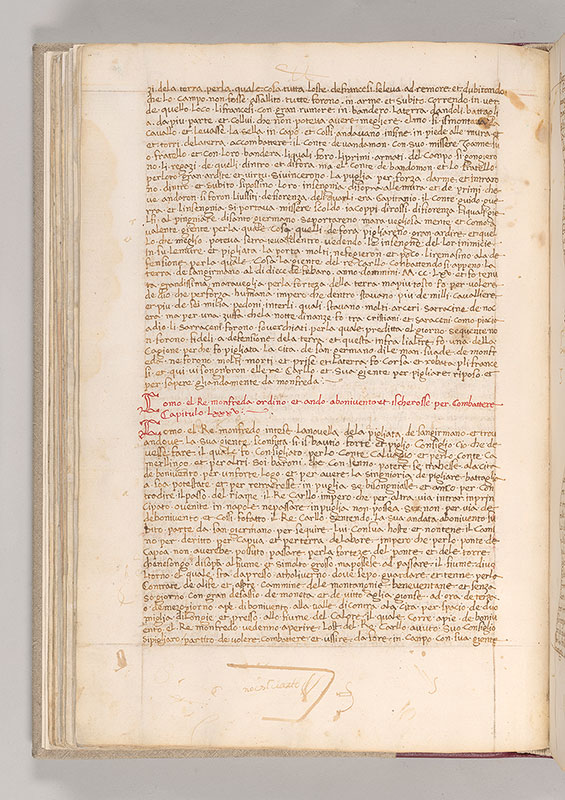
Fasciculus temporum
MS M.801, fol. 70r
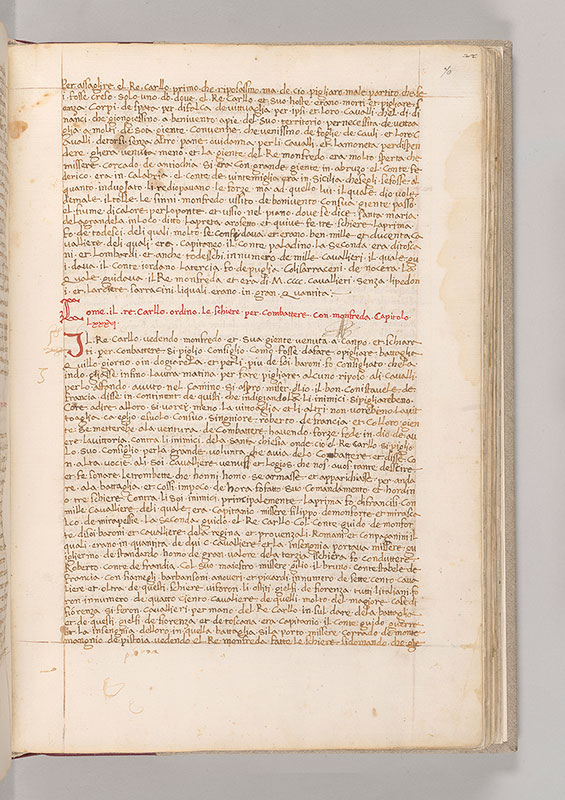
Fasciculus temporum
MS M.801, fol. 70v
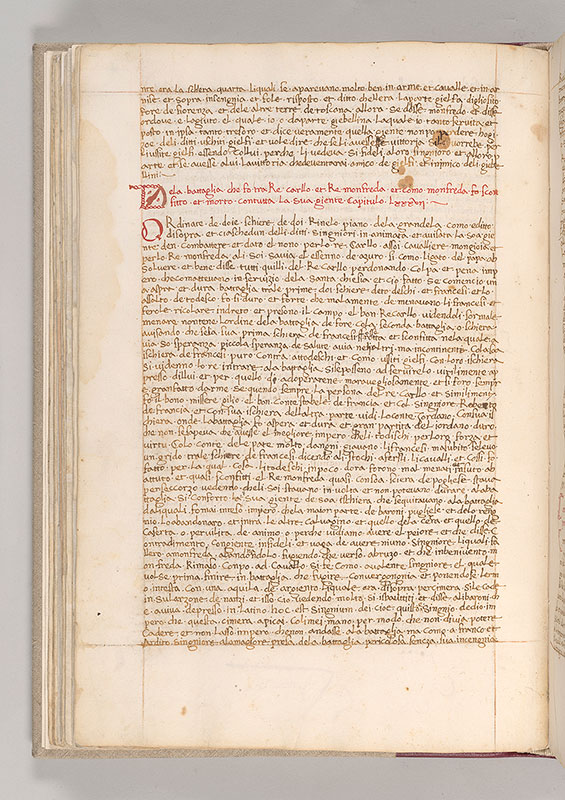
Fasciculus temporum
MS M.801, fol. 71r
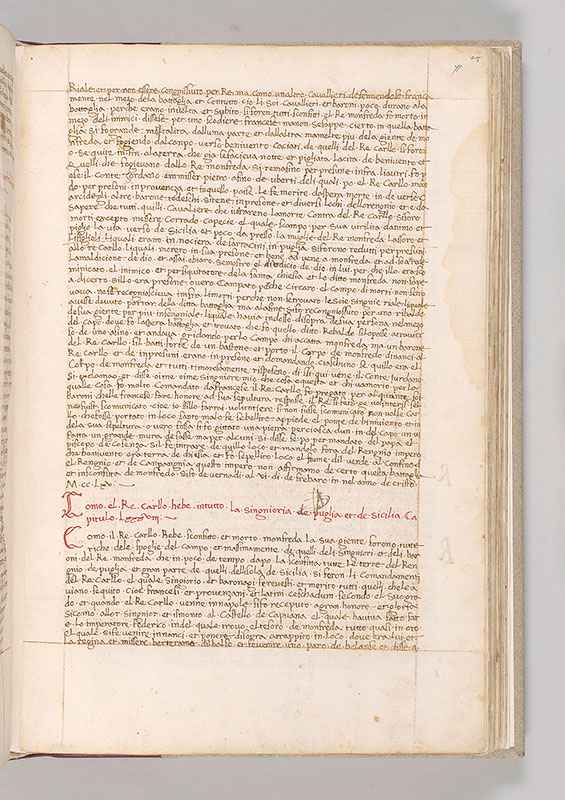
Fasciculus temporum
MS M.801, fol. 71v
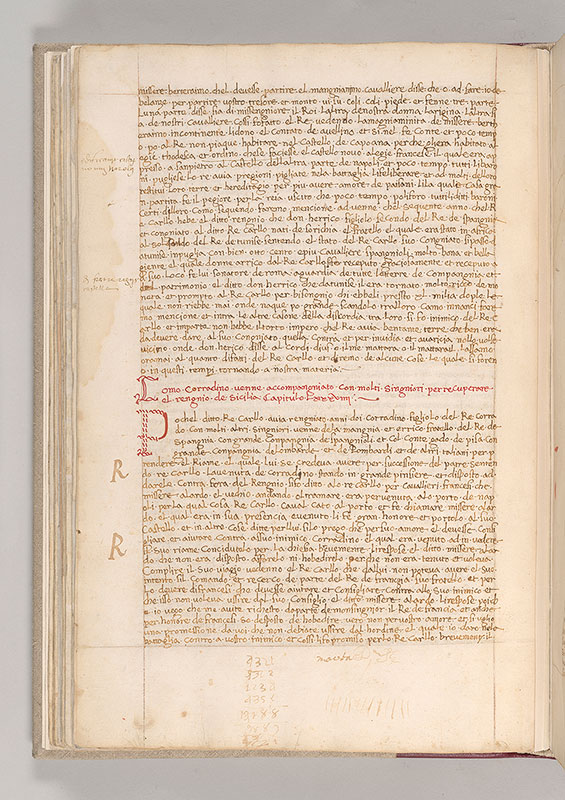
Fasciculus temporum
MS M.801, fol. 72r
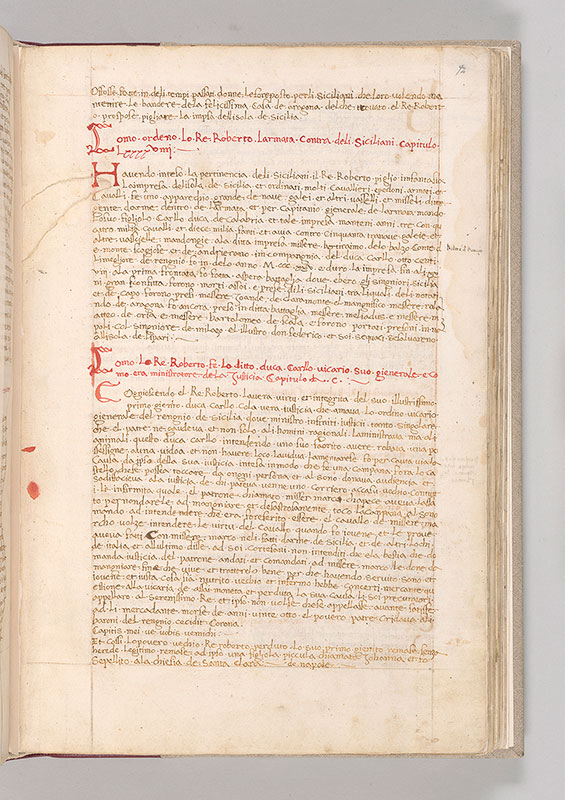
Fasciculus temporum
MS M.801, fol. 72v
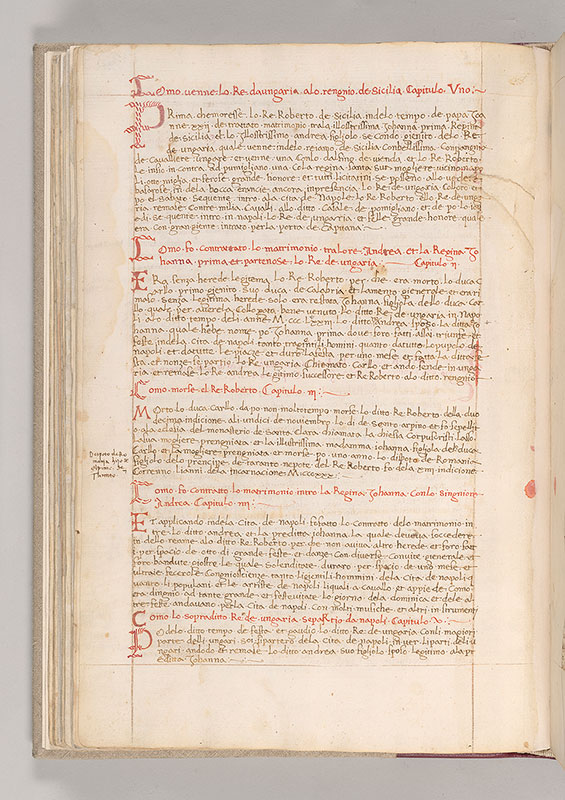
Fasciculus temporum
MS M.801, fol. 73r
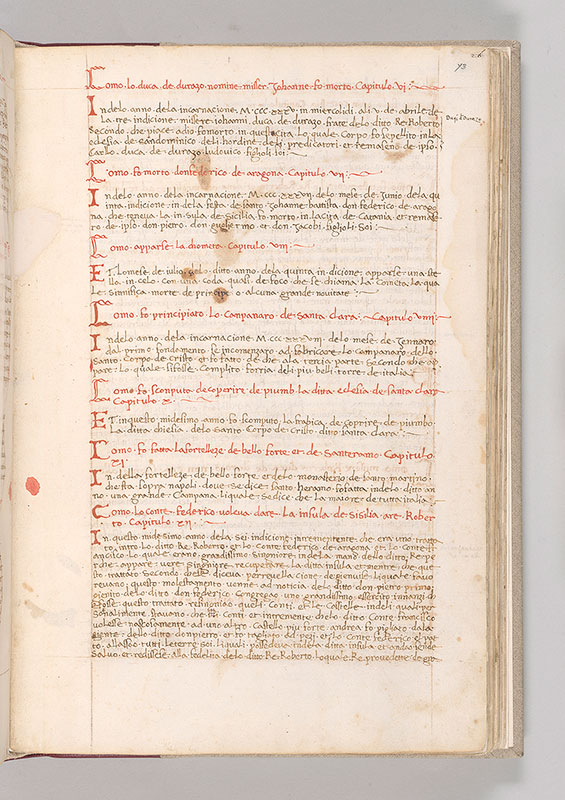
Fasciculus temporum
MS M.801, fol. 73v
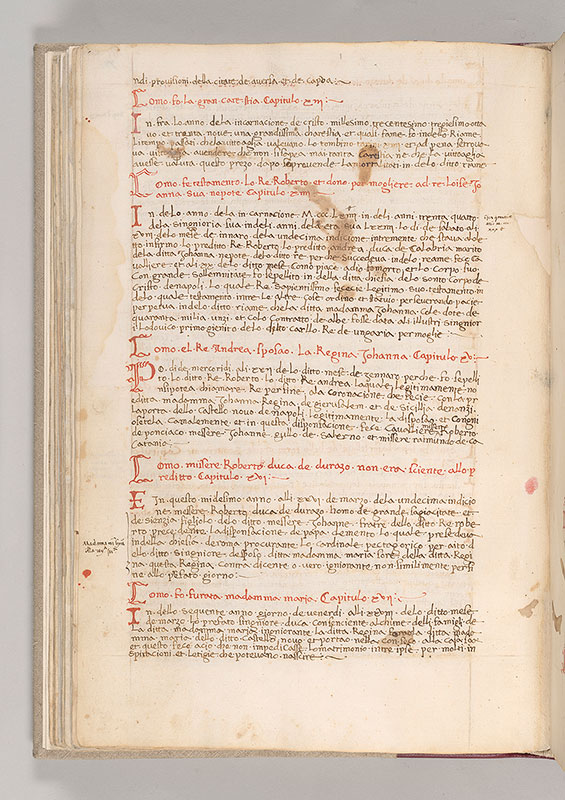
Fasciculus temporum
MS M.801, fol. 74r
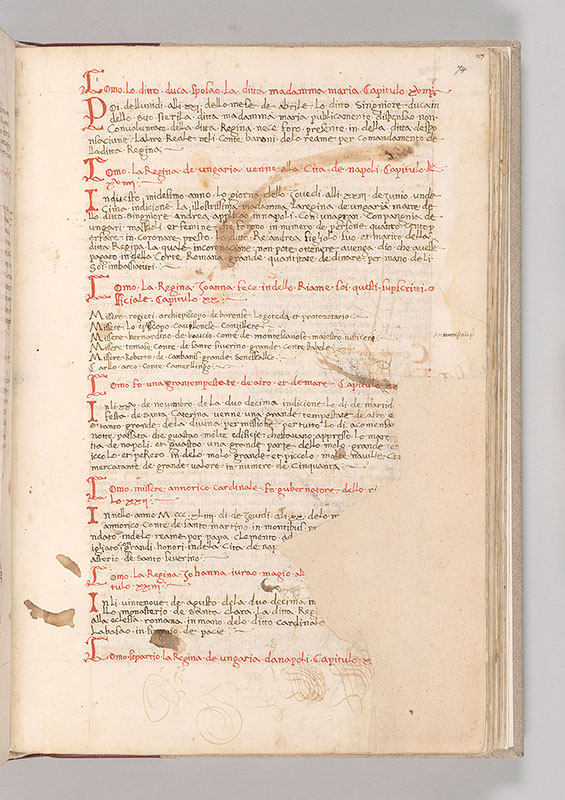
Fasciculus temporum
MS M.801, fol. 74v
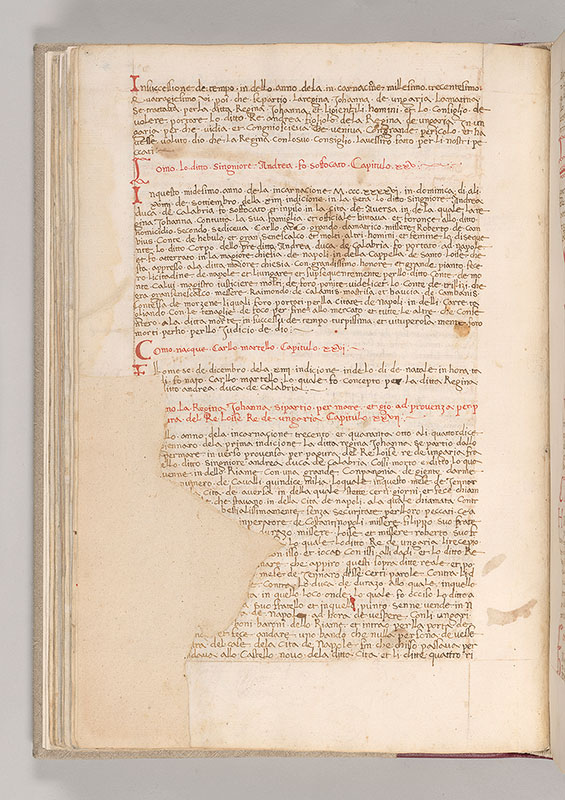
Fasciculus temporum
MS M.801, fol. 75r
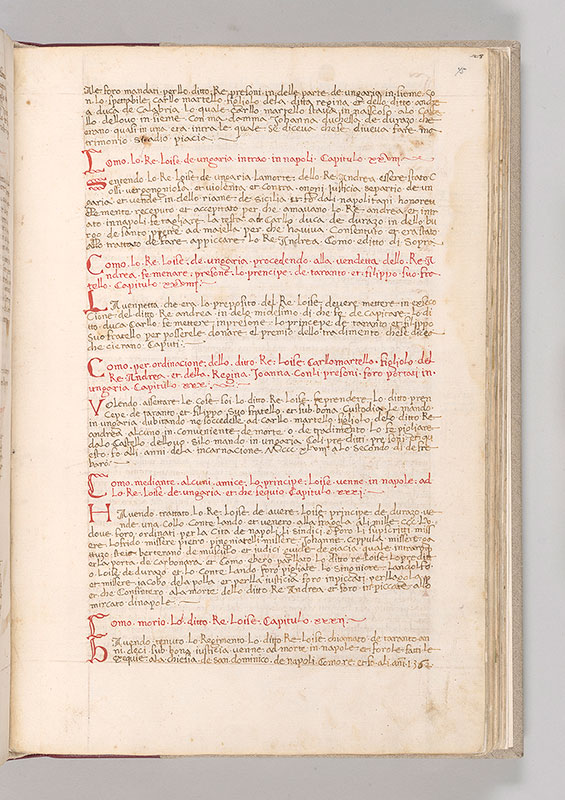
Fasciculus temporum
MS M.801, fol. 75v
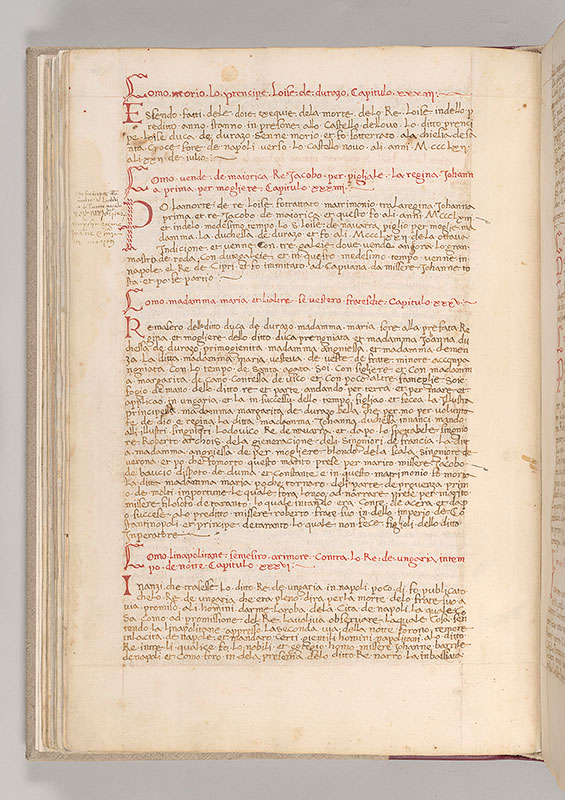
Fasciculus temporum
MS M.801, fol. 76r
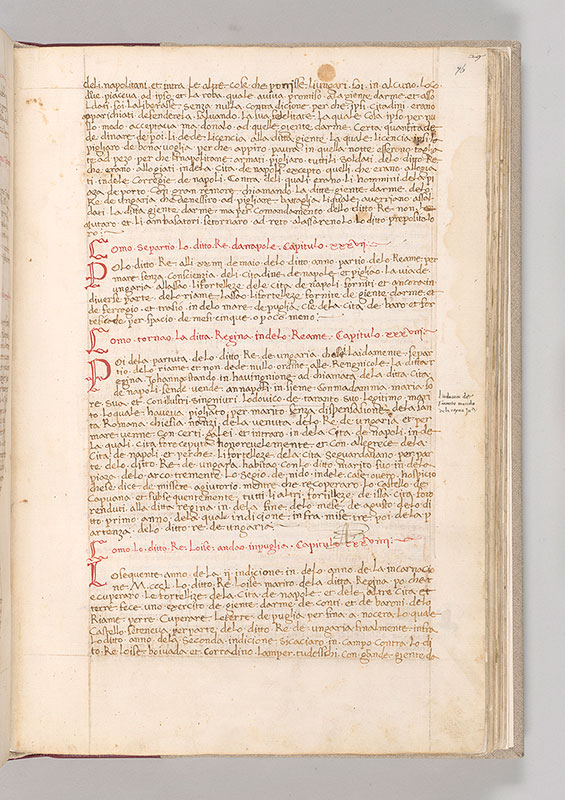
Fasciculus temporum
MS M.801, fol. 76v
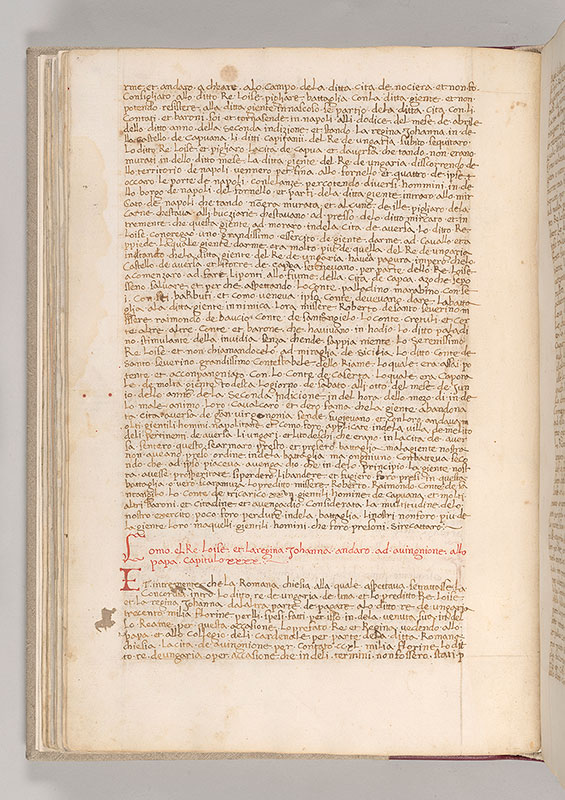
Fasciculus temporum
MS M.801, fol. 77r
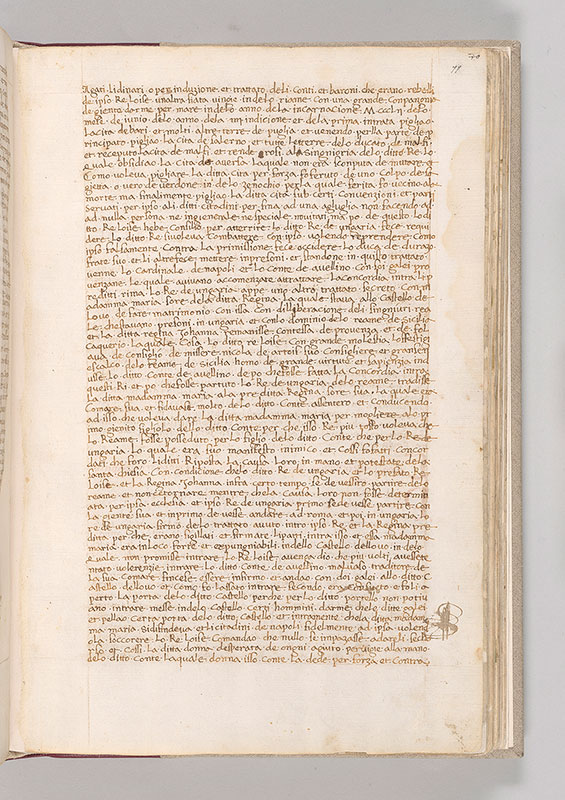
Fasciculus temporum
MS M.801, fol. 77v
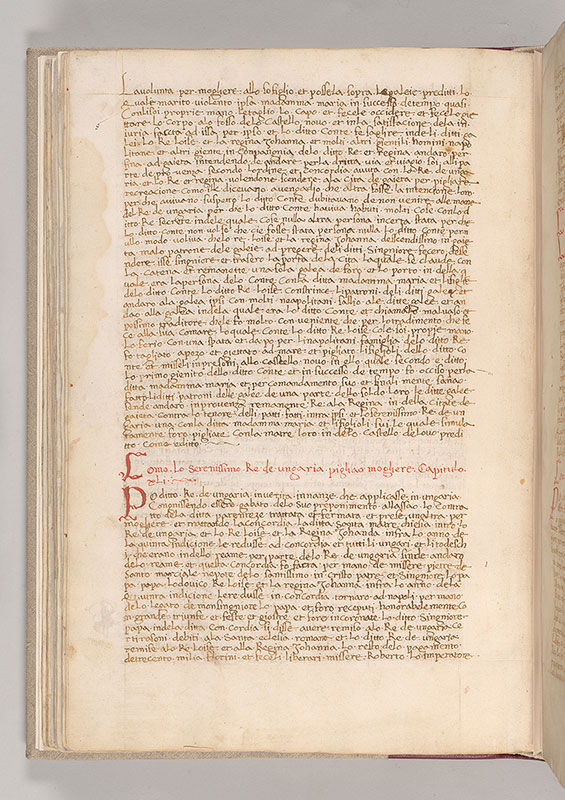
Fasciculus temporum
MS M.801, fol. 78r
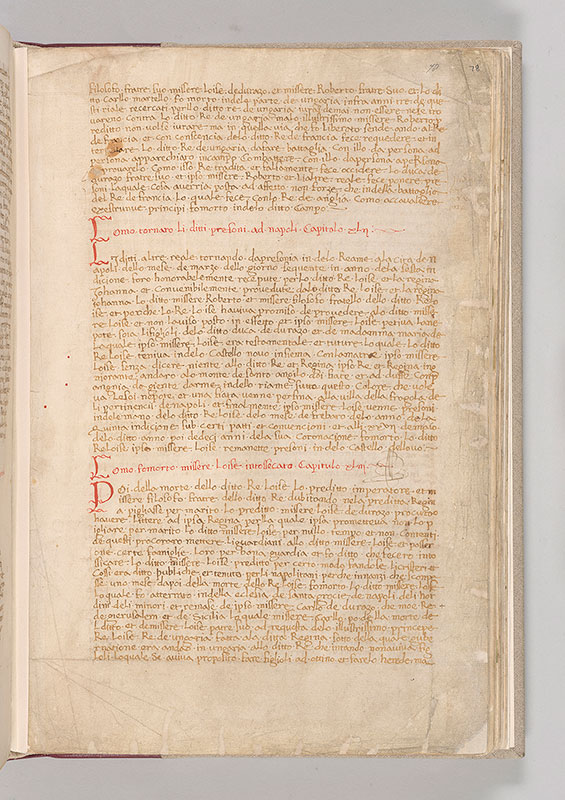
Fasciculus temporum
MS M.801, fol. 78v
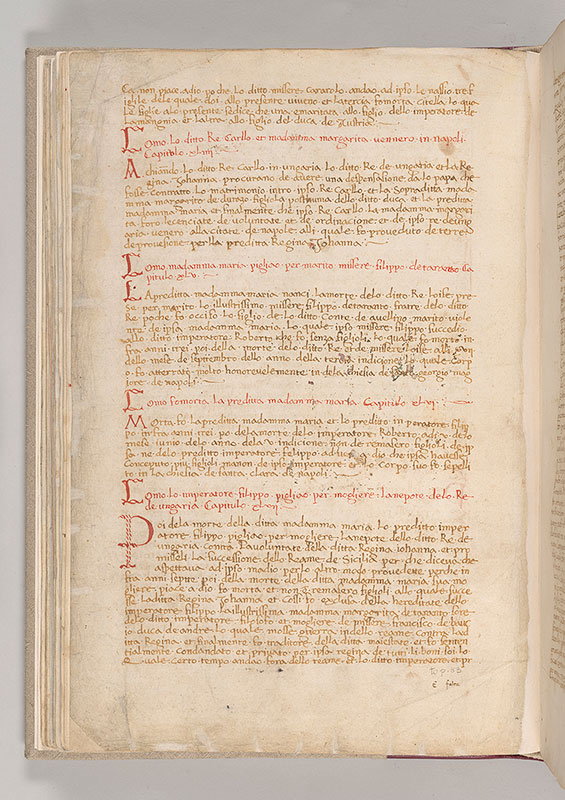
Fasciculus temporum
MS M.801, fol. 79r
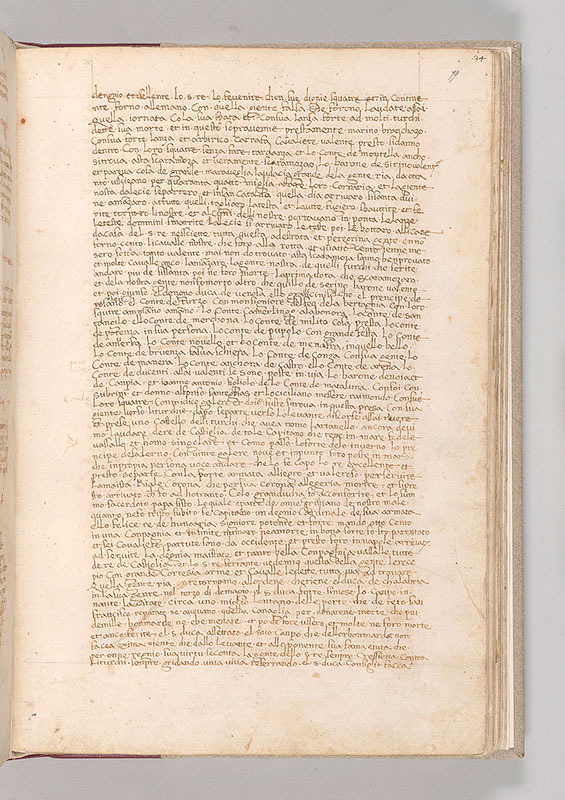
Fasciculus temporum
MS M.801, fol. 79v
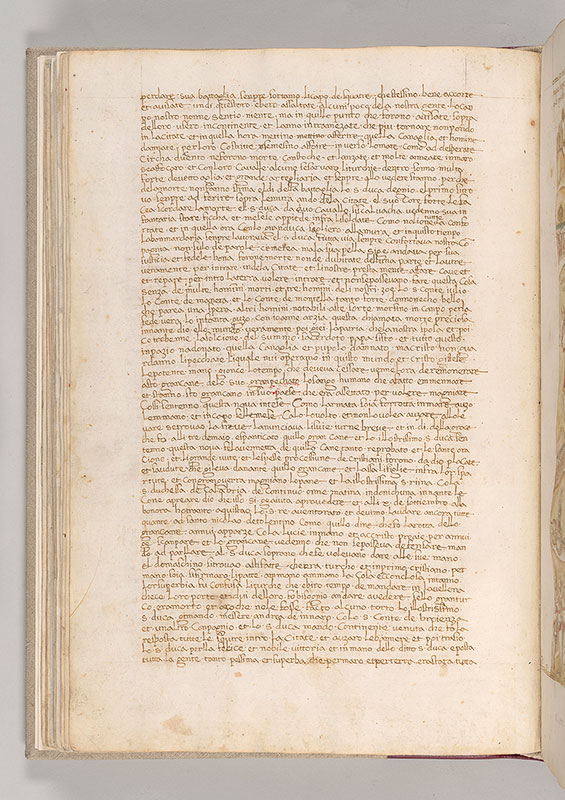
Fasciculus temporum
MS M.801, fol. 80r
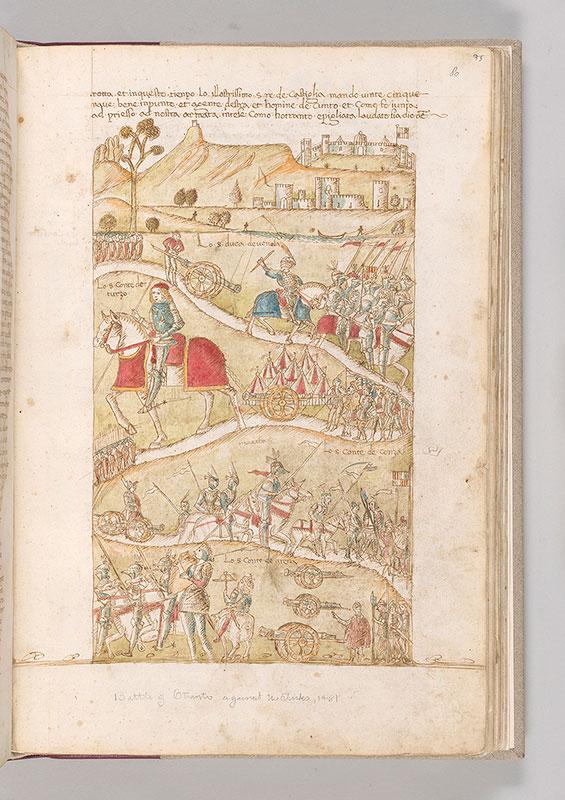
Fasciculus temporum
At top of miniature, wall of city or castle above other buildings; below, man fishing, another pulling boat to shore. On road winding through landscape, army of foot soldiers carrying shields behind man wearing hat, playing drum next to cannon on wheels; soldier inscribed LO S(IGNOR) DUCA DE UENOSA, wearing plumed helmet, raising rod with right hand astride caparisoned horse following group of soldiers, six carrying bannered spears, two astride horses, holding lances, one with heraldic banner; group of men, wearing hats, one carrying banner, some with shields, another with spear next to camp of nine tents, each surmounted by banner, and following cannon with wheels
Soldier inscribed LO S(IGNOR) CONTE DE TURZO, wearing hat, decorated breastplate and spurs, holding lance with right hand, astride caparisoned horse raising right front hoof above group of soldiers with spears and shields; soldier holding halberd next to canon on wheels; soldier carrying bannered spear, three soldiers astride bridled horses, carrying bannered lances and small figure, holding bannered lance, astride bridled horse next to inscription LO S(IGNOR) CONTE DE CONZA, all behind group of men, possibly soldiers, carrying bannered spears, heraldic banner, sword and halberd following man gesturing toward three cannons on wheels.
Small figure wearing hat, holding crossbow, sword at waist, astride back-turned horse, next to inscription LO S(IGNOR) CONTE DE ARENA; at bottom left corner, tall figure, crowned (?), wearing armor, holding with right hand spear and shield next to three soldiers astride horses, holding lances, one wearing spurs.
In lower margin, in later hand, "Battle of Otranto against the Turks, 1481".
MS M.801, fol. 80v
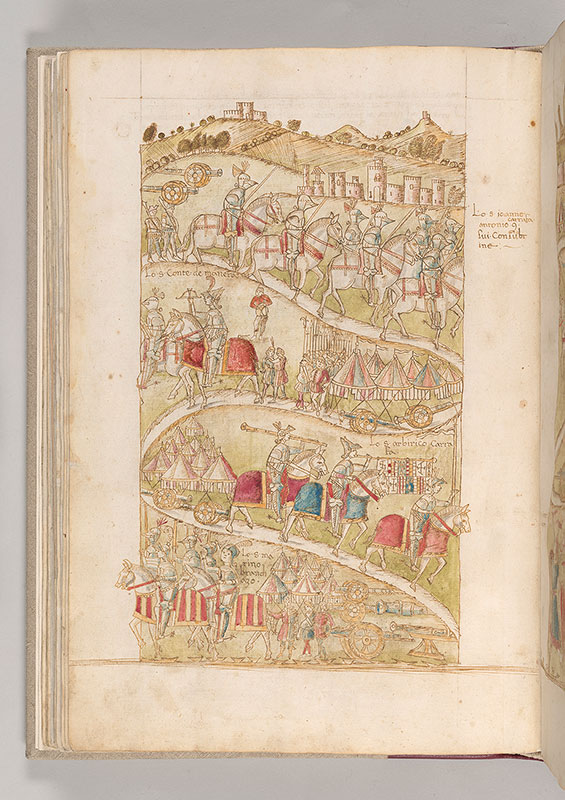
Fasciculus temporum
Cronaca della Napoli Aragonese: Scene, Liberation of Otranto -- In landscape, buildings of city, cannons in field, army on winding road including: soldiers carrying spears; group of soldiers wearing plumed helmets, armor, spurs, holding lances, all astride bridled horses inscribed LO S(IGNOR) IOANNE ANTONIO CARRASO CON SUI CONSUBRINE; two cannons on wheels next to camp of eight tents surmounted by banners, before which stand group of soldiers holding spears and halberd; two soldiers in conversation; drummer standing in field;
Two soldiers wearing plumed helmets, armor, spurs, one holding crossbow, both astride horses, one caparisoned, below inscription LO S(IGNOR) CONTE DE MANERA; second camp of eleven tents, most surmounted by banners next to road; two more cannons on wheels following three soldiers wearing helmets (two plumed), armor and spurs, one carrying gun on shoulder, one blowing trumpet with heraldic banner, third carrying lance, all astride caparisoned horses next to inscription LO S(IGNOR) ARBIRICO CARRAFA.
At bottom, five cannons, three on wheels next to camp of ten tents, bannered, three soldiers holding spears; five soldiers wearing plumed helmets, armor, three holding spears, two astride caparisoned horses, all next to inscription LO S(IGNOR) MARINO BRANCHAZO.
MS M.801, fol. 81r

Fasciculus temporum
Cronaca della Napoli Aragonese: Scene, Liberation of Otranto -- In landscape, buildings of city, army on winding road including: camp of nine tents with banners next to road; three soldiers, two wearing helmets, one with plumed hat, all wearing armor and spurs, astride horses, two holding lances, the foremost holding mace and shield decorated with heraldry, next to inscription in margin LO S(IGNOR) GRAN SINISCALCO.
Cannon on wagon drawn by two horses next to inscription MONSIGNORE DELL FIEO; six or seven soldiers, three with plumed helmets, all wearing armor, seven (?) holding spears, one with sword at waist following two soldiers, plumed helmets, wearing armor and spurs, carrying bannered lances, astride bridled horses; cannon with wheels, foot soldiers, some carrying spears, some with shields, and three soldiers wearing plumed helmets, armor and spurs, carrying lances astride bridled horses; inscription next to foremost, LO S(IGNOR) DE MANERA.
At bottom, horseman possibly riding sideways following group of soldiers, one astride horse, carrying spears, some bannered, four carrying large shields, most wearing long tunics, next to inscription in margin LO S(IGNOR) CONTE DE DUCENTI.
MS M.801, fol. 81v
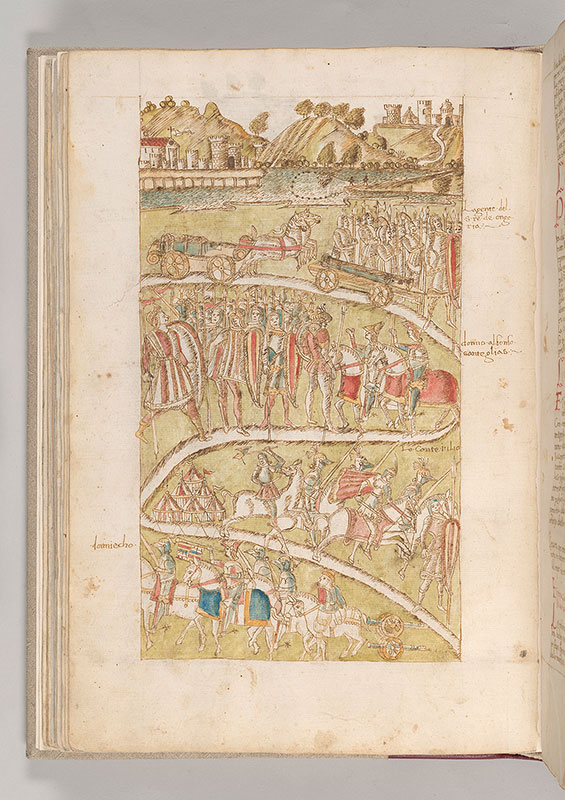
Fasciculus temporum
Cronaca della Napoli Aragonese: Scene, Liberation of Otranto -- In landscape, buildings of city on hill and on shore of body of water, including church surmounted by bannered cross. On opposite shore two figures pulling in fishnet.
Army on winding road including: two cannons on wagons, one drawn by two leaping horses behind group of soldiers carrying spears, halberd, and shield next to inscription in margin, LA GENTE DEL S(IGNOR) RE DE ONGORIA; inscription in margin, DONNO ALFONSO SANTEGLIAS, behind two soldiers, wearing helmets, armor and spurs, one with lance (?) both astride caparisoned horses, approaching group of foot soldiers, carrying spears, four (?) holding shields
Camp of five bannered tents; six soldiers, four or five astride horses, carrying spears, lances, battle-axe, sword and shield, below inscription LO CONTE IULIO; at bottom, two cannons on wheels behind horseman, and four soldiers, all astride horses, one caparisoned, three wearing plumed helmets, armor and spurs, two holding lances, one blowing trumpet with heraldic banner, approaching inscription in margin DONNIECHO.
MS M.801, fol. 82r
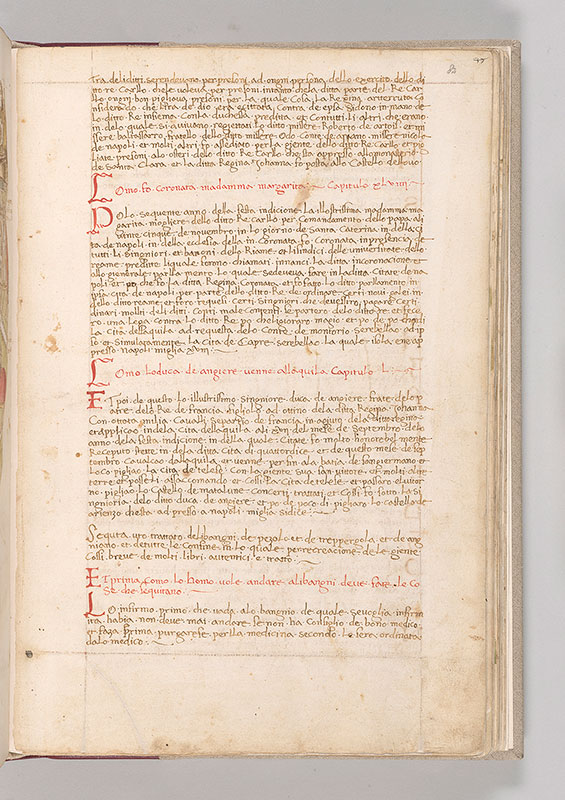
Fasciculus temporum
MS M.801, fol. 82v
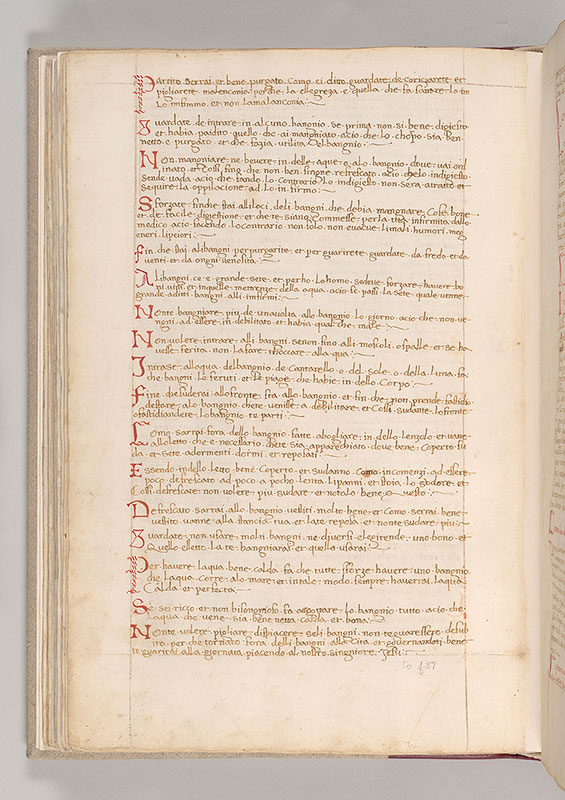
Fasciculus temporum
MS M.801, fol. 83r
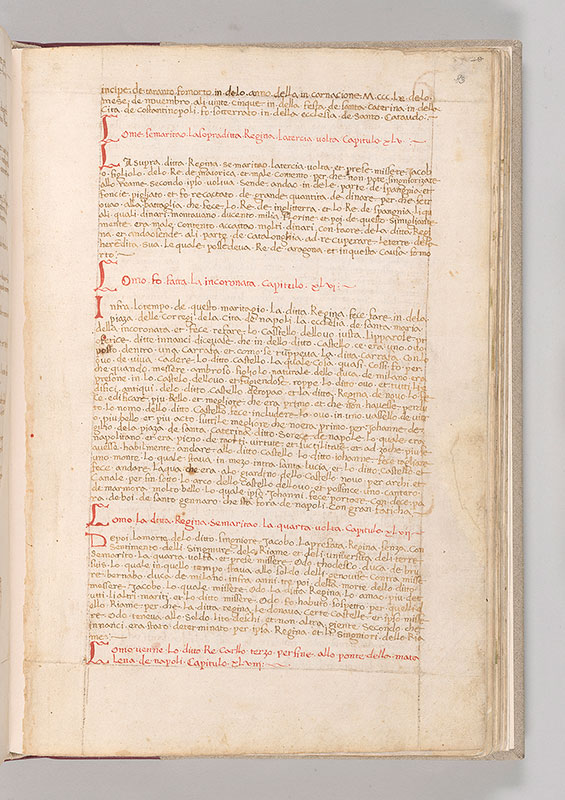
Fasciculus temporum
MS M.801, fol. 83v
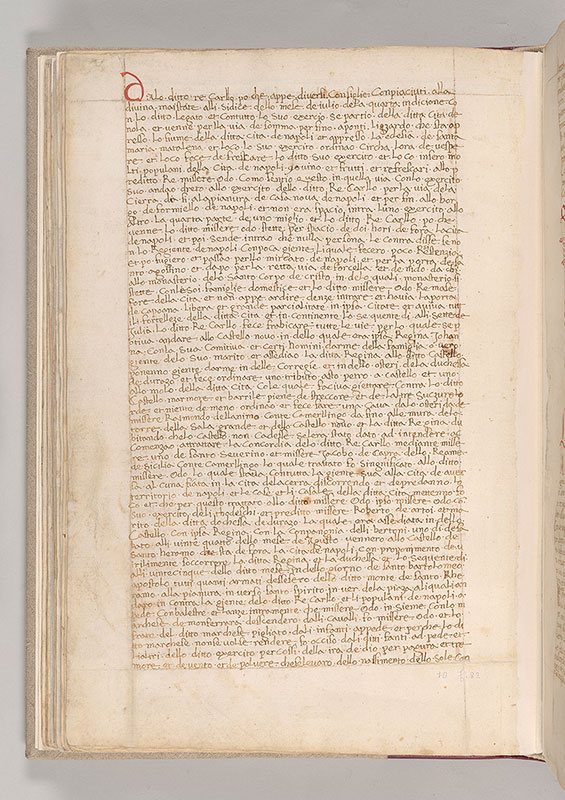
Fasciculus temporum
Bagni di Pozzuoli, MS M.801, fol. 84r
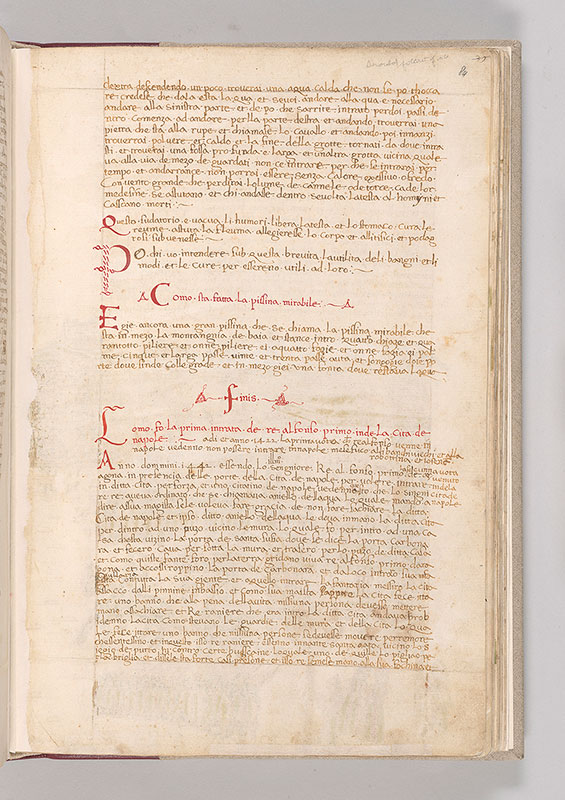
Fasciculus temporum
MS M.801, fol. 84v
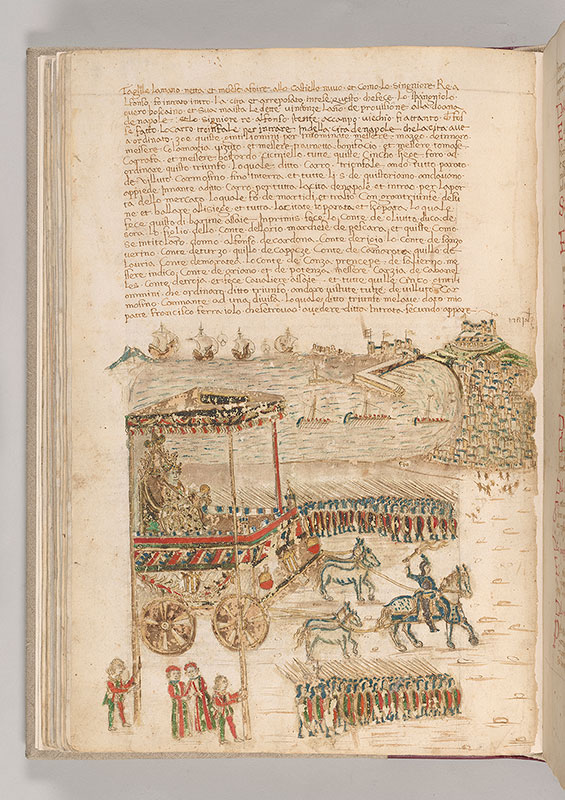
Fasciculus temporum
Cronaca della Napoli Aragonese: Scene, triumphal Entry into Naples -- Alfonso V of Aragon (?), crowned, holding scepter with right hand, globe with left hand, is seated below canopy on throne on wagon pulled by five horses, with soldier raising scourge with right hand astride foremost horse, caparisoned. Aragonese heraldic ornament decorates side and front of the wagon. In foreground two of four men carry poles possibly supporting near side of the canopy; other men stand in conversation. Two armies of soldiers holding spears and shields flank the horses.
In background, ships sailing toward port of Naples; wall protecting harbor extending into sea; in harbor, beyond the wall, lighthouse on island; buildings on hill and shore inscribed NAP(O)L(E).
Text is from Cronaca della Napoli Aragonese; see Cronaca della Napoli Aragonese, ed. Filangieri (1956), pp. 28-29
MS M.801, fol. 85r
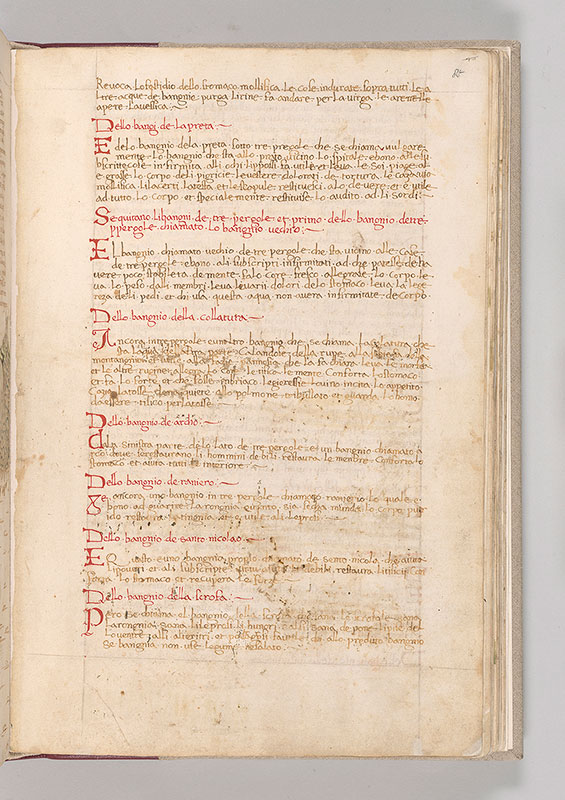
Fasciculus temporum
MS M.801, fol. 85v
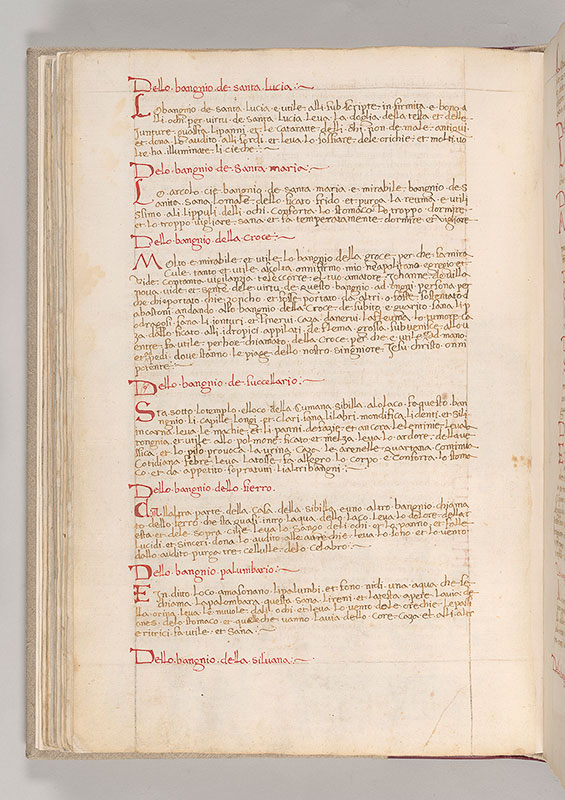
Fasciculus temporum
MS M.801, fol. 86r
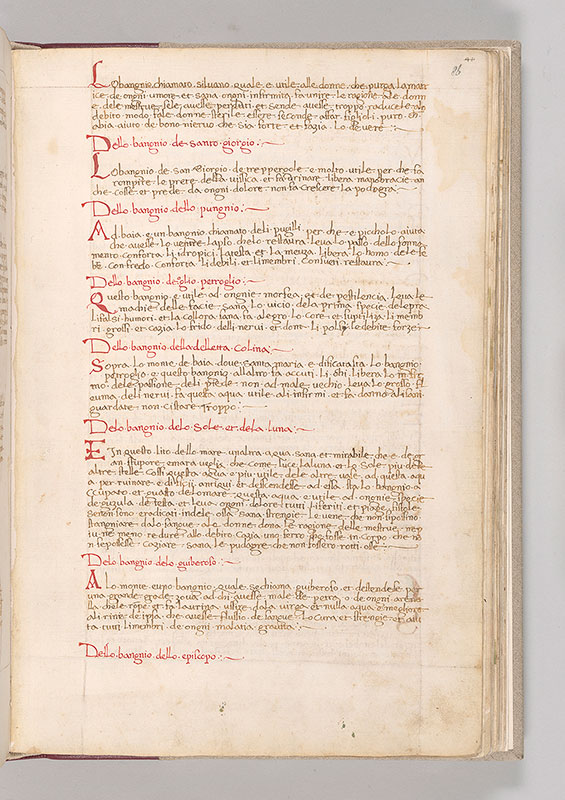
Fasciculus temporum
MS M.801, fol. 86v
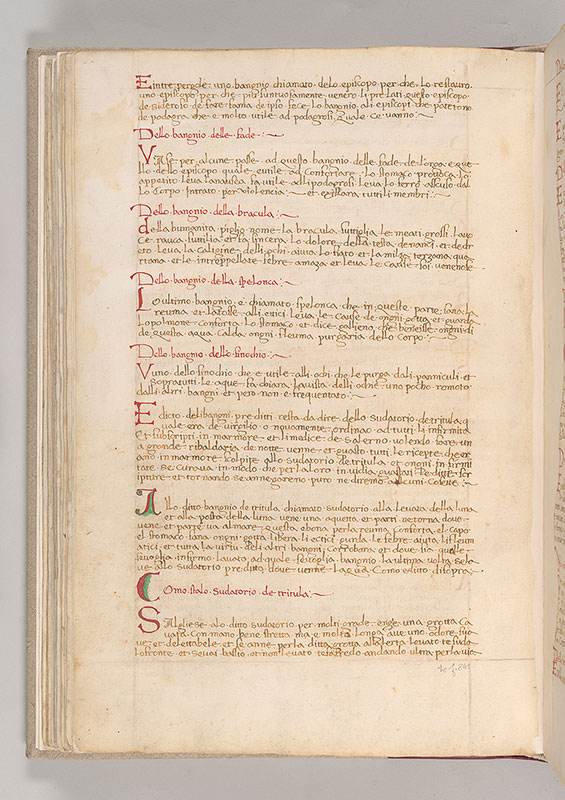
Fasciculus temporum
MS M.801, fol. 87r
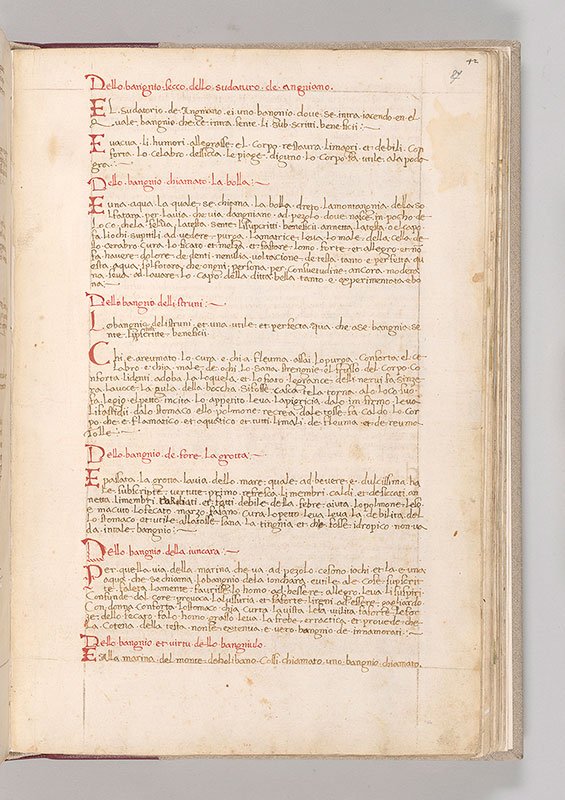
Fasciculus temporum
MS M.801, fol. 87v
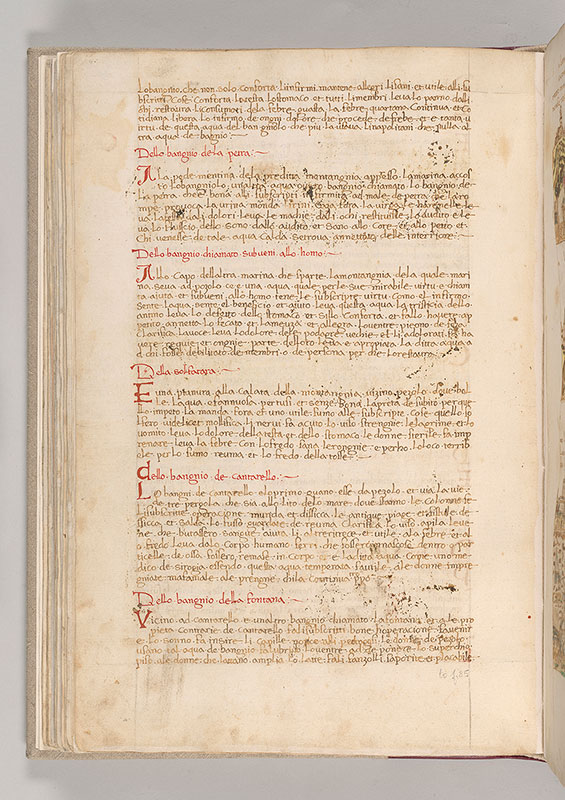
Fasciculus temporum
Cronaca della Napoli aragonese, MS M.801, fol. 88r
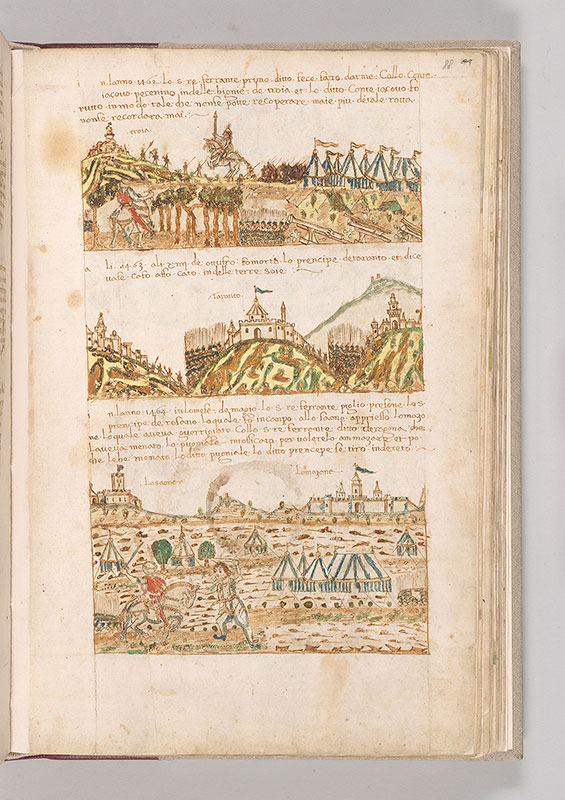
Fasciculus temporum
MS M.801, fol. 88v
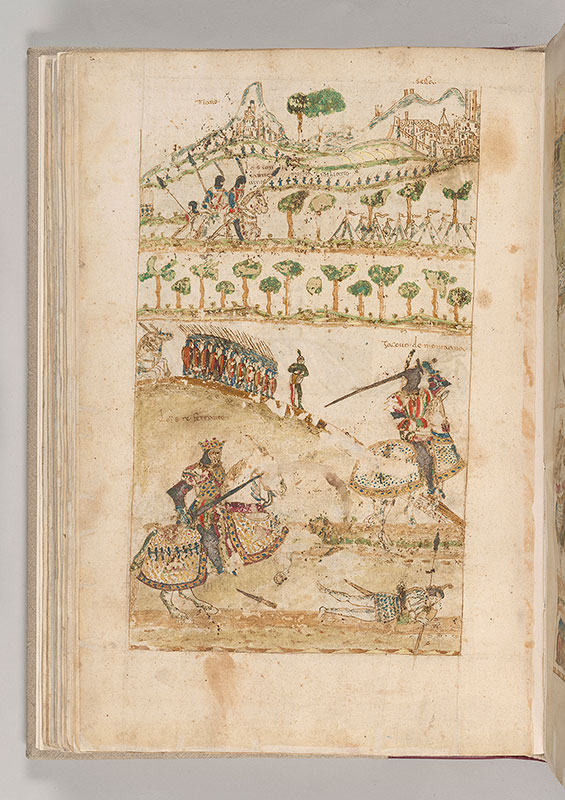
Fasciculus temporum
Cronaca della Napoli Aragonese: Scene, Ferdinand of Naples fighting Giacomo di Montagano -- In foreground, Ferdinand, inscribed LO S(IGNOR) RE FERRANTE, crowned, wearing armor holding sword with right hand is astride rearing, caparisoned, horse pursuing Giacomo di Montagano, inscribed IACOUO DE MONTAGNA, wearing helmet and armor, raising sword with left hand, astride caparisoned horse. Soldier, shield at left shoulder, holding or transfixed by spear, sword at waist, reclines on ground between them near dagger.
Two horses, army of soldiers carrying spears and shields, follow drummer, approaching the two horsemen.
In background, two towns at foot of mountains, one inscribed TIANO, the other SESSA; line of soldiers holding spears approaching each town. At left, three soldiers next to inscription LO S(IGNOR) CONTE IOANE UINTAMIGLIA [...]LIANO, two astride horses, wearing plumed helmets, carrying lances, approaching camp of eight tents.
MS M.801, fol. 89r
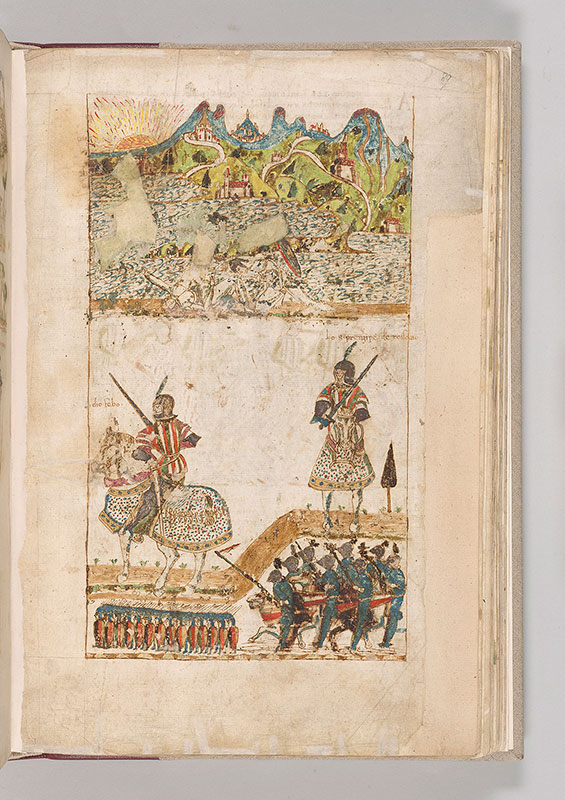
Fasciculus temporum
Two horsemen, one inscribed DIOFEBO, the other, LO S(IGNOR) PRENZIPE DE ROSSANO both wearing plumed helmets, armor, holding swords with right hands, are astride caparisoned horses. They look toward the fighting on the opposite page. In foreground, army of soldiers holding spears and shields, behind them, eight soldiers wearing plumed helmets, carrying spears or lances, possibly astride horses. In background, sun rises or sets behind hill; buildings or towns are among hills and valleys. One of two soldiers fighting reclines on ground, the other kneels on one knee.
MS M.801, fol. 89v
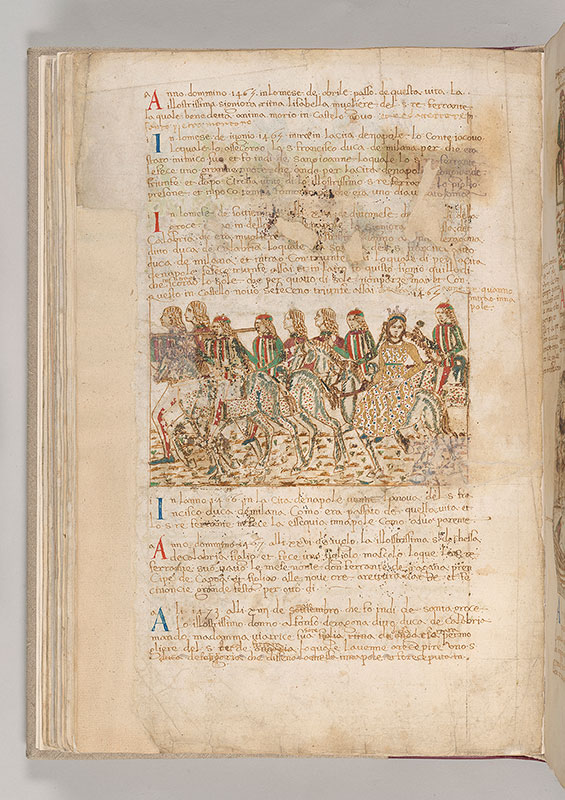
Fasciculus temporum
Cronaca della Napoli Aragonese: Scene, Ippolita Maria Sforza arriving in Naples -- Ippolita Maria Sforza as Duchess of Calabria, crowned, seated sideways on horse, rides amid eight men, four (?) astride horses, two blowing trumpets, four on foot.
MS M.801, fol. 90r
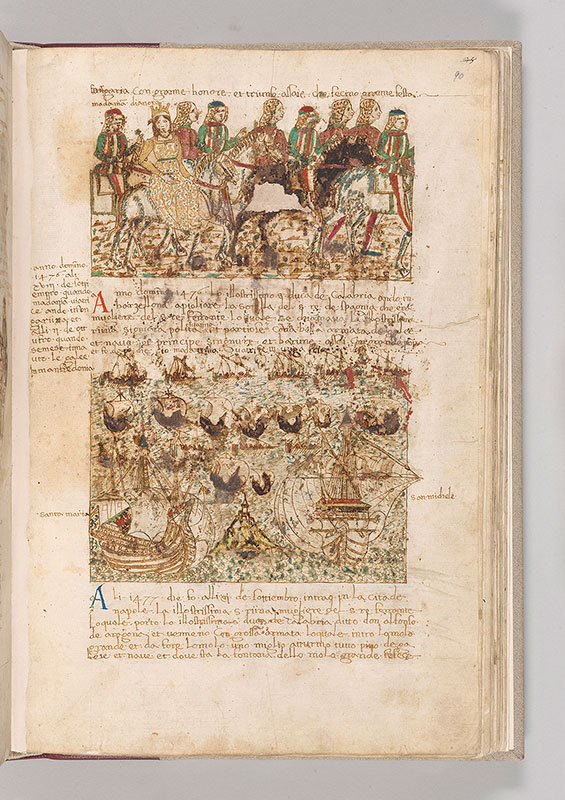
Fasciculus temporum
Cronaca della Napoli Aragonese: Scene, Eleanor of Aragon, Journey to Ferrara -- Eleanor of Aragon, crowned, seated sideways on horse, rides amid eight men, four (?) astride horses, four (?) on foot.
Cronaca della Napoli Aragonese: Scene, Alfonso II of Naples arriving in Barcelona -- Ships sailing; flanking hilly island surmounted by building, two foremost ships named by inscriptions in margins SANTA MARIA (left) and SAN MICHELE (right).
MS M.801, fol. 90v
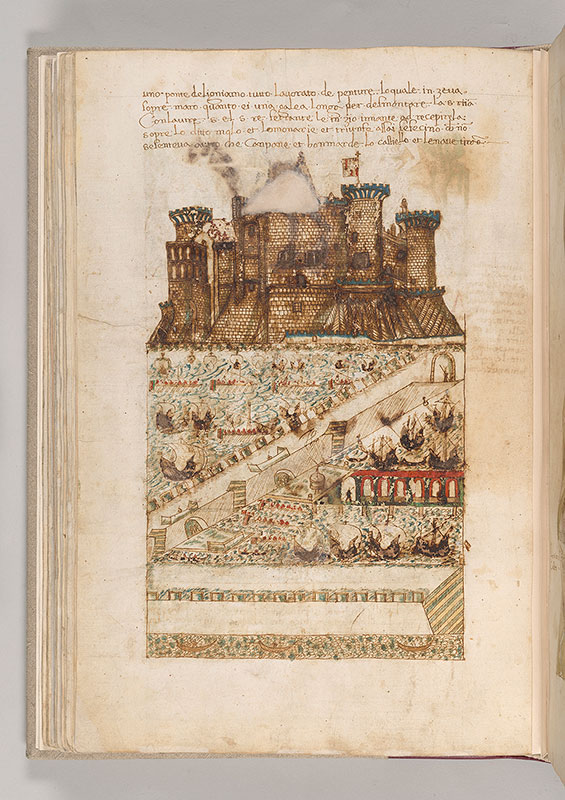
Fasciculus temporum
Cronaca della Napoli Aragonese: Scene, Harbor of Naples -- Castel Nuovo in background, heraldic banner surmounting tower, dominating harbor with long pier, ships, and boats with oars.
MS M.801, fol. 91r
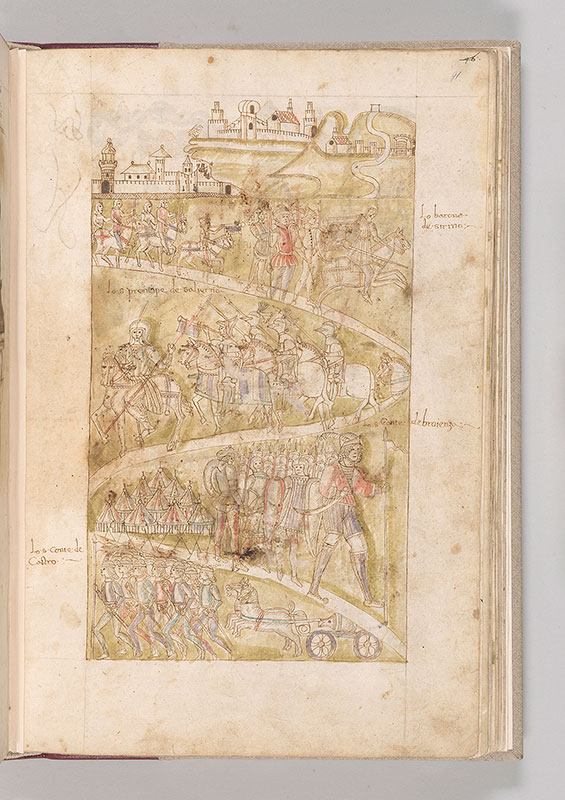
Fasciculus temporum
Cronaca della Napoli Aragonese: Scene, Liberation of Otranto -- In landscape, buildings of city or castles, army on winding road including: five horsemen, one blowing bannered trumpet, and three (?) men on foot, led by soldier, holding lance with right hand astride leaping horse next to inscription LO BARONE DE SIRINO; five soldiers wearing helmets and armor, four holding lances, one blowing bannered trumpet, all astride horses, one caparisoned, below inscription LO SIGNOR PRENCIPE DE SALIERNO.
Camp of 10 tents next to group of soldiers, many holding spears, two with shields, foremost wearing scimitar at waist and holding bannered spear with left hand, below inscription LO SIGNOR CONTE DEBROIENZO.
At bottom, cannon on wagon pulled by two leaping horses behind group of soldiers, most only tops of heads visible, many wearing swords at waists, the foremost holding spear with right hand, next to inscription LO SIGNOR CONTE DE CASTRO in left margin.
MS M.801, fol. 91v
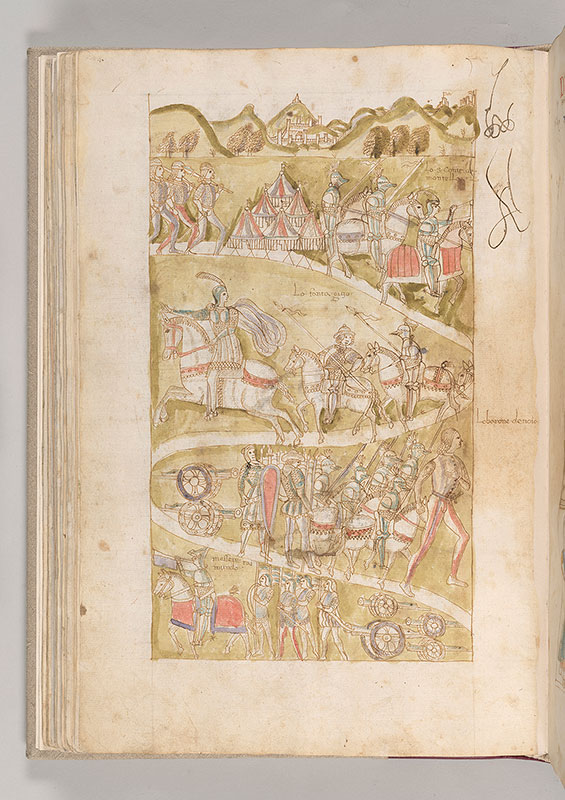
Fasciculus temporum
Cronaca della Napoli Aragonese: Scene, Liberation of Otranto -- In landscape, buildings of city or castles in valley and atop hills, army on winding road including: three foot-soldiers, carrying spears on left shoulders, two with right hands on swords at waists approaching camp of five tents; three soldiers wearing plumed helmets and armor, astride horses, the foremost blowing trumpet astride caparisoned horse, below inscription LO SIGNOR CONTE DE MONTELLO.
Two horsemen, wearing armor and spurs, one with plumed helmet, both holding bannered lances follow third horseman, wearing plumed helmet, armor and spurs with flowing cape, below inscription LO FANTA GUZO; two cannons with wheels behind group of soldiers many holding spears, most only tops of heads visible; five soldiers wearing plumed helmets, and armor, carrying lances astride horses folowing tall figure next to inscription in margin LO BARONE DE NOIA.
At bottom, four cannons, each with two wheels; group of soldiers, most only tops of helmets visible, some carrying spears, one with shield, another with sword at waist following soldier blowing bannered trumpet, astride caparisoned horse next to inscription MESSERE RAIMUNDO.
MS M.801, fol. 92r
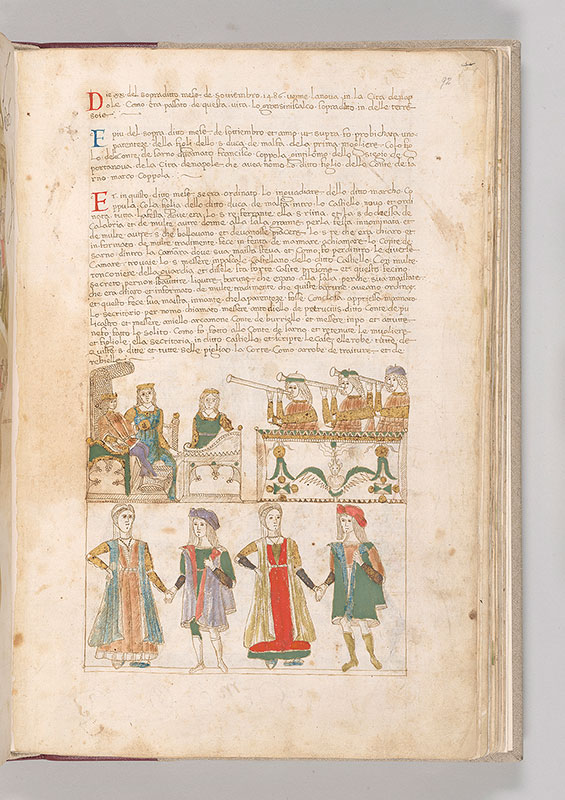
Fasciculus temporum
Cronaca della Napoli Aragonese: Scene, Marriage of Marco Coppolo and Maria Piccolomini -- In miniature of two registers, at upper left, Ferdinand I of Naples, crowned, holding scepter with right hand and globe with left hand, is seated on throne with canopy, his feet on cushion, next to his queen, Joanna of Aragon, crowned, seated on chair. Next to them, Duchess of Calabria, crowned (?) sits in chair. At right, three musicians wearing hats play trumpets in box or balcony decorated with garland, gold balls and winged bust of man with animal ears. In lower register, Maria Piccolomini, veiled (?) and Marco Coppolo, wearing hat, are shown twice as couple.
MS M.801, fol. 92v
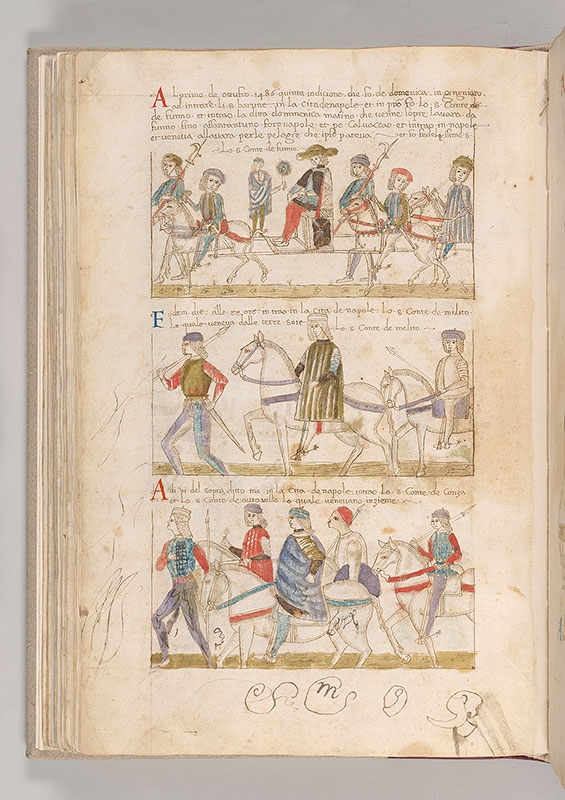
Fasciculus temporum
Cronaca della Napoli Aragonese: Scene, Nobles entering Naples -- Shown in three miniatures:
1) Onorato Gaetani, Count of Fondi, wearing large brimmed hat, is seated on chair on litter carried by horse with rider at front and another at back, below inscription LO SIGNOR CONTE DE FUNNO. Two soldiers, each carrying halberd walk beside the litter; small figure stands on pole of litter raising fan (?) with left hand. Horse and rider follow all at far right.
2) Man wearing hat, carrying spear on right shoulder, his left hand on sword at waist, walks before Carlo Sanseverino, Count of Mileto, wearing hat, and spurs, astride bridled horse next to inscription LO SIGNOR CONTE DE MELITO. He is followed by man, wearing hat, and spurs, carrying lance, astride bridled horse.
3) Luigi Gesualdo, Count of Conza, and Francesco of Capua, Count of Altavilla are astride horses next to each other, preceded by man wearing hat, carrying spear, and followed by soldier wearing hat and armor, carrying spear and shield. At left, horseman, wearing hat and spurs carries lance with right hand. Inscription above them, LO SIGNOR CONTE DE CONZA ET LO SIGNOR CONTE DE AUTAVILLA LO QUALE UENEUANO INZIEME.
MS M.801, fol. 93r
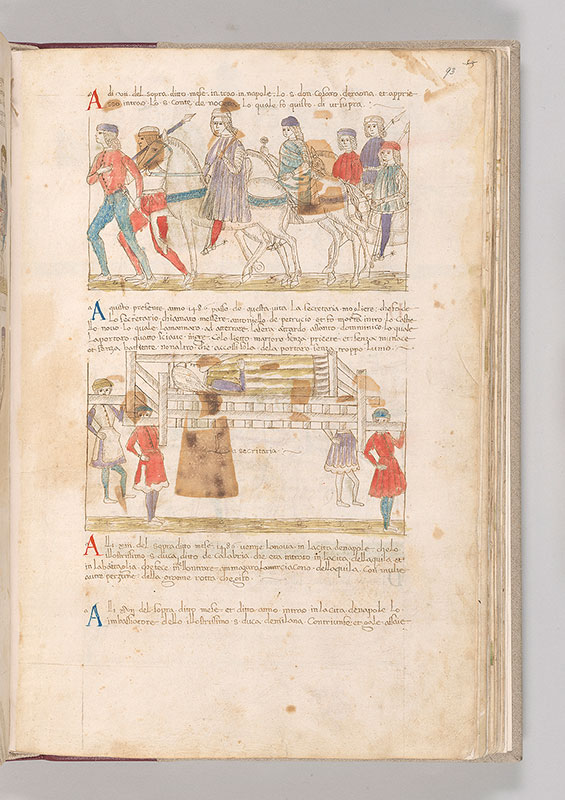
Fasciculus temporum
Cronaca della Napoli Aragonese: Scene, Nobles entering Naples -- Cesare of Aragon and Francesco Zurlo, Count of Nocera, wearing hats and spurs, one holding flower or scepter with right hand, are astride bridled horses, following two men wearing hats, one with right hand on breast, grasping with left hand sword at waist, and the other carrying spear on left shoulder. At right are three (?) horsemen, wearing hats, one with spurs, two carrying lances.
Cronaca della Napoli Aragonese: Scene, Death of Elizabeth Vassallo -- Body of Elizabeth Vassallo, reclines on bier supported by man at each corner, one only partially visible.
MS M.801, fol. 93v
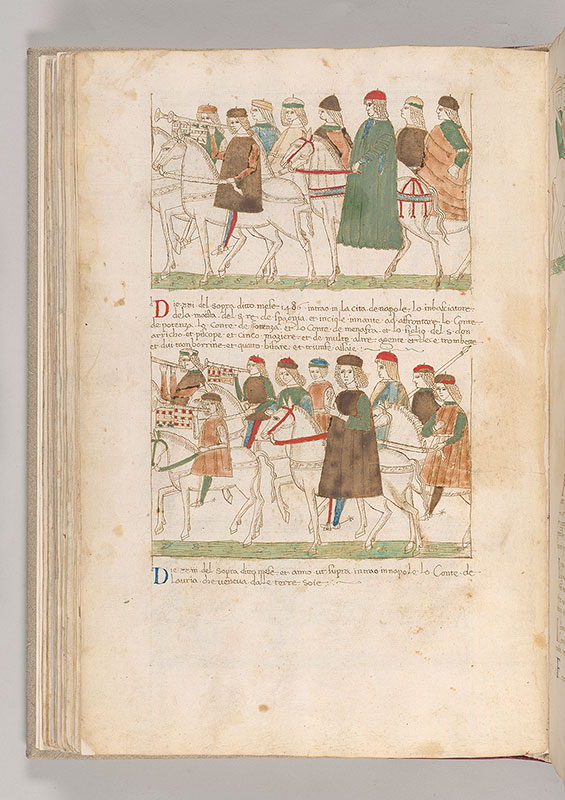
Fasciculus temporum
Cronaca della Napoli Aragonese: Scene, Nobles entering Naples -- Eight men wearing hats, all (?) astride bridled horses, two foremost blowing bannered trumpets.
Cronaca della Napoli Aragonese: Scene, Nobles entering Naples -- Below, nine men wearing hats, five (?) astride bridled horses, three foremost blowing trumpets, two bannered, one carrying lance.
MS M.801, fol. 94r
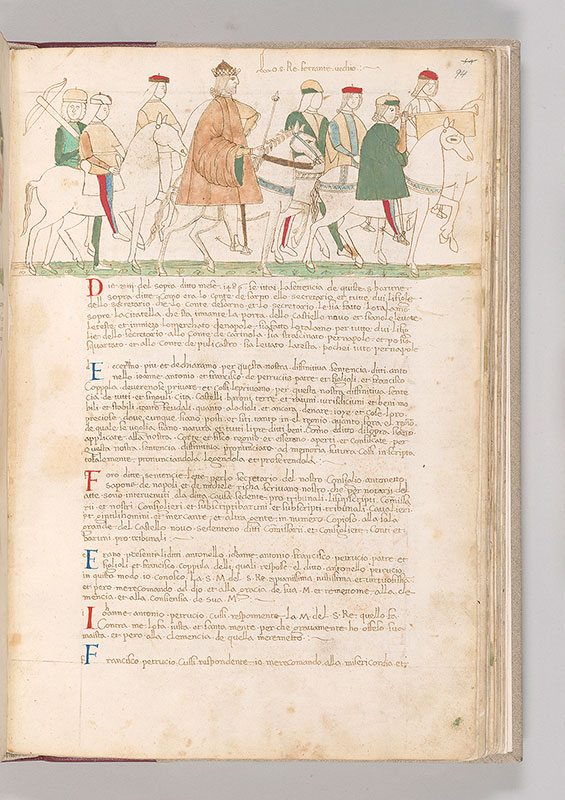
Fasciculus temporum
Cronaca della Napoli Aragonese: Scene, Procession of Ferdinand I of Naples -- Ferdinand (Ferrante), King of Naples inscribed LO S(IGNOR) RE FERRANTE UECHIO, crowned, holding scepter with right hand, astride bridled horse, is flanked front and back by courtiers, five (?) astride horses, one carrying crossbow, one blowing bannered trumpet.
MS M.801, fol. 94v
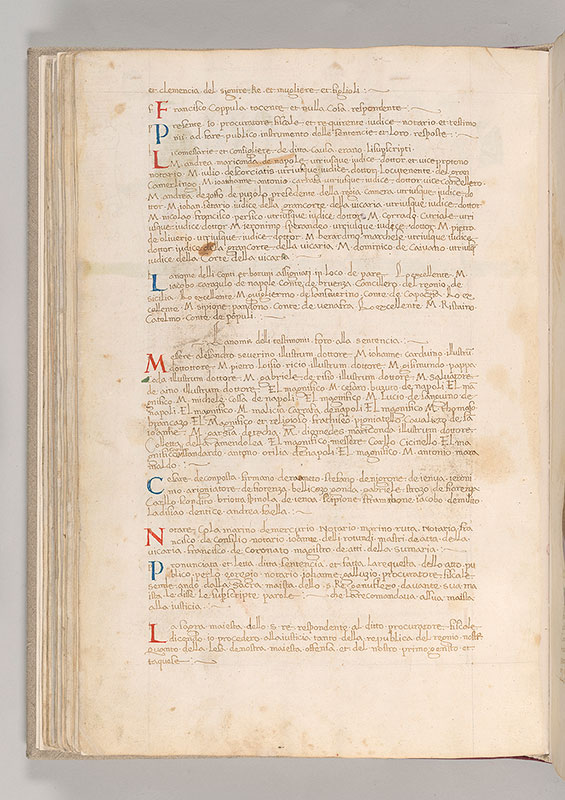
Fasciculus temporum
MS M.801, fol. 95r
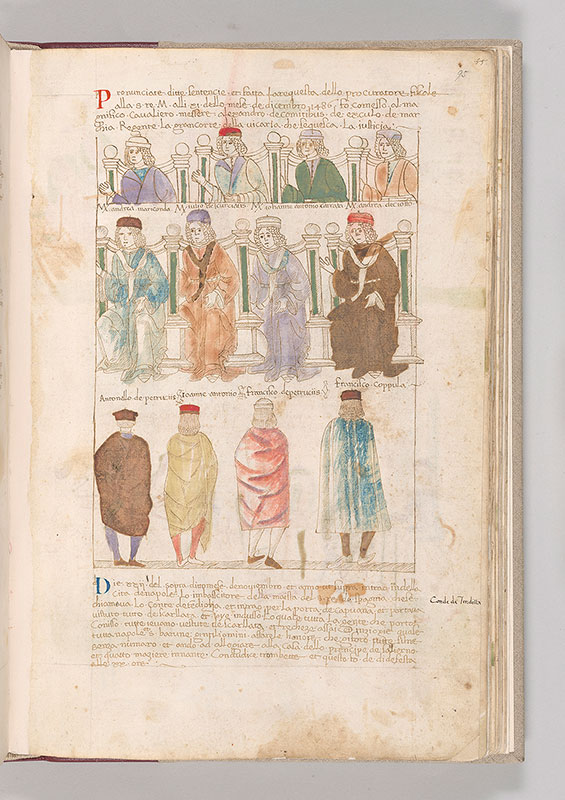
Fasciculus temporum
Cronaca della Napoli Aragonese: Scene, Trial of rebellious Nobles -- In two rows, eight men, wearing hats, raising right hands are seated on chairs. Those in second row wear stoles around neck, looped over left shoulders. Their names are inscribed: M(ESSER) ANDREA MARICONDA; M(ESSER) IULIO DE SCURCIATIS; M(ESSER) IOHANNE ANTONIO CARRAFA; M(ESSER) ANDREA DE CIOFFO. Below, four condemned men, wearing hats, stand with backs turned. Names are inscribed above: ANTONELLO DE PETRUCIIS; IOANNE ANTONIO; FRANCISCO DE PETRUCIIS; FRANCISCO COPPULA.
MS M.801, fol. 95v
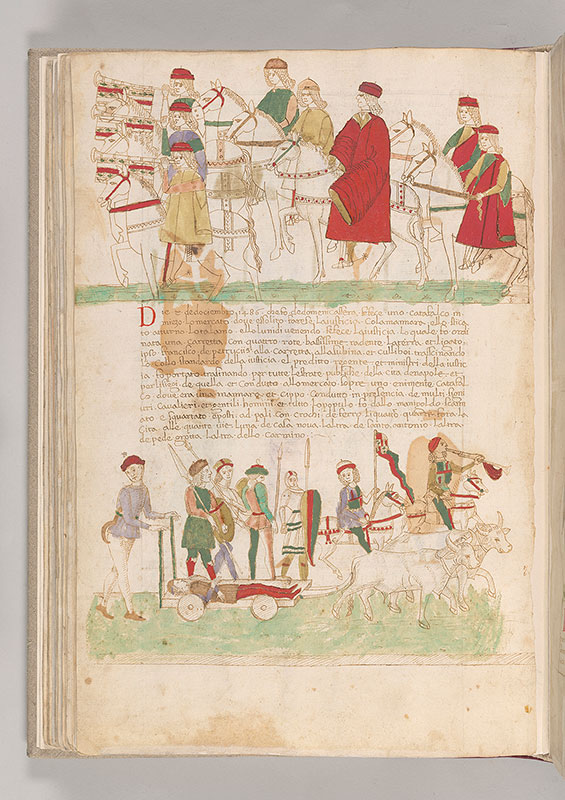
Fasciculus temporum
Cronaca della Napoli Aragonese: Scene, Arrival of Spanish Ambassador in Naples -- Three foremost of eight horsemen wearing hats, blow bannered trumpets. In center, Ambassador wears large red coat.
Cronaca della Napoli Aragonese: Scene, Execution of Francesco Petrucci -- Executioner, wearing hat, sickle at waist, walks behind cart on which Francesco Petrucci, wearing hat, reclines, hands crossed. Cart is pulled by two yoked oxen. In background, three soldiers carry spears and shields; fourth carries spear. Of two horsemen wearing hats, one wears knife at waist and holds banner with left hand and the other blows bannered trumpet.
MS M.801, fol. 96r
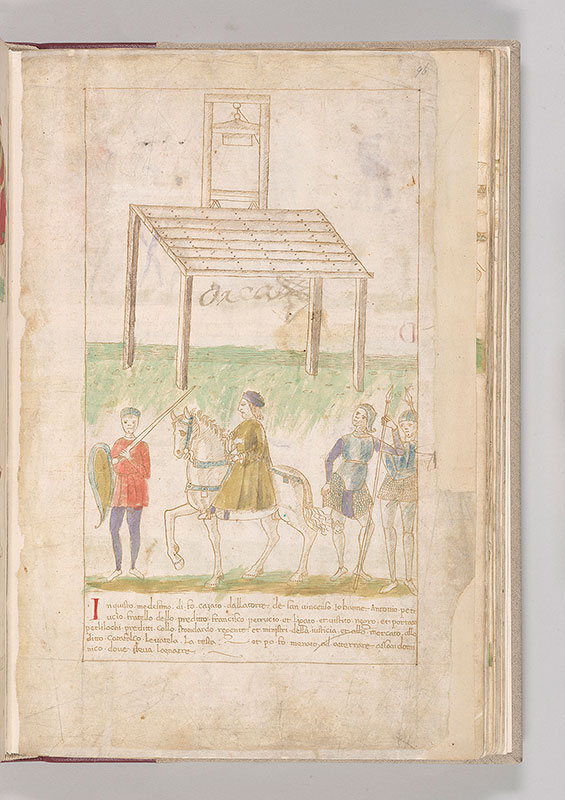
Fasciculus temporum
Cronaca della Napoli Aragonese: Scene, Site of Execution -- Platform with frame enclosing guillotine. In foreground, horseman wearing hat flanked by three soldiers, one holding shield and sword, the other two holding spears.
MS M.801, fol. 96v
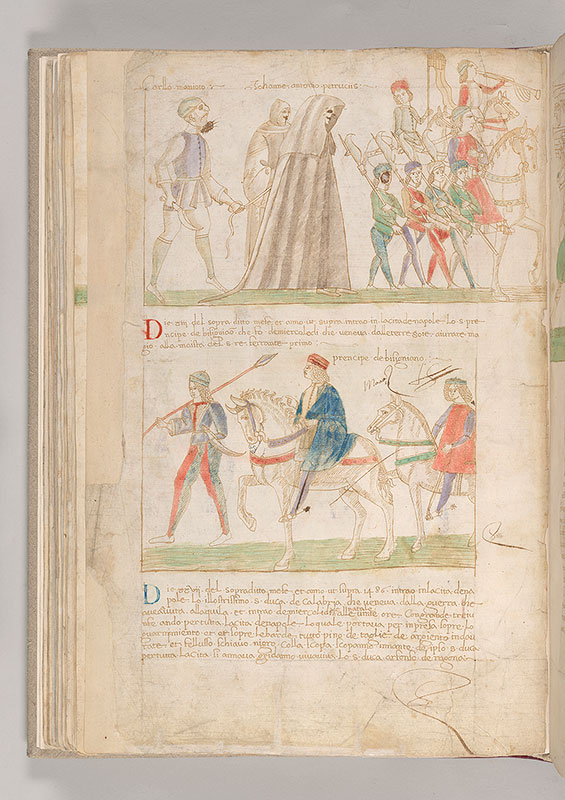
Fasciculus temporum
Cronaca della Napoli Aragonese: Scene, Giovanni Antonio Petrucci led to Execution -- Executioner, inscribed CARLLO MANIOTO, wearing hat, holding sickle with right hand, grasps with left hand, rope possibly attached to Giovanni Antonio Petrucci, inscribed IOHANNE ANTONIO PETRUCIIS, wearing hood and long garment, next to cleric (?) wearing hood. They follow four men carrying halberds, and three horsemen, one carrying banner, one blowing trumpet.
Cronaca della Napoli Aragonese: Scene, Geronimo Sanseverino arriving in Naples -- Below, man wearing hat, carrying spear on right shoulder, scimitar at waist at left, walks before Geronimo Sanseverino, inscribed PRENCIPE DE BISIGNIANO, wearing hat and spurs, astride horse. He is followed by horseman, wearing hat and spurs.
MS M.801, fol. 97r
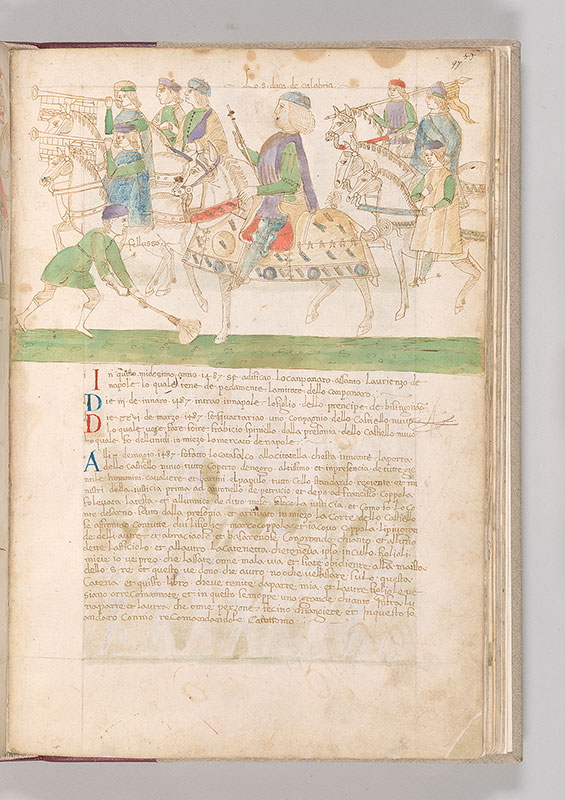
Fasciculus temporum
Cronaca della Napoli Aragonese: Scene, Duke of Calabria entering Naples -- Alfonso II of Naples as Duke of Calabria, inscribed LO SIGNOR DUCA DE CALABRIA, wearing hat, holding rod or scepter with right hand is astride caparisoned horse. Servant inscribed FELUSSO, holding broom with both hands, sweeps ground before the Duke's horse. Seven horsemen, wearing hats, accompany the Duke, four preceding, two blowing trumpets; three following, one carrying bannered lance on right shoulder.
MS M.801, fol. 97v
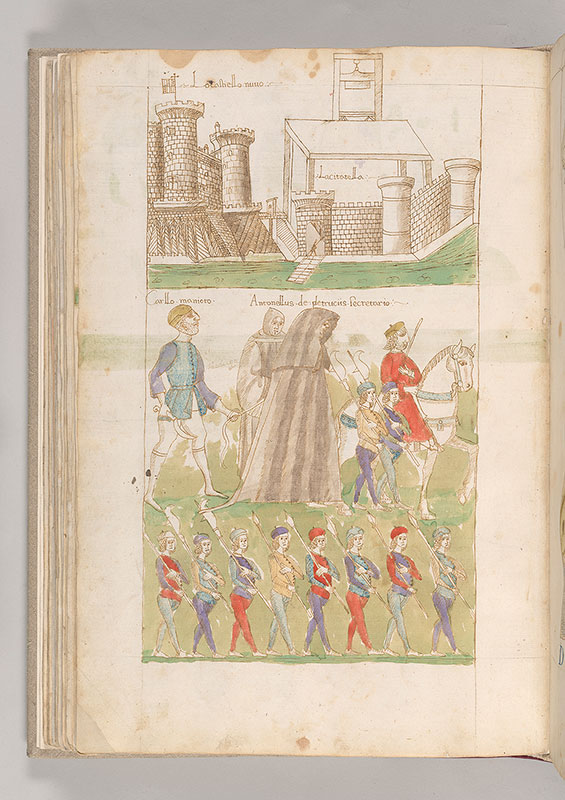
Fasciculus temporum
Cronaca della Napoli Aragonese: Scene, Antonello Petrucci led to Execution -- Above, Castel Nuovo, inscribed LO CASTIELLO NUUO with towers, one with banner surmounted by cross. The castle is connected by bridge to section inscribed LA CITATELLA, where crennelated walls enclose platform on which is guillotine. Silouette of soldier, wearing plumed helmet, holding spear stands in portal at end of walkway.
Below, executioner, inscribed CARLLO MANIOTO, wearing hat, holding sickle with right hand, grasps with left hand rope possibly attached to Antonello Petrucci inscribed ANTONELLUS DE PETRUCIIS SECRETARIO, wearing hood and long garment, next to cleric wearing hood. They are preceded by two men wearing hats, carrying halberds on right shoulders, and by horseman, wearing hat, holding rod or scepter with left hand. In foreground, line of eight men wearing hats, carrying halberds on right shoulders walk to right.
MS M.801, fol. 98r
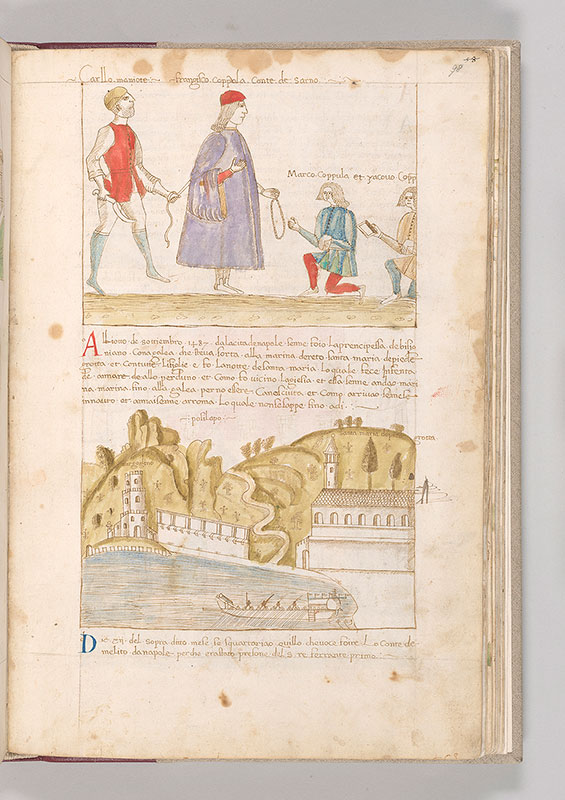
Fasciculus temporum
Cronaca della Napoli Aragonese: Scene, Francisco Coppola led to Execution -- Executioner, inscribed CARLLO MANIOTE, wearing hat, holding sickle with right hand, grasps with left hand rope attached to Francisco Coppola, inscribed FRANGISCO COPPOLA CONTE DE SARNO, wearing hat and coat with large sleeves. He extends beads or rosary with left hand toward raised right hand of son Marco. Other son, Giacomo extends object, possibly book, with right hand. Both kneel on one knee below inscription MARCO COPPULA ET YACOUO COPP(ULA).
Cronaca della Napoli Aragonese: Scene, Flight of Princess Bisigniano -- Hilly landscape of bay of Naples inscribed POSILAPO with buildings on shore, one, a tower inscribed MIRGOGLINO and church inscribed SANTA MARIA DE PIEDE GROTTO. In foreground, ship with many oars, cannon at one end, and cabin with windows, decorated with banners along roof, at shore near the church.
MS M.801, fol. 98v
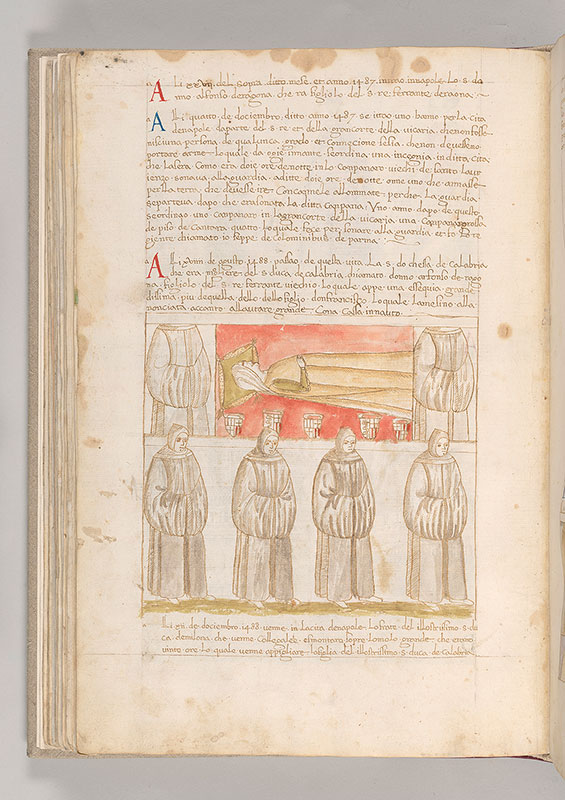
Fasciculus temporum
Cronaca della Napoli Aragonese: Scene, Death of Ippolita Maria Sforza -- The body of Ippolita Maria Sforza, Duchess of Calabria, veiled (?), head on pillow, reclines above row of heraldic escutcheons possibly including heraldry of Aragon and Sforza. She is flanked by torsos of two clerics. Four other clerics, wearing hoods, hands in sleeves, stand below.
MS M.801, fol. 99r
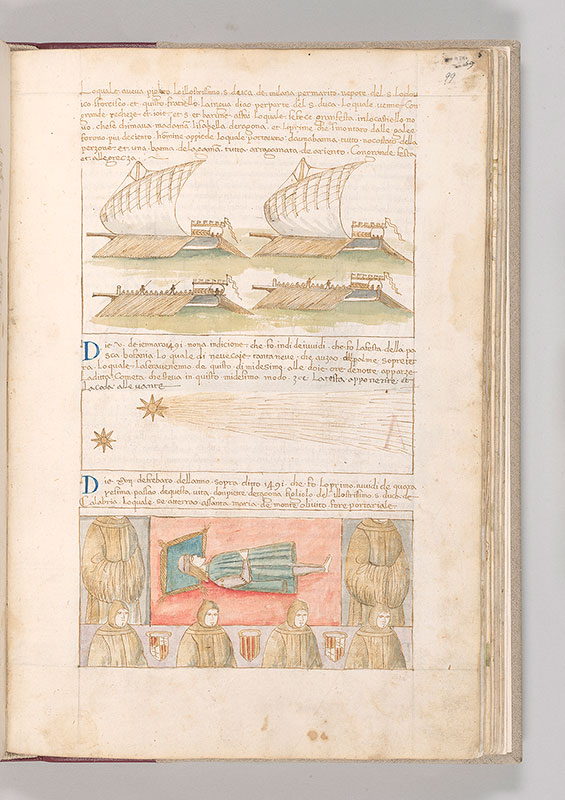
Fasciculus temporum
Cronaca della Napoli Aragonese: Scene, Isabelle of Aragon arriving in Milan -- Four galleys, two with sails, all with cabin at one end, each with line of banners on roof.
Cronaca della Napoli Aragonese: Scene, Comet of 1491 -- Two stars, one with tail.
Cronaca della Napoli Aragonese: Scene, Death of Pietro of Aragon -- Body of Pietro of Aragon, wearing hat, reclining with head on pillow, flanked by two torsos of clerics, with hands in sleeves. Below, half-figures of four monks, wearing hoods, alternating with three escutcheons decorated with heraldry possibly of Aragon and Calabria.
MS M.801, fol. 99v
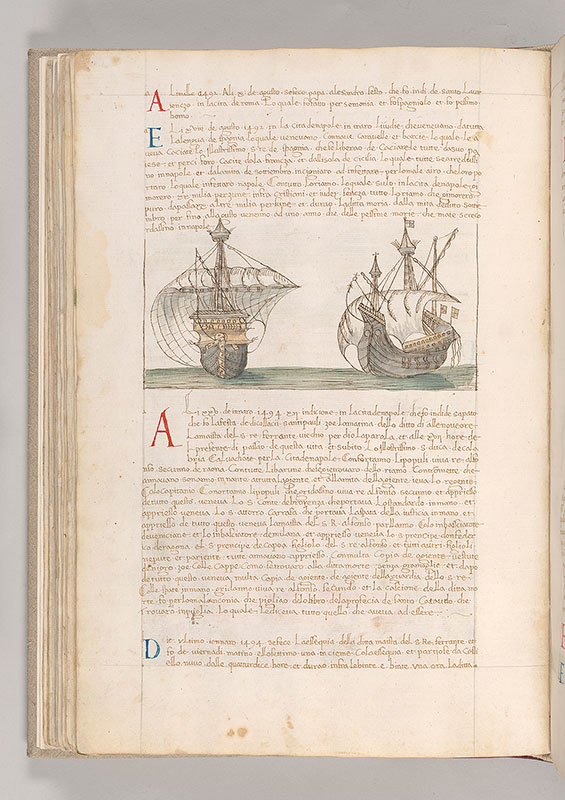
Fasciculus temporum
MS M.801, fol. 100r
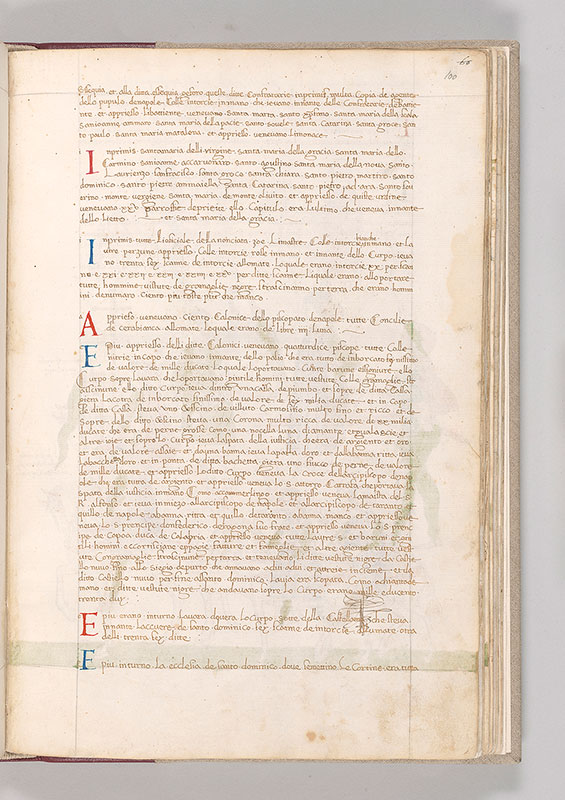
Fasciculus temporum
MS M.801, fol. 100v
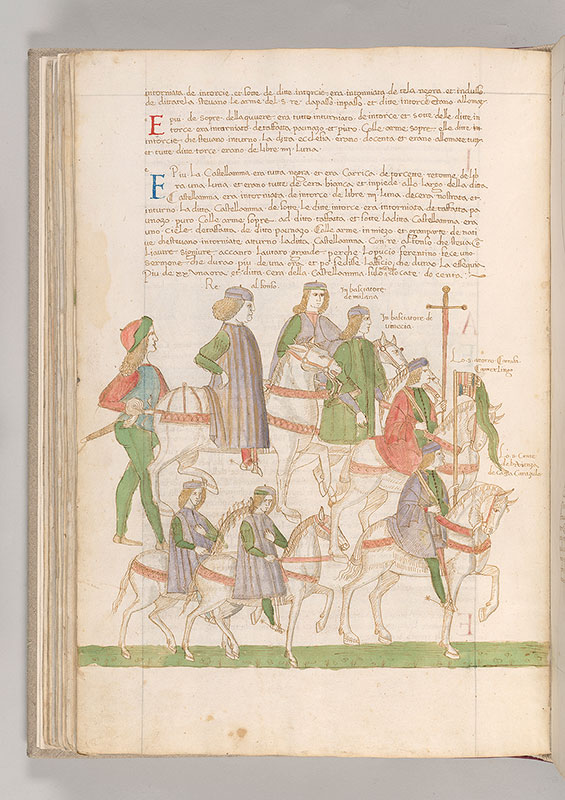
Fasciculus temporum
Cronaca della Napoli Aragonese: Scene, Funeral of Ferdinand I of Naples -- Man wearing hat, with sword at waist, follows seven horsemen, one carrying raised sword, grasping tip of blade with left hand, another carrying heraldic banner. Five are inscribed: Alfonso II of Naples who succeeded Ferdinand, RE ALFONSO; INBASCIATORE DE MILANA; INBASCIATORE DE UENECIA; Giovanni Antonio Carafa, LO SIGNOR ATTORRO CARRAFA CAMERLINGO; LO SIGNOR CONTE DE BRUIENZA DE CASA CARAZULO.
MS M.801, fol. 101r
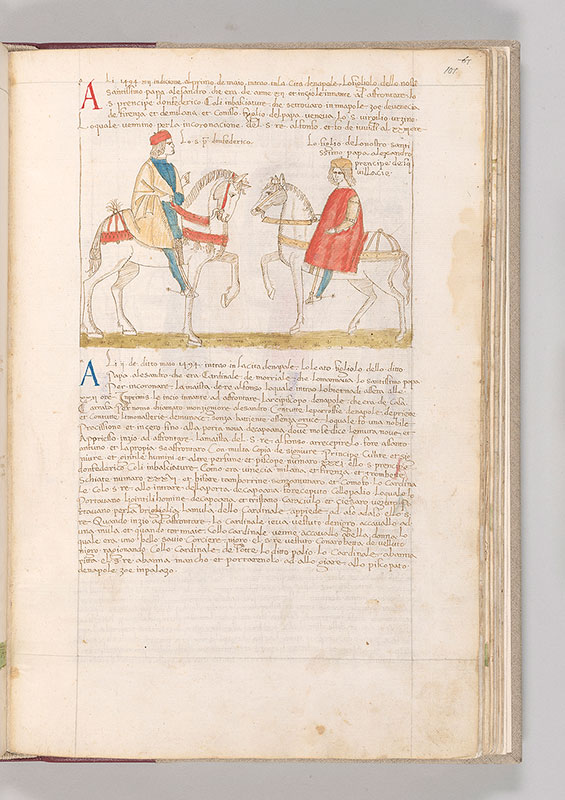
Fasciculus temporum
Two confronted horsemen, wearing hats and spurs, one Federico of Aragon inscribed LO SIGNOR PRENCIPE DON FEDERICO; the other, Goffredo Borgia inscribed LO FIGLIO DE LO NOSTRO SANTISSIMO PAPA ALEXANDRO PRENCIPE DE SQUILLACIE
MS M.801, fol. 101v
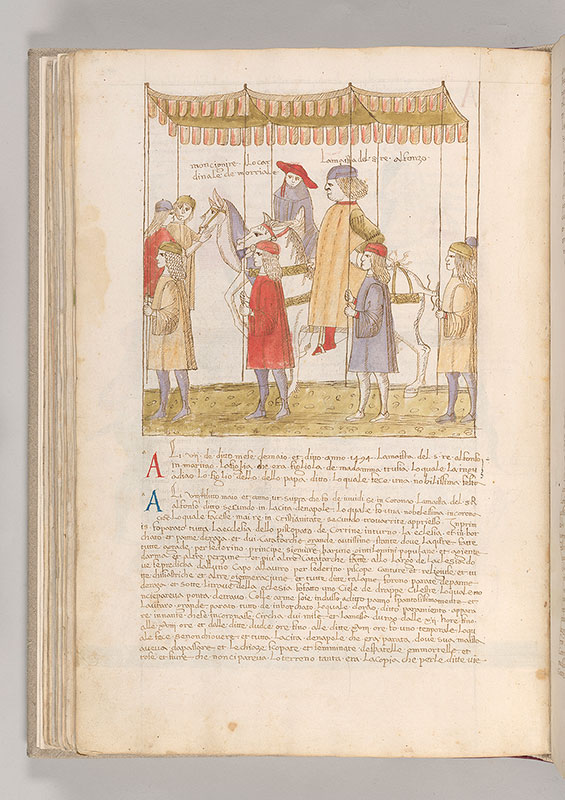
Fasciculus temporum
Cronaca della Napoli Aragonese: Scene, Coronation of Alfonso II of Naples -- Five men wearing hats, hold poles supporting canopy over two horsemen. Giovanni Borgia as cardinal, wearing cardinal's hat, is astride horse below inscription MONCIGNIRE LO CARDINALE DE MORRIALE. Two men, wearing hats stand at head of his horse. He rides next to Alfonso II, wearing hat, astride bridled horse below inscription LA MAISTA DEL SIGNOR RE ALFONZO.
MS M.801, fol. 102r
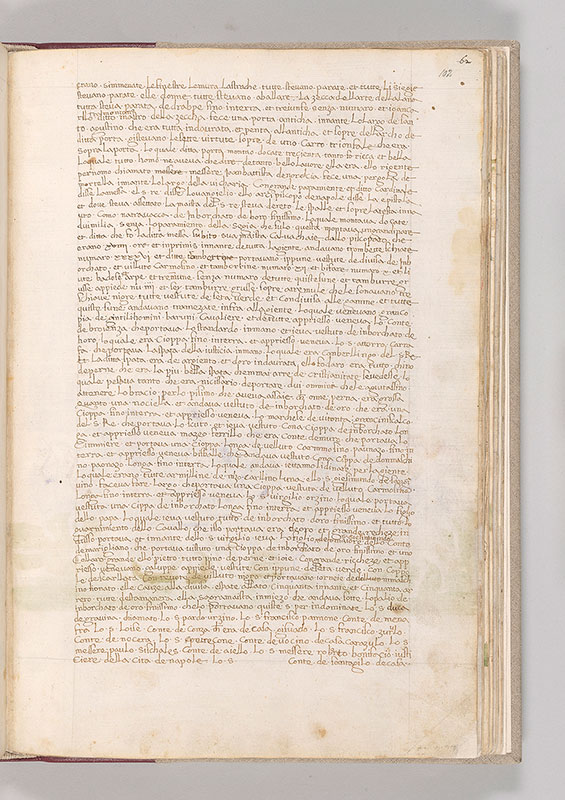
Fasciculus temporum
MS M.801, fol. 102v
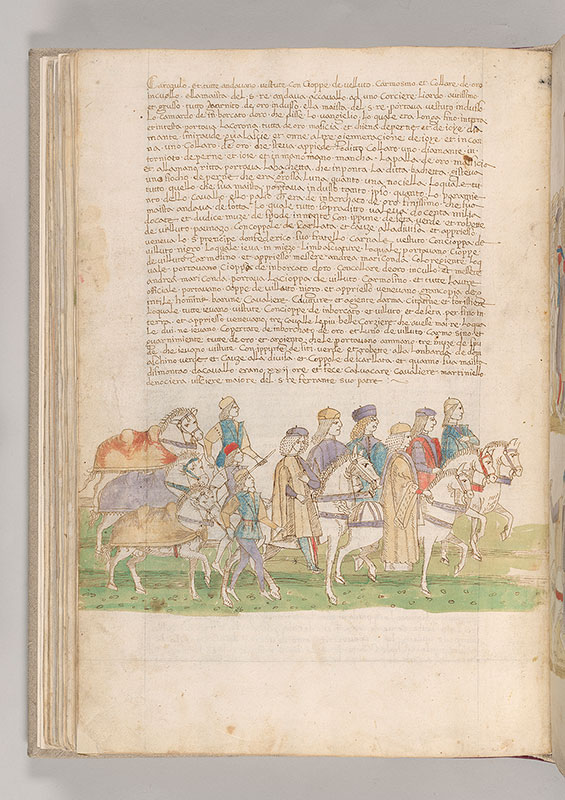
Fasciculus temporum
Cronaca della Napoli Aragonese: Scene, Coronation of Alfonso II of Naples -- Three men, wearing hats, holding rods with left hands, grasping reins of three horses with right hands, walk behind procession of six nobles, wearing hats, all astride bridled horses.
MS M.801, fol. 103r
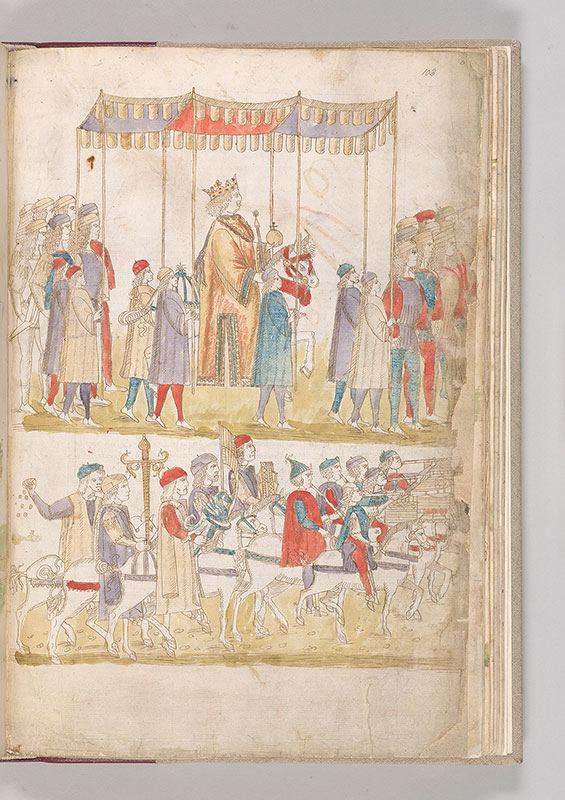
Fasciculus temporum
Cronaca della Napoli Aragonese: Scene, Coronation of Alfonso II of Naples -- In upper register, seven men wearing hats carry poles supporting canopy over Alfonso II of Naples, crowned, holding scepter with right hand, and cross-surmounted globe with left hand, possibly wearing chain of office around his neck, astride bridled horse. Alfonso and the canopy are flanked front and back by 16 (?) men wearing hats, some only partially visible.
In lower register, parade of horse men wearing hats, including man raising right arm, dropping coins (?) to ground; man carrying ornate sword, holding it upwards, with tip in right hand; another carrying plumed helmet; one with decorated banner; another with decorated shield; five or six men playing trumpets, three bannered.
MS M.801, fol. 103v
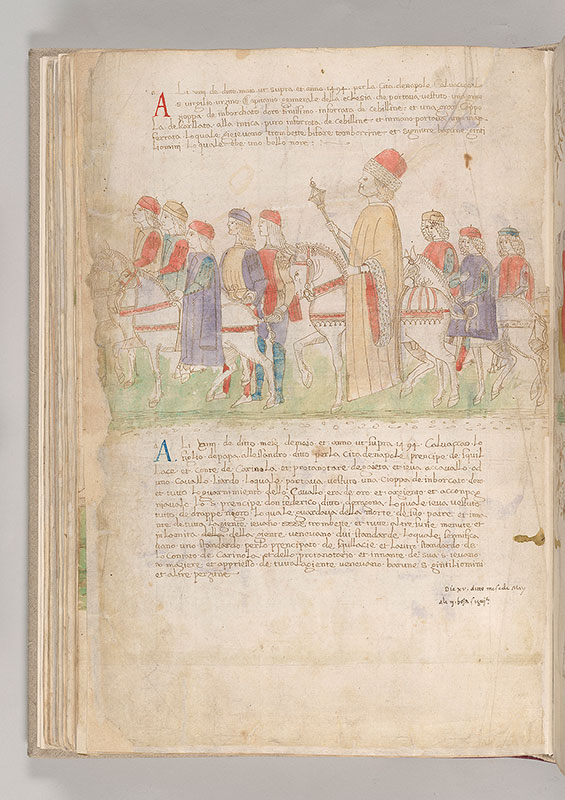
Fasciculus temporum
Cronaca della Napoli Aragonese: Scene, Coronation of Alfonso II of Naples -- Gentile Virginio Orsini, wearing hat, holding ceremonial mace with right hand, is astride horse, flanked by six (?) other horsemen and two men on foot, all wearing hats.
MS M.801, fol. 104r
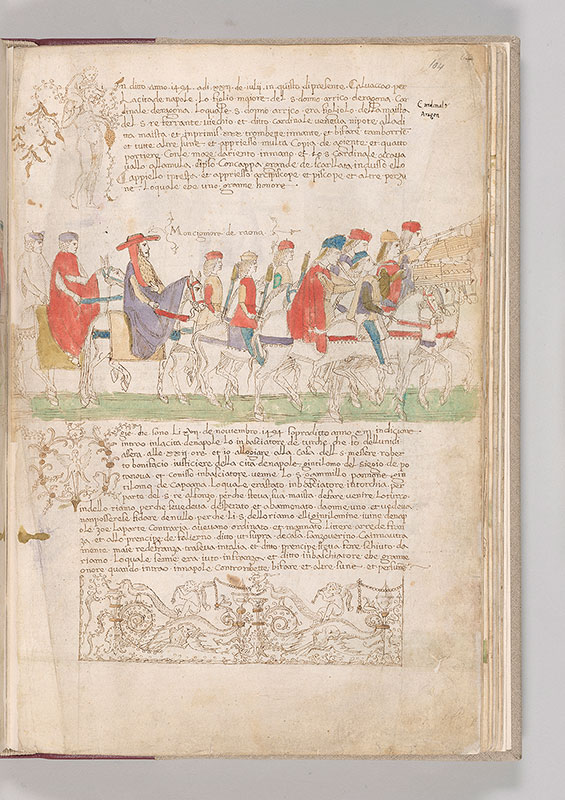
Fasciculus temporum
Cronaca della Napoli Aragonese: Scene, Louis of Aragon entering Naples -- Louis of Aragon, inscribed MONCIGNIORE DE RAONA, as cardinal wearing cardinal's hat, astride horse, is accompanied by ten other horsemen, three carrying ceremonial maces, five (?) blowing trumpets, three bannered.
In upper left margin, pen drawing of small nude figure climbing in shoulders of nude woman (?), grasping right ankle of the small figure with right hand, and vine with left hand, possibly as initial I. In lower left margin, initial O enclosing winged figure. In lower margin, repeated pattern including peacocks, masks, putti holding horns, fantastic animals, vases, all amid vines, garlands, and motif of swirling water (?).
MS M.801, fol. 104v
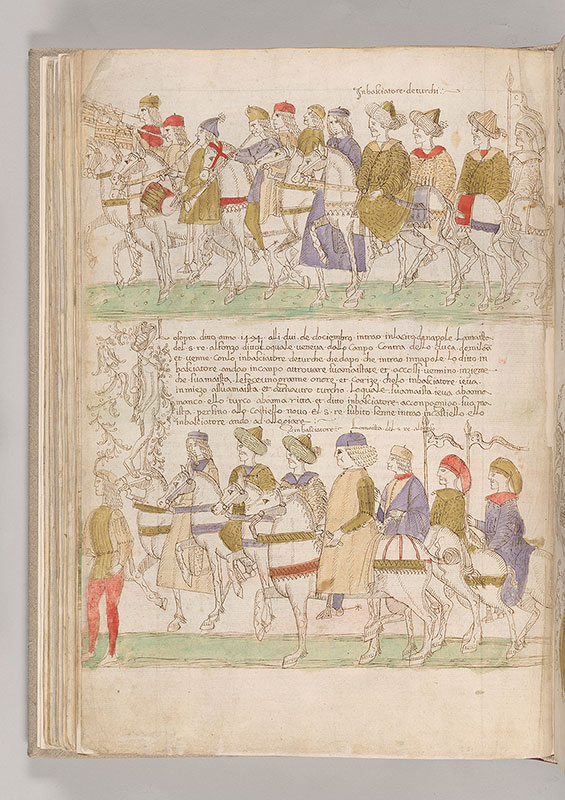
Fasciculus temporum
Cronaca della Napoli Aragonese: Scene, Ambassador of Turkey entering Naples -- Turkish ambassador, inscribed INBASCIATORE DE TURCHI, wearing turban-like hat, astride bridled horse, is accompanied by ten horsemen, three blowing trumpets, two bannered; one playing pipe and tabor; two others wearing turban-like hats; and one, wearing soft hat, carrying bannered lance.
Cronaca della Napoli Aragonese: Scene, Ambassador of Turkey entering Naples -- Below, man wearing hat walks before seven horsemen, three wearing hats, including Alfonso II of Naples inscribed LO MAISTA DEL S(IGNOR) RE ALFONSO; two wearing turban-like hats, including the Turkish ambassador inscribed INBASCIATORE; and two wearing soft hats, each carrying bannered lance.
In left margin, later addition (?), of nude figure, possibly woman, with long braided hair, wearing hat and sandles, standing on head of one of the horses.
MS M.801, fol. 105r
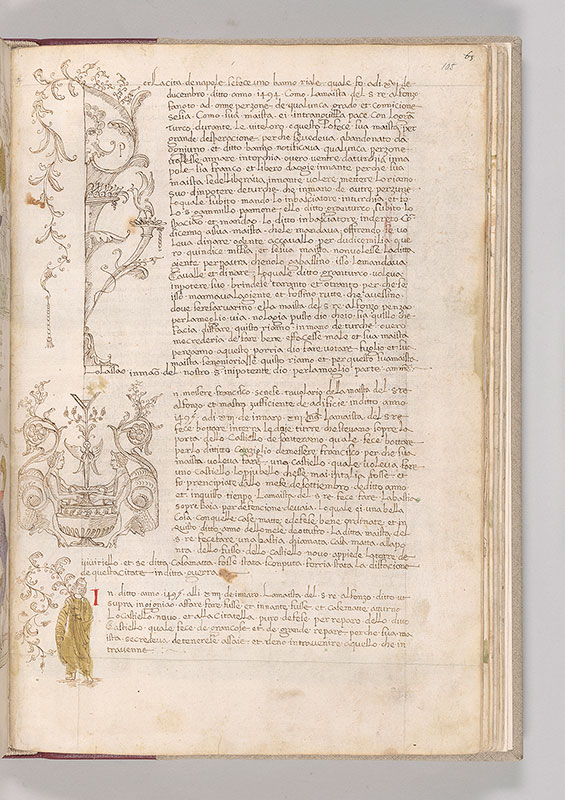
Fasciculus temporum
Enclosing initial P, half-mask on pedestal (?) with vine curling into left margin; bird perching on top of cornucopia or vase, at right.
Initial U of two hybrid men, bodies terminating with floreate vines, flanking fountain (?) with nude winged figure, foliate ornament emerging from head, standing in center.
Below, man wearing hat, holding vine with right hand, standing in left margin.
MS M.801, fol. 105v
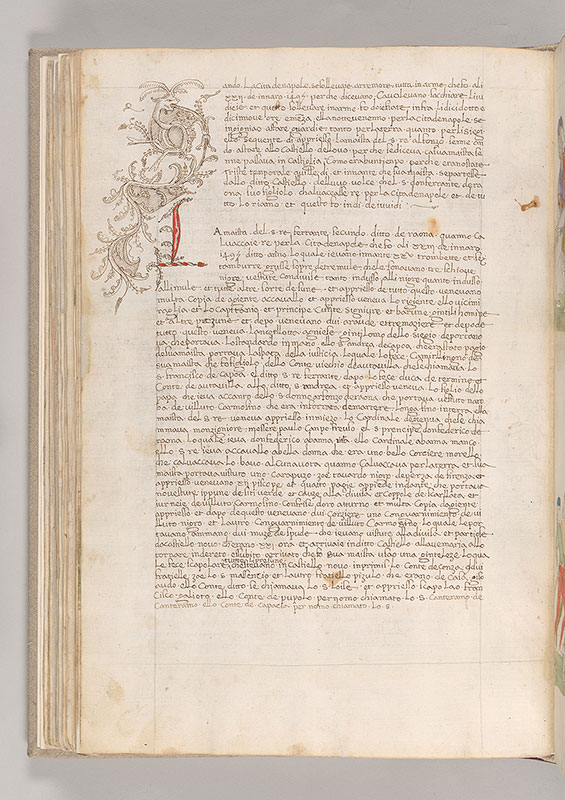
Fasciculus temporum
MS M.801, fol. 106r
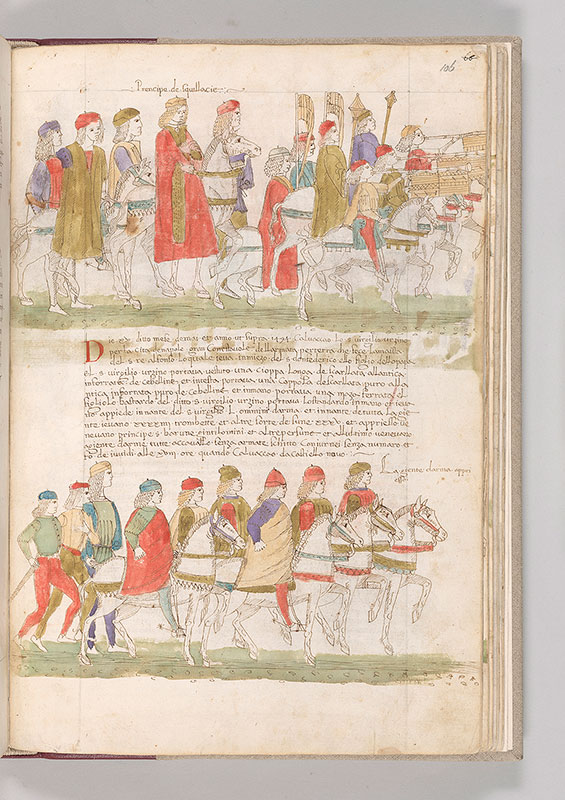
Fasciculus temporum
Cronaca della Napoli Aragonese: Scene, Goffredo Borgia entering Naples -- Goffredo Borgia, inscribed PRENCIPE DE SQUILLACIE, wearing hat, is astride bridled horse amid three men walking, and eight (?) horsemen, all wearing hats, two carrying banners, two with ceremonial maces and three blowing bannered trumpets.
Cronaca della Napoli Aragonese: Scene, Gentile Virginio Orsini entering Naples -- Part of procession or parade that continues on following folio, including three men on foot and six horsemen, all wearing hats, the foremost next to inscription LA GIENTE DARMA APPRIESSO.
MS M.801, fol. 106v
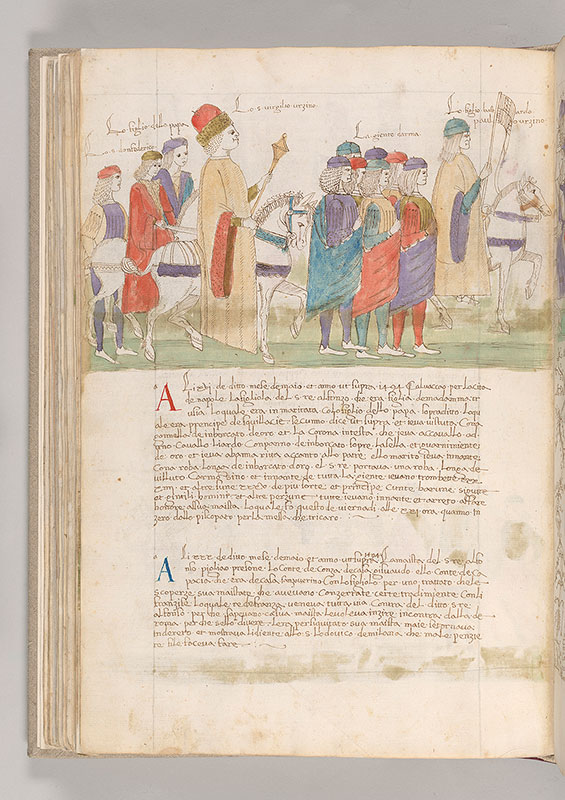
Fasciculus temporum
Cronaca della Napoli Aragonese: Scene, Gentile Virginio Orsini entering Naples -- Gentile Virginio Orsini, inscribed LO SIGNOR UIRGILIO URZINO, wearing hat, holding mace of office with left hand is astride bridled horse. He rides amid several men wearing hats, group of seven inscribed LA GIENTE DARMA, and three horsemen wearing hats, including, Goffredo Borgia, inscribed LO FIGLIO DELLO PAPA, Federico of Aragon inscribed LO SIGNOR DON FEDERICO, and Paolo Orsini, at the head of the procession, inscribed LO FIGLIO BASTARDO PAULO URZINO, carrying banner decorated with heraldry of Aragon.
MS M.801, fol. 107r
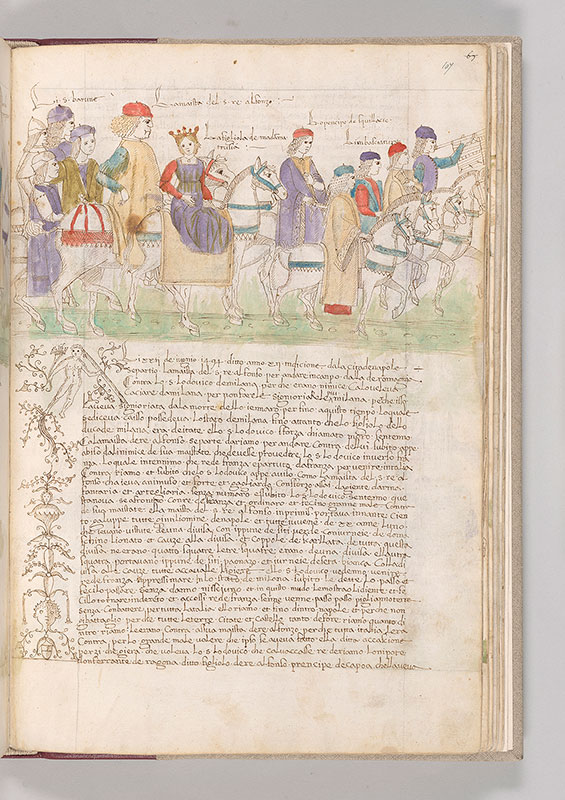
Fasciculus temporum
Cronaca della Napoli Aragonese: Scene, Marriage of Goffredo Borgia and Sancha of Aragon -- Sancha of Aragon, inscribed LA FIGLIOLA DE MADAMMA TRUSIA, crowned, is seated sideways on bridled horse, riding between her father Alfonso II of Naples, inscribed LA MAISTA DEL SIGNOR RE ALFONZO, and Goffredo Borgia, inscribed LO P[R]ENCIPE DE SQUILLACIE, wearing hat, astride bridled horse. They ride amid nine horsemen wearing hats, including one inscribed LI SIGNOR BARUNE; one holding shield next to inscription LIMBASCIATURE; and another blowing bannered trumpet.
In left margin, nude woman (?) as part of initial A atop structure of vines, heads or masks, and escutcheon.
MS M.801, fol. 107v
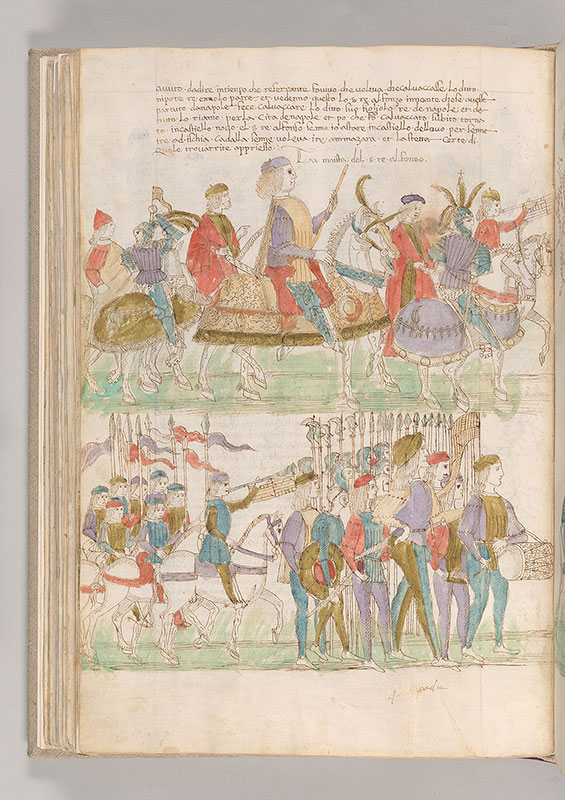
Fasciculus temporum
Cronaca della Napoli Aragonese: Scene, Alfonso II of Naples leaving Naples -- Alfonso, inscribed LA MAISTA DEL SIGNOR RE ALFONSO, wearing hat, holding scepter with left hand, is astride caparisoned horse, riding amid nine other horsemen, four wearing hats; two wearing armor astride caparisoned horses; one holding banner, another blowing bannered trumpet.
Below, seven horsemen, wearing hats, hold bannered lances; another blowing bannered trumpet. Of several men, some wear armor, many hold spear or halberd, one carries shield, two wear swords, one carries banner, and the foremost beats drum.
MS M.801, fol. 108r
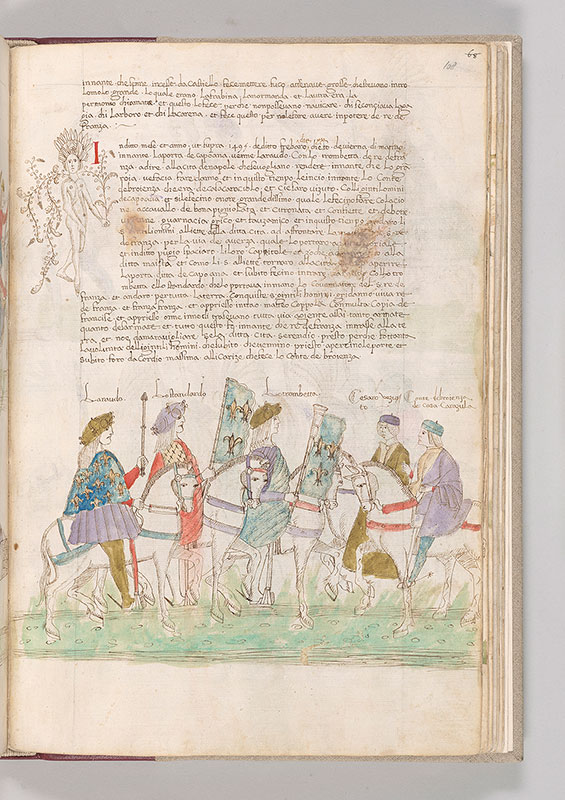
Fasciculus temporum
Cronaca della Napoli Aragonese: Scene, French entering Naples -- Of three heralds wearing hats, all astride bridled horses with trappings, one, wearing garment decorated with heraldry of France raises with left hand, scepter inscribed LARAUDO; the second, carries with right hand, banner decorated with heraldry of France (Modern), inscribed LO STANDARDO; and the third carries with right hand, trumpet, inscribed LO TROMBETTA, with banner decorated with heraldry of France (Modern). They approach two horsemen wearing hats, Cesare Bozzuto, inscribed CESARO BEZUTO and Giacomo Caracciolo as CONTE DE BROIENZA DE CASA CARAZULA.
In left margin, nude woman wearing feathered or leafy headdress and shoes, grasping vine with left hand, standing next to initial I.
MS M.801, fol. 108v
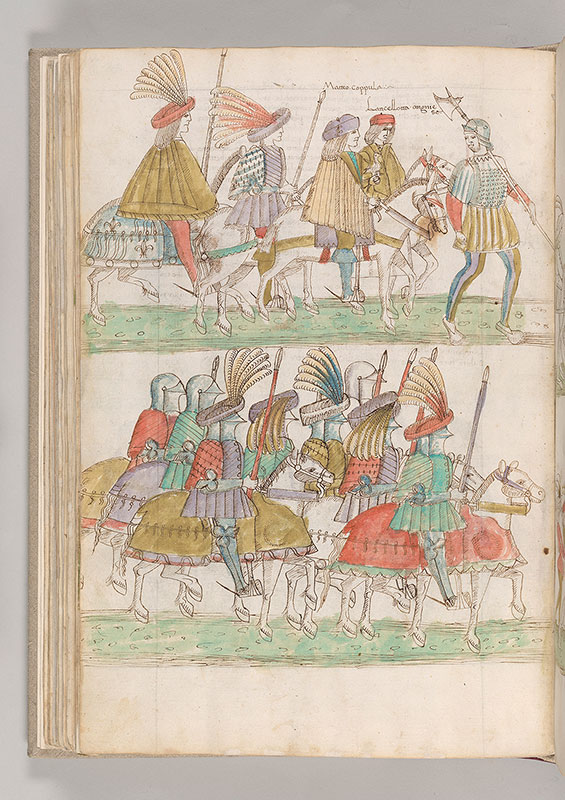
Fasciculus temporum
Cronaca della Napoli Aragonese: Scene, French entering Naples -- Parade of French and Italian officials, four astride horses, including two wearing plumed hats carrying lances, one horse wearing caparison decorated with fleur-de-lis; two wearing hats, Matteo Coppola, with bird perching on left hand below inscription MATTEO COPPULA and Lancelotto Agnese, inscribed LANCELLOTTA ANGNEISE. Soldier wearing helmet and armor, carrying halberd on left shoulder walks before the horsemen.
Below, eight soldiers or knights, five wearing plumed hats on helmets, six holding lances, are astride horses, five caparisoned.
Parade is continued on following page.
MS M.801, fol. 109r
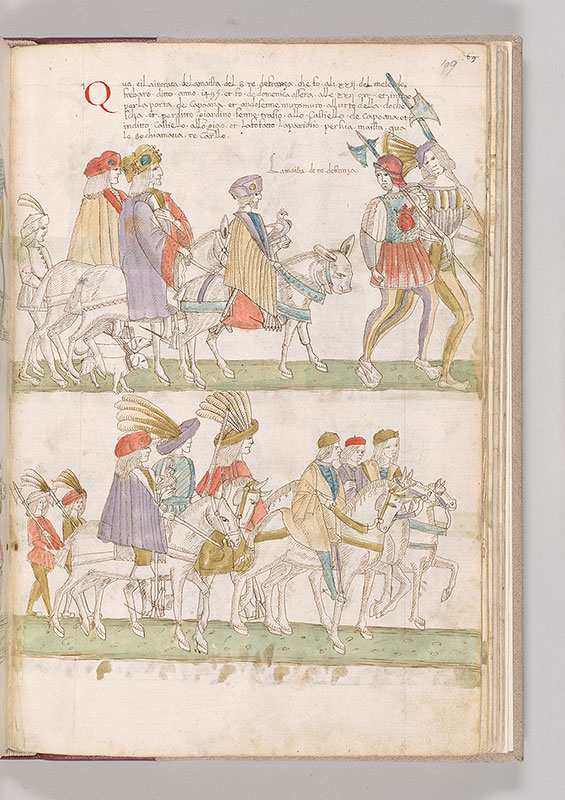
Fasciculus temporum
Cronaca della Napoli Aragonese: Scene, French entering Naples -- Youthful figure walks behind two men, wearing bejeweled hats, astride bridled horses; dogs are below. Charles VIII, king of France, inscribed LA MAISTA DE RE DE FRANZA, wearing bejeweled hat, falcon on left hand is astride ass (?) with trappings. Two soldiers carrying halberds, one wearing breastplate with initial S enclosed in medallion surmounted by crown, walk before the riders.
Below, two soldiers, wearing hats with plumes, carrying halberds walk behind six horsemen wearing hats, two with plumes. One carries bird on left wrist.
MS M.801, fol. 109v
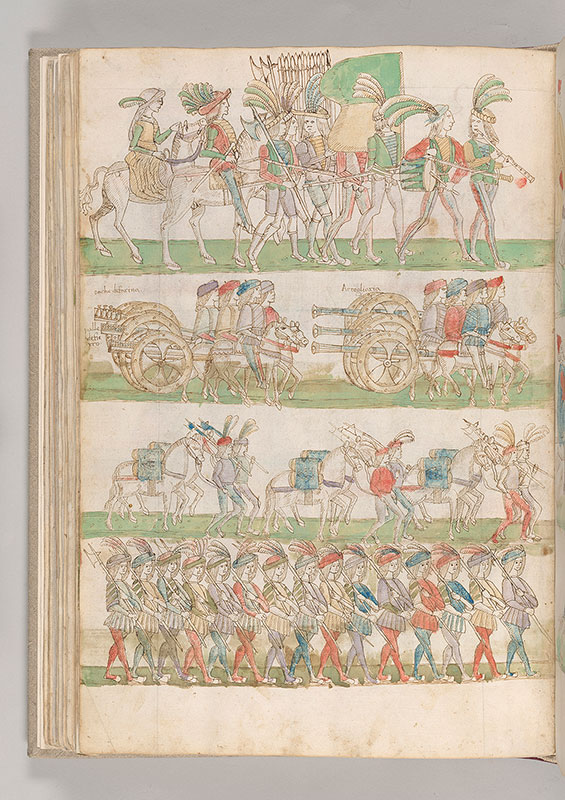
Fasciculus temporum
Cronaca della Napoli Aragonese: Scene, French entering Naples -- Continues parade of previous folios in four registers:
1) Woman (?) wearing headdress possibly sitting sideways; eight men, wearing plumed hats, one, wearing sword at waist, astride horse; one carrying halberd, wearing sword at waist; two wearing swords at waists, one carrying banner; one playing drum; the foremost, wearing sword at waist, playing cornetto.
2) Three two-wheeled carts, drawn by three (?) horses, four men wearing hats possibly astride the horses. One cart carries sacks inscribed SACHE DE FARINA; second cart inscribed PALLE DE FIERRO. At right, three cannons on two-wheeled carts, inscribed ARTEGLIARA, drawn by three (?) horses, four men wearing hats possibly astride the horses.
3) Three pairs of bridled, pack-horses, each led by man wearing plumed hat, grasping reins with right hand, carrying halberd on left shoulder.
4) At bottom, line of 15 men wearing plumed hats, each carrying halberd on right shoulder, walking to right.
MS M.801, fol. 110r
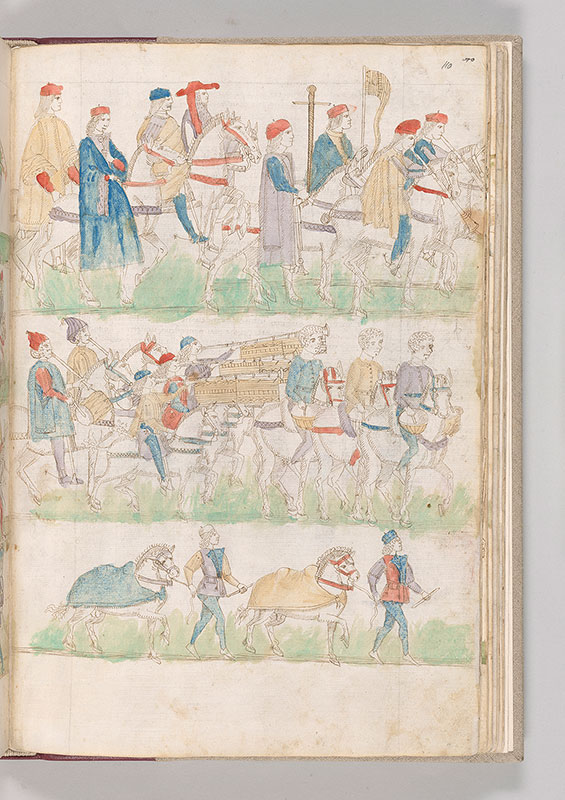
Fasciculus temporum
Cronaca della Napoli Aragonese: Scene, Ferdinand II entering Naples -- Parade in three registers:
1) Of eight horsemen wearing hats, one wears cardinal's hat; another carries raised sword grasping tip with right hand; one carries banner decorated with heraldry of Aragon; two blow trumpets.
2) Of eight horsemen, five wearing hats; two play pipe and tabor; three blow trumpets with banners; three play pairs of nakers (drum).
3) At bottom, two men wearing hats, walk holding rod with left hand, and grasping with right hands, reins of two draped, bridled horses.
MS M.801, fol. 110v
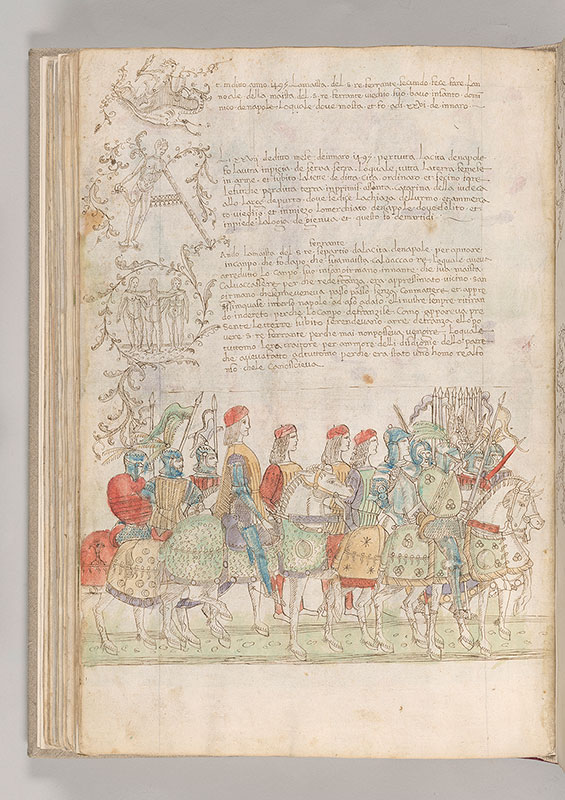
Fasciculus temporum
Cronaca della Napoli Aragonese: Scene, Ferdinand II of Naples departing to confront Charles VIII of France -- Ferdinand II, wearing hat and armor is astride caparisoned horse. He is surrounded by soldiers wearing plumed helmets and armor, some astride caparisoned horses, some possibly on foot, carrying swords, lances or spears, some bannered.
In left margin, cyclops holding club with right hand and shield with left, confronting dragon with bird beak; nude figure forming part of initial A, decorated with vining ornament; three nude women, one back-turned, enclosed in initial Q composed of leafy vine.
MS M.801, fol. 111r
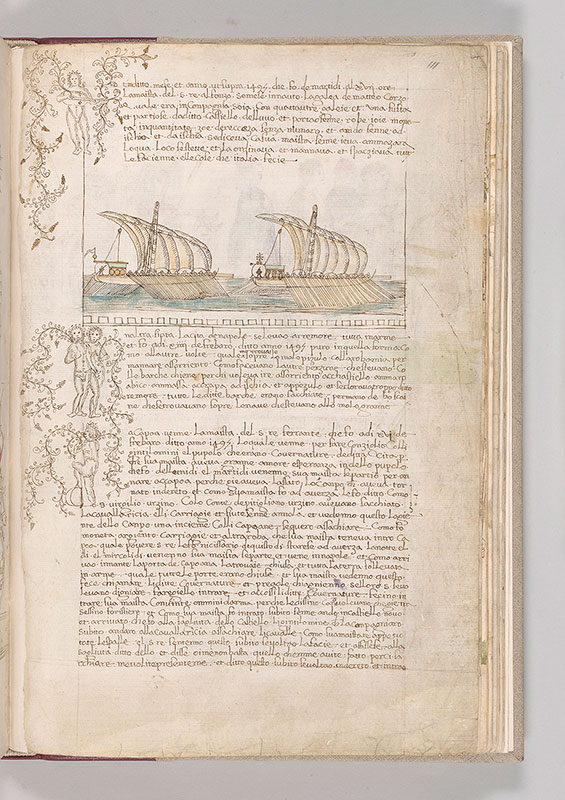
Fasciculus temporum
Cronaca della Napoli Aragonese: Scene, Abdication of Alfonso II of Naples -- Two galleys with many oarsmen, at sea.
In left margin, initial E with nude man playing guitar from which leafy vines sprout; two nude men flanked by leafy vines as initial U; back view of nude man, climbing, flanked by vines, as initial D.
MS M.801, fol. 111v
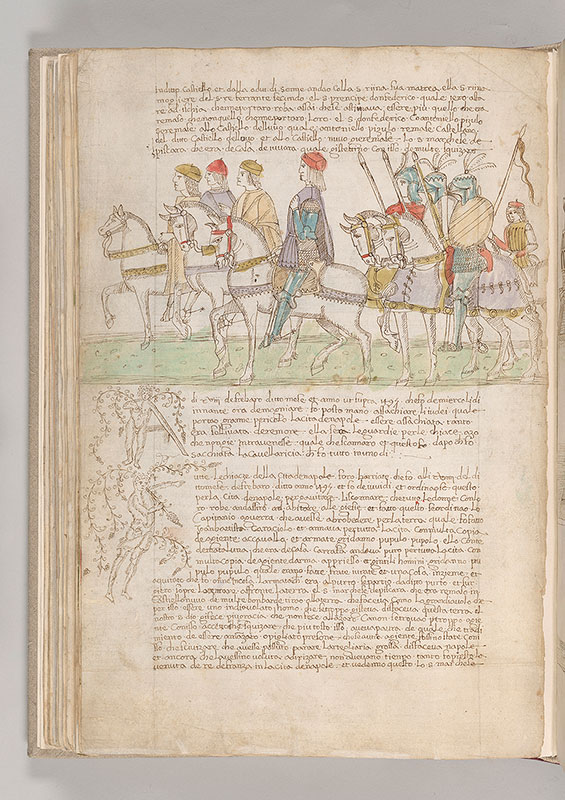
Fasciculus temporum
Cronaca della Napoli Aragonese: Scene, Ferdinand II of Naples entering Naples -- Ferdinand II, wearing hat and armor, astride bridled horse with trappings, rides amid seven other horsemen, including four wearing hats, one holding bannered lance, and three soldiers wearing plumed helmets, holding lances, one holding shield, two astride caparisoned horses.
In left margin, nude man, sprouting grape vines, as part of initial A; nude man sprouting vines, grasping vine with grapes with right hand, indicating text with left hand, as initial T.
MS M.801, fol. 112r
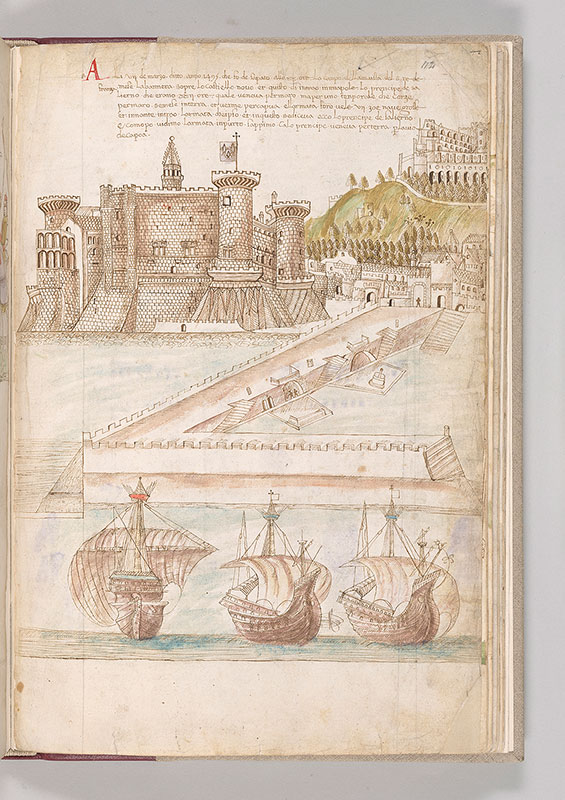
Fasciculus temporum
Cronaca della Napoli Aragonese: Scene, French Flag flying over Castel Nuovo -- Castel Nuovo, tower surmounted by flag decorated with three fleur-de-lis. Harbor in foreground with three ships. Buildings of city in background and on hill.
MS M.801, fol. 112v
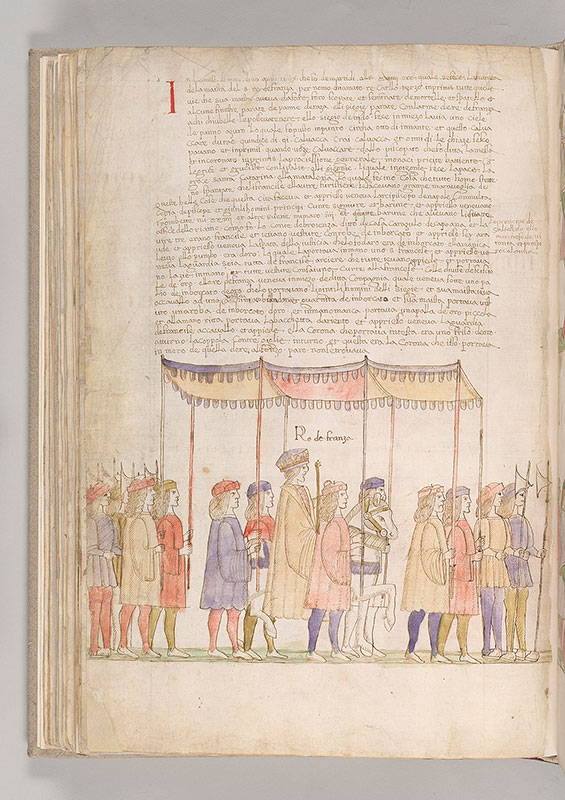
Fasciculus temporum
Cronaca della Napoli Aragonese: Scene, Procession of Charles VIII of France--- Charles inscribed RE DE FRANZA, wearing crown on hat, holding scepter with right hand, is astride bridled horse with trappings, riding below canopy carried by eight men wearing hats. Six (?) men wearing hats, carrying halberds flank the canopy.
MS M.801, fol. 113r
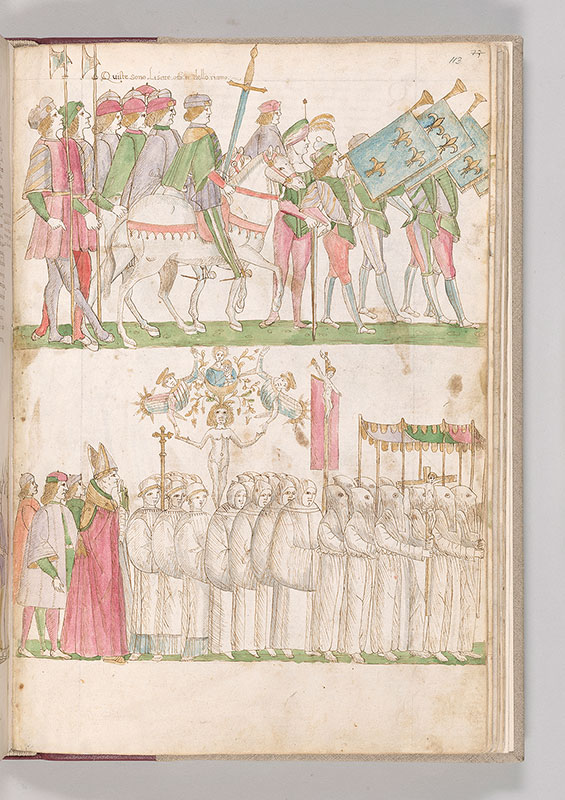
Fasciculus temporum
Cronaca della Napoli Aragonese: Scene, Procession of Charles VIII of France -- In upper register, nine men, two carrying halberds, follow two horsemen astride bridled horses with trappings, one holding tip of upturned sword. Leading the procession are man wearing plumed hat, and four men blowing bannered trumpets decorated with heraldry of France (azure, three fleur-de-lis or). All wear hats.
In lower register, three men, wearing hats, follow bishop, wearing miter and cope, raising right hand in blessing. He is preceded by three groups of clergy: clerics, tonsured or wearing caps, one carrying processional cross; monks (?) wearing hoods, one carring banner with crucifix; and leading the procession, confraternity members, wearing full hoods, covering faces, eight carrying poles of canopy under which one member carries crucifix.
Above the procession, statue of nude woman, arms extended, each hand touching hand of one of two angels, nimbed, raising other hands. Grapevines emerging from head of the statue, below crescent in which is bust of Virgin Mary, holding Christ Child, both nimbed.
MS M.801, fol. 113v
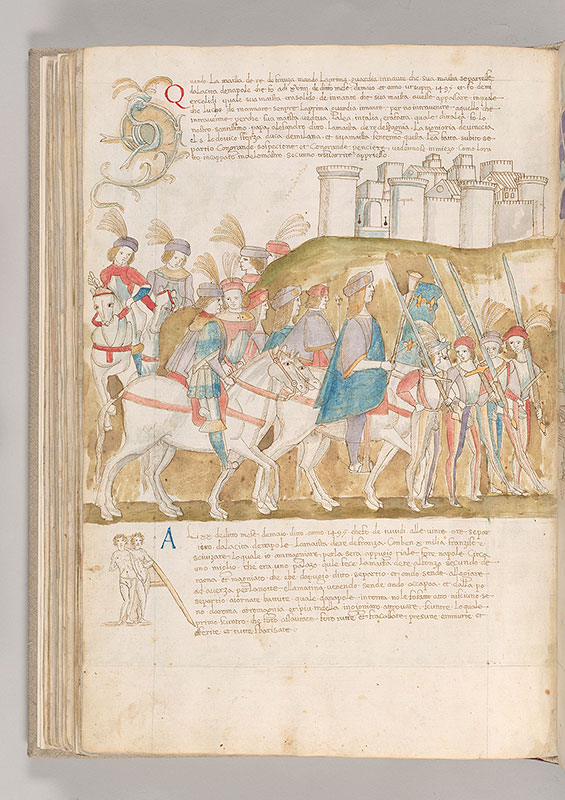
Fasciculus temporum
Cronaca della Napoli Aragonese: Scene, French Vanguard passing Capua -- Of ten horsemen, six wearing plumed hats, two only partially visible, one carrying scepter, the foremost holds with right hand, bannered trumpet decorated with French heraldry (azure, three fleur-de-lis or). Four men, wearing plumed hats, carrying swords, lead the group. City of Capua, labelled CAPUA, is on hill in background.
Initial A, one upright of two nude figures, man wearing drawers, and nude woman. Beginning of text for miniature on following folio (114r).
MS M.801, fol. 114r
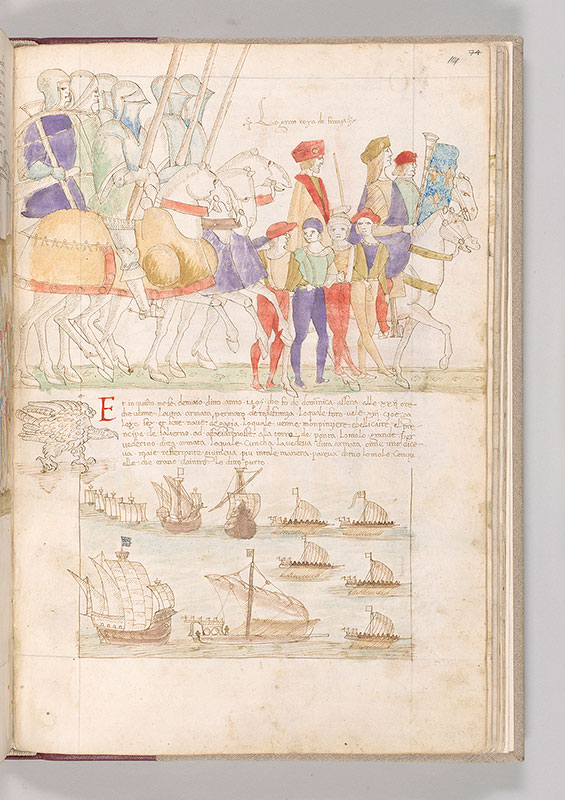
Fasciculus temporum
Cronaca della Napoli Aragonese: Scene, Charles VIII leaving Naples -- In upper miniature, Charles VIII, inscribed LO GRAN ROYA DE FRANZA, wearing hat, holding rod, possibly astride horse, is surrounded by six (?) soldiers wearing helmets and armor, astride bridled, caparisoned horses, one carrying cross-bow, three holding lances; four men possibly courtiers, wearing hats, walking; and two horsemen wearing hats, one carrying bannered trumpet decorated with French heraldry (azure, three fleur-de-lis or).
In lower margin, fleet of French ships, one with banner decorated with French heraldry (azure, three fleur-de-lis or).
Eagle in left margin.
MS M.801, fol. 114v
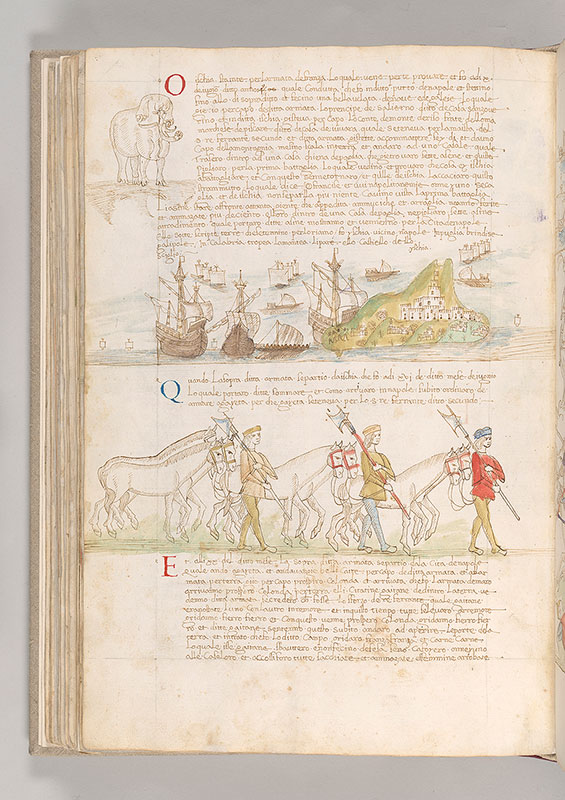
Fasciculus temporum
Cronaca della Napoli Aragonese: Scene, French Expedition to Ischia -- In upper miniature, ships around island labelled YSCHIA, on which are buildings and four figures. In lower miniature, three men wearing hats, carrying halberds on right shoulders, walk, each holding reins to pair of horses.
Elephant in upper left margin.
MS M.801, fol. 115r
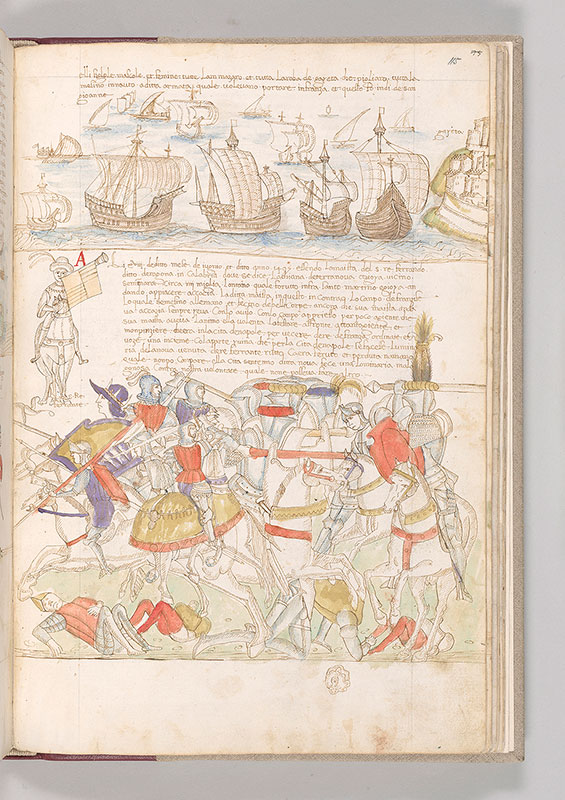
Fasciculus temporum
Cronaca della Napoli Aragonese: Scene, French Armada at Gaeta -- Seventeen (?) ships, some on horizon, approaching city of Gaeta inscribed GAYETA.
Cronaca della Napoli Aragonese: Scene, Battle at Seminara -- At left, Ferdinand II of Naples, inscribed LO S(IGNOR) RE FERRANTE, wearing crown on hat, and soldier holding lance, both astride horses, ride away from two confronted groups of soldiers astride horses, one caparisoned, fighting with swords and lances. Bodies and parts of bodies are on ground.
Man wearing plumed hat, blowing bannered trumpet decorated with heraldry, astride bridled horse with trappings in left margin.
MS M.801, fol. 115v
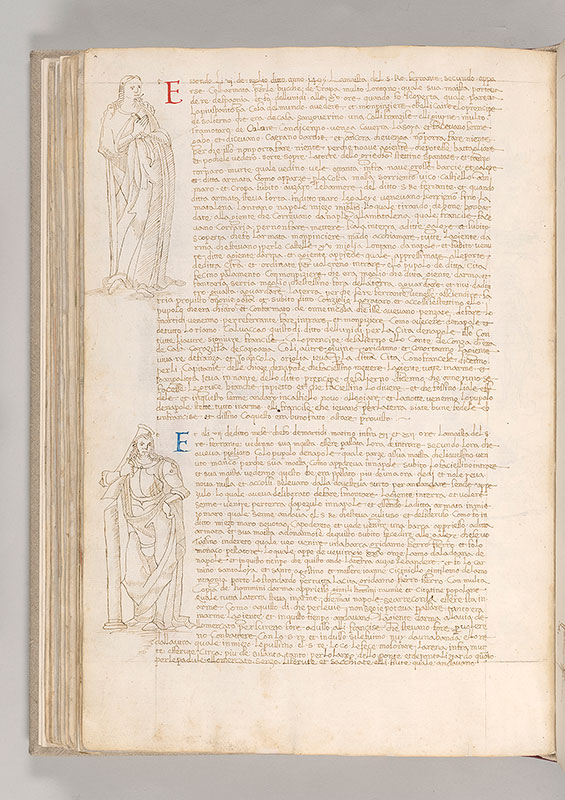
Fasciculus temporum
In left margin, woman with joined hands, standing. Below, man wearing armor, right arm around top half of broken column.
MS M.801, fol. 116r
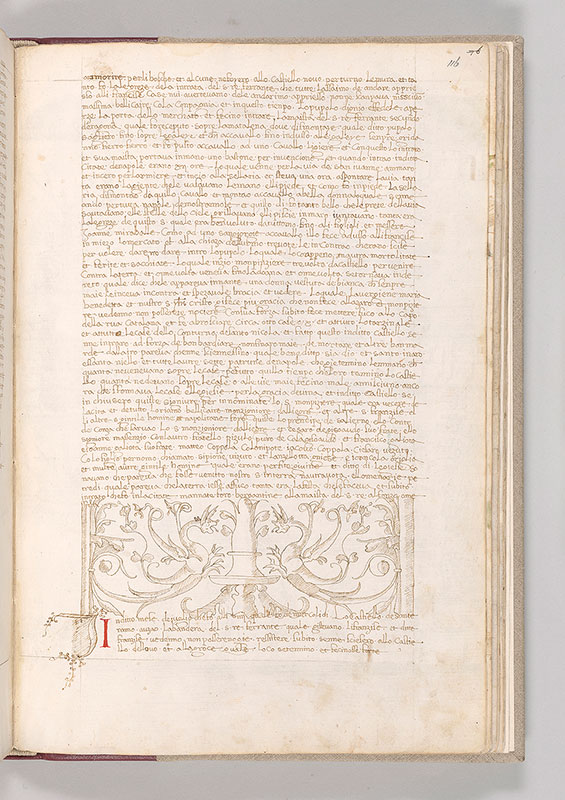
Fasciculus temporum
MS M.801, fol. 116v
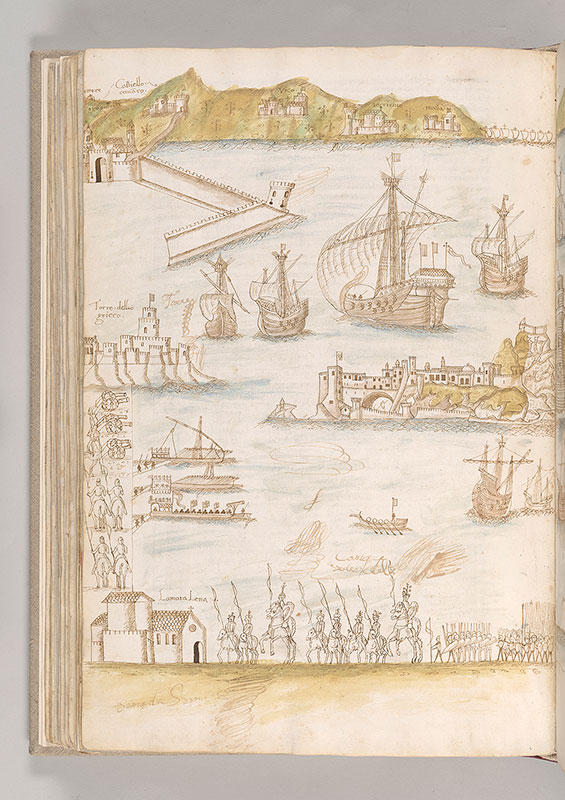
Fasciculus temporum
MS M.801, fol. 117r
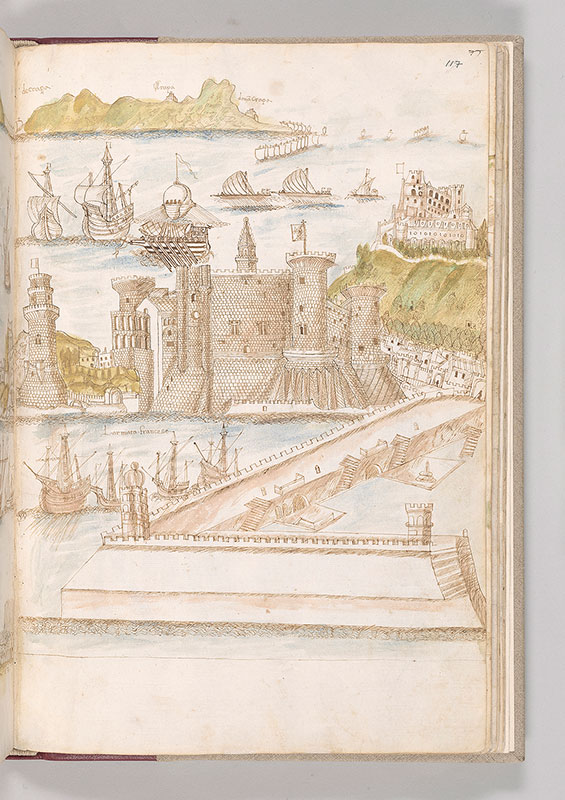
Fasciculus temporum
MS M.801, fol. 117v
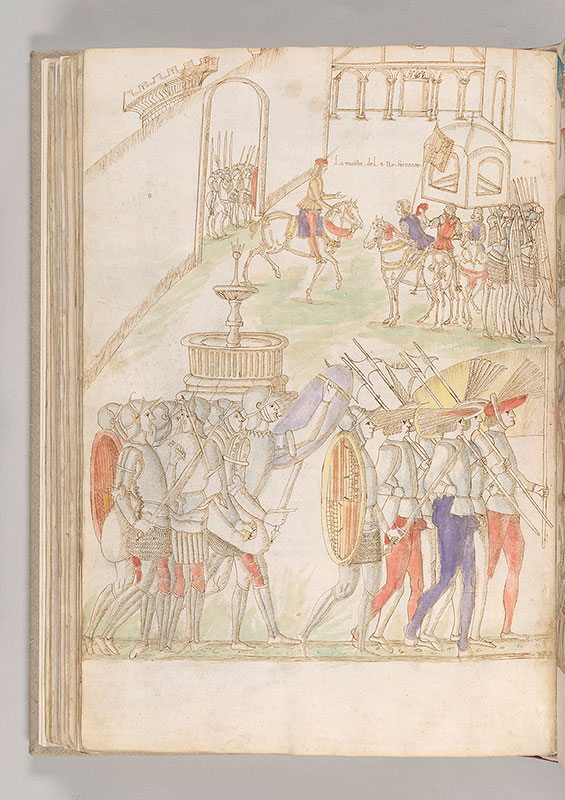
Fasciculus temporum
Cronaca della Napoli Aragonese: Scene, Liberation of Naples -- Ferdinand II of Naples, inscribed LA MAISTA DE LO SIGNOR RE FERRANTE, wearing hat, holding rod with right hand and extending left hand, is astride bridled horse entering courtyard, approaching horseman holding hat with left hand and with right hand, banner decorated with heraldry of Aragon. Two other horsemen are nearby, one raising hat with right hand.
In the courtyard is arcade with pediment, wellhead (?), and fountain. Soldiers wearing helmets and armor are in the courtyard, some holding swords and shields possibly decorated with heraldry of Aragon; others, wearing plumed hats, carry halberds. At entrance, soldiers stand holding swords or spears, one with shield, one astride horse holding lance.
MS M.801, fol. 118r
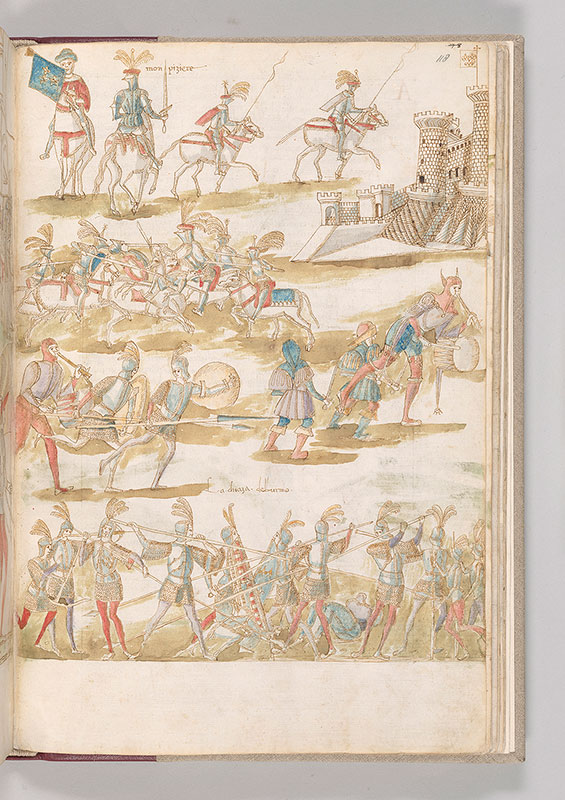
Fasciculus temporum
Cronaca della Napoli Aragonese: Scene, Liberation of Naples -- Horseman, wearing hat, blows bannered trumpet decorated with heraldry of France (azure, three fleur-de-lis or) next to Gilbert de Bourbon, count of Montpensier, inscribed MONPIZIERE, wearing plumed helmet and armor, holding raised sword with right hand, astride back-turned horse. Two other soldiers astride horses, holding bannered (?) lances with right hand move right toward Castel Nuovo, with banner decorated with heraldry of France.
Below, two confronted groups of soldiers astride horses, gallop toward each other, lances raised. Man wearing hood plays pipe and tabor behind two running soldiers holding spears and shields; at right two men holding knives stand behind tall man as fool, wearing horned hood, his clothes possibly decorated with bells, playing pipe and tabor.
At bottom, of soldiers fighting, two arm crossbow, one placing bolt on the bow; others fight with spears; two have shields, one decorated with heraldry of Aragon, the other with heraldry of France, one holding sword; headless body is on ground. Above the soldiers is inscription LA CHIAZA DE BURMO.
MS M.801, fol. 118v
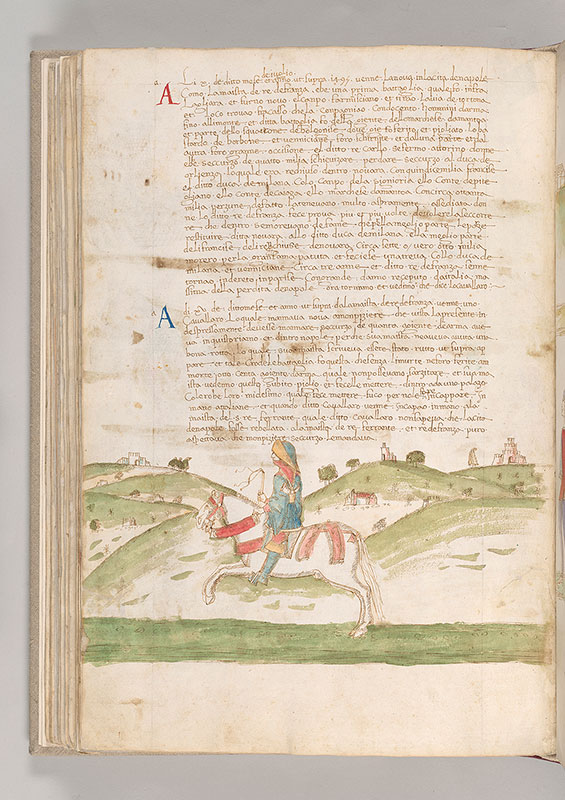
Fasciculus temporum
Cronaca della Napoli Aragonese: Scene, Liberation of Naples -- Man wearing hood, horn on strap on his back, holding reins with left hand and scourge with right hand is astride bridled horse with trappings, galloping through landscape with buildings.
MS M.801, fol. 119r
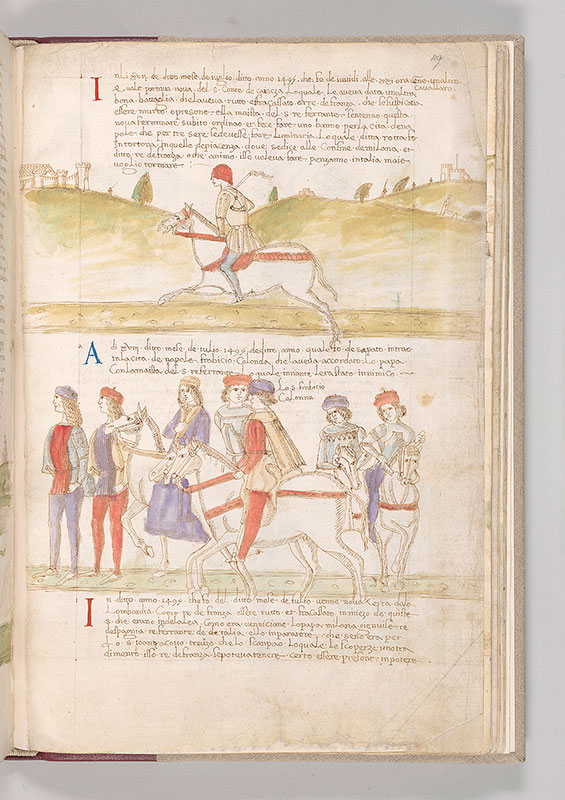
Fasciculus temporum
Cronaca della Napoli Aragonese: Scene, Liberation of Naples -- Man wearing hat, horn hanging from strap on his back, grasping reins with left hand, raising riding crop or whip with right hand (?), is astride horse galloping through landscape with buildings, figures, trees.
Cronaca della Napoli Aragonese: Scene, Liberation of Naples -- Fabrizio Colonna, inscribed LO S(IGNOR) FRABICIO COLONNA, wearing hat, is astride bridled horse with trappings. He is accompanied by four other horsemen, wearing hats. At left, two men precede them on foot.
MS M.801, fol. 119v
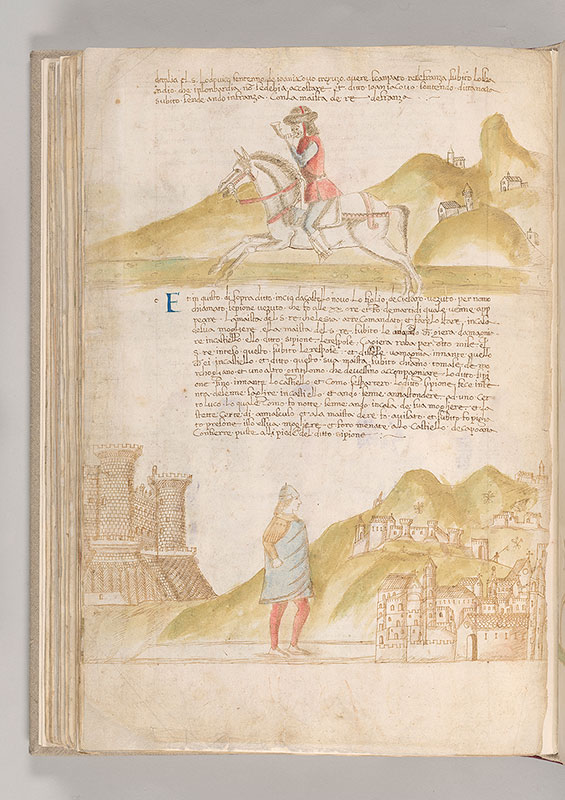
Fasciculus temporum
Cronaca della Napoli Aragonese: Scene, Liberation of Naples -- Man, wearing hat, blowing horn, astride bridled horse, purse next to the saddle, galloping through landscape with buildings and hills.
Cronaca della Napoli Aragonese: Scene, Liberation of Naples -- Below, man wearing cap, walks away from Castel Nuovo toward city of Naples.
MS M.801, fol. 120r
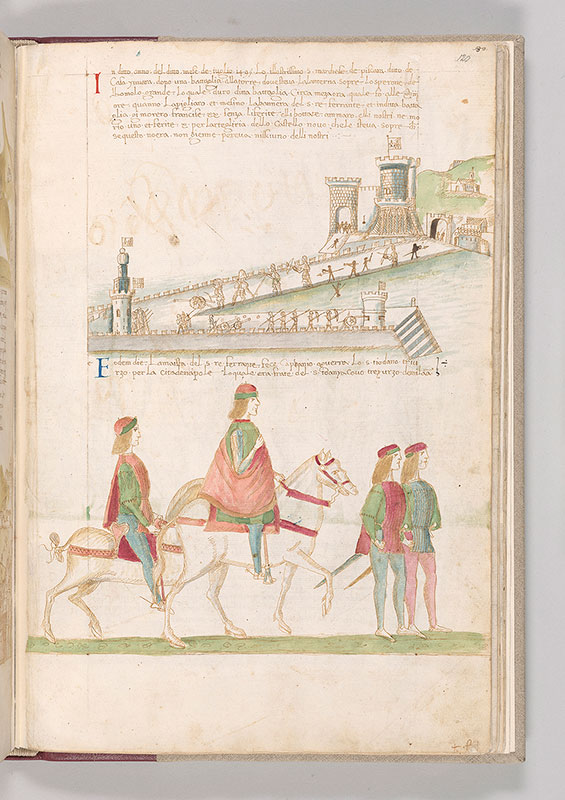
Fasciculus temporum
Cronaca della Napoli Aragonese: Scene, Liberation of Naples -- In background, flag with heraldry of France flies above tower of Castel Nuovo. In foreground, on castle wall or on pier, soldiers stand holding weapons including crossbows, guns, spears, sword; soldiers also stand next to cannons, two firing cannon balls toward approaching soldiers. Tower at far left surmounted by French flag; flag of Aragon flies part way up the tower.
Cronaca della Napoli Aragonese: Scene, Liberation of Naples -- Below, two men, wearing hats, astride bridled horses, follow two men wearing hats, with swords at waists, walking.
MS M.801, fol. 120v
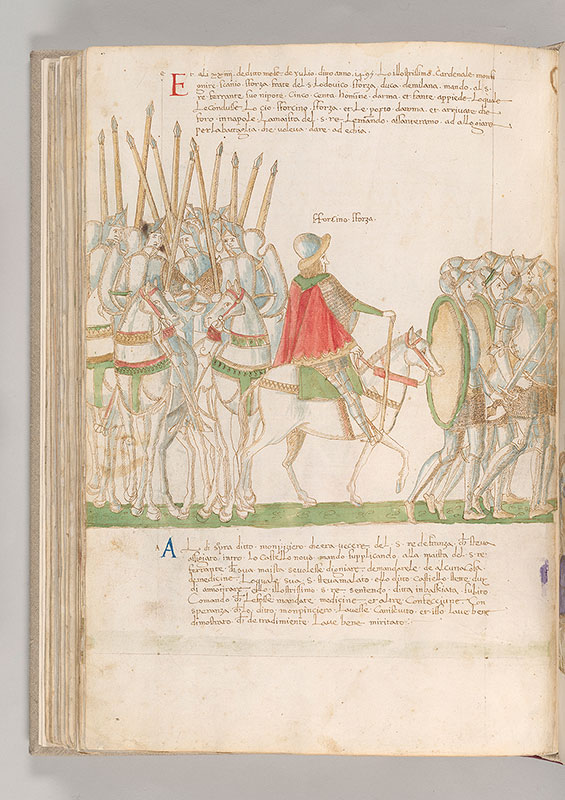
Fasciculus temporum
Cronaca della Napoli Aragonese: Scene, Sforza Maria Sforza entering Naples -- Sforza Maria Sforza, inscribed SFORZINO SFORZA, wearing helmet and armor, astride bridled horse with trappings, holding rod with right hand, follows group of foot soldiers, wearing helmets and armor, some carrying shields and swords. Sforza is followed by group of soldiers wearing helmets and armor, carrying lances and shields, astride bridled horses with trappings.
MS M.801, fol. 121r
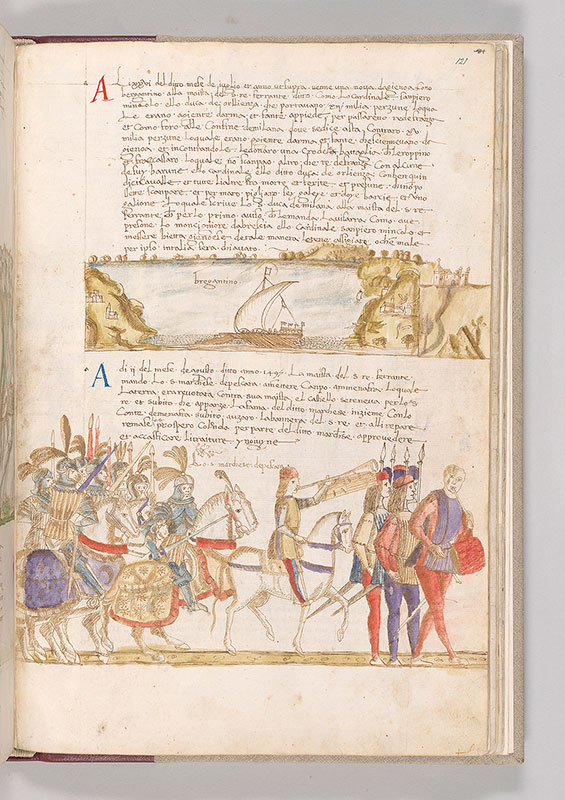
Fasciculus temporum
Cronaca della Napoli Aragonese: Scene, Cronaca della Napoli Aragonese: Scene, Harbor of Genoa -- Ship, inscribed BREGANTINO, with many oars, cabin with banners, flanked by shores with buildings. Two ships at right.
Cronaca della Napoli Aragonese: Scene, Expedition of Fernando Francesco d'Avalos -- Fernando Francesco d'Avalos, inscribed LO S(IGNOR) MARCHESE DE PESCARA, wearing plumed helmet and armor, holding sword with right hand is astride bridled, caparisoned horse, amid soldiers wearing plumed helmets and armor, some raising swords, some carrying lances, astride bridled caparisoned horses. Preceding them, at right, are man blowing bannered trumpet possibly decorated with heraldry of Aragon, astride bridled horse with trappings; group of men carrying spears and swords; and man playing pipe and tabor.
MS M.801, fol. 121v
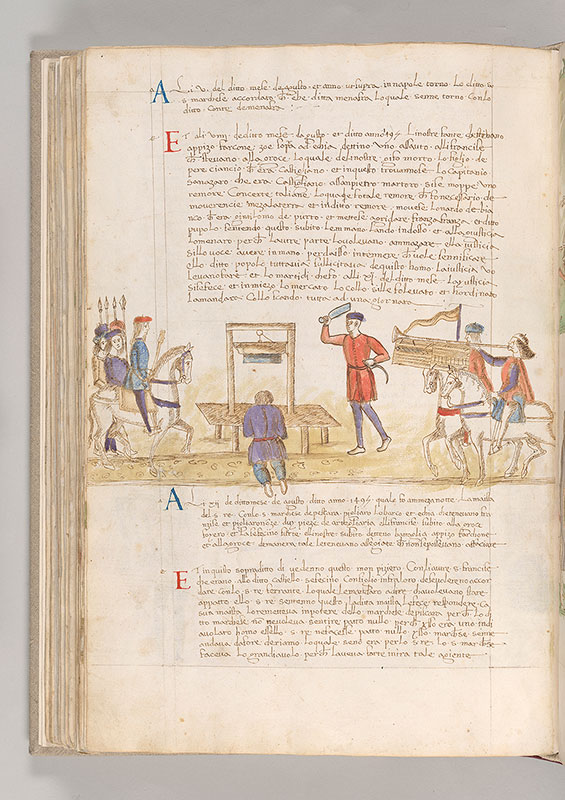
Fasciculus temporum
Cronaca della Napoli Aragonese: Scene, Execution of Leonardo de Bianco -- Leonardo de Bianco, back-turned, kneels before guillotine approached by executioner wearing hat, raising cleaver with right hand and holding sickle with left hand. At left are four (?) men wearing hats, holding spears and man wearing hat holding scepter with left hand astride bridled horse with trappings. At right two men wearing hats, are astride bridled horses with trappings, one holding banner, the other blowing bannered trumpet decorated with heraldry of Aragon.
MS M.801, fol. 122r
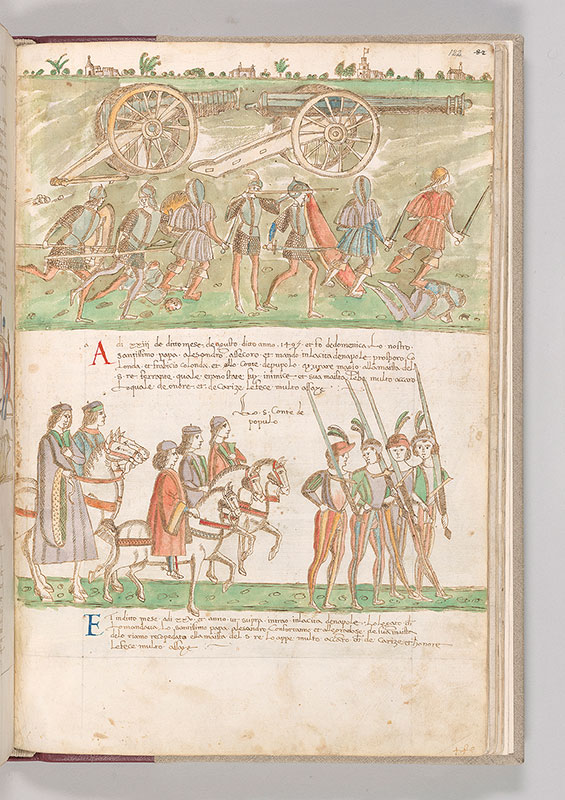
Fasciculus temporum
Cronaca della Napoli Aragonese: Scene, Liberation of Naples -- Two cannons, one next to five or six cannon balls; two soldiers wearing helmets and armor, holding spears and shields running; four soldiers with swords, one holding shield; soldier aiming spear; two headless bodies and one head on ground. Buildings in background.
Cronaca della Napoli Aragonese: Scene, Count of Populo entering Naples -- Five men wearing hats, one inscribed LO S(IGNOR) CONTE DE POPULO, are astride bridled horses with trappings. They follow four men wearing plumed hats, each carrying raised sword.
MS M.801, fol. 122v
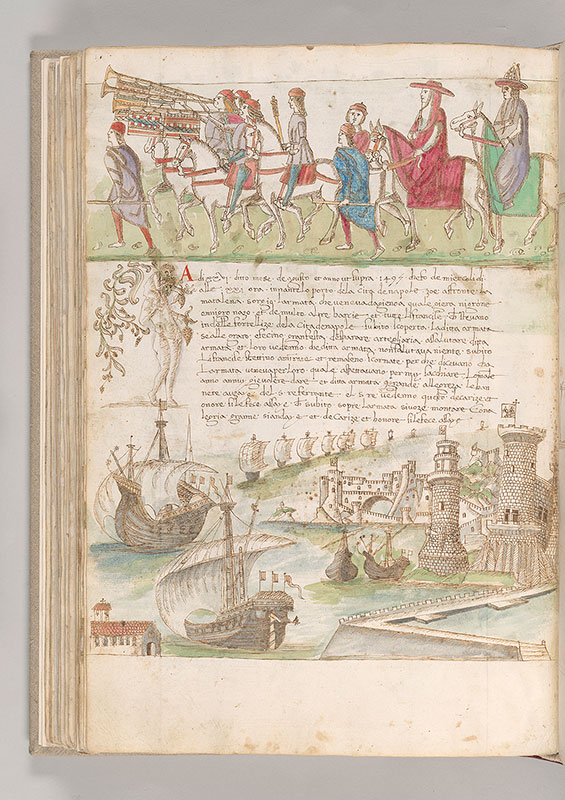
Fasciculus temporum
Cronaca della Napoli Aragonese: Scene, Papal Legate arriving at Naples -- Man wearing hat, carrying rod leads procession including four men wearing hats astride bridled horses with trappings, three blowing bannered trumpets, one carrying ceremonial mace; two men wearing hats, one carrying rod with left hand and with right hand grasping reins of horse of cardinal, wearing cardinal's hat and vestments; bishop (?) wearing miter (?) astride horse.
Cronaca della Napoli Aragonese: Scene, Genovese Fleet entering Port of Naples -- Thirteen (?) ships sailing into harbor at Naples where two ships have sails furled. Castel Nuovo is at right where flags, decorated with heraldry of France, fly at top of towers.
In left margin, small figure, grasping grapvine with right hand and bunch of grapes with left hand, sits on shoulders of nude woman, holding bunch of grapes with left hand.
MS M.801, fol. 123r
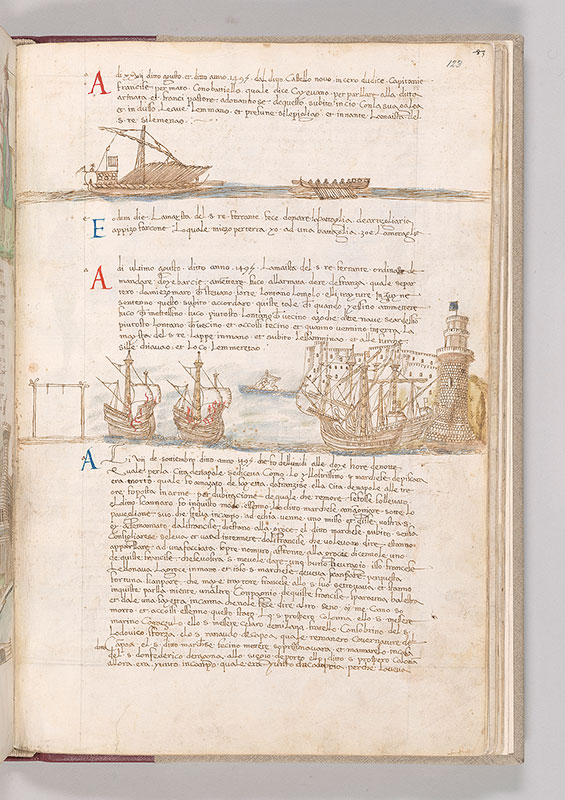
Fasciculus temporum
Cronaca della Napoli Aragonese: Scene, Liberation of Naples -- Two ships, both with oarsmen, one flying flag decorated with heraldry of Aragon.
Cronaca della Napoli Aragonese: Scene, Liberation of Naples -- At far left, gallows, next to two ships, in flames. At right, two ships, sails furled, docked next to tower of Castel Nuovo, possibly flying flag decorated with French heraldry.
MS M.801, fol. 123v
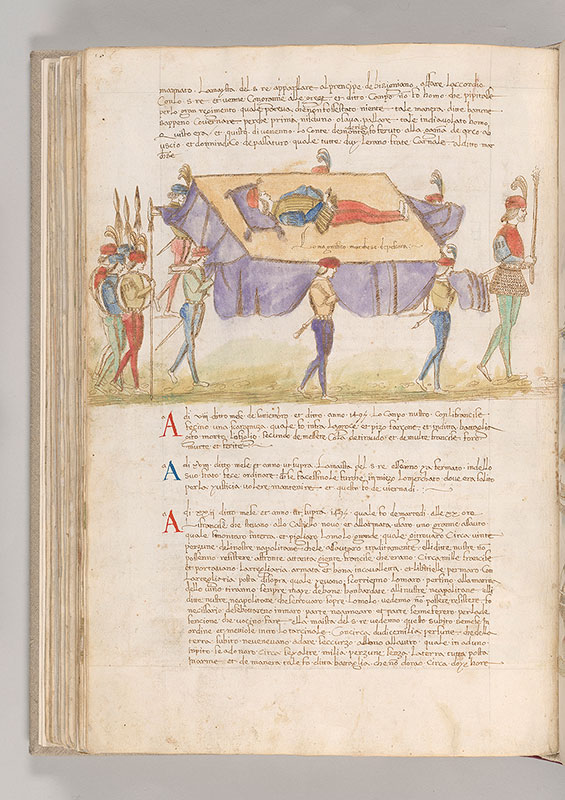
Fasciculus temporum
Cronaca della Napoli Aragonese: Scene, Death of Fernando Francesco d'Avalos -- Body of Fernando Francesco d'Avalos, inscribed LO MAGNIFICO MARCHESE DE PESCARA, wearing hat, head on pillow, hands crossed at waist, reclines on bier carried on shoulders of six men, three with swords at waist. Four men, wearing plumed hats, carrying spears with draped tips (?) follow the bier; at far right, man wearing plumed hat, holding torch with right hand, leads the procession.
MS M.801, fol. 124r
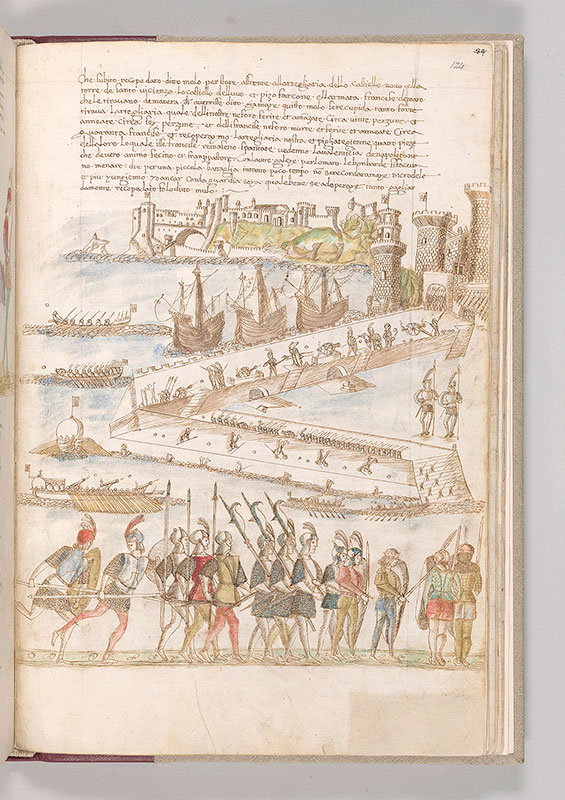
Fasciculus temporum
Cronaca della Napoli Aragonese: Scene, Liberation of Naples -- In port of Naples, two boats, flying French flag, firing cannons; three ships, sails furled, next to Castel Nuovo, French flags flying atop two towers. Figures holding spears in portal of the castle; soldiers, on pier or sea wall, holding spears, lighting cannon, holding sword and shield; cannons firing; cannon balls flying through air; cannon balls on ground. Line of soldiers with spears along near wall; soldiers falling into water; bodies in the water. Four ships, some flying flag of Aragon in foreground, some firing cannons. Figures with spears climbing steps of the pier or sea wall.
At bottom, soldiers, some wearing plumed hats or helmets, some carrying spear and shield, halberd or sword, some wearing sword at waist.
MS M.801, fol. 124v
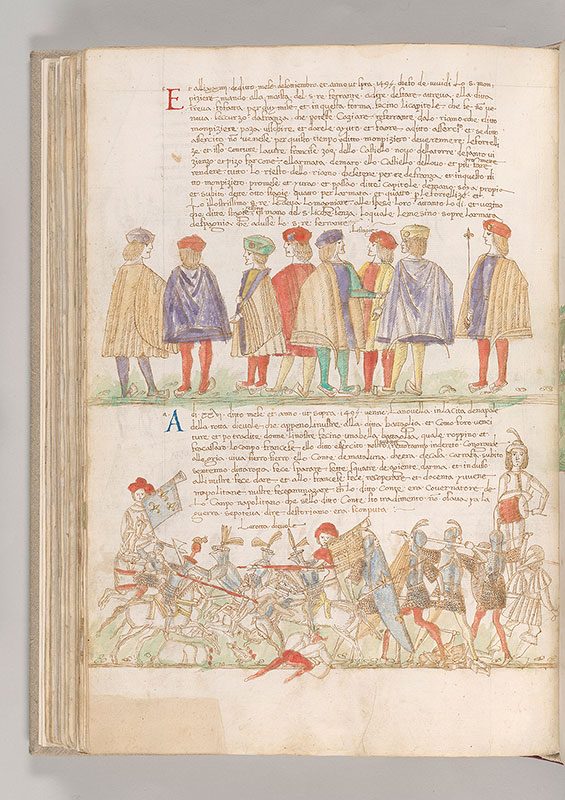
Fasciculus temporum
Cronaca della Napoli Aragonese: Scene, French Hostages -- Eight men wearing hats, two back-turned, one holding fleur-de-lis scepter, inscribed LISTAGIE.
Cronaca della Napoli Aragonese: Scene, Battle at Eboli -- At far left, man wearing hat, raising bannered trumpet, decorated with French heraldry, is astride horse; in center, man wearing hat raises bannered trumpet decorated with heraldry of Aragon. At far right, man wearing plumed hat plays drum. In between is battle, inscribed LAROTTA DI EUOLE, with soldiers wearing helmets and armor, some astride horses, some fighting with sword, lance or spear, some holding shields, one decorated with heraldry of France, another with heraldry of Aragon. On ground, bleeding body of horse next to severed horse head; also bodies of two men.
MS M.801, fol. 125r
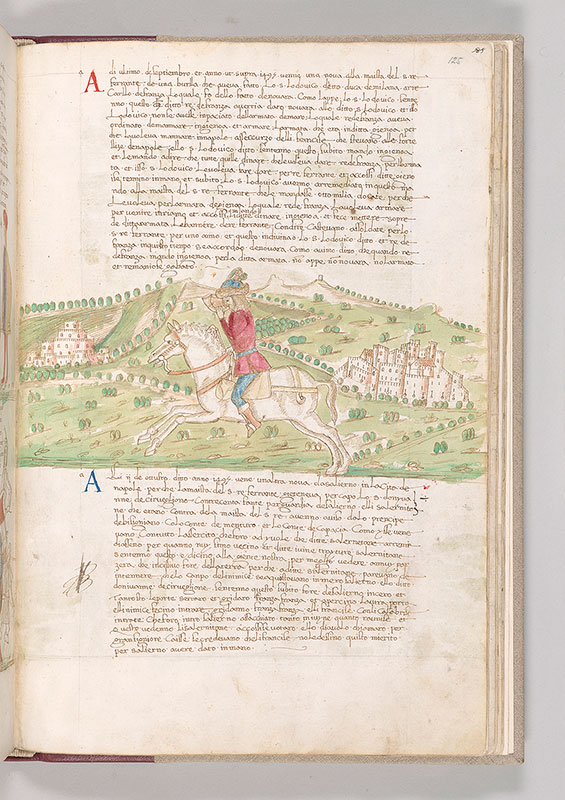
Fasciculus temporum
Cronaca della Napoli Aragonese: Scene, Liberation of Naples -- Man wearing plumed hat, blowing horn, grasping reins and riding crop, or whip, with right hand, astride bridled horse with trappings, purse hanging from saddle, gallops through landscape with buildings.
MS M.801, fol. 125v
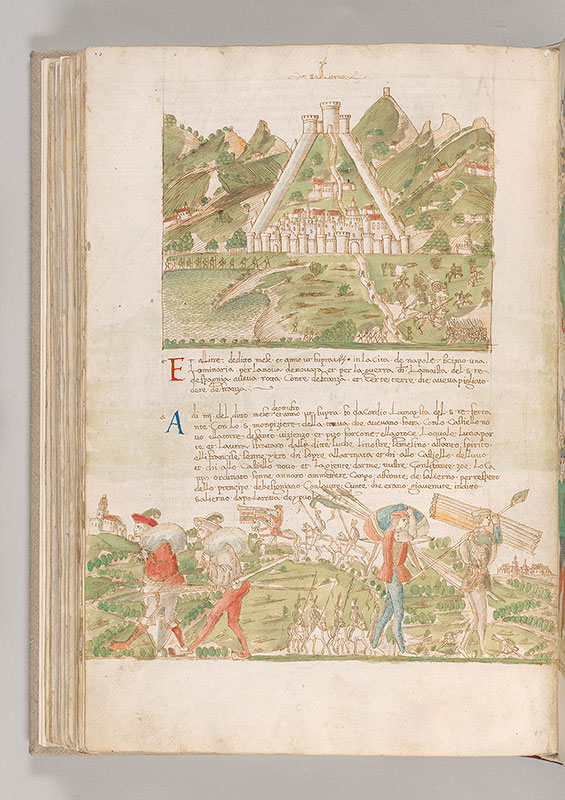
Fasciculus temporum
Cronaca della Napoli Aragonese: Scene, Siege of Salerno -- Soldiers, on foot and astride horses, carrying spears or lances and shields, aiming cannon, before walled city of Salerno, inscribed SALIERNO, among hills.
Cronaca della Napoli Aragonese: Scene, Evacuation of French Soldiers -- In foreground, four men carry sacks or bundles on shoulders, grasping weapons including spears, shield and crossbow, one wearing sword at waist, another wearing knife at waist.. In background, soldiers wearing helmets and armor, astride horses, carry lances; one blows bannered trumpet decorated with heraldry of Aragon. Two cannons with cannon balls in background; buildings in distance.
MS M.801, fol. 126r
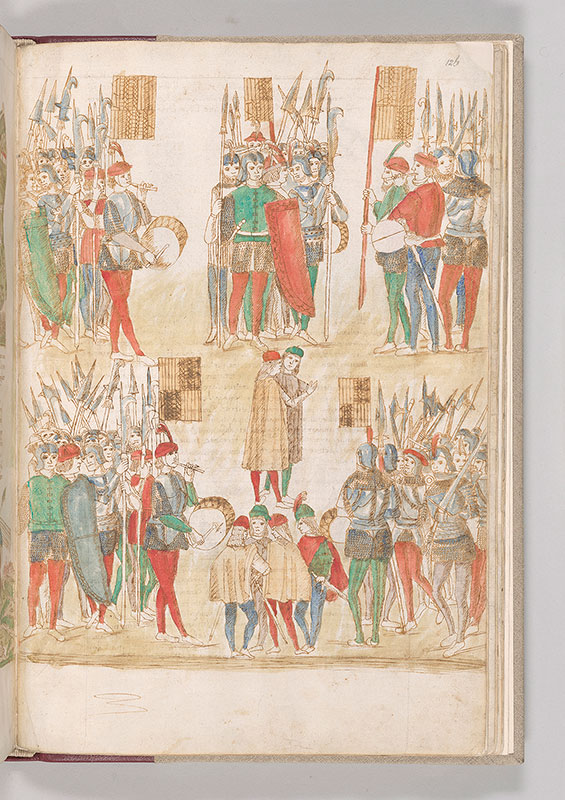
Fasciculus temporum
Cronaca della Napoli Aragonese: Scene, Aragonese Troops -- Of soldiers in five groups, many hold spear or halberd, some have sword, three have shields. One in each group holds banner decorated with heraldry of Aragon. Three hold drums; two play pipe and tabor. In center, pair of men stand in conversation, one gesturing; below, four men, three wearing swords at waists, stand together. All wear hats or helmets, some plumed.
MS M.801, fol. 126v
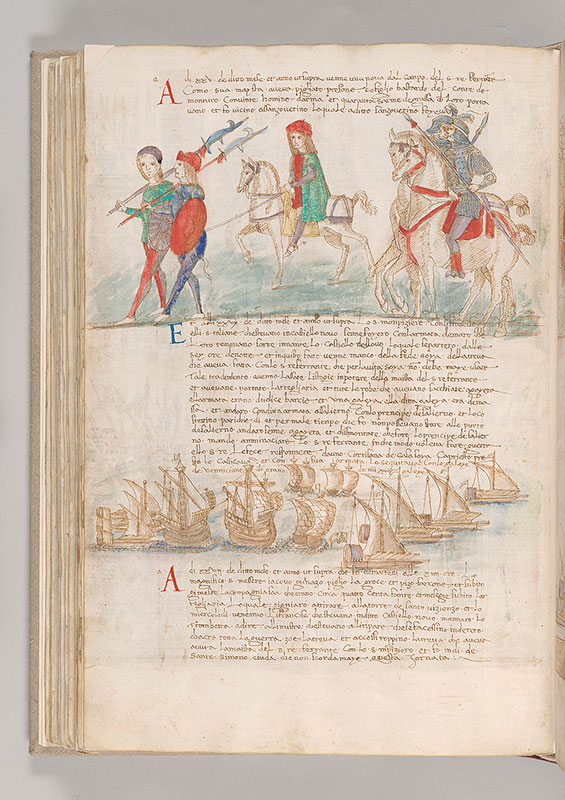
Fasciculus temporum
Cronaca della Napoli Aragonese: Scene, Aragonese Soldiers with Prisoner -- Man wearing hat, hands crossed and bound is astride bridled horse with trappings. Two men wearing hats, carrying halberds and shields, walk before the horse, one holding reins or rope binding hands or horseman. Two soldiers wearing plumed helmets and armor, carrying lances, leaning toward each other, are astride bridled horses with trappings.
Cronaca della Napoli Aragonese: Scene, French Ships sailing to Salerno -- Fourteen (?) ships, some with oars visible, one flying flag decorated with French heraldry.
MS M.801, fol. 127r
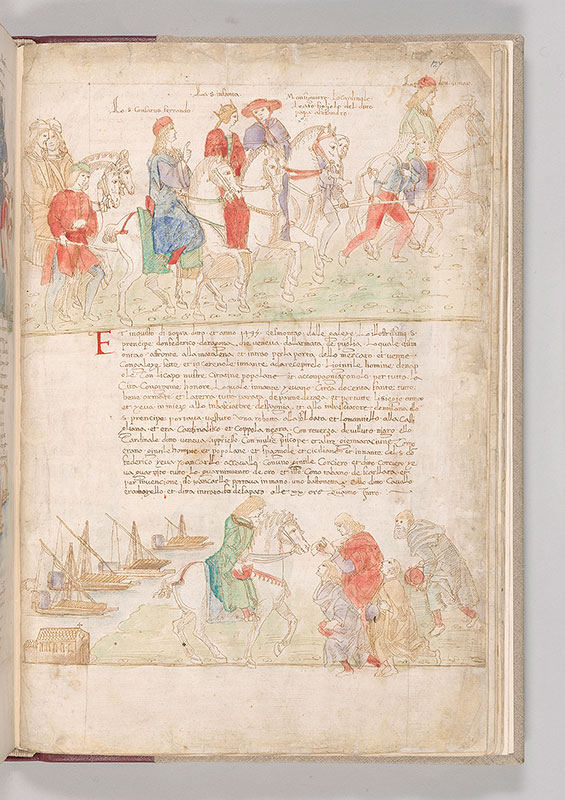
Fasciculus temporum
Cronaca della Napoli Aragonese: Scene, Giovanna, Wife of Ferdinand II of Naples arriving in Naples -- Procession of two horsemen in conversation; man wearing hat, carrying rod, walking; Gonsalvo de Cordova, inscribed LO S(IGNOR) CONSARUO FERRANDO, wearing hat, gesturing with right hand, astride bridled horse; Giovanna, wife of Ferdinand II of Naples, inscribed LA S(IGNORA) INFANTA, crowned, astride bridled horse, in conversation with Giovanni Borgia as cardinal inscribed MONSIGNIORE LO CARDINALE LE[G]ATO FIGLIO LO DEL DITTO PAPA ALESANDRO, wearing cardinal's hat, astride bridled horse; three men carrying staffs, two in conversation, all walking; and man inscribed LO S(IGNOR) DON DIMAO, astride bridled horse.
Cronaca della Napoli Aragonese: Scene, Liberation of Naples -- Man, wearing ceremonial chain around neck, head inclined, holding hat with right hand, is astride bridled horse with trappings before four men, holding hats with hand, all bending or kneeling, one with head inclined. At left, four ships are in water; church building on shore.
MS M.801, fol. 127v

Fasciculus temporum
Cronaca della Napoli Aragonese: Scene, Aragonese Troops -- In upper half, of four soldiers astride horses, two hold lances and lean toward each other; Giancarlo Tramontano, inscribed LO MAGNIFICO JOAN CARLLO, holds ceremonial mace astride caparisoned horse; fourth blows bannered trumpet decorated with heraldry of Aragon.
Below, men in three groups hold spears; two men wear sword at waist; one in each group holds banner decorated with heraldry of Aragon; in two groups, man plays pipe and tabor; in third group, man holds drum. Some wear plumed helmets; others wear hats, some plumed.
MS M.801, fol. 128r
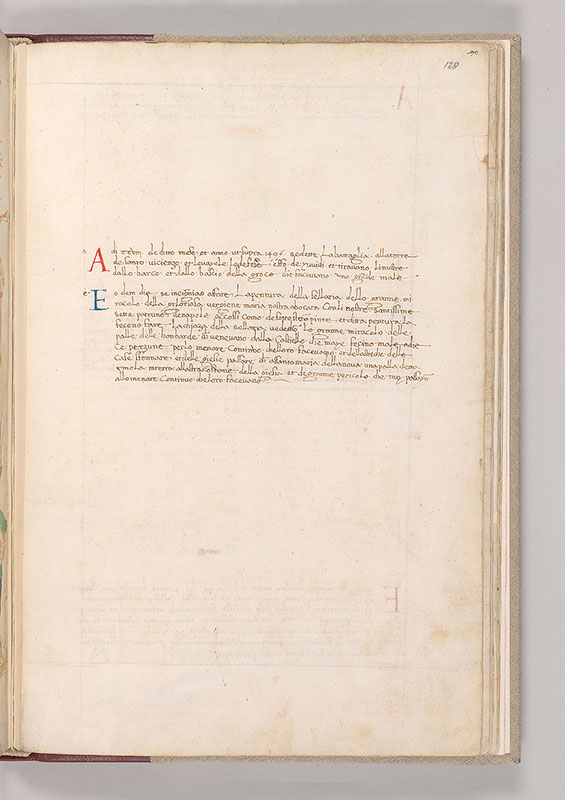
Fasciculus temporum
MS M.801, fol. 128v
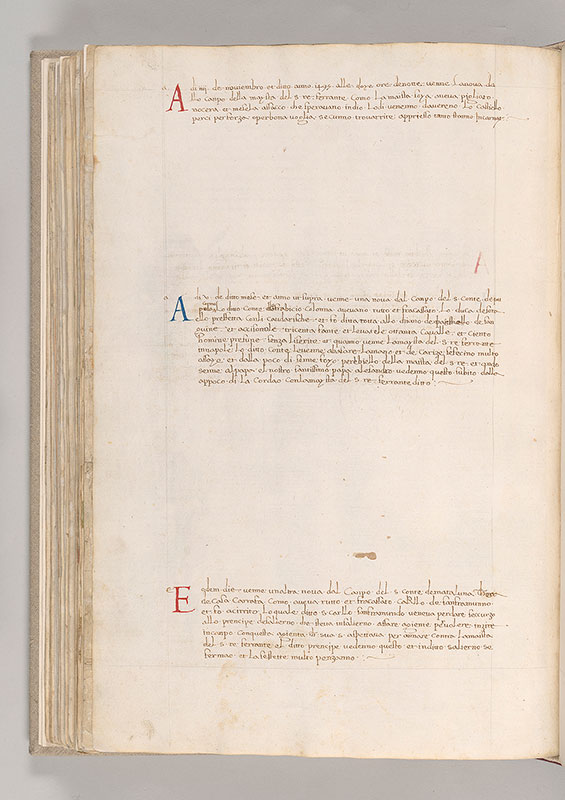
Fasciculus temporum
MS M.801, fol. 129r
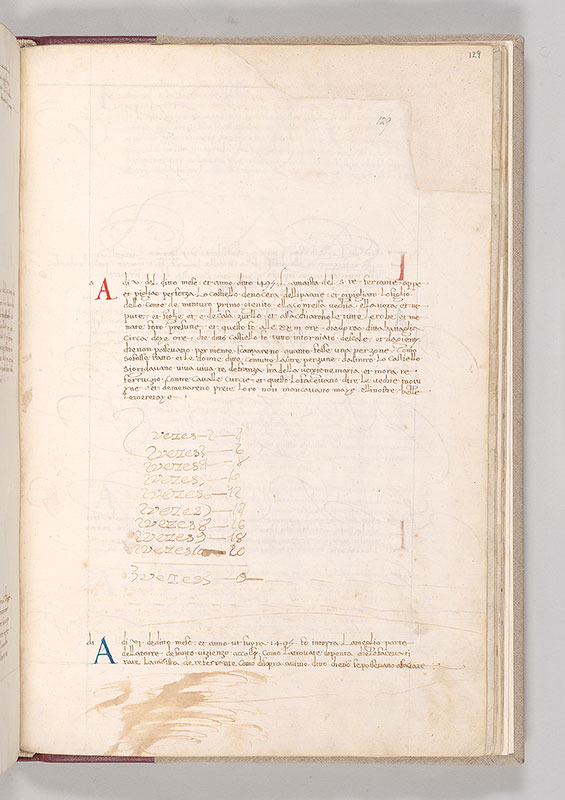
Fasciculus temporum
MS M.801, fol. 129v
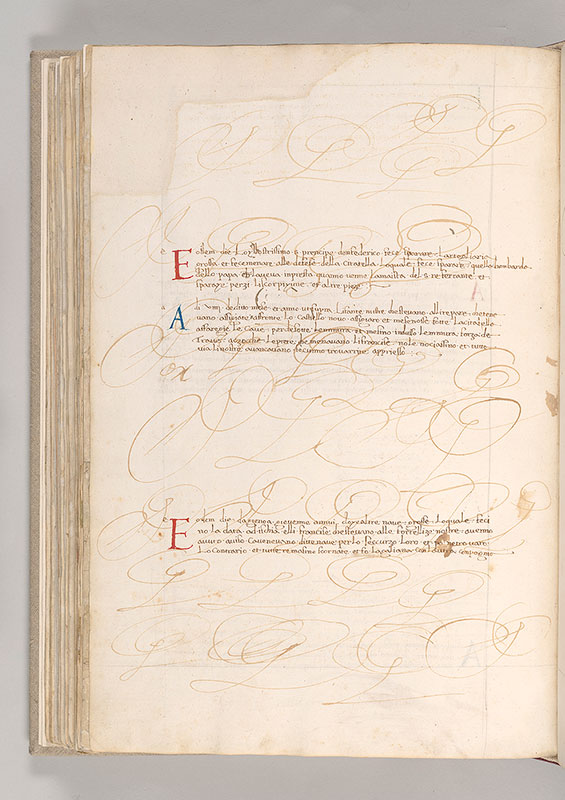
Fasciculus temporum
MS M.801, fol. 130r
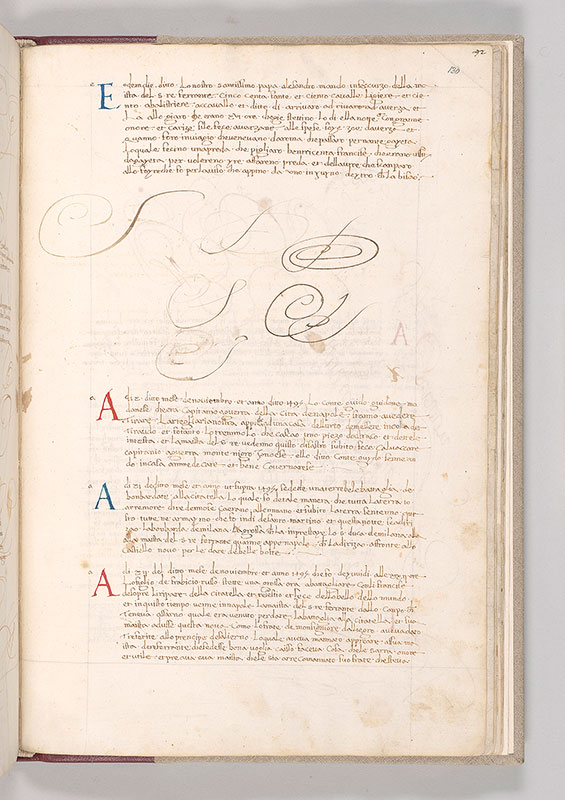
Fasciculus temporum
MS M.801, fol. 130v
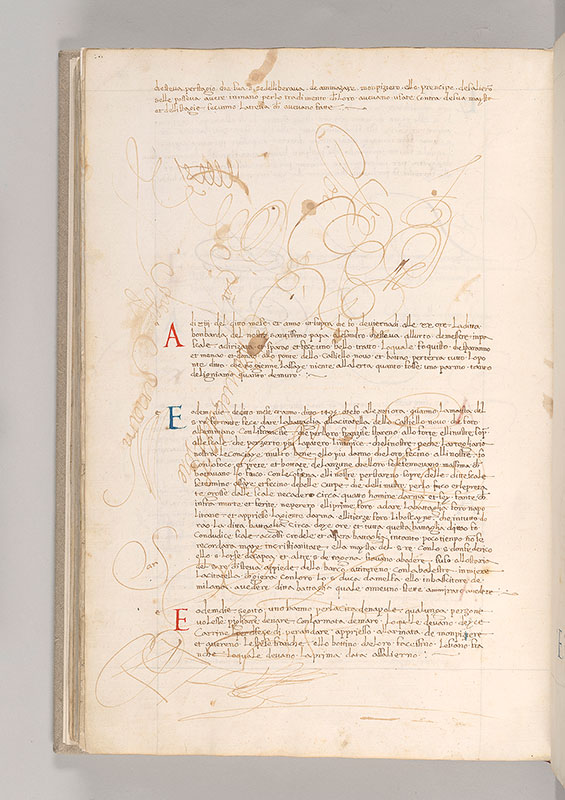
Fasciculus temporum
MS M.801, fol. 131r
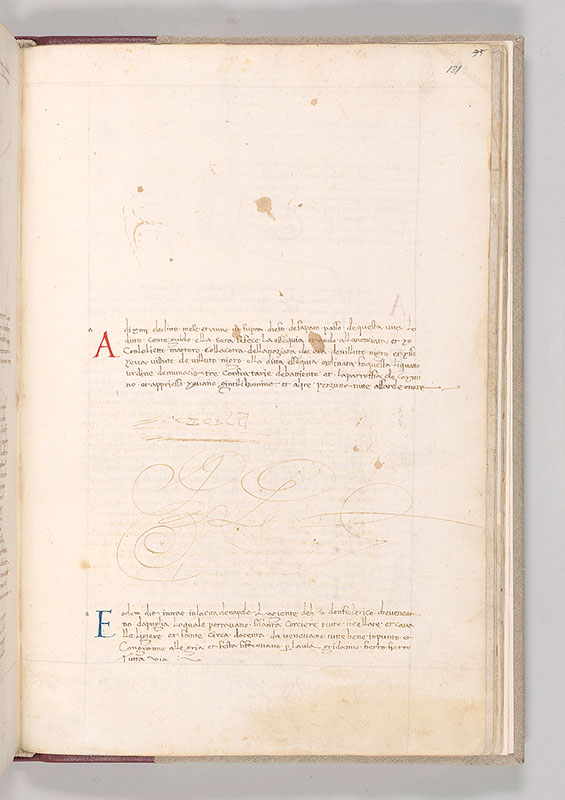
Fasciculus temporum
MS M.801, fol. 131v
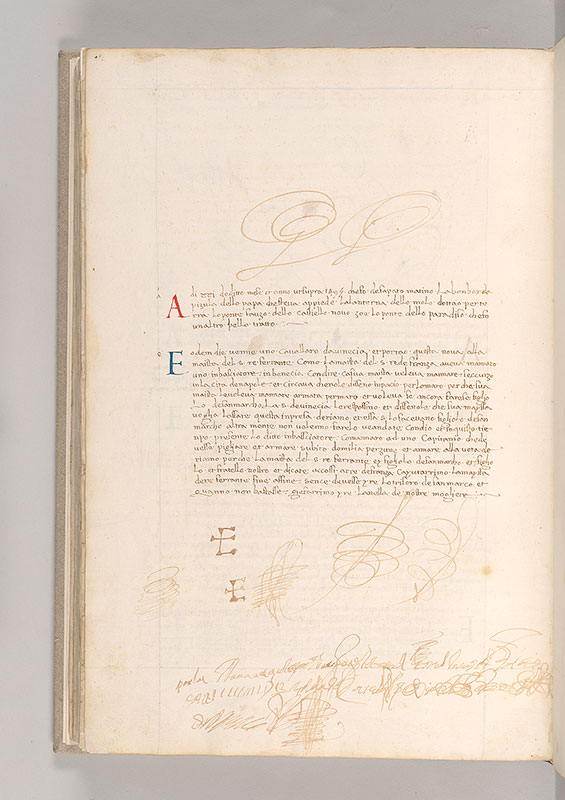
Fasciculus temporum
MS M.801, fol. 132r
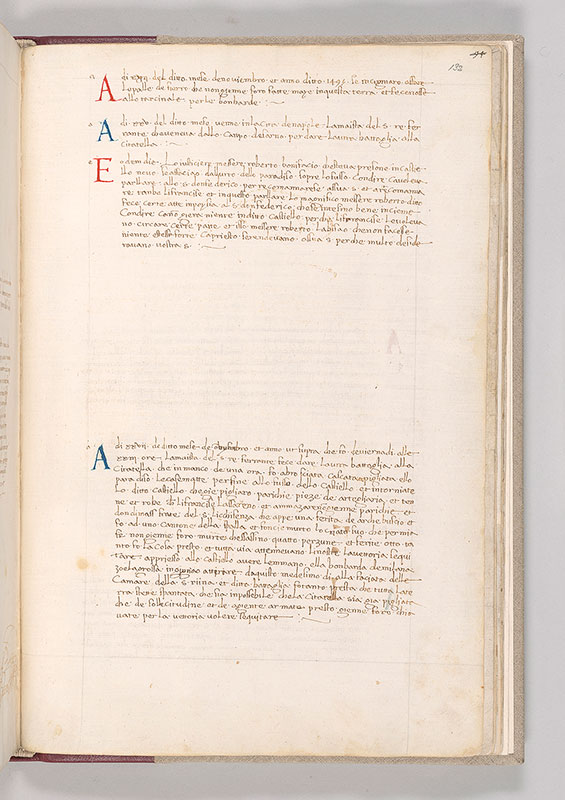
Fasciculus temporum
MS M.801, fol. 132v
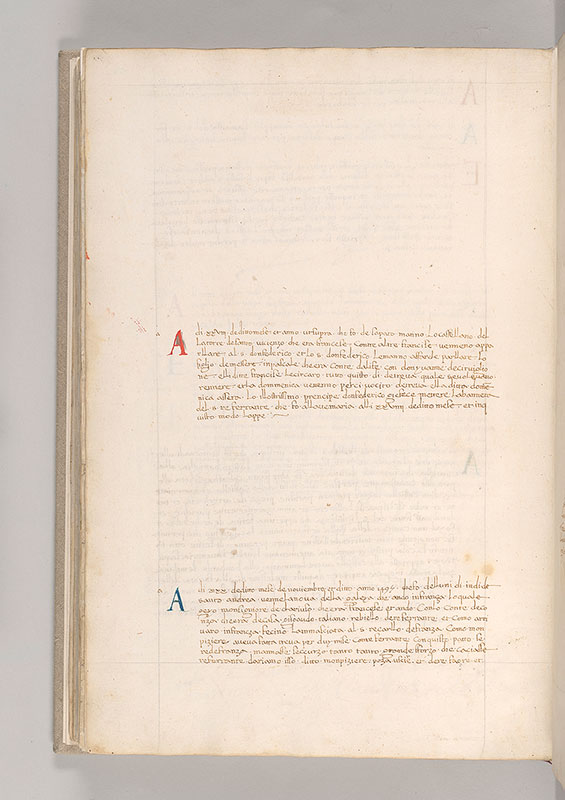
Fasciculus temporum
MS M.801, fol. 133r
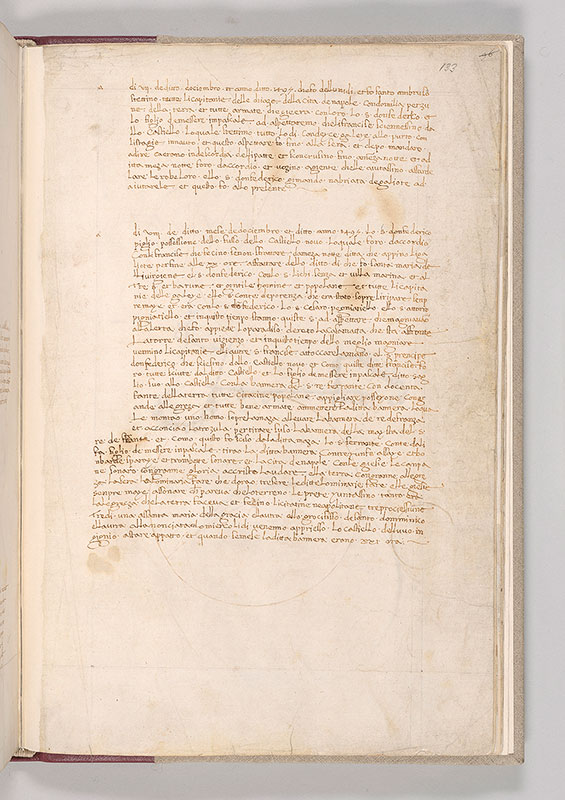
Fasciculus temporum
MS M.801, fol. 133v
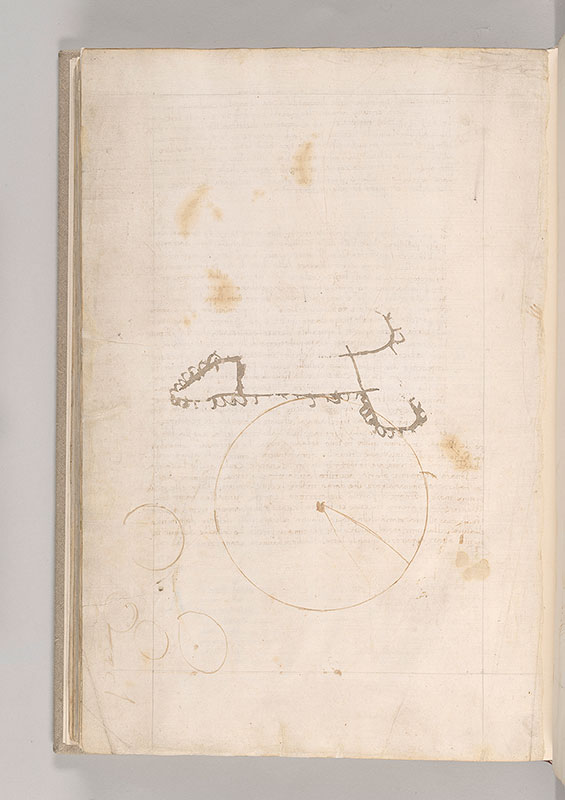
Fasciculus temporum
MS M.801, fol. 134r
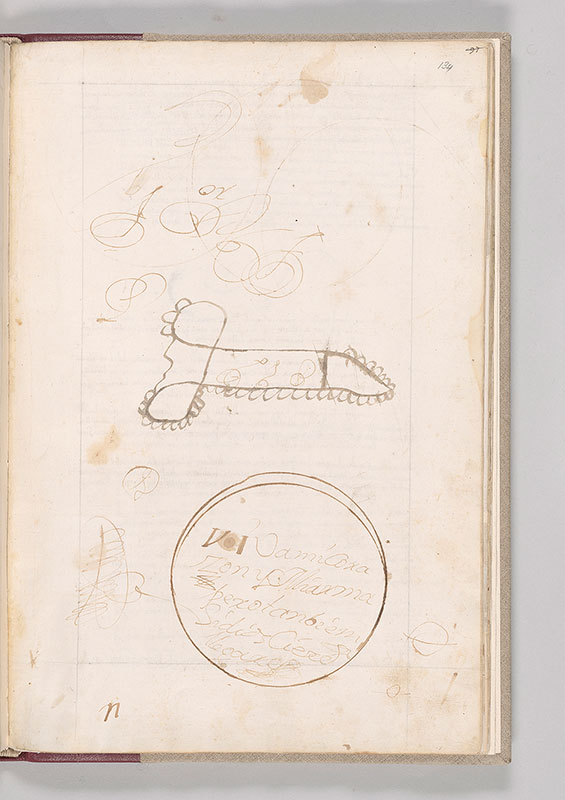
Fasciculus temporum
MS M.801, fol. 134v
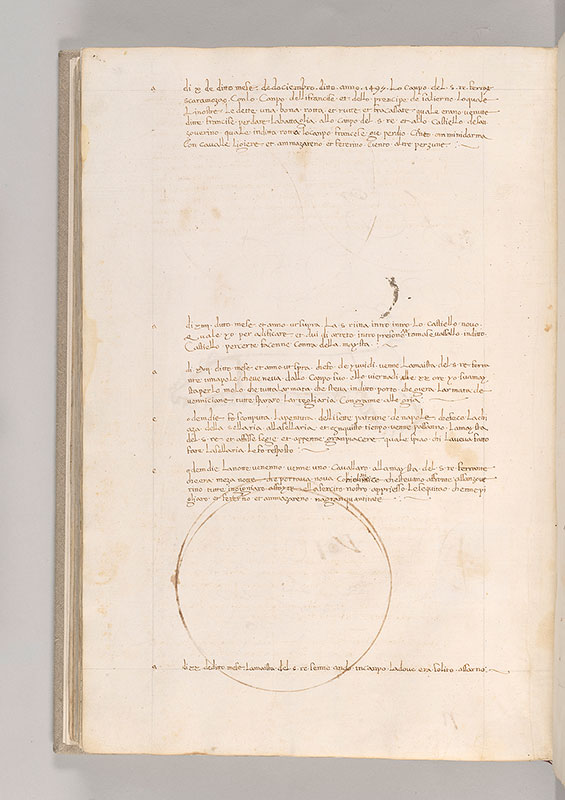
Fasciculus temporum
MS M.801, fol. 135r
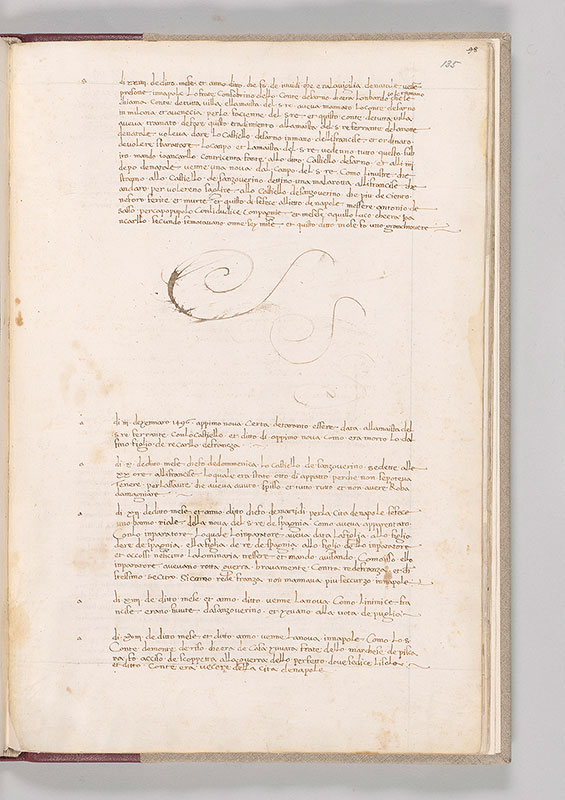
Fasciculus temporum
MS M.801, fol. 135v
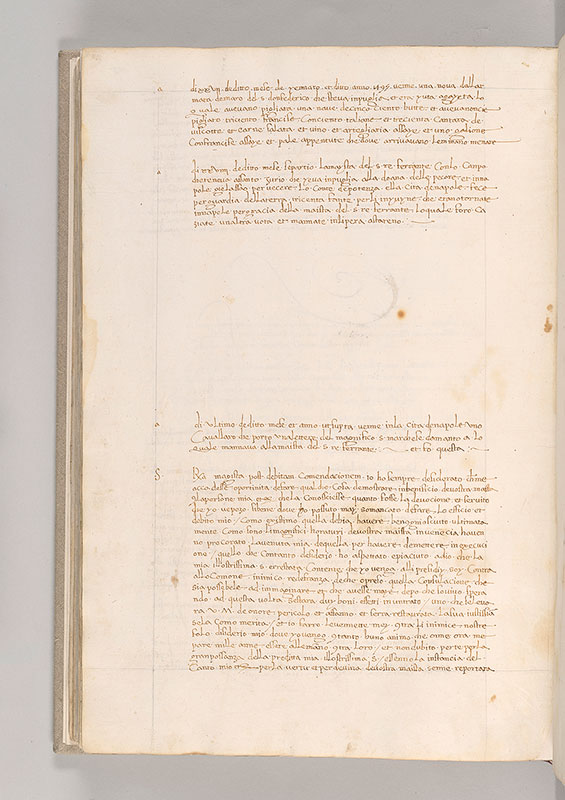
Fasciculus temporum
MS M.801, fol. 136r
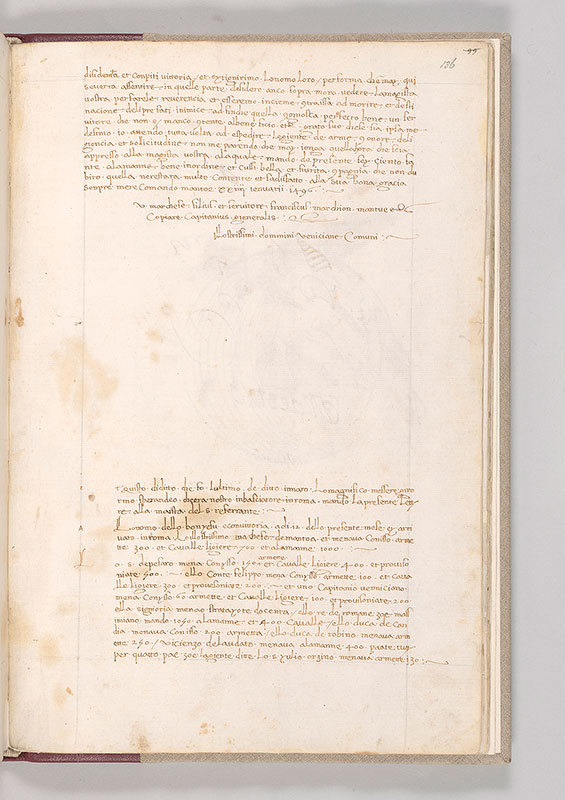
Fasciculus temporum
MS M.801, fol. 136v
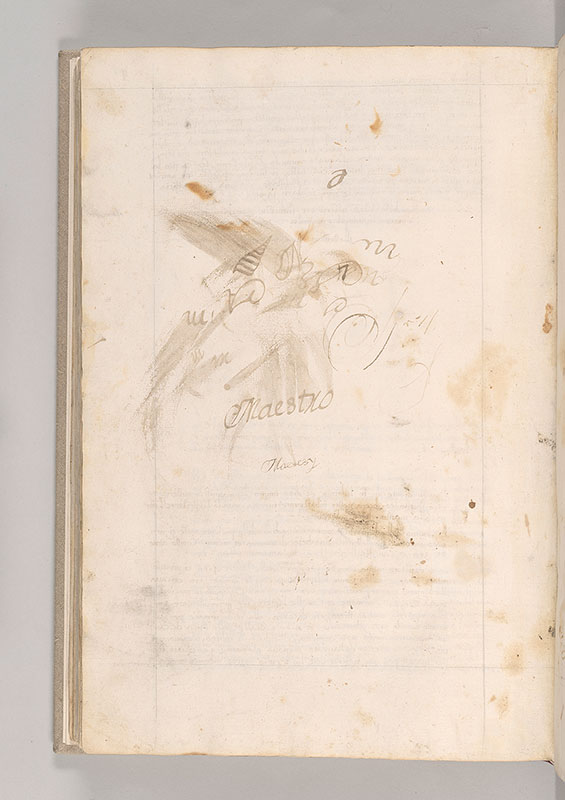
Fasciculus temporum
MS M.801, fol. 137r
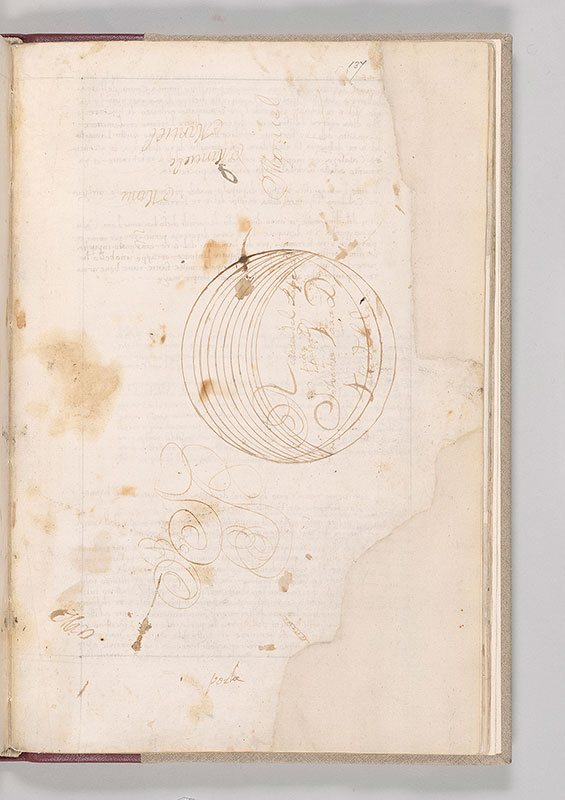
Fasciculus temporum
MS M.801, fol. 137v
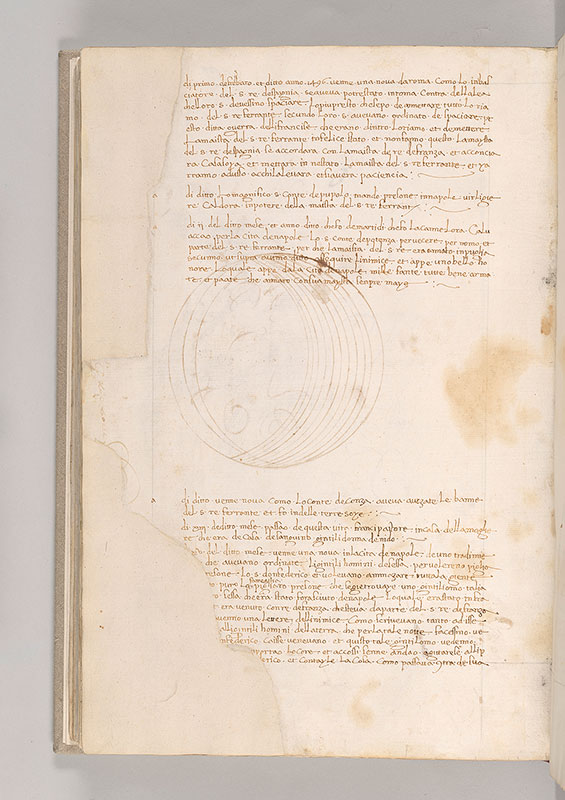
Fasciculus temporum
MS M.801, fol. 138r
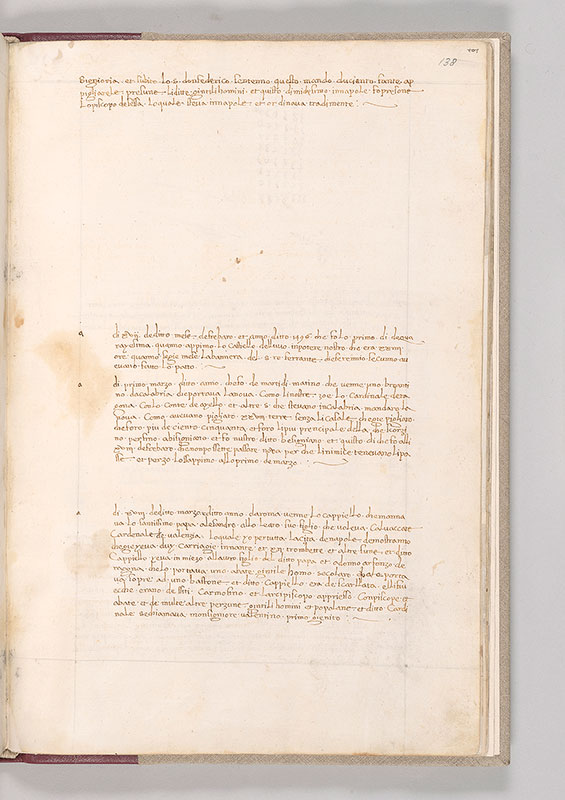
Fasciculus temporum
MS M.801, fol. 138v
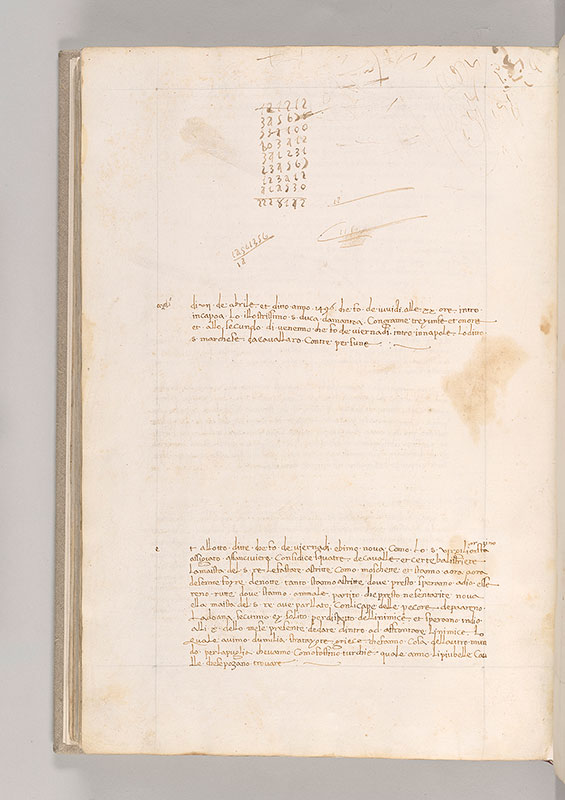
Fasciculus temporum
MS M.801, fol. 139r
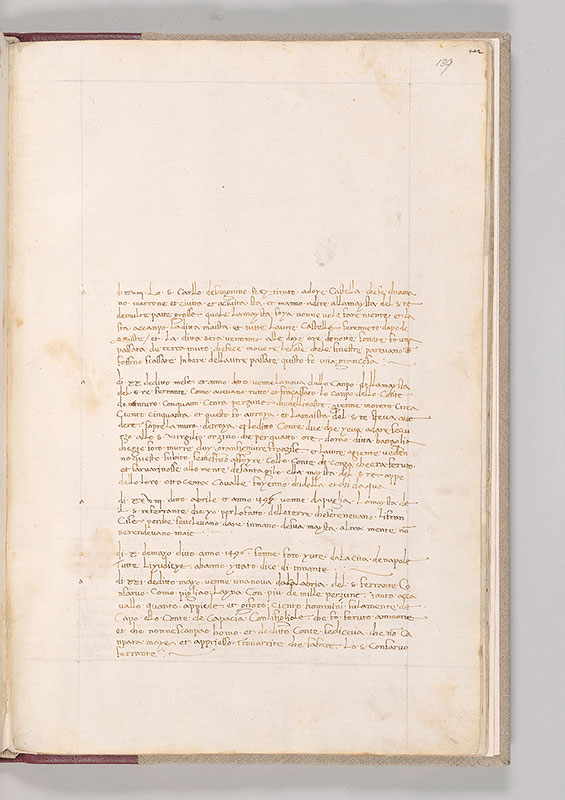
Fasciculus temporum
MS M.801, fol. 139v
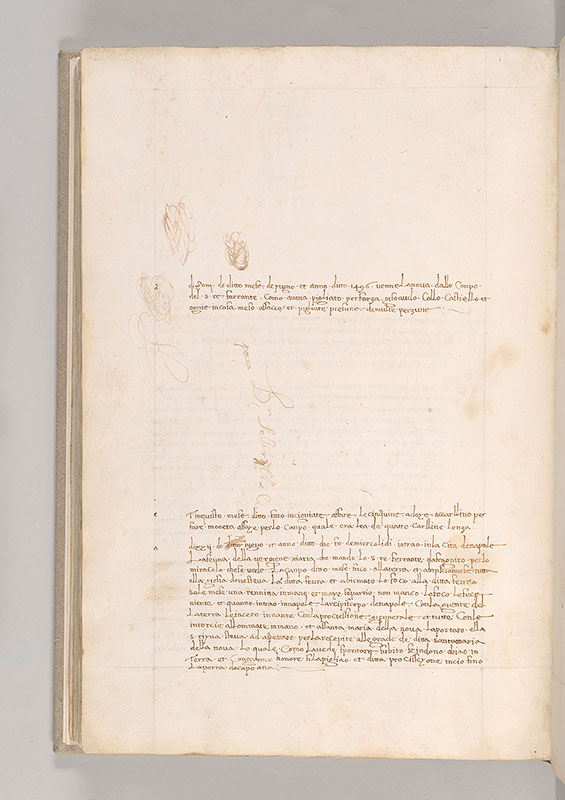
Fasciculus temporum
MS M.801, fol. 140r
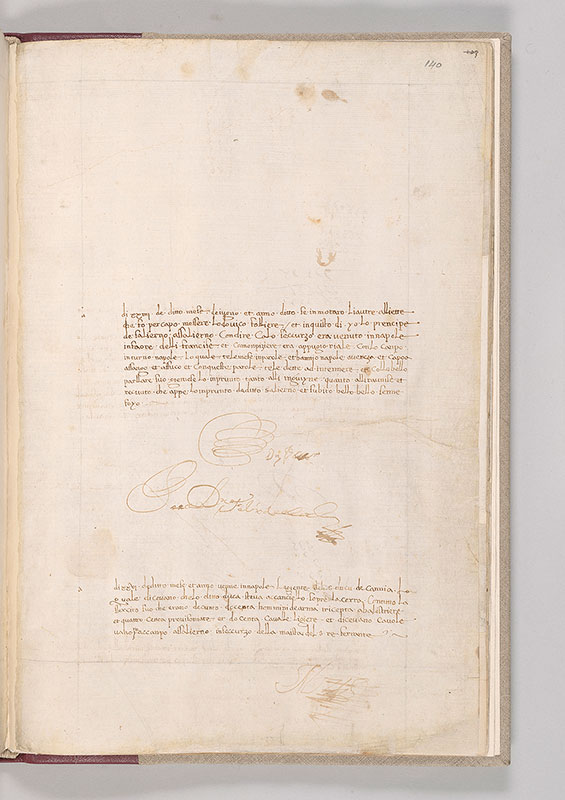
Fasciculus temporum
MS M.801, fol. 140v
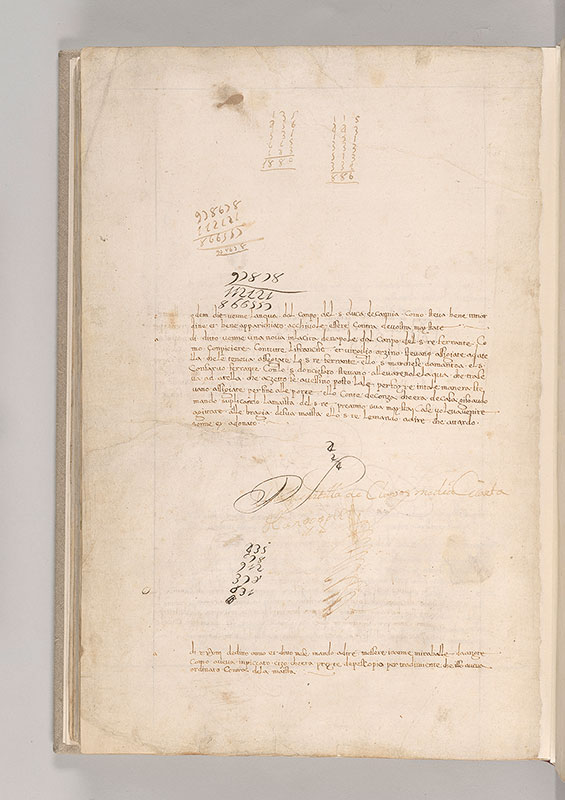
Fasciculus temporum
MS M.801, fol. 141r
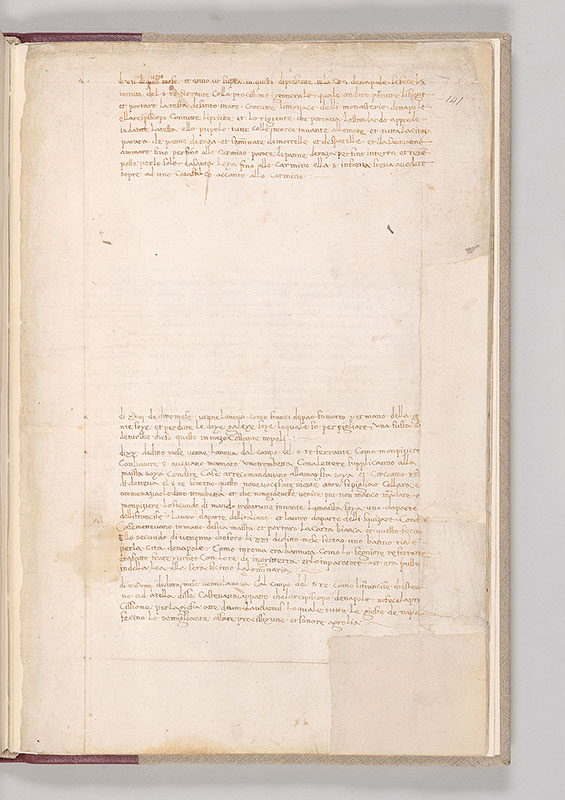
Fasciculus temporum
MS M.801, fol. 141v
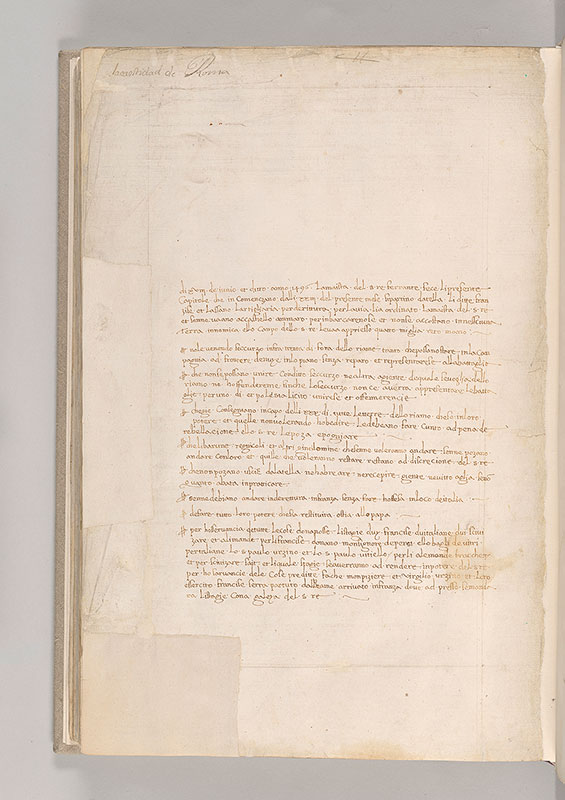
Fasciculus temporum
MS M.801, fol. 142r
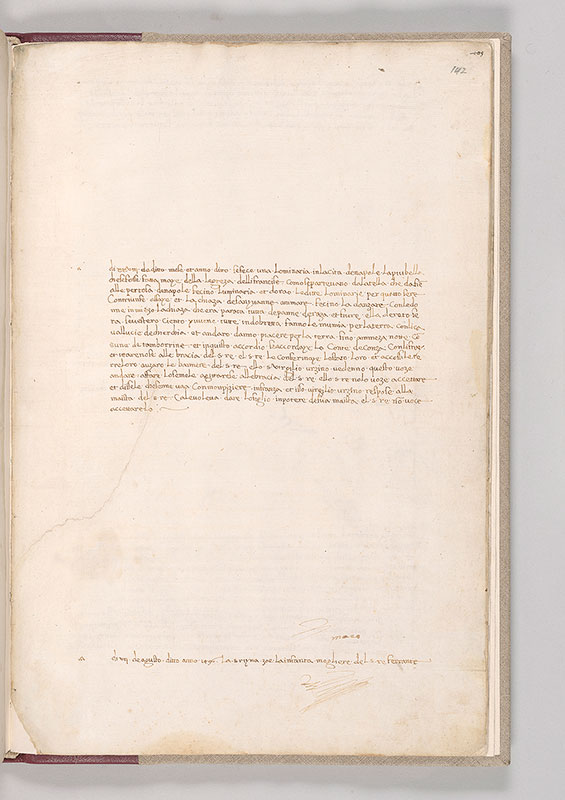
Fasciculus temporum
MS M.801, fol. 142v
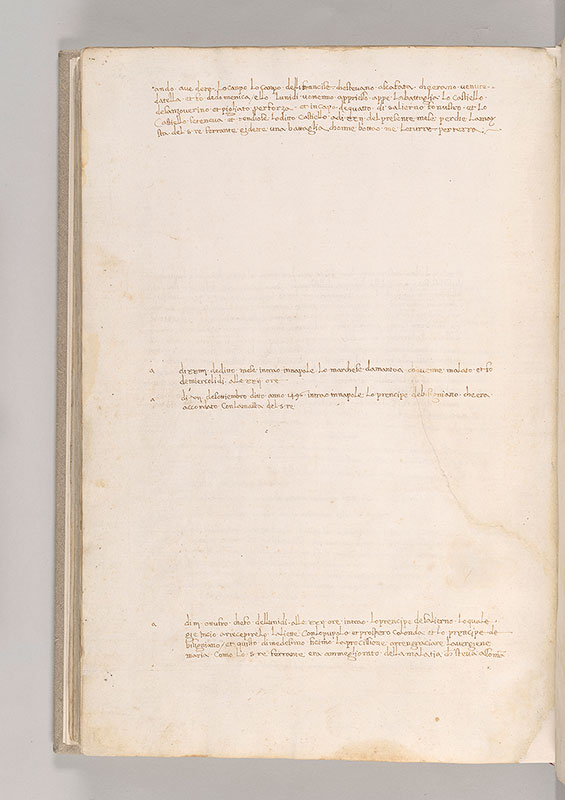
Fasciculus temporum
MS M.801, fol. 143r
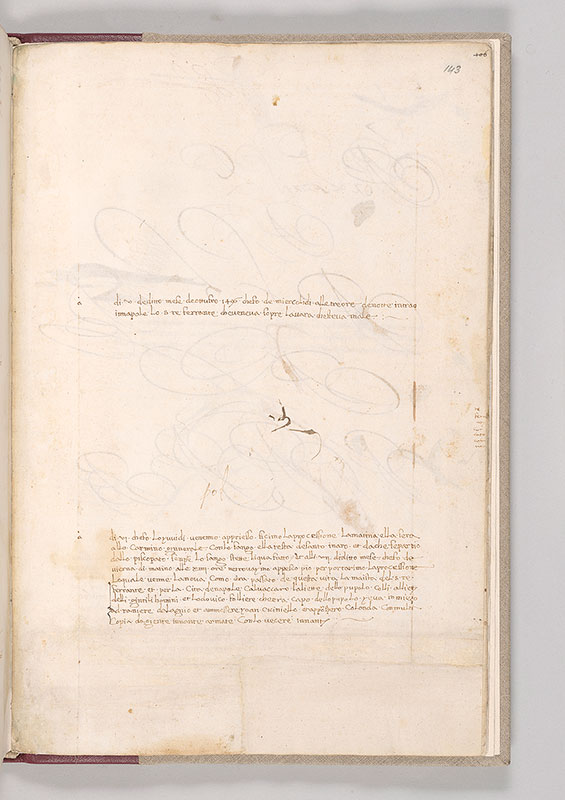
Fasciculus temporum
MS M.801, fol. 143v
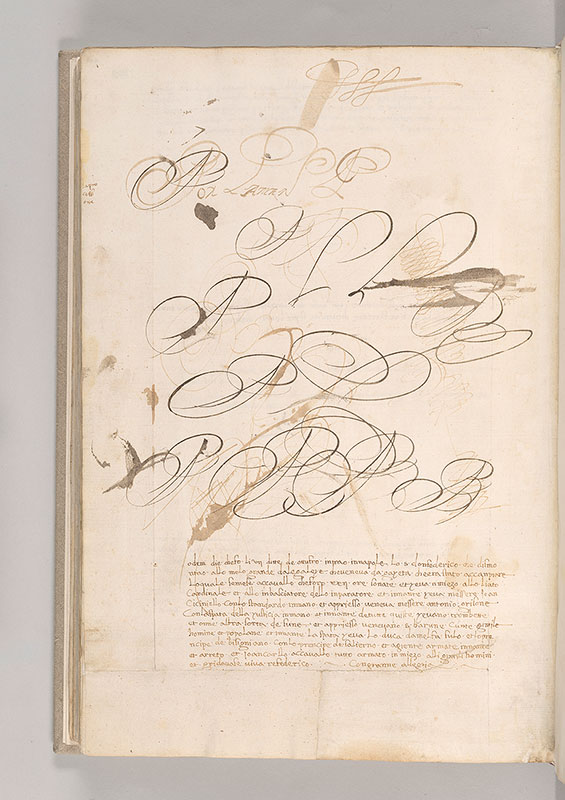
Fasciculus temporum
MS M.801, fol. 144r
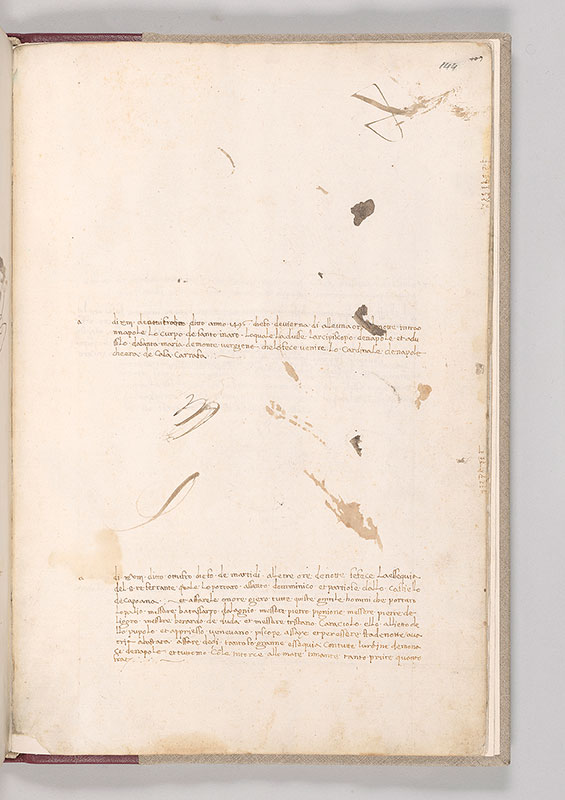
Fasciculus temporum
MS M.801, fol. 144v
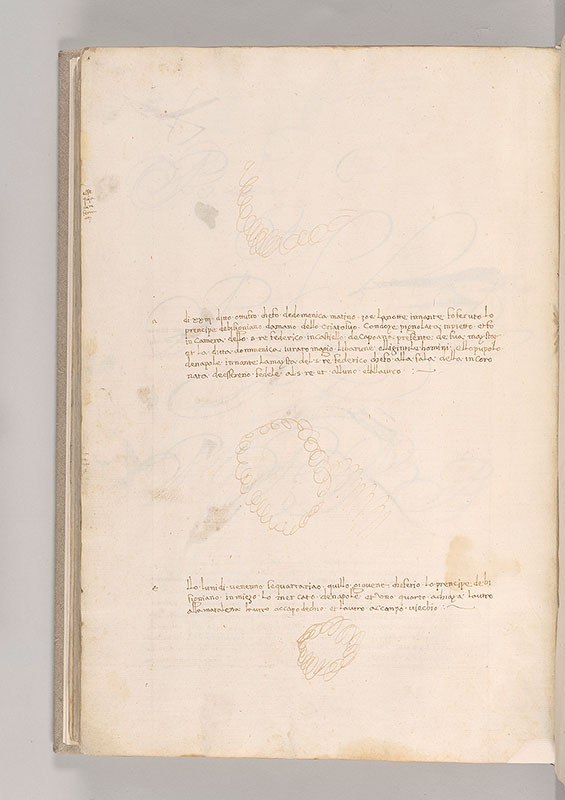
Fasciculus temporum
MS M.801, fol. 145r
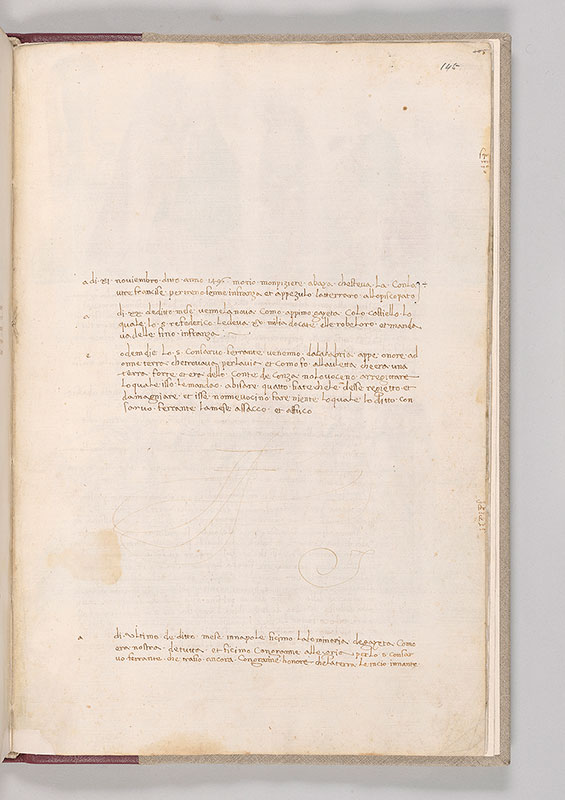
Fasciculus temporum
MS M.801, fol. 145v
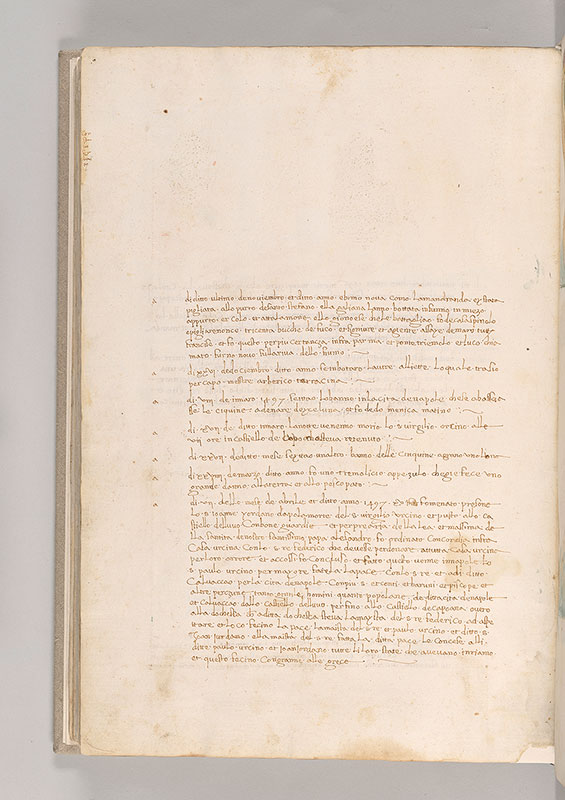
Fasciculus temporum
MS M.801, fol. 146r
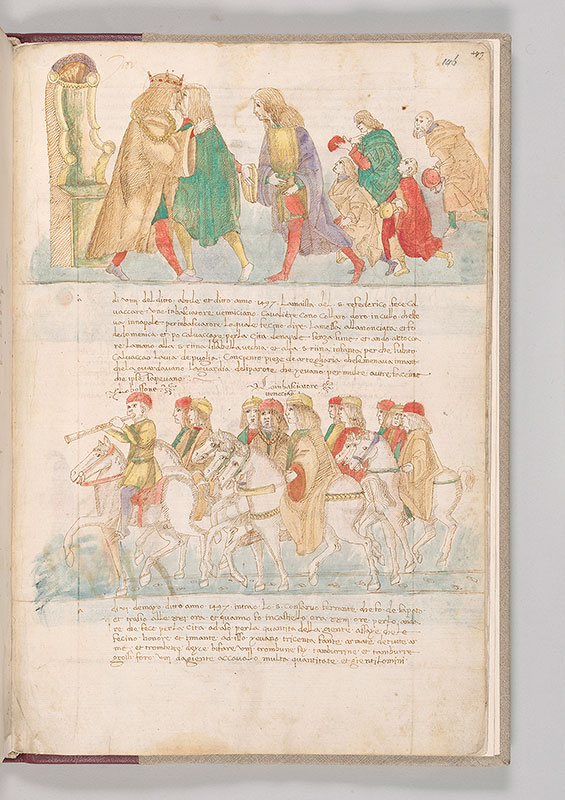
Fasciculus temporum
Cronaca della Napoli Aragonese: Scene, Peace of Ferdinand II of Naples and Giovan Giordano Orsini -- Standing before throne, Ferdinand II of Naples, crowned, embraces and kisses Giovan Giordano Orsini, holding hat with right hand. At right, five men, each holding hat, bend or kneel.
Cronaca della Napoli Aragonese: Scene, Procession of Venetian Ambassador -- Procession of eleven men, wearing hats, astride horses (some not visible), includes herald, inscribed LO BOFFONE, blowing cornetto, and Venetian ambassador inscribed LO INBASCIATORE UENECIA(N)E, wearing ceremonial chain.
MS M.801, fol. 146v
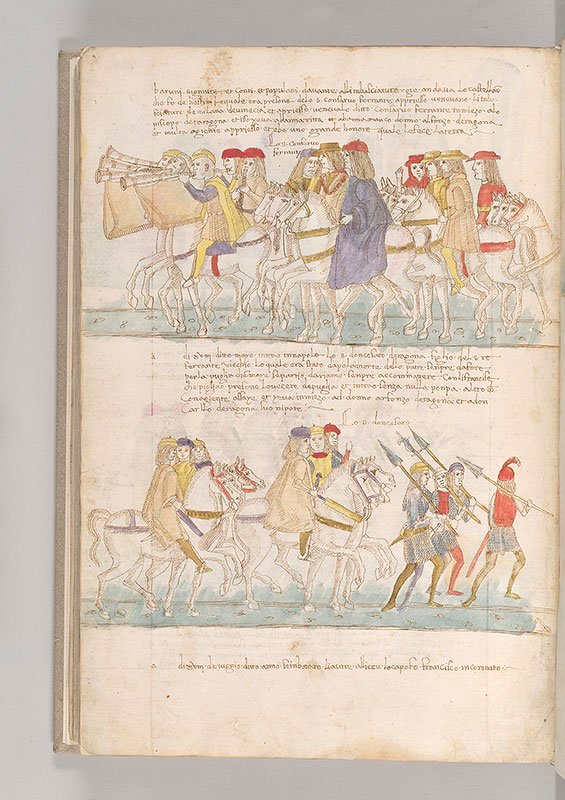
Fasciculus temporum
Cronaca della Napoli Aragonese: Scene, Procession of Gonsalvo de Cordova -- Procession of twelve men wearing hats, astride horses with trappings include six musicians each playing cornetto, two bannered, and Gonsalvo de Cordova, inscribed LO SIGNOR CONSARUO FERRANT[E], wearing ceremonial chain. Not all horses are visible; at far right, are heads and shoulders of three horses.
Cronaca della Napoli Aragonese: Scene, Cesare of Aragon II, arriving in Naples -- Cesare of Aragon, inscribed LO S(IGNOR) DON CESARO, is one of six men, wearing hats, astride bridled horses. Four soldiers, wearing hats and mail, three carrying spears, one with halberd, precede the horsemen.
MS M.801, fol. 147r
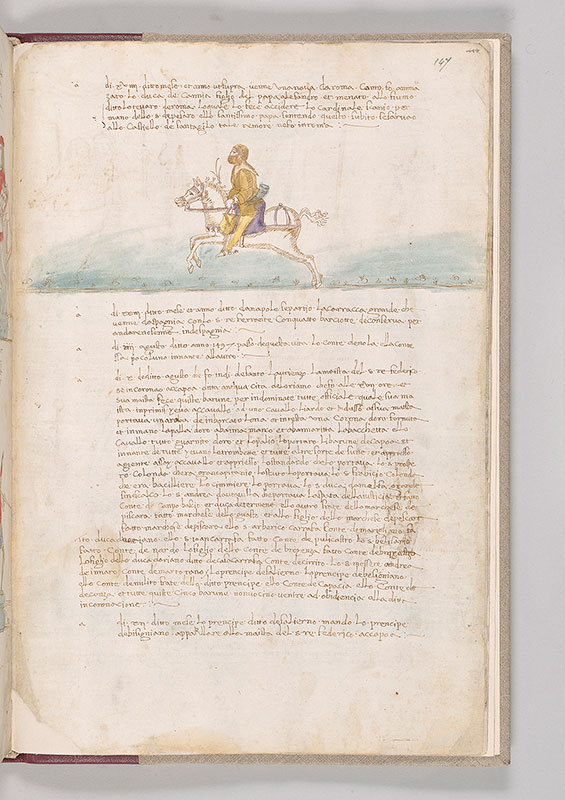
Fasciculus temporum
Cronaca della Napoli Aragonese: Scene, Horseman bringing News from Rome -- Man, wearing hood, face partially covered, holding riding crop, or whip, with right hand, purse hanging from left wrist, horn at his waist, is astride bridled horse with trappings.
MS M.801, fol. 147v
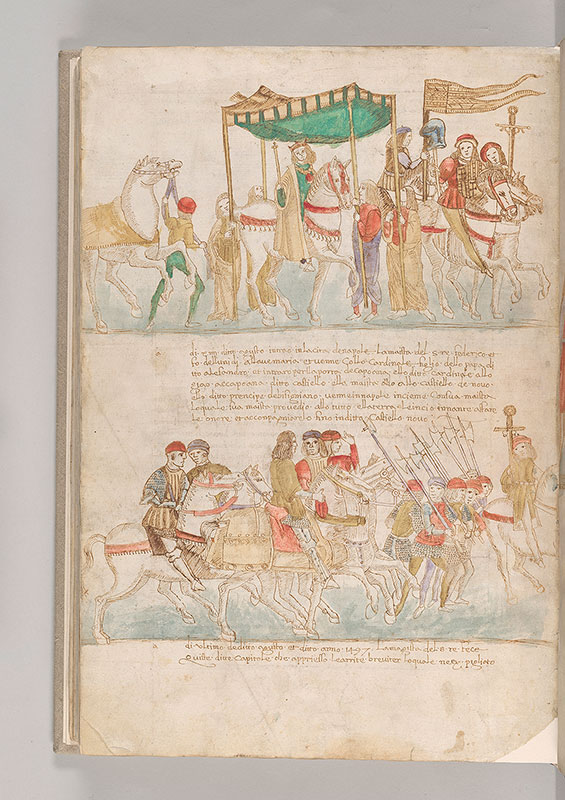
Fasciculus temporum
Cronaca della Napoli Aragonese: Scene, Coronation of Frederick I of Aragon -- Frederick I of Aragon, crowned, as king of Naples, wearing ceremonial chain, raising scepter with right hand, possibly holding orb with left hand, is astride horse with trappings, riding below canopy carried by four men. At left, man wearing hat, grasps reins of rearing horse. The king is preceded by three horsemen, one carrying banner decorated with heraldry of Aragon, another raising helmet on rod with right hand with shield decorated with heraldry of Aragon. The third carries raised sword, with hilt in air.
Cronaca della Napoli Aragonese: Scene, Frederick I of Aragon, entering Naples -- Procession includes two men wearing caps, possibly wearing earrings, one holding rod (?) astride bridled horses with trappings; three men, two wearing hats, one holding hat, are astride horses, one caparisoned; seven soldiers wearing hats and mail, carry halberds. All are led at far right by man wearing hat astride bridled horse with trappings, grasping with right hand, tip of raised sword.
MS M.801, fol. 148r
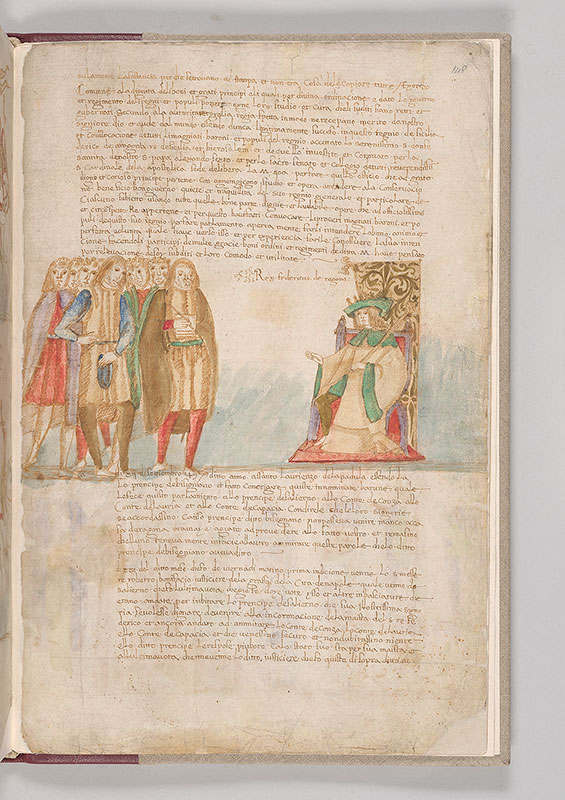
Fasciculus temporum
Cronaca della Napoli Aragonese: Scene, Frederick I of Aragon holding Parliament -- Group of eight men, most only heads visible, one holding hat, one writing, stand before Frederick I, inscribed REX FEDERICUS DE RAGONA, wearing crown on hat, extending right hand, holding scepter with left hand, seated on throne below canopy (?).
MS M.801, fol. 148v
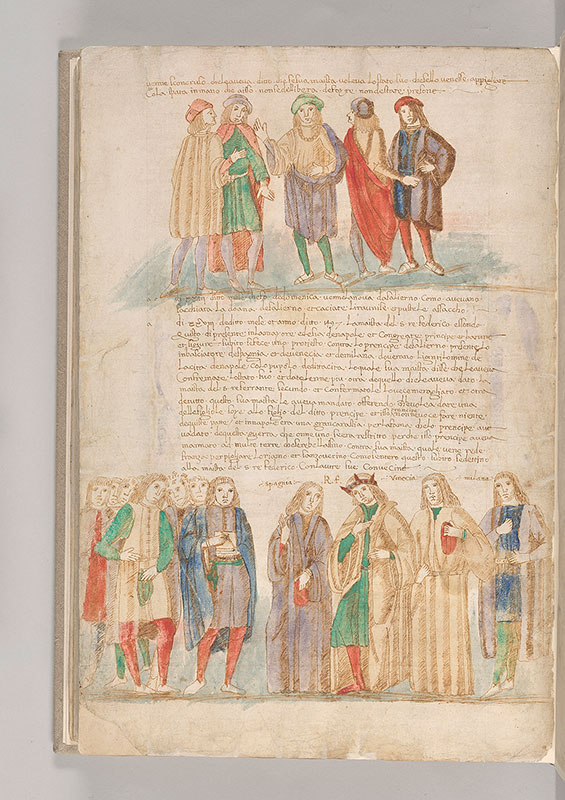
Fasciculus temporum
Cronaca della Napoli Aragonese: Scene, Delegation of Frederick I of Aragon -- Of five men wearing hats, the center man, wearing ceremonial chain around neck, and raising right hand is possibly Roberto Bonifacio, judge.
Cronaca della Napoli Aragonese: Scene, Frederick I of Aragon holding Parliament -- In lower miniature at left, of eight men, some only partially visible, one holds hat, another, with inkpot (?) and pen case hanging from waist, writes. At right Frederick I, inscribed R(E) F(EDERICO), crowned, gesturing with both hands is flanked by three men inscribed SPAGNIA, raising right hand, holding hat with left hand; VINECIA, grasping hat with right hand; and MILANA, holding hat on breast with left hand.
MS M.801, fol. 149r
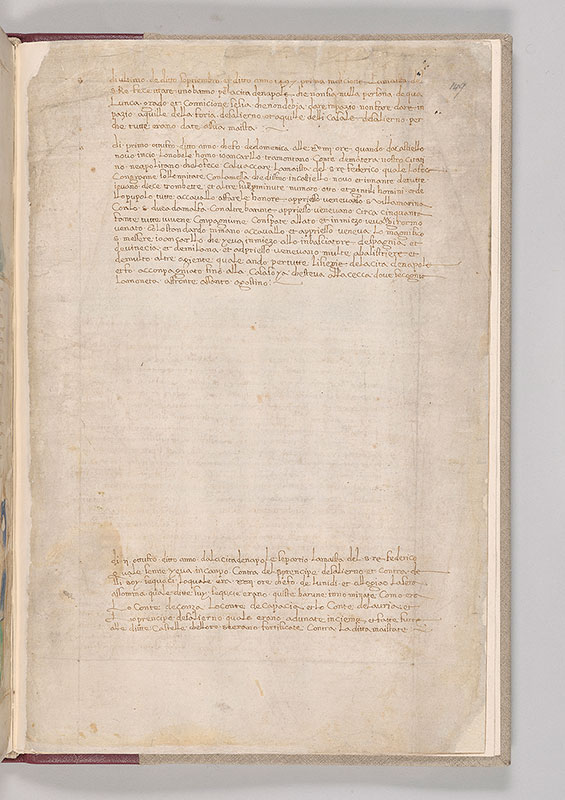
Fasciculus temporum
MS M.801, fol. 149v
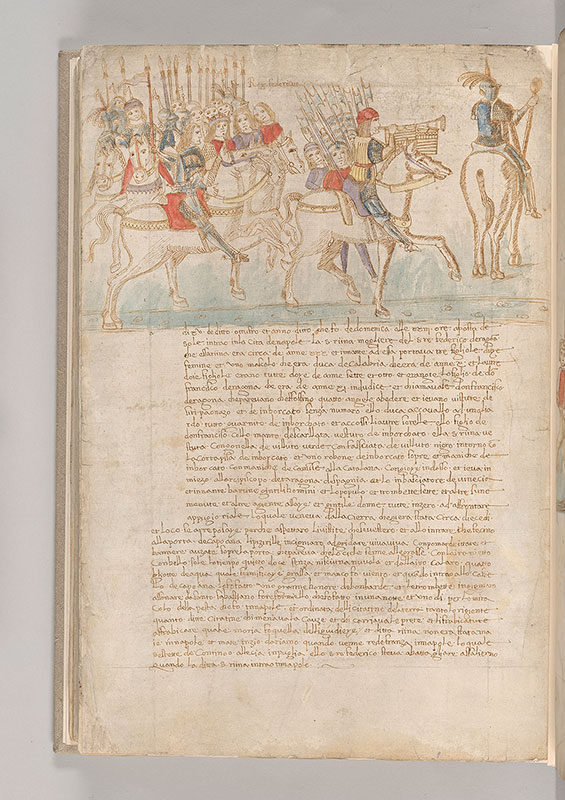
Fasciculus temporum
Cronaca della Napoli Aragonese: Scene, Expedition against Prince of Salerno -- At left, Frederick I of Aragon, inscribed REX FEDERICUS, crowned, wearing armor, astride horse, is surrounded by other horsemen, most wearing armor, some wearing helmets, several carrying lances, one bannered. In center, man, wearing hat and armor, blowing bannered trumpet decorated with heraldry of Aragon, is astride bridled horse with trappings, next to group of men wearing hats, carrying halberds. At right, leading the expedition, back-turned soldier wearing plumed helmet and armor, astride horse, carrying ceremonial mace with raised right hand.
MS M.801, fol. 150r
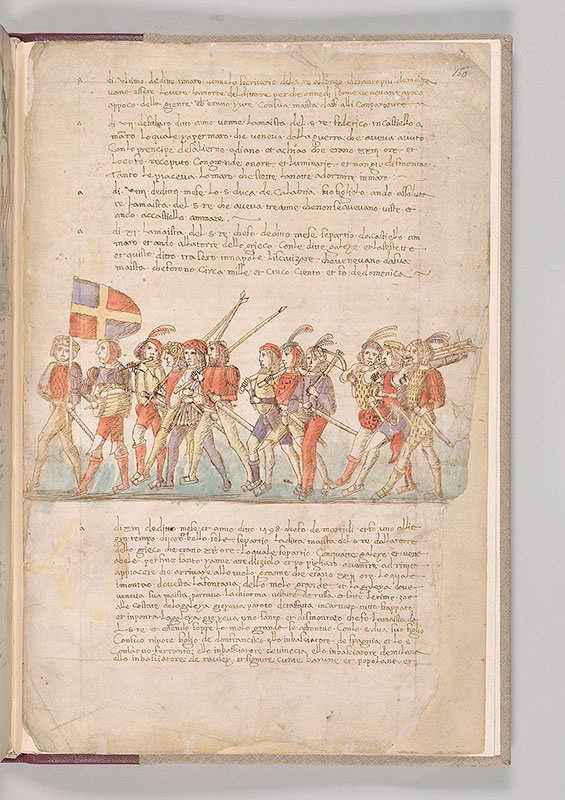
Fasciculus temporum
Cronaca della Napoli Aragonese: Scene, Arrival of Swiss Soldiers -- Group of men, most wearing hats, some with armor, and most with swords at waists, are led by man carrying banner with heraldry of Switzerland (gules, a cross or), and by drummer. Among the group are man possibly playing fife, three carrying spears, one carrying crossbow, three carrying guns (?) on right shoulders.
MS M.801, fol. 150v
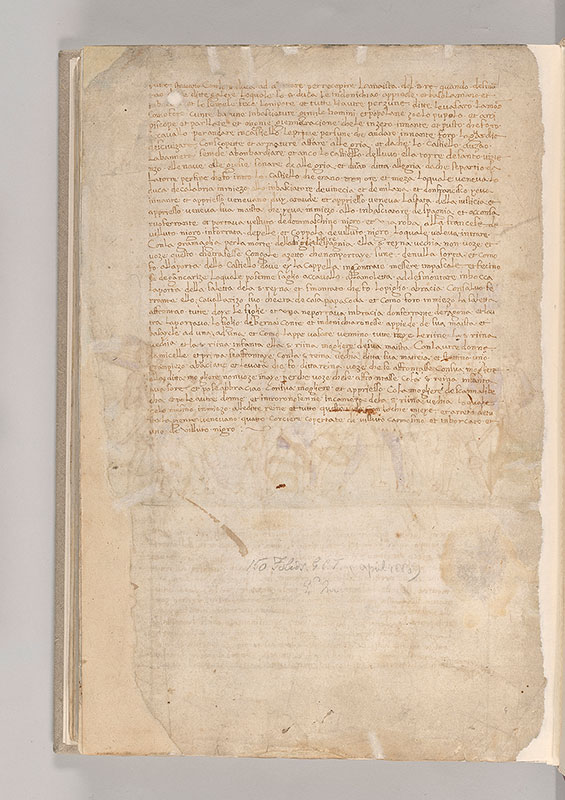
Fasciculus temporum
MS M.801, Back free endleaf 1, recto
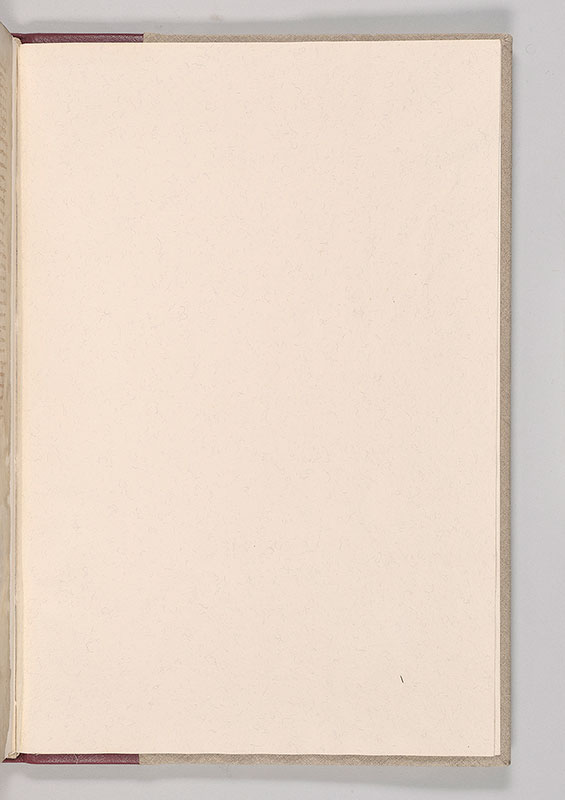
Fasciculus temporum
MS M.801, Back free endleaf 1, verso
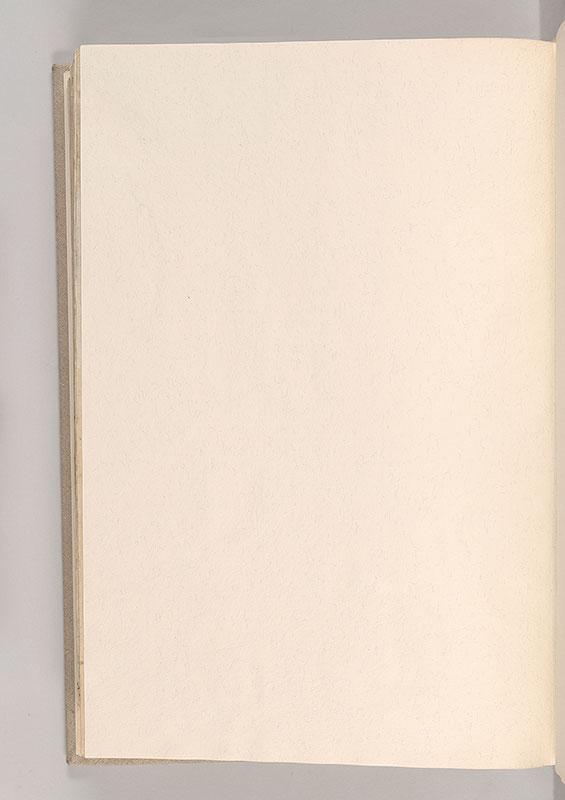
Fasciculus temporum
MS M.801, Back free endleaf 2, recto
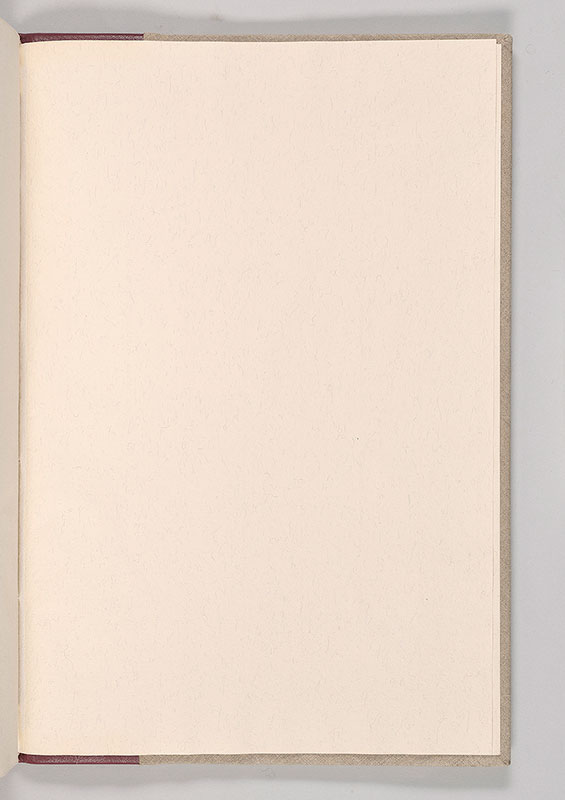
Fasciculus temporum
MS M.801, Back free endleaf 2, verso
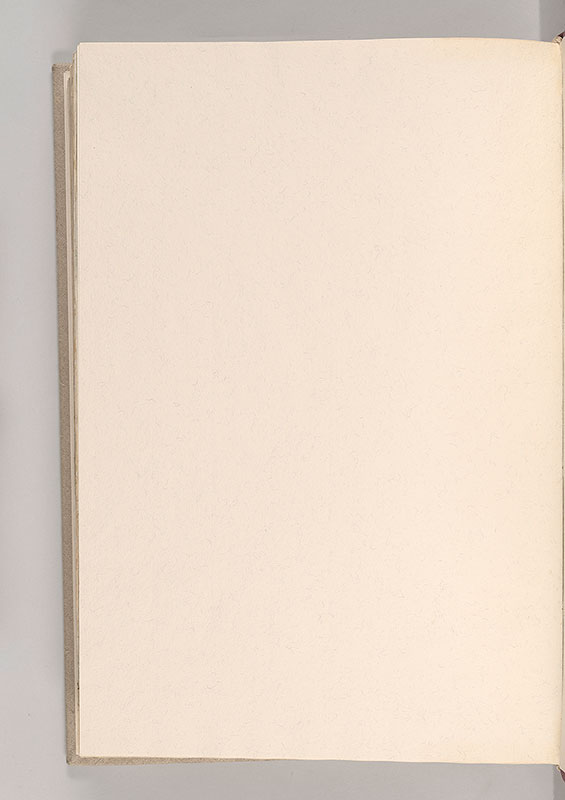
Fasciculus temporum
MS M.801, Back pastedown
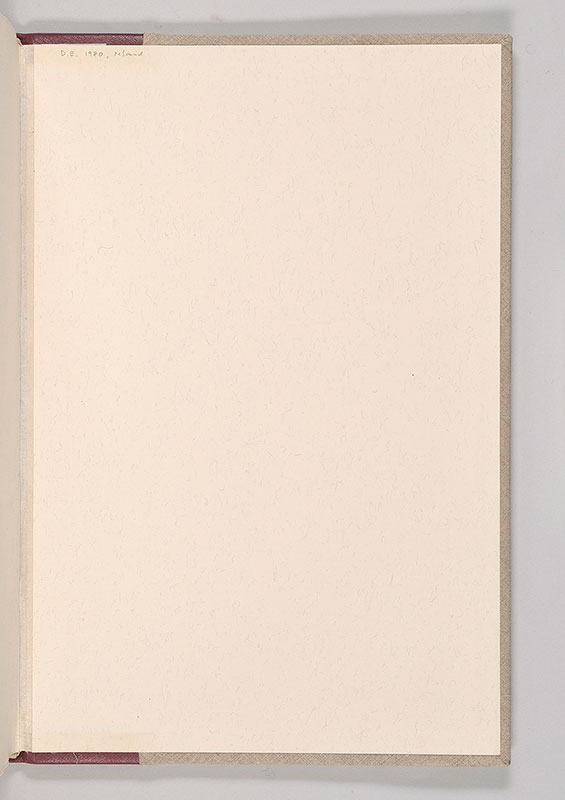
Fasciculus temporum
MS M.801, Back cover
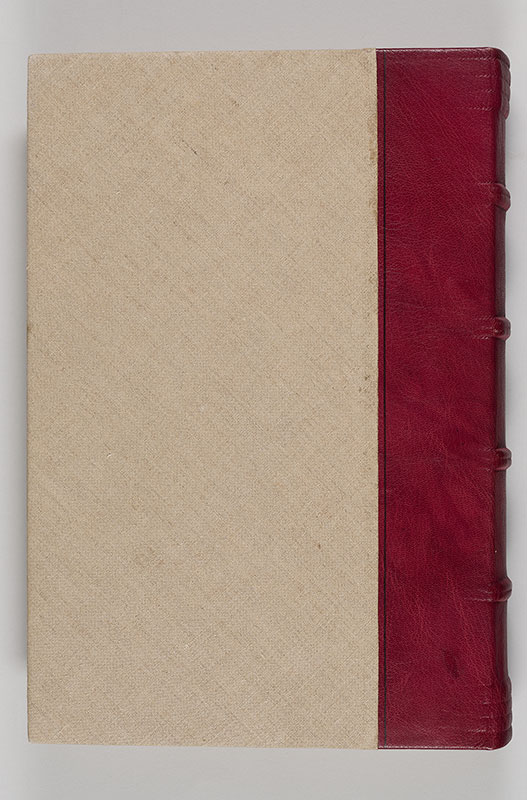
Fasciculus temporum